How to Write a Graphic Designer Resume That Goes Beyond Looks (Example Included!)

At the risk of stating the (very) obvious, graphic design is a visual medium. A skilled designer blends art, technology, and information to create a compelling image that can convey concepts, reflect ideas, or inspire audiences. And while a designer’s creations can more or less speak for themselves, a great resume is still needed to give context to their work and provide additional details about their skills and experience. Because beautiful designs don’t just appear out of nowhere.
“When we hire a graphic designer, we look at four key things: quality of work, consistency of work, tool competencies, and—if they’ve freelanced—positive testimonials,” says Jérémy Chevallier, who regularly hires freelance graphic designers as Director of Marketing at Crash.co and also works as a career coach for creative professionals. Your resume is meant to convey the things that go on behind the scenes—the skills and proficiencies and experiences that enable you to create your designs.
Try thinking of your resume as a snapshot of your experience and capabilities—a sneak peek at what you can do. Here are a few rules to follow when writing your graphic design resume.

1. Resist the Temptation to Get Too Creative
I know, I know. Creativity is an essential skill for a graphic designer. And it can be tempting to show off a little on your resume. But if you plan on applying to online job postings, you’re probably going to have to contend with an applicant tracking system (ATS). These systems tend to have trouble reading files with design elements like unusual fonts, images, or text boxes.
“A graphic designer’s resume needs to make it through the applicant tracking systems first, and those programs use keyword matching, not aesthetics, to determine who makes it through to the next step in a recruiting process,” says Terry McDougall, CEO of Terry B. McDougall Coaching and a former marketing executive. In fact, an ATS will strip out many design elements and deliver a plain text version to the recruiter or hiring manager on the other side. So it’s best to stick with a simple template (check out the example below to see this in action) anytime you apply online.
But this doesn’t mean that you can’t have a design-heavy version, too. If you’re able to bypass the ATS for some applications by sending your resume directly to a recruiter or hiring manager (say through a referral or introduction), you’re welcome (and encouraged!) to use a more creative version of your resume. “Create a [second] resume that reflects your style of work. Just be sure that your design choices don’t distract from the content of the resume,” Chevallier says.
2. Include Links to Examples of Your Work
While it’s best to keep your resume simple, there are still ways to showcase your creativity. Enter: the portfolio or personal website . “Graphic designers should always include a link to a website or portfolio [on their resumes],” McDougall says. And you’ll want to be sure that these external links are not only included on your resume, but also easy to spot. You might create a designated portfolio section on your resume where you can include links to your work, or you can intersperse links throughout (see the example below).
You can also include links to past projects within the experience section of your resume. For example, if you created a company logo for a startup, you could write a bullet point that says:
- Collaborated with BeeHive & Co. founders on the design of the new “Bee Free” logo, from research and conceptualization through draft, production, feedback, and finalization (link)
Note that some ATS will only read the url of a hyperlink, so avoid using anchor text that is vital to your resume.
3. Tailor Your Resume for Every Opportunity
While the content of your resume probably won’t change too dramatically from one application to the next, you should always plan to set aside time to tailor your resume for every job posting you respond to. I know this might sound cumbersome, but it’s easier than it sounds. When in doubt, remember this: If a skill, proficiency, or technology is listed in a job description, then it should be on your resume (so long as you have actual experience with that given skill, proficiency, or technology). Even better? You can cut whatever won’t be relevant to a particular role. That will help keep your resume to a single page.
You’ll also want to be thoughtful about the design work you choose to feature via external links, as design goals and aesthetics will vary from one company or industry to the next. You should pick the samples that best prove you can do the kind of work you’d be doing in the actual role.
“Seek to understand the goals of the company you’re interviewing with,” McDougall says. “Some companies want to use creativity to shock or gain attention. If you’re working as a graphic designer for a snowboard company, you will likely have much more leeway in your design than if you’re working for a more conventional company like a hardware store or hospital.” This is your opportunity to show prospective employers that not only are you a talented designer, but that your aesthetics and abilities are a strong match for their needs.
4. Use the Right Keywords
Applicant tracking systems are programmed to scan resumes for specific keywords in order to determine whether an applicant is a good fit for the role. So resume keywords matter. Especially when you’re applying online. You don’t need to stuff your resume with every graphic design term under the sun. But as a best practice, it’s worth checking to make sure you’ve included as many relevant keywords as organically as possible.
Not sure where to start? Try reading through a few of the job postings you’re most excited about and taking note of the terms or phrases that keep popping up. Chances are, words like logo design or brand identity will be safe bets, but you can think outside the box, too. A demonstrated knowledge of sales, marketing, design theory, color theory, typography, or user experience can also be valuable, depending on the role. “Demonstrating that you understand the larger purpose that design serves can be really important,” Chevalier says.
While the “right” terms will vary from one job posting to the next, here’s a list of popular graphic designer keywords to get you started.
- Advertising
- After Effects
- Brand Consistency
- Color Theory
- Composition
- Dreamweaver
- Illustrator
- Product Design
5. Put Your Work in Context
Because graphic design is a visual medium, it might be tempting to assume your designs alone will get you hired. But the strongest resumes go beyond linking to work and listing companies you’ve worked for to put your abilities in context, using specific examples, outcomes, and even numbers, where applicable. “Resumes that include examples that speak to collaboration, creativity, time management, deadline orientation, knowledge of how the medium in which their designs will be used—such as print production, video, or web—will always stand out,” McDougall says.
Quantifying your experience and accomplishments will help recruiters and hiring managers better understand what you do. So rather than saying you “created promotional materials,” you can put that project in context by including additional details and saying you “designed BeeHive & Co.’s new product marketing materials, including signage, banners, and flyers across print and digital, contributing to achievement of 120% of target revenue in Q1 2020.”
Most resume bullet points can be quantified using this simple formula:
- Compelling verb + description of work + outcome (if applicable)
If you’ve worked for an organization for a longer period of time, it might be more efficient to create a key achievements subsection where you can go into more detail about specific projects that are most relevant to the job you’re applying for. No matter which structure you use, be sure you’re keeping the bigger picture in mind. “A graphic designer who can demonstrate that they understand how their work impacts a company’s bottom line is ten times more interesting and valuable than a candidate who only focuses on design,” Chevallier says.
6. Highlight Your Relevant Technical Skills
Most graphic designers will be skilled users of programs like Photoshop, InDesign, or Illustrator, so prospective employers will expect to see them on your resume. But don’t stop there. If you have additional skills that are relevant to a particular role, consider adding them. “Go beyond pure design tools like Adobe and show that you also know marketing tools like Mailchimp or TweetDeck. These are complementary skills that will increase your value as a designer,” Chevallier says. McDougall agrees: “If you have ‘crossover’ skills such as video editing, copywriting, or illustration, you should list them in the skills section of your resume, too.”
For the sake of organization and scannability, you might consider categorizing your technical skills into buckets like design, coding languages, and marketing tools (see the sample below) or indicating your level of expertise (e.g. expert InDesign user or proficient with MailChimp). You can also weave your technical skills throughout the experience sections of your resume to put them in context.
7. Master the Fundamentals of Resume Writing
When it comes to resumes, there are a few simple rules that transcend roles and industries. You’ll want to keep these basic guidelines in mind as you draft your own.
Keep your resume to a single page . Your resume should be a snapshot of your experience—not an exhaustive list of everything you’ve ever done. Tailoring your resume for every job you apply to (and cutting content that just isn’t relevant) will help you to keep the length under control. And as a general rule of thumb, you can typically delete work experience that’s more than 10 to 15 years old. Hiring managers are going to be most excited about the things you’ve accomplished recently. That said, there are exceptions to every rule. If you’re a seasoned design professional with a lengthy, relevant career trajectory or a freelancer with an impressive list of former clients, a two-page resume might make sense for you.
Use a clean, scannable layout. Recruiters prefer a chronological layout because it’s straightforward and easy to scan, but for career changers or people reentering the workforce, a combination or functional resume layout could be a better fit (just be aware of the pros and cons of each format before you commit). Whatever layout you go with, be sure that you create clearly defined section headers to make your resume scannable.
Consider including a summary. Resume summaries can be a great way to put your past experience and future goals in context—especially if you’re making any kind of career pivot. They don’t need to be terribly long—just two or three sentences detailing who you are, what you do, what your best trait or skill is, and what you’re looking to do next. When executed well, they can help to paint a fuller picture of what you bring to the table. Check out the sample resume below for an example.
Double check your work. Attention to detail is an especially important trait for graphic designers, so you want to make sure your resume is flawless before you send it out into the world. When in doubt, ask a trusted friend or colleague to read it through.
And Now, an Example!
No two resumes will be exactly alike (nor should they be!), but the below example will give you a general sense of the type of layout and content you’ll want to use for your own. As you read it over, notice the formatting (simple text, clear headings, plenty of white space), ample use of relevant keywords, and quantified achievements.
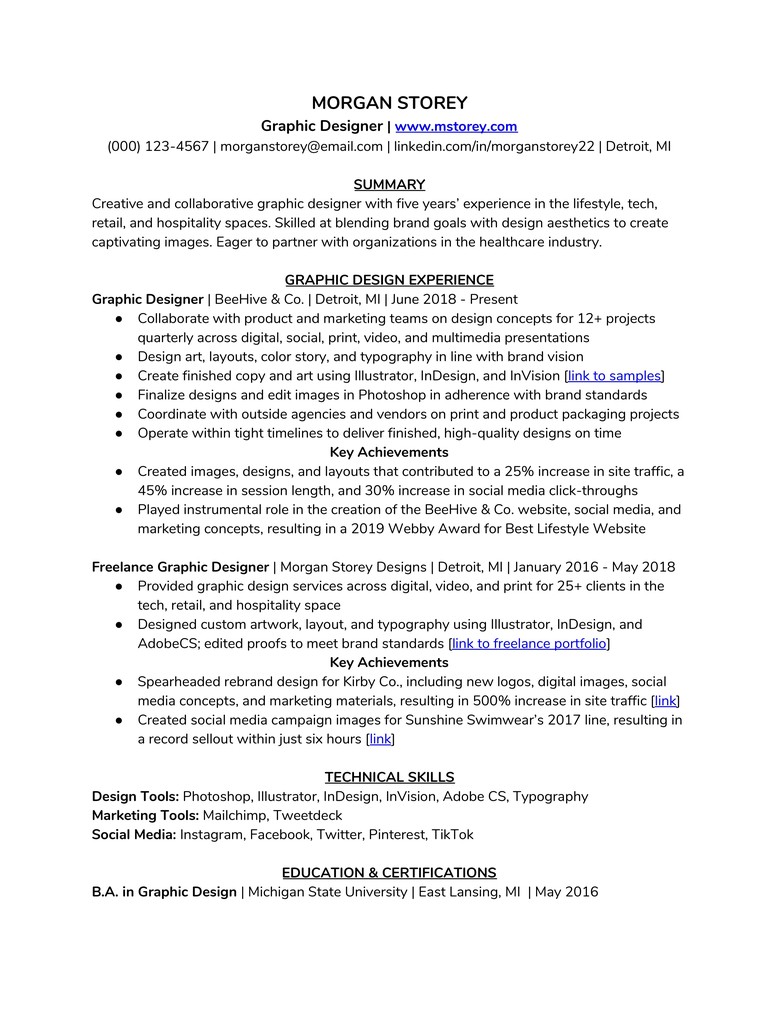
Download example graphic design resume
Remember, your resume isn’t meant to showcase your work (that’s what a portfolio is for), but rather to highlight the skills and experiences you bring to the table. It’s an overview of what you’ve accomplished and what you’re capable of doing next. When done right, your resume should serve to provide additional context to your body of work and—most importantly!—help you land a great new graphic design job.

Build my resume
- Build a better resume in minutes
- Resume examples
- 2,000+ examples that work in 2024
- Resume templates
- Free templates for all levels
- Cover letters
- Cover letter generator
- It's like magic, we promise
- Cover letter examples
- Free downloads in Word & Docs
22 Graphic Designer Resume Examples That Work in 2024
Graphic Designer Resume
- Graphic Designer Resumes by Experience
- Graphic Designer Resumes by Role
Writing Your Graphic Designer Resume
You can whip up a new logo in a flash, your friends turn to you when they need help with Photoshop, and you’re always doodling on your notes. You’re a great graphic designer, and it shows.
But when it comes to writing great resumes to prove your skills (not to mention writing cover letters ), employers want more than just your portfolio pieces. Plus, discussing your design skills and experience on your resume can take a lot of effort.
Our graphic designer resume examples have helped graphic designers land highly coveted jobs at companies like Stripe and Apple, so they’re an excellent place to get inspired to create your great resume.
or download as PDF

Why this resume works
- This can be tricky for some graphic design roles, so it’s okay if your work isn’t the sole reason for improvement. Simply highlight your overall impact as part of the graphic design, marketing, or sales team.
- Portfolios are more or less a requirement for graphic design roles, so make sure to include a link to your own.
- If you choose to add a resume objective to your graphic designer resume, you need to customize it for each job to which you apply. One way to do this is to include keywords from the job description. Don’t forget to mention the company by name!
Beginner Graphic Designer Resume
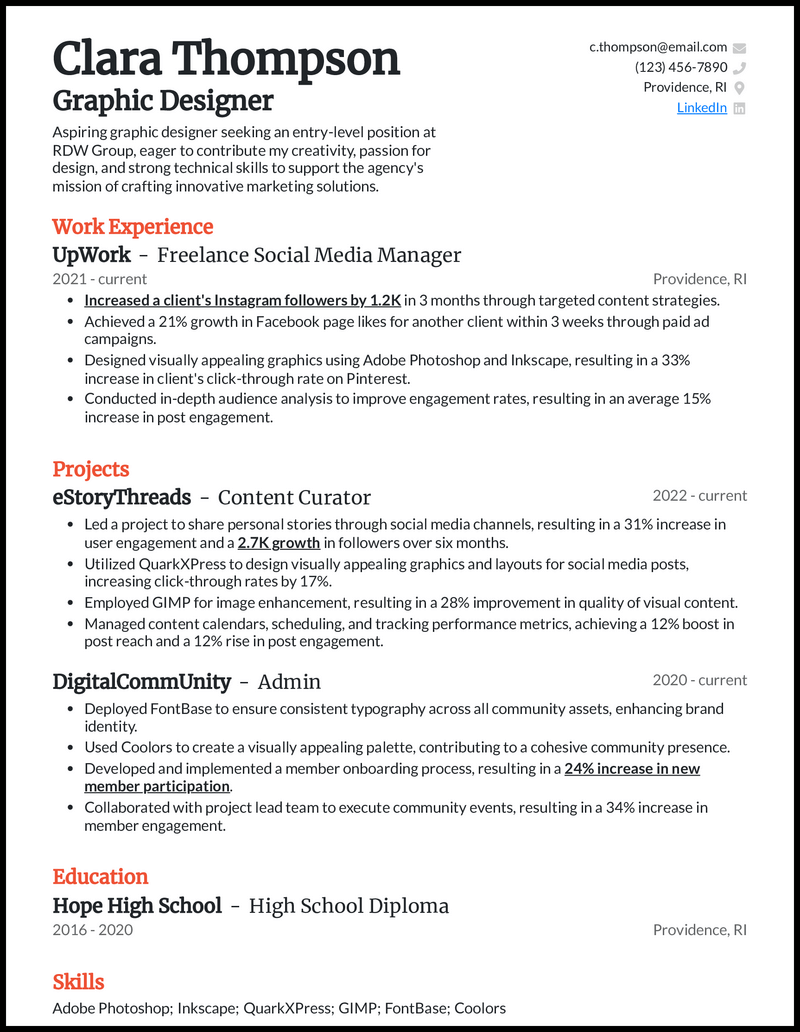
- One thing that you can count on is a career objective that’s both inspiring and clear on what you intend to do once you’re hired.
Junior Graphic Designer Resume
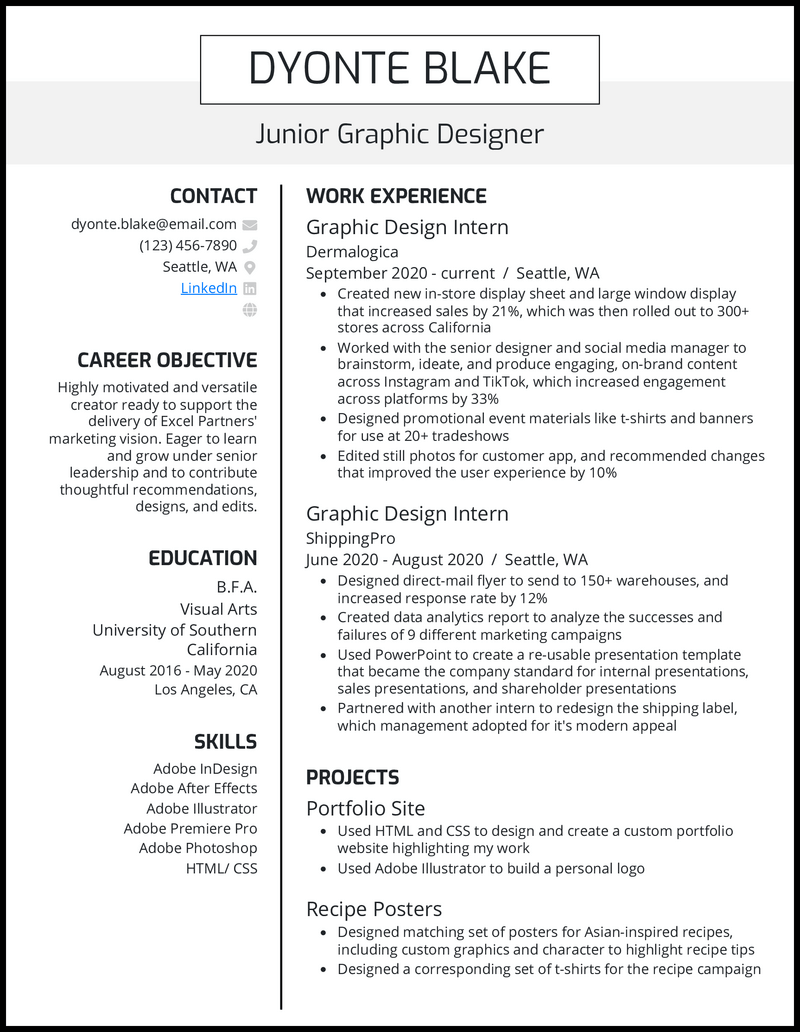
- If you’re light on relevant work experience, include any relevant projects or internships. Just make sure to include metrics when you can, as any recruiter will treat an internship like a job and will thus expect a demonstration of your impact.
- You don’t have to be an expert, but generally speaking, only include skills you can talk about in an interview.
Senior Graphic Designer Resume
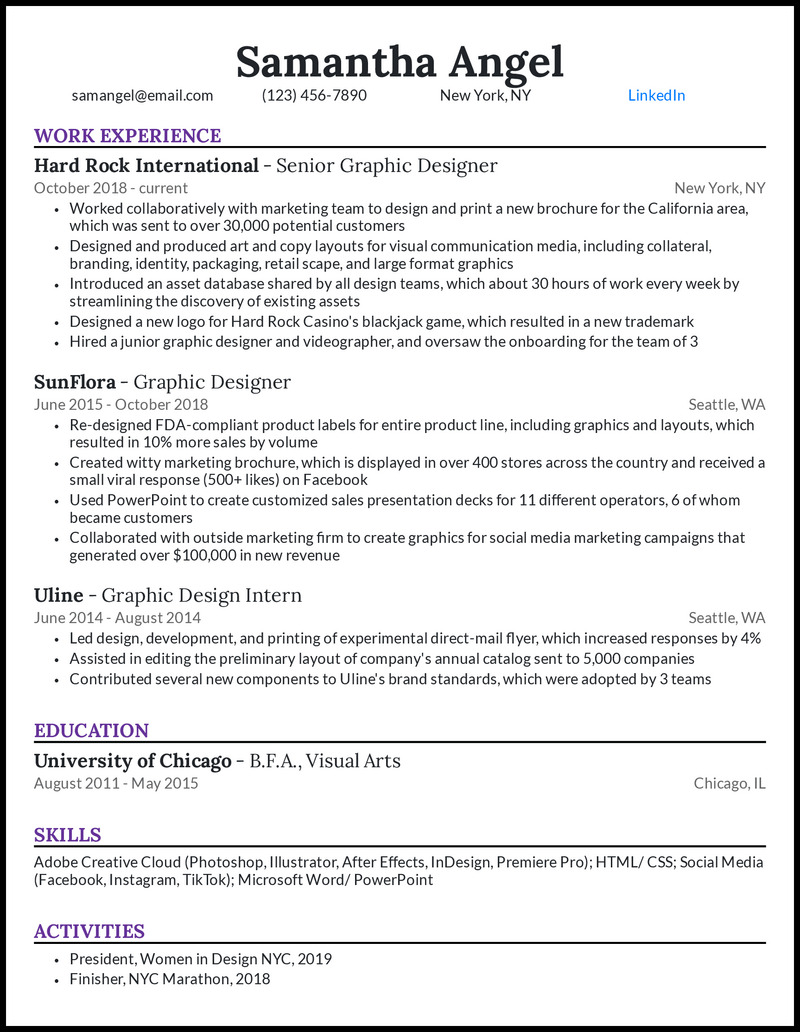
- Demonstrating your impact proves you’re a designer who thinks about your work within a broader context and does their best to help a company grow.
- If you’re wondering what to include, start with metrics relating to time or people. How many hours did you help your team save? How many new customers did you gain? How many people viewed your designs?
- The activities section isn’t always a good choice, but it can be a useful addition in some cases. If your resume’s section of hobbies and interests demonstrates leadership, persistence, or other useful skills, you can include this section to give you a boost over the competition.
Graphic Design Student Resume

- Showcase projects where you’ve used Affinity Designer, Adobe Fresco, or Canva to create compelling visuals or your use of resources like Pixabay and Coolors for inspiration and project enhancement.
- School work totally counts, too, so highlight available metrics from completed projects like grades or peer reviews.
- This approach underscores your hands-on experience with design tools and ability to complete projects successfully, irrespective of traditional employment.
Self Taught Graphic Designer Resume

- In addition, line up one or two projects, which if adopted into real-world scenarios, would help transform marketing trends and outcomes for all-size businesses.
Freelance Graphic/UI Designer Resume

- In other words, don’t stop at making a list of job-specific tools like Adobe Photoshop, Adobe XD, and Coolors in your freelance graphic/UI designer resume. Take them on a journey through your past gigs, painting a picture of those moments your designs stole the show or the times your creativity drew gasps and nods of approval.
Graphic Designer/Production Specialist Resume

- Essentially, sprinkle those gems throughout your graphic designer/production specialist resume like confetti, a hack Michael executed well at the start of each bullet point. You want every line on that resume to shout from the rooftops that you’re the hands-on visionary who doesn’t just do the job but redefine it.
Graphic Designer Illustrator Resume

- Capitalize on your graphic designer illustrator resume’s side columns to parade graphic design and illustration tools you’re well-versed in. Brandon, for instance, curates a list of tools (cue GIMP, Vectr, Prezi and more), and then weaves in evidence of him wielding these tools in the work history section.
Creative Designer Resume

- If you can back your creative designer resume with a fine arts degree in graphic design, you’ll be able to show your enthusiasm for the work and be on the hiring list for any employer.
Visual Designer Resume

- Mention tools like Adobe Photoshop, Inkscape, Figma, and InVision that speak volumes about your artwork. Adding such skills will convey that you’re well-versed with the latest design tools and can create modern designs with ease!
Logo Designer Resume

- Borrow a script from how Ben weaves competencies in Blender, Figma, CorelDRAW, and so on to get things done and increase user engagement.
Motion Graphic Design Resume

- An experience at a junior level accompanied by what you learned and your input can be an effective anchor you can use to boost the chances of your motion graphic designer resume making it beyond the shortlisting stage.
Social Media Graphic Designer Resume

- Put everything in its place and let the hiring teams find it easy to follow your career path. Most importantly, ensure there’s no clutter because that is a big turn-off.
Web and Graphic Designer Resume

- Following the same tactic, achieving 97% customer satisfaction for several projects is a true testimony to your work ethic and client-focused approach.
Freelance Graphic Designer Resume

- Highlight how you’ve leveraged Adobe Photoshop, Sketch, or CorelDRAW to deliver creative solutions to client projects, citing specific examples.
- Discuss using project management tools like Asana to meet deadlines and coordinate with clients—all while delivering high-quality work.
Graphic Design Specialist Resume
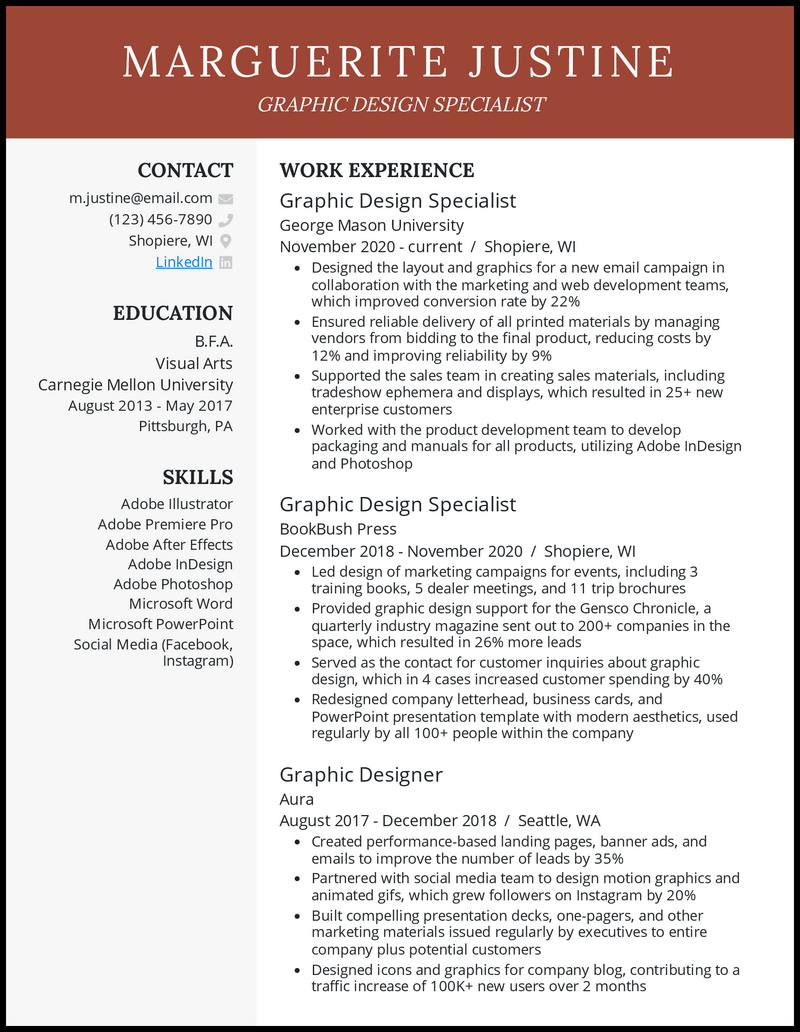
- For example, you mention how your work generated more traffic on social media or how you helped the marketing team create a campaign.
- Including numbers that highlight your impact will drastically increase your chances of landing an interview. Companies often receive hundreds of applications for a single role, so as you craft your resume , keep in mind how you can stand out.
- Graphic designers are expected to be proficient with many different tools, especially the industry standard, Adobe Creative Suite. So make sure to let employers know if you’re skilled at Photoshop, Illustrator, and InDesign.
Creative Graphic Designer Resume
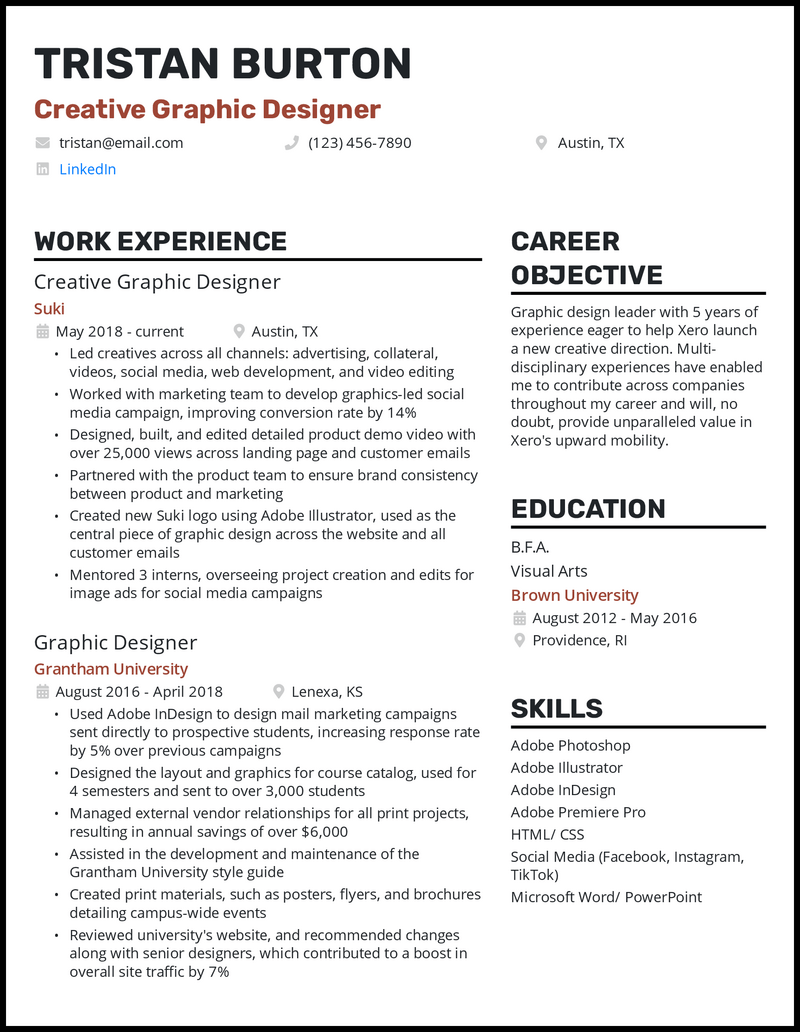
- Some of the most popular mediums we’ve seen are print media, video, website design, and logo design.
- Make sure to add any experience you have with heading a project or leading a team.
- Showing an increase in responsibility throughout your career is another great way to show your initiative.
- For example, mentoring other graphic designers demonstrates positive growth as a leader.
Production Artist & Graphic Designer Resume
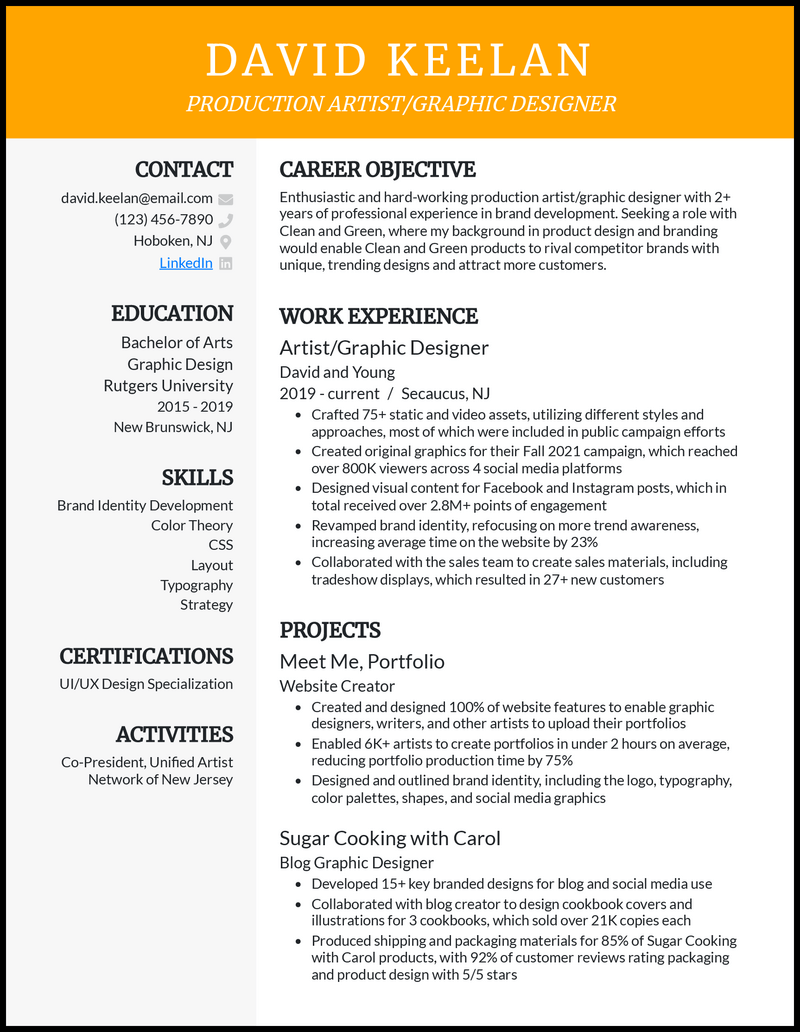
- You can improve your format by choosing two tastefully contrasting fonts, utilizing white space throughout your resume, and using bold (but not garish) colors in your header and titles.
- Don’t get so caught up in formatting that you neglect your content—use a resume template to help speed up the formatting process.
- Focus on picking relevant projects that have some link to the job description.
Marketing/Graphic Design Coordinator Resume
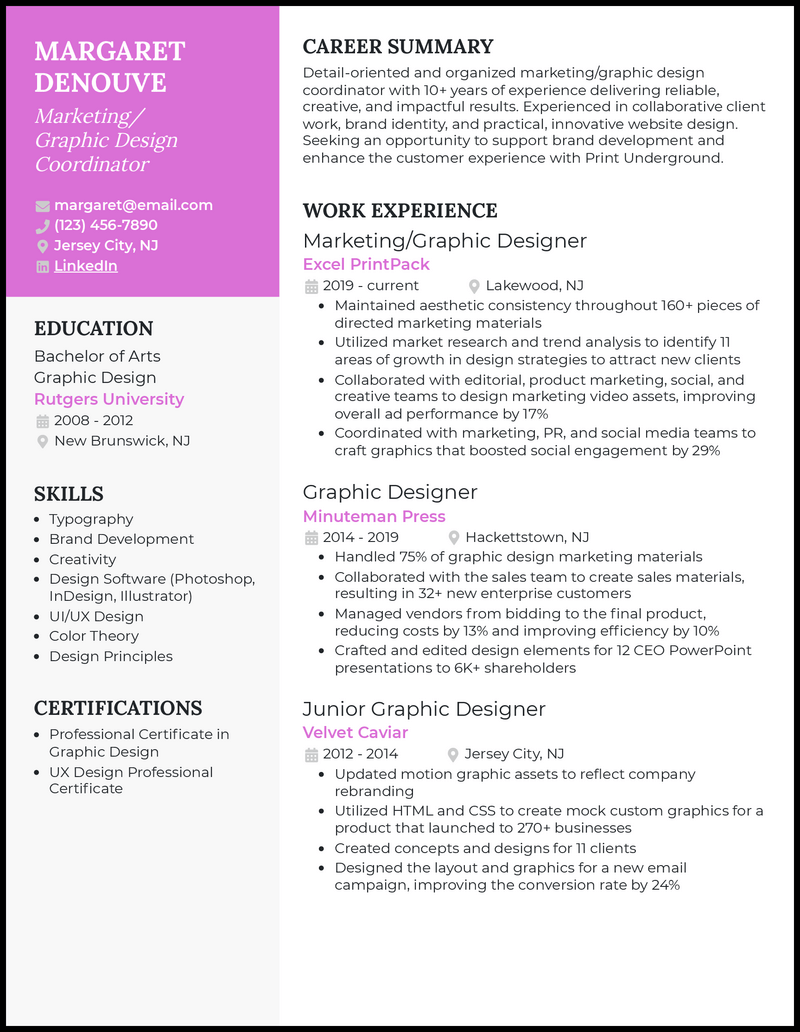
- If you choose to include a summary, you’ll need to ensure it’s unique and personalized for every application you submit. Otherwise, skip adding it and focus on your work experience instead.
- Specialize your summary by mentioning the specific job title you’re seeking, the company’s name, and any examples of work you’ve done throughout your career that’s highly relevant for the job. Just be sure to keep it under three sentences.
Senior Apparel & Graphic Designer Resume

- Giving a two-to-three sentence rundown of your career can be a challenge, so break it down into three components: who you are, your biggest success, and what assets you bring to the company.
- Think back on your career and list your biggest accomplishments that you can quantify/explain in a single sentence. Did you increase site engagement by 72 percent by incorporating a more modern, user-friendly layout and graphics? Did you design the company’s newsletter which was sent out to 2,000 customers?
- Adobe offers certification courses for many of their Creative Cloud products, and there are many courses offered through universities to give you a leg-up over the competition.
Graphic Designer/Administrative Assistant Resume
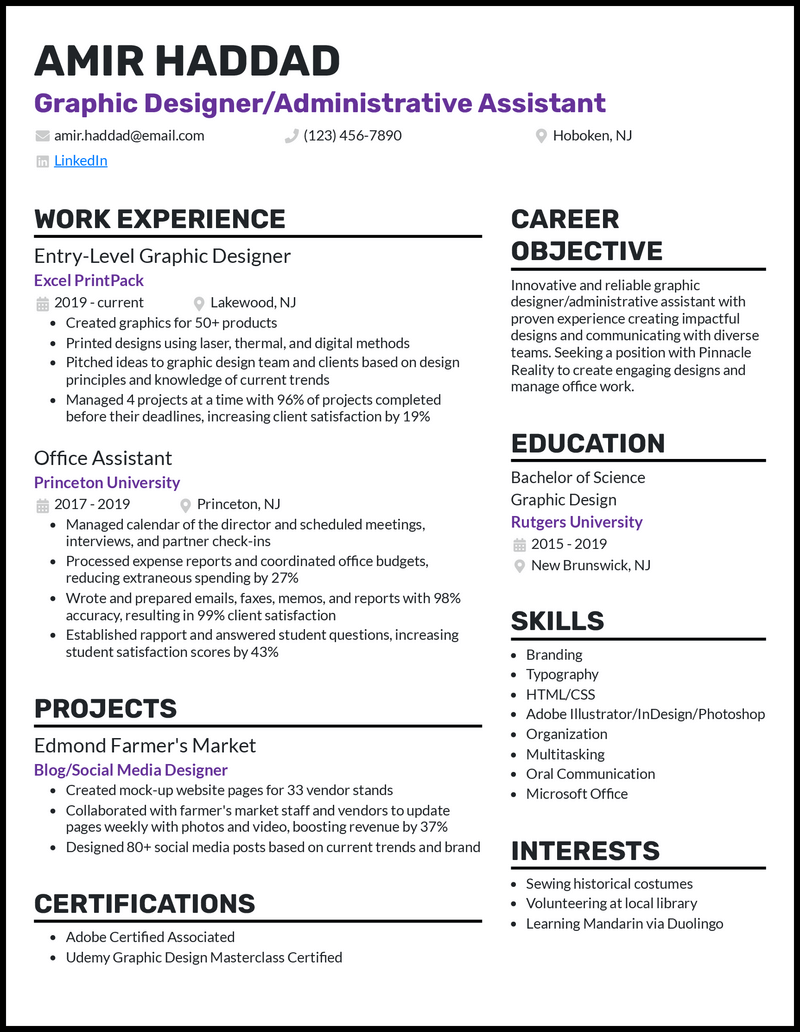
- Since you’re in a creative field, you can include more kinds of projects than a technical role would allow, but try to limit your choices to activities/projects that require(d) taking initiative, additional research, or learning a completely new skill.
- If you choose to include one, you’ll need to ensure it’s unique and personalized for every application you submit.
- Though including a resume objective is optional, it gives you a chance to address the employer by name and establish what they will gain by hiring you.
Related resume guides
- Interior Design
- Social Media Manager

Graphic design is one of the most profitable professions in the freelance industry, and the position is growing more popular. Graphic designers serve as visual communicators who craft concepts using a stroke of their pen or a click of their specialized graphic design software.
Their main aim is to convey ideas to inform, inspire, or capture customers through physical and virtual art forms like words, images, and abstract elements like colors and shapes. However, graphic designers aren’t just glued to their drawing tables—they spend a lot of their time communicating with clients, customers, and other creators to ensure that their designs replicate the intended message and hit the intended audiences.
Standing out in the graphic design field isn’t easy. There are about 266,000 graphic designers already in the competitive market, and the number continues to rise. Even if you’re working on your letter of resignation email and giving your job application your best shot, you don’t want to end up in the “reject pile” because of your resume.
The best way to increase your chances of getting hired is with an AI resume builder . You can showcase your skills, explain your experience, and quantify your impact in a way your portfolio can’t.
When it comes to your graphic designer resume, we’ve got four critical tips for taking your resume from the trash bin to the top choice . When you understand the role of your skills section, resume formatting, metrics, and customization, you’ll be well on your way to landing your next job.
Put the spotlight on your graphic design skills
Most recruiters don’t have time to go through the nitty-gritty details in your graphic designer resume. They have only seconds to spare, which they’ll likely use to examine your resume’s list of skills and determine whether or not they’re relevant to their needs.
Recruiters aren’t the only ones you have to impress; when recruiters have a stack of resumes to weed through, they depend on an applicant tracking system (ATS) to filter out resumes lacking keywords—skills relevant to the specific job.
That’s why the skills section of your graphic designer resume is vital. Because graphic design jobs can differ greatly in duties and requirements, your skills section should reflect your knowledge and abilities in relation to the company or organization. If you properly showcase your various skills, you can easily beat the ATS.
Here’s how you can spotlight your skills in your graphic designer resume:
- Write specific skill keywords in a bulleted list in your resume’s skills section
- Use numbers and examples to quantify and demonstrate your skills in the work experience section
- Emphasize your most relevant skills in the resume objective or summary
We don’t recommend adding more than 10 skill keywords to your skills section, but there’s still plenty of room to catch an employer’s eye. Here are some of the top hard (technical) and soft (general) skills you could include in your graphic designer resume:
- Adobe Illustrator
- Adobe Photoshop
- Adobe InDesign
- Gravit Designer
- Sketch
- Activating negative space
- Color theory
- Typography
- Visual hierarchy
- JavaScript
- Communication
- Organization
Formatting your graphic designer resume
Your resume is more than just your relevant experience, employment history, education, and skills; it also serves as a marketing tool. Recruiters only spend seconds looking at a given resume and tend to pass over the boring or generic ones. They want to see your unique accomplishments and the value you can provide to their company.
This is a direct ticket to an interview. That’s why you should ensure your resume reveals the best you possible. As such, you’ll want to choose the right resume format for your graphic designer resume. While many job seekers choose skills-based or hybrid-based formats, it’s almost always best to choose a reverse-chronological format. Employers can hone in on your most recent and relevant experience, letting your most relevant accomplishments and achievements shine.
Consider these vital points when crafting your graphic designer resume:
1. Fixing up your resume’s appearance:
- Consistency in layout, punctuation, font, and font size
- Work experience is in bullet points for readability
- Minimal color (headers and titles only)
- Left-aligned text (your contact header is the exception)
- Headers to distinguish sections
2. Meeting organization and technical requirements:
- Only a page long
- A recognized file format (such as PDF)
- An objective/summary when necessary
Graphic designer resume objective
Speaking of an objective/summary, perhaps you’re wondering whether you need one in your graphic designer resume. First, let’s explain the difference between the two.
A summary is a two-to-three-sentence statement that summarizes your skills, work experience, and any specializations. It’s best used when someone has been in graphic design for 10+ years.
On the other hand, an objective is a two-to-three sentence statement that introduces your interests, qualifications, and how you’ll add value to the role you’re seeking. A resume objective is best used for career changers or entry-level job candidates.
The two are very similar, so it’s less important to understand the difference between them and more important that you pay attention to what you write for them. Vague statements and generalizations waste your and the recruiter’s time, so if you’re in doubt or are struggling to get it right, exclude it altogether.
If you’re a graphic designer looking for an entry-level position, an objective can specifically emphasize personal qualities and skills. To get the recruiter’s attention, mention the company by name and share how you intend to contribute to your desired company:
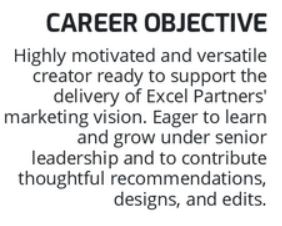
How to measure your impact as a graphic designer
Clients and customers appreciate your designs, but it can be tricky to link graphic design to business growth. Don’t gloss over metrics, though; they’re worth the extra effort.
Design can become a key contributor to success, but only if you demonstrate how design is related to growth. There are various ways you can measure your impact on your graphic designer resume:
- Online success: if you’re dealing with digital design projects like a website or email marketing, it’s easy to trace metrics like engagement and conversions. A/B tests may also help you compare particular design details to determine which projects perform best.
- Improved sales: your design project(s) may facilitate an increase in the number of customers or number of purchased goods, pointing to successful work on your end.
- Increased customer retention: if your graphic design work piques a customer’s interest, they’re more likely to stick around and purchase something. Or, they can share your work and increase your company’s reach.
- Customer reviews and comments: keep track of good client reviews to show companies that your work is loved and impactful.
You may be thinking, “that’s great, but how do you translate that into a resume?” Our samples can provide some worthwhile inspiration, as seen here:

Build a custom graphic designer resume
For every graphic design job you apply for, you need to tailor your resume accordingly. Customizing your graphic designer resume not only demonstrates competency but also care and attention towards the employer and the specific position. Trust us: there aren’t many job seekers taking the extra time to tailor their resumes accordingly, so make yours unique by tailoring your skills, work experience, and objective/summary sections for every job.
We also have customization tips for different graphic designer job descriptions and graphic designer cover letters .
Graphic designer or graphic design specialist resume
- As a graphic designer or graphic design specialist, you likely have solid experience under your belt already, so this might be the time to include a summary statement highlighting your best skills and achievements.
- Again, pay close attention to the skill keywords listed in the job description.
Creative graphic designer resume
- For example, if you design ads for social media, reflect this in your skills and work experience.
- Leverage your job description bullet points to showcase your leadership and teamwork abilities. Include any work on various projects with co-workers or cross-functional teams.
Senior graphic designer resume
- Lead a team
- Communicate with cross-functional teams and internal management
- Manage (and finish) projects
- Additionally, with this level of experience, you may choose to include a career summary. Don’t forget to tailor it to the new role you’re seeking!
Junior graphic designer resume
- Nabbing that first real job can feel daunting when most employers want at least a year of experience, but all is not lost.
- Include any internship experience, if you have it. If you don’t, consider getting an internship to gain useful skills and a new addition to your resume.
- Projects can also be priceless. Have you designed a custom website for a friend? Did you create a logo for your aunt’s small business? These sorts of one-time projects may not pay well (or at all), but they can prove you have what it takes to do the job.
Key points for your graphic designer resume
By taking your graphic designer resume seriously, you’ll be far ahead of the average applicant and much closer to accepting a job offer.
Now it’s time to put the pedal to the metal and actually write your resume. Upload an old resume or start from scratch with our free resume maker . You can choose from our best resume templates for an attractive and ATS-friendly layout that’s sure to snag the attention of recruiters.
Your dream job is just around the corner, so get your resume in tip-top shape and land the job you’ve been waiting for!

Graphic Designer Resume Sample & Guide [21+ Examples]

You’re a graphic designer. You’re smart. You’re creative.
You design creative ads, product packaging, and websites on a daily basis.
But when it comes to creating a resume, you’re stumped.
How do you make a graphic designer resume, anyway?
Is it exactly the same as a resume for any other profession?
Do you attach your portfolio with the resume? Or do you include the links inside?
There’s a ton of things that are not clear when it comes to making a graphic designer resume, which brings out to this article.
We’re going to walk you through the entire process of creating a graphic designer resume step-by-step!
- A job-winning graphic designer resume example
- How to write a designer resume that’ll keep getting you invited to interviews
- How to make your graphic designer resume stand out [with top tips & tricks]
Now, before we move on, here’s some inspiration:
A graphic designer resume example, created with our very own resume builder:

How to Format a Graphic Designer Resume
Before you can start working on your resume, you need to decide on the formatting.
After all, the hiring manager will think twice before hiring a graphic designer who’s resume isn’t well-formatted.
In 2024, the most common resume format is “reverse-chronological,” so we’d recommend starting with that:

Other resume formats you could try are:
- Functional Resume - This format is a lot more about your skills as opposed to professional experience. It’s good if you don’t have a lot of experience, are transferring to a new industry, or have gaps in your employment history.
- Combination Resume - As the name suggests, a combination resume is a mix between “Functional” and “Reverse-Chronological.” Meaning, it focuses both on skills AND work experience. You can use a combination resume if you have a lot of work experience or changing industries.
Once you’ve decided on the format, you need to get your resume layout right.
Here’s what we recommend:
- Margins - One-inch margins on all sides
- Font - Pick a font that stands out, but not too much. Do: Ubuntu, Roboto, etc. Don’t: Comic Sans
- Font Size - Use a font size of 11-12pt for normal text and 14-16pt for headers
- Line Spacing - Use 1.0 or 1.15 line spacing
- Resume Length - Don’t go over the 1-page limit. Having trouble fitting everything into one page? Check out these one-page resume templates.
As a designer, you have a lot more freedom on what kind of resume design you go with. Feel free to pick a more creative template to show off your imagination!
Use a Graphic Designer Resume Template
If you’ve ever made a Word resume, you’d probably agree with us: it’s a total pain.
You have to play around with the formatting longer than it actually takes you to fill in the contents.
Then, you decide to make a single, small layout change, and BAM! Your entire resume layout falls apart.
Want to make your life easier? Use a graphic designer resume template .
What to Include in a Graphic Designer Resume
The main sections in a graphic designer resume are…
- Contact Information
- Work Experience
If you want your resume to stand out more, you can also try these optional sections:
- Awards & Certification
Interests & Hobbies
Now, we’re going to go through each of those sections, and explain how to write them.
Not sure which sections to use? Check out our guide to What to Put on a Resume .
How to Get Your Contact Information Right
Even if you get everything else right in your resume, if you mess up the contact information section , you won’t be getting a lot of interview invitations (mainly because they won’t be able to call your misspelled phone number).
For your contacts, include:
- Title - In this case, “Graphic Designer.” Make this specific (the role you’re applying for), and don’t try to be too creative (Master of Designs).
- Phone Number - Double-check, triple-check this. One small tiny can really mess up your chances.
- Email Address - Make sure to use a professional email address ([email protected]), and avoid that email you created back in 5th grade ([email protected]).
- Portfolio Link - Behance , Dribble , or your personal website
- (Optional) Location - Applying for a job abroad? Mention your location.
- Josh Fakester, Graphic Designer. 101-358-6095. [email protected]
- Josh Fakester, Graphic Design Guru. 101-358-6095. [email protected]
How to Write a Graphic Designer Resume Summary or Objective
Fun fact - recruiters spend less than 6 seconds reviewing each resume. This isn’t that surprising, though. You can’t expect them to read all 200 resumes end-to-end.
So, if the recruiter doesn’t see that you’re relevant for the job in a single glance, your resume won’t even be read.
Now, the question is, what can you do to hook the recruiter the moment they look at your resume.
The answer is simple: use a resume summary or objective .
As a quick intro, both resume summary and objective are sections that go on top of your resume, just under the contact information section.

The main difference between the 2 sections is that:
A resume summary is a 2-4 sentence summary of your professional experiences and achievements.
- Graphic designer with a strong background in marketing design. 5+ years of experience in creating infographics, Facebook ad creatives, banners ads, and more. Passionate about working in a marketing agency, as that involves creating graphics for clients in all sorts of fields.
A resume objective , on the other hand, is a 2-4 sentence snapshot of your professional goals and aspirations.
Motivated graphic design student looking for an entry-level job at Software Company X. Passionate about web & UX / UI design. Experience creating websites designs for made-up businesses as a student at University X. Skilled in Adobe Creative Suite, including Photoshop, InDesign, Illustrator, and more.
So, which one do you pick? A summary, or an objective?
As a rule of thumb, you always go for Summary if you have any work experience, and you go for Objective if you’re new to the field (student, graduate, or switching careers).
How to Make Your Graphic Designer Work Experience Stand Out
Work experience is the most important section in your resume (after your portfolio, of course).
Sure, your design skills are super important, but so is your professional experience. Here’s how to structure your work experience section:
- Position name
- Company Name
- Responsibilities & Achievements
Or, here’s what it looks like in practice:

Now, if you really want to stand out, you should focus on talking about your achievements instead of responsibilities.
Instead of saying:
“Charged with designing client companies...”
“Designed 15+ client company websites from start to finish”
So, what’s the difference between the two?
The second one is more specific. You know exactly what the person did, and you can say that they’re reliable.
The first example, on the other hand, is too generic. Sure, you were charged with designing client websites, but you can’t tell if you’re a complete newbie (designed 1-3 websites), or an expert (designed 15+ different websites).
What if You Don’t Have Work Experience?
Maybe you’re a recent university graduate looking for your first design job?
Or maybe, you just picked up graphic design from online courses, but have no real experience in the field?
Whichever the case might be, don’t worry!
If you’re applying for entry-level graphic designer positions, there’s a good chance they won’t be asking a lot about your experience.
What really matters here is your portfolio.
If you already have some designs, feel free to put them up online and link it in your resume (we’re going to explain how in a bit).
If you don’t, though, you can always make them now.
Here are several ways you can get a portfolio (and get paid for it):
- Pick up some freelance gigs on UpWork
- Ask your friends & acquaintances if they know anyone that needs cheap design work
- Join an online contest on a site like 99 Designs
- None of the above options working? Sit down in your own time and create some mock-ups. Design a website , some flyers, product packaging, whatever you’re interested in!
If you’re a recent graduate, you might want to check out our guide on how to make a student resume !
Use Action Words to Make Your Graphic Designer Resume POP!
- “Responsible for”
- “Worked in”
These are the most common words you’ll find on ANY resume.
And since you want YOURS to stand out, we’d recommend avoiding them as much as possible.
Instead, use some of these power words to make your responsibilities and achievements stand out:
- Conceptualized
- Spearheaded
How to Add a Portfolio to Your Resume
You can add a portfolio section pretty right about the same way you’d add work experience.
Create a header named “Portfolio,” link to your website (or Behance / Dribble), and list the designs you’ve worked on. And here’s how this looks like:

If you don’t want a dedicated section for your portfolio, you can simply link to your online portfolio in your contact information section.
How to List Education Right
The next section in any graphic designer resume is the “Education.”
This one’s pretty straightforward. Simply list out your education entries, and you’re gold!
- Degree Type & Major
- University Name
- Years Studied
- GPA, Honours, Courses, and anything else you might want to add
And here’s a practical example:
B.A. in Graphic Design
Boston State University
- Relevant Courses: Typography 101, Introduction to Graphic Design, Advanced Graphic Design, Web Design
Clear? Good!
Before we move on, here are some of the most frequent questions we get about education on a resume (and their answers!):
- Q: What if I haven’t finished college?
A: Whether you’re still a student, or you dropped out, you should still mention your degree. All you have to do is include the years studied, and you’re good.
- Q: Do I list my high school education?
A: Only if you don’t have a higher education. No one cares about your high school education if you have a B.A.
- Q: What goes first, education or experience?
A: If you have any relevant work experience, then experiences go on top. If you don’t, though, then education.
Still have some questions? Check out our guide on how to list education on a resume .
Top 17 Skills for a Graphic Designer Resume
When the HR manager is going through your resume, they’re looking to see if you have the right skills for the job.
Imagine this: you’re the best graphic designer in the world and your resume is impeccable. BUT, you still get rejected, because you didn’t mention that you know HTML and CSS in your resume, which was one of the main requirements.
Not sure which skills to pick?
Here are some of the most common graphic designer skills.
Hard Skills:
- Illustrator
- UX / UI Design
- Print Design
- Infographic Design
- Product Packaging Design
Soft Skills:
- Communication
- Time-Management
- As a general rule, we’d recommend not to go overboard with “Soft Skills.” They’re a lot harder to back up, especially if you’re a student or a recent graduate. Just about anyone can say that they’re “creative,” but not a lot of people are experts at InDesign.
Looking for a more comprehensive list? Here’s a mega-list of 150+ must-have skills in 2024 .
Other Resume Sections You Can Include
At this point, you’re probably ready to wrap up your resume and call it a day.
After all, we’ve covered all the essential sections, right?
Well, not exactly. See, the #1 goal of your resume is to stand out.
And if your resume looks exactly the same as everyone else’s, that’s where you fail.
If you’re already a good match for the job in terms of skills and experiences, these sections could end up being the deciding factor that gets you hired (and makes you stand out from the rest).
Awards & Certifications
Did you win a design competition during university?
Do you have a bunch of online courses completed on Coursera?
Whichever the case may be, definitely mention all of them in your resume!
- Infographic X published on entrepreneur.com
- User Experience Research & Design Coursera Certificate
- Adobe Certified Expert
- Advanced Graphic Design Class at MadeUpUniversity
- Video Game Concept Art Coursera Certificate
Are you passionate about graphic design?
Well, awesome! That’s exactly what your next employer likes to hear.
And what’s a better way to show off your passion than with a project.
Whether it’s a university project or a personal side-hustle, HR would love to know more.
Here are some of the potential projects you could mention…
- Instagram page showing off your designs & art
- Mock-up website you designed at a hackathon
- University project where you designed a website for a fake business
- Side-hustle designing logos for clients on Fiverr
- Designing your own blog
An extra language or two can always come in handy, even if it doesn’t have anything to do with the position you’re applying for.
If you know any foreign language & have extra space in your resume, feel free to add a language section.
Make sure to split the languages by proficiency:
- Intermediate
Now, you might be thinking, “what does my skateboarding hobby have to do with my profession as a graphic designer?”
Well, nothing, but it does have something to do with you as a person.
Most companies aren’t hiring a robot who’s going to pump out design after design, 9-to-5, every day.
They’re looking for someone they’re going to enjoy working with, someone they’ll get along with.
And what’s something you can bond with potential employers about? Hobbies and interests, exactly!
Not sure which hobbies & interests you want to mention? We have a guide for that!
Match Your Cover Letter with Your Resume
Yep, that’s right.
You might be thinking, “A cover letter?! I’m a designer, not a writer!”
Well, here’s the thing: cover letters are still very important.
They show the recruiter that you’re passionate about working for THIS position in THIS company, and you aren’t just sending your resume all over the place.
Having a solid cover letter with your resume can significantly boost your chances of getting the job.
The first step to writing a convincing cover letter is to get the structure right. Here’s how to do that:

And here’s what you’d write in each section:
Contact Details - Your personal contact information, including full name, profession, email, phone number, location, website (or Behance / Dribble).
Hiring Manager’s Contact Information - Full name, position, location, email
Opening Paragraph - Your introduction should be very strong. If you don’t manage to hook the hiring manager here, chances are, they’re not going to read the rest of it. So, mention:
- The position you’re applying for
- Your experience summary and top achievement
The Body - Once you’ve got the hiring manager hooked, you can go through the rest of your background. Some of the points you can mention here are...
- Why you want to work for this specific company
- Anything you know about the company’s culture
- What are your top skills and how are they relevant for the job
- If you’ve worked in similar industries or positions
Closing Paragraph - This is where you:
- Wrap up any points you missed in the body paragraph
- Thank the hiring manager for their time
- End with a call to action. Something like, “I’d love to further discuss how my experience as an X can help the company with Y”
Formal Salutations - Use a formal closing, such as “best regards” or “Sincerely.”
Need more inspiration? We get it - creating a cover letter is very hard work. But don’t worry, we’ve got you covered with your step-by-step guide on how to write a cover letter .
Key Takeaways
If you followed everything we just taught you to the T, you’re pretty much guaranteed to land the job.
Now, let’s go through everything we’ve learned real quick:
- Get the right formatting for your graphic designer resume. Use a reverse-chronological format, and follow the best practices we mentioned on getting the layout right.
- Use a resume summary or objective to catch the hiring manager’s attention.
- In your work experience section, try to talk more about your achievements than your responsibilities.
- Get your portfolio section right. After all, this is the section that’s going to land you the job.
- Match your graphic designer resume with a convincing cover letter.
Related Resume Examples
- Architect Resume
- Construction Project Manager Resume
- Career Change Resume
Suggested Readings:
- 9+ Essential Resume Ideas [to Get Your Next job]
- +10 Best Answers for Why Should We Hire You?
- 40+ Best Job Search Sites in 2024 [For Every Industry]

To provide a safer experience, the best content and great communication, we use cookies. Learn how we use them for non-authenticated users.
Resume Worded | Proven Resume Examples
- Resume Examples
- Design Resumes
14 Graphic Designer Resume Examples - Here's What Works In 2024
Graphic designers are more in demand than ever, which makes now the perfect time to apply for that graphic design role. this guide will teach you the most important steps for writing an effective graphic designer resume, including templates for you to use and industry-specific tips..

Graphic designers create customer-focused designs, frequently working on projects like websites, games, product packaging, and advertising campaigns. Most graphic design work is based around marketing and visual branding, but employment opportunities can include everything from creating logos for multinational corporations to working with local governments and schools. As a graphic designer, you’ll work account managers and creative directors to create a brief, develop concepts, and finalize a design that meets the client’s objectives. You’ll need excellent time management, the ability to collaborate well and work under pressure, and of course a hefty dose of creativity. Traditionally, graphic designer jobs ask for an undergraduate graphic design degree, but recent trends have seen the industry move away from requiring formal qualifications and toward online short courses. Either way, you’ll need hard skills with a variety of design software including Acrobat, Dreamweaver, Illustrator, and InDesign, along with an impressive portfolio to showcase your skills.
Graphic Designer Resume Templates
Jump to a template:
- Graphic Designer
- Junior Graphic Designer
- Senior Graphic Designer / Director of Graphic Design
- Graphic Design Manager
- Freelance Graphic Designer
- Creative Graphic Designer
- Minimalist Graphic Designer
- Motion Graphic Designer
Jump to a resource:
- Keywords for Graphic Designer Resumes
Graphic Designer Resume Tips
- Action Verbs to Use
- Bullet Points on Graphic Designer Resumes
- Frequently Asked Questions
- Related Design Resumes
Get advice on each section of your resume:
Template 1 of 14: Graphic Designer Resume Example
A graphic designer communicates ideas through visual concepts. Their role is to conceptualize and develop a layout that communicates what stakeholders need to show. Graphic design can be used for many purposes, including captivating, informing, or inspiring consumers. That’s why their work is often used in advertising, social media channels, or reports. To become a graphic designer you should ideally have a bachelor’s degree in Graphic Design or a related field. However, it’ll depend on your potential employer’s requirements. There are many high-talented graphic designers out there with non-traditional training. Yet, you should consider one thing; highlight your technical and creative skills on your resume.
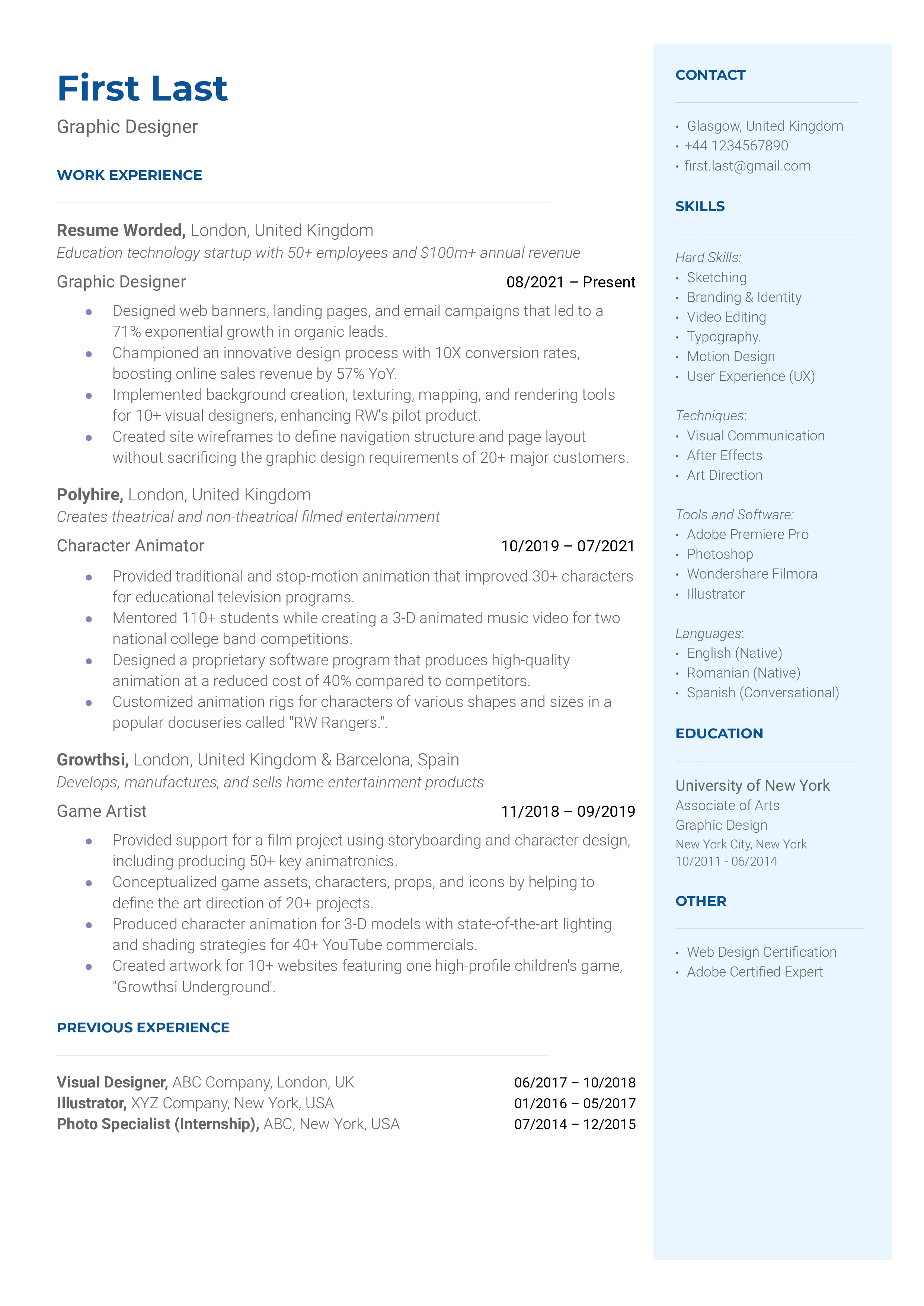
We're just getting the template ready for you, just a second left.
Tips to help you write your Graphic Designer resume in 2024
mention your user experience skills..
User experience (UX) is the way users interact with a particular product or design. This design should be accessible, usable, and appealing. This is particularly important when you’re working or trying to get a job in tech: recruiters want to know whether you can apply your offline skills to the online world. Even though both developers and graphic designers are not related, they can work together on integrating a design into web/software development.
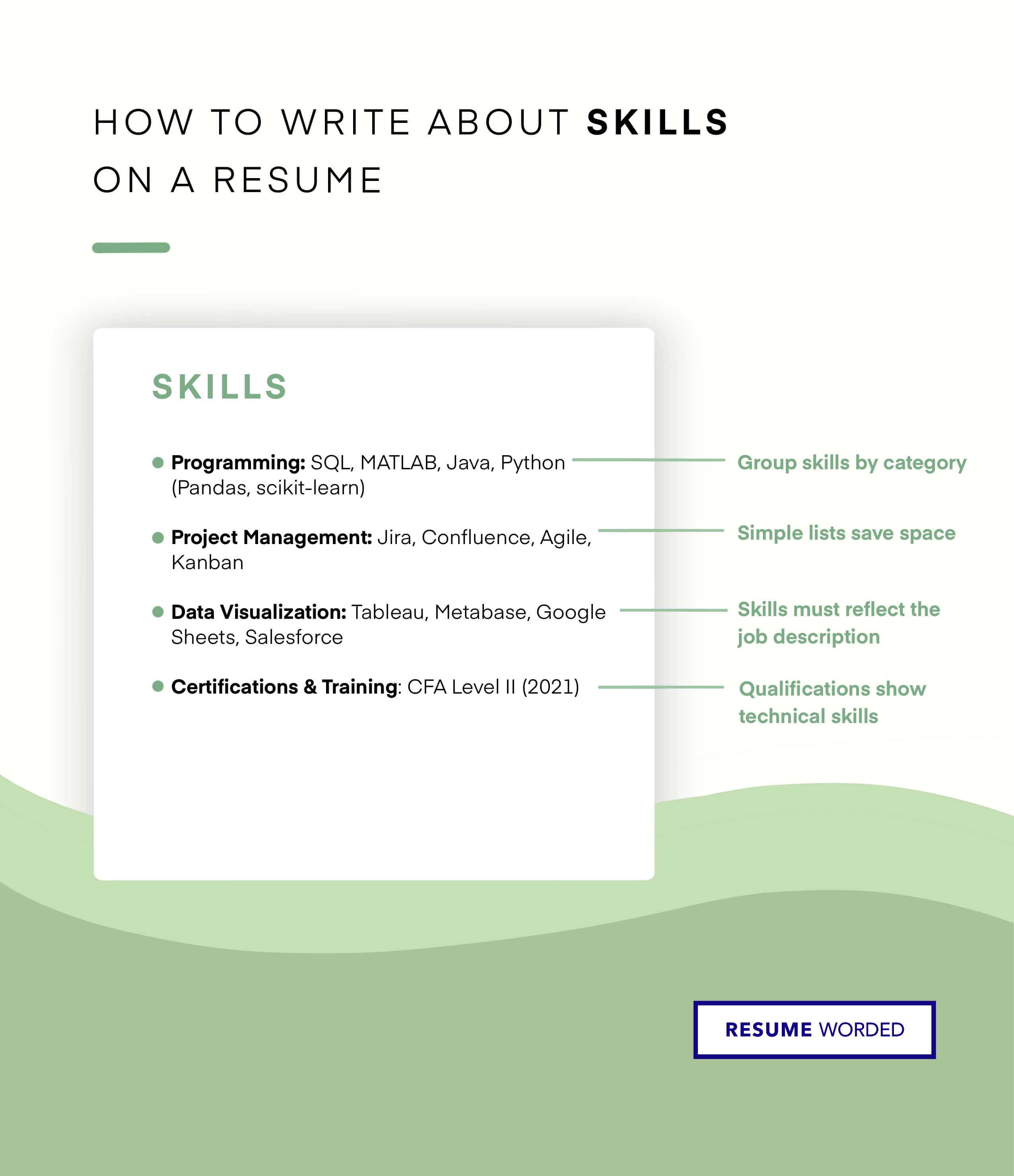
Emphasize projects where you crafted a brand or identity.
Branding and identity play a huge role in graphic design. It’s a combination of visual elements that represent a company’s identity. It is the way they want to portray themselves to the consumers.
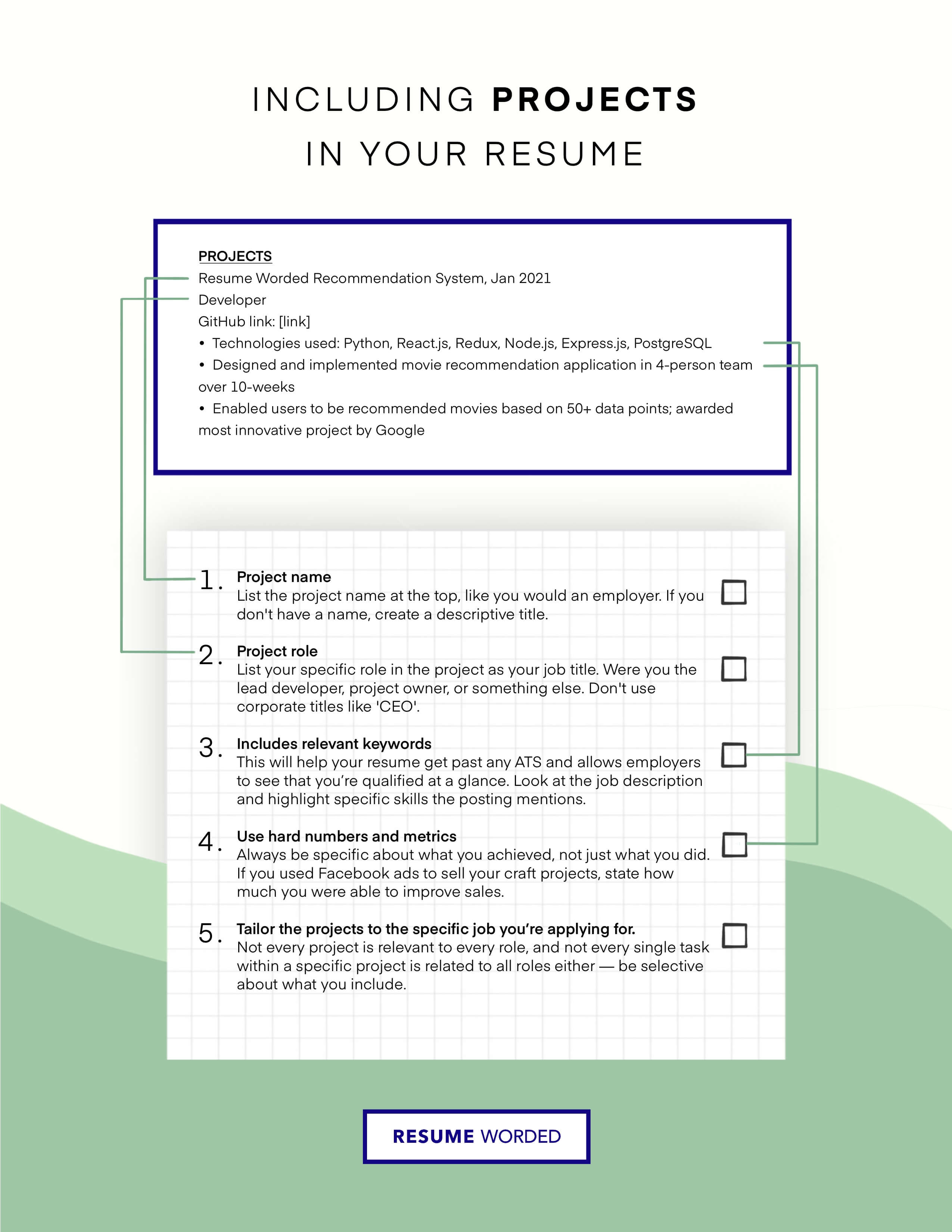
Skills you can include on your Graphic Designer resume
Template 2 of 14: graphic designer resume example.
As a graphic designer, you’ll be working closely with clients to develop their brands and ensure the success of their advertising and marketing campaigns. Put your best foot forward with a resume that emphasizes your hard skills, proficiency with graphic design software, and experience contributing to the success of client projects.
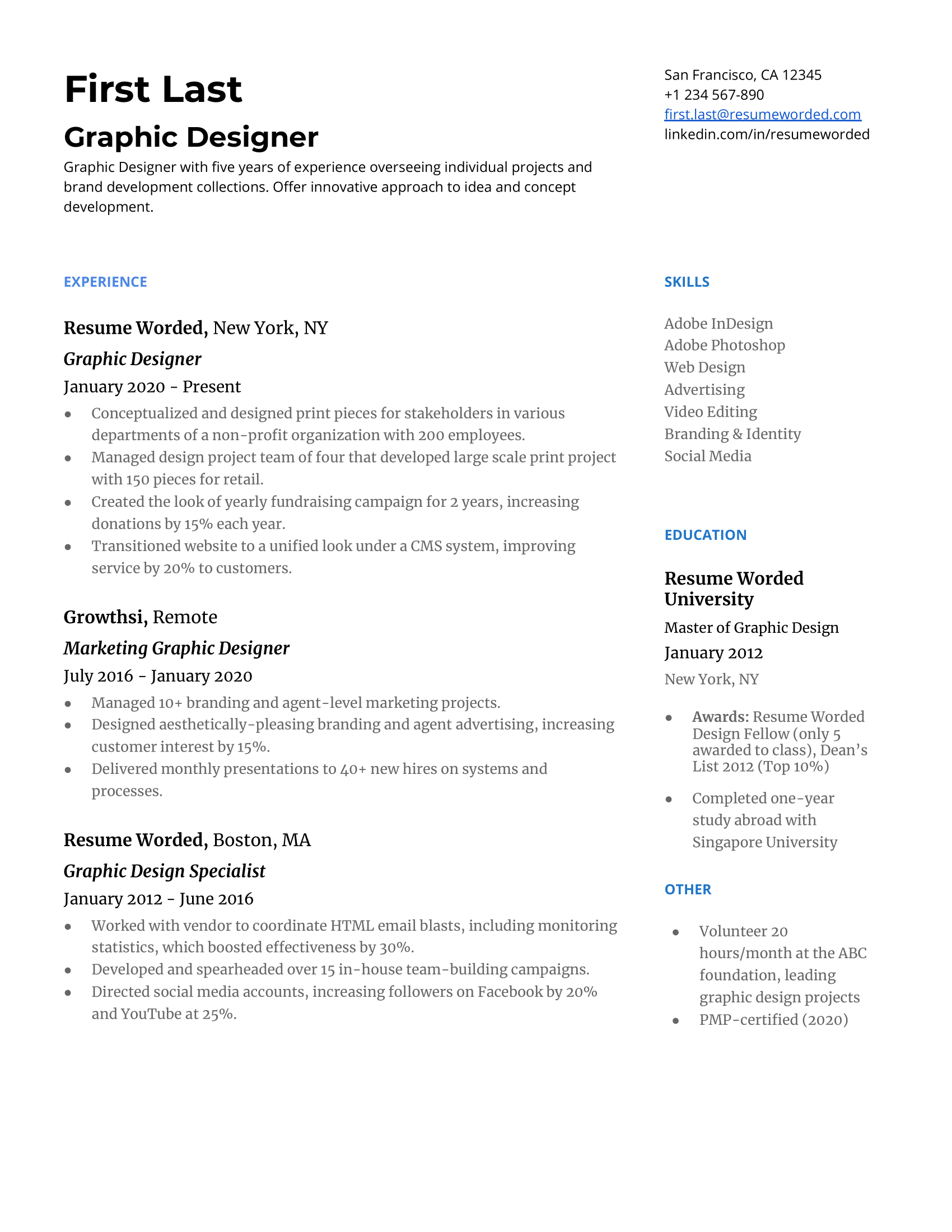
Bullet points feature strong action verbs highlighting graphic design skills
Structuring your bullet points to lead with strong action verbs like “conceptualized,” “designed,” and “developed” emphasizes your role in the projects you’ve worked on. By focusing on accomplishments rather than simply listing job duties, you’re telling potential employers what they want to know and highlighting the skills you’ll need on the job.
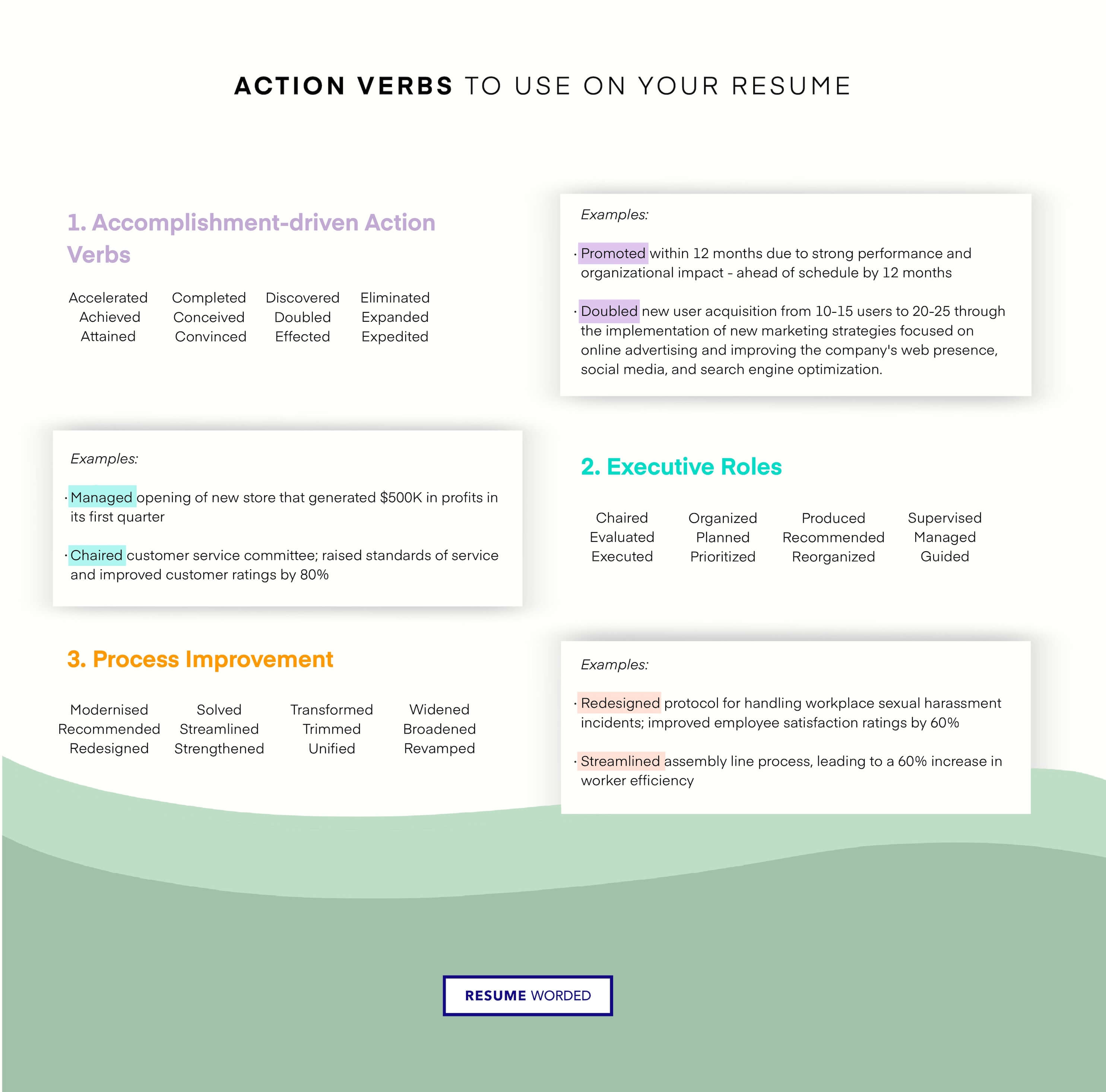
Good use of skills section to highlight graphic design skills
You don’t need a long list of skills to impress a recruiter — in fact, the more concise you can be, the better. Keep your list of skills down to the ones most relevant for a graphic designer role, like design software, advertising, social media, and branding.
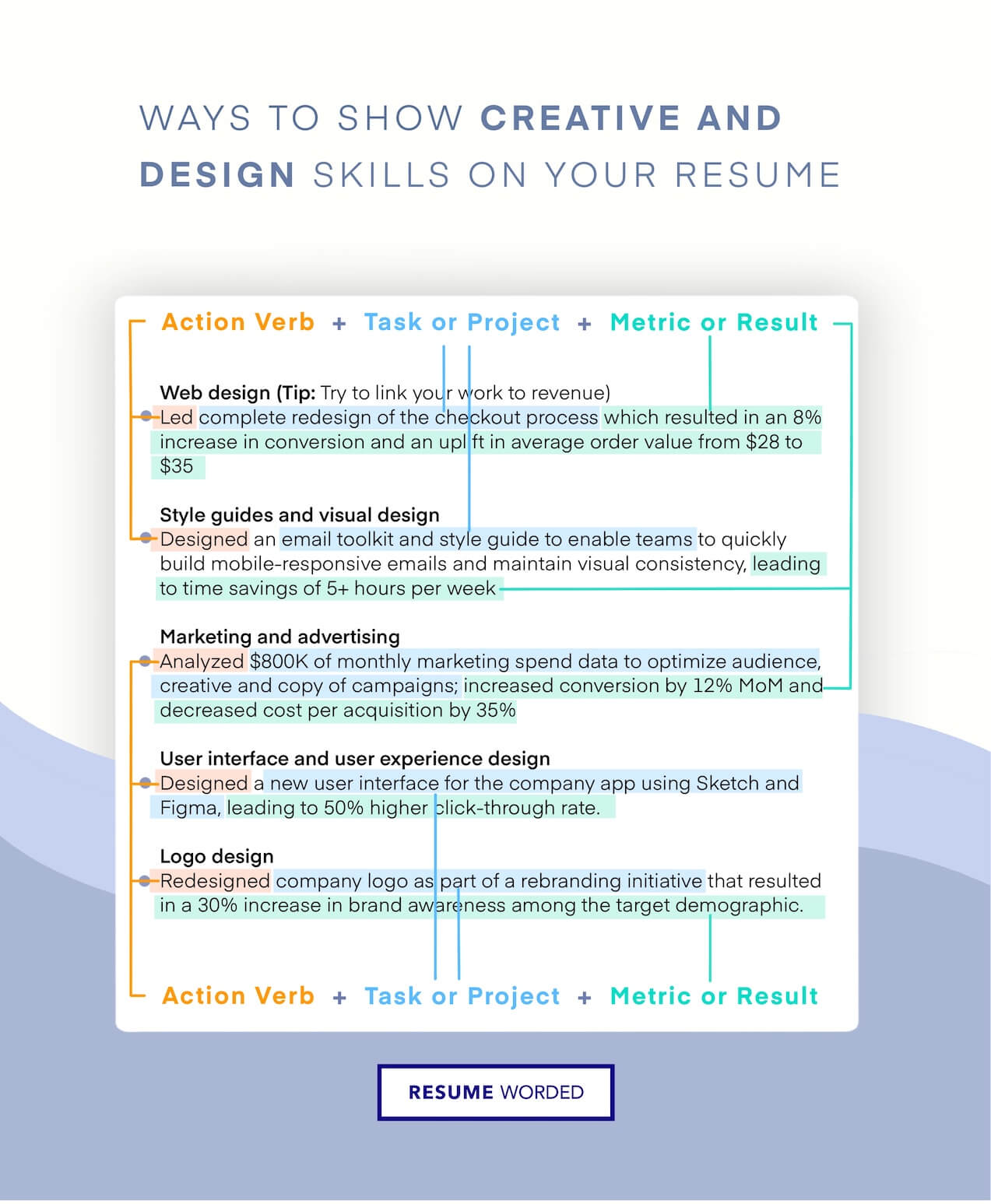
Template 3 of 14: Junior Graphic Designer Resume Example
The role of a junior graphic designer is to assist senior colleagues in crafting designs based on their specifications. They should also report to the senior graphic designer. In this role, you should demonstrate initiative and creativity, so it’s essential to demonstrate that in your resume. You can talk about previous projects in which you came up with innovative ideas. This way, your resume will not go unnoticed.
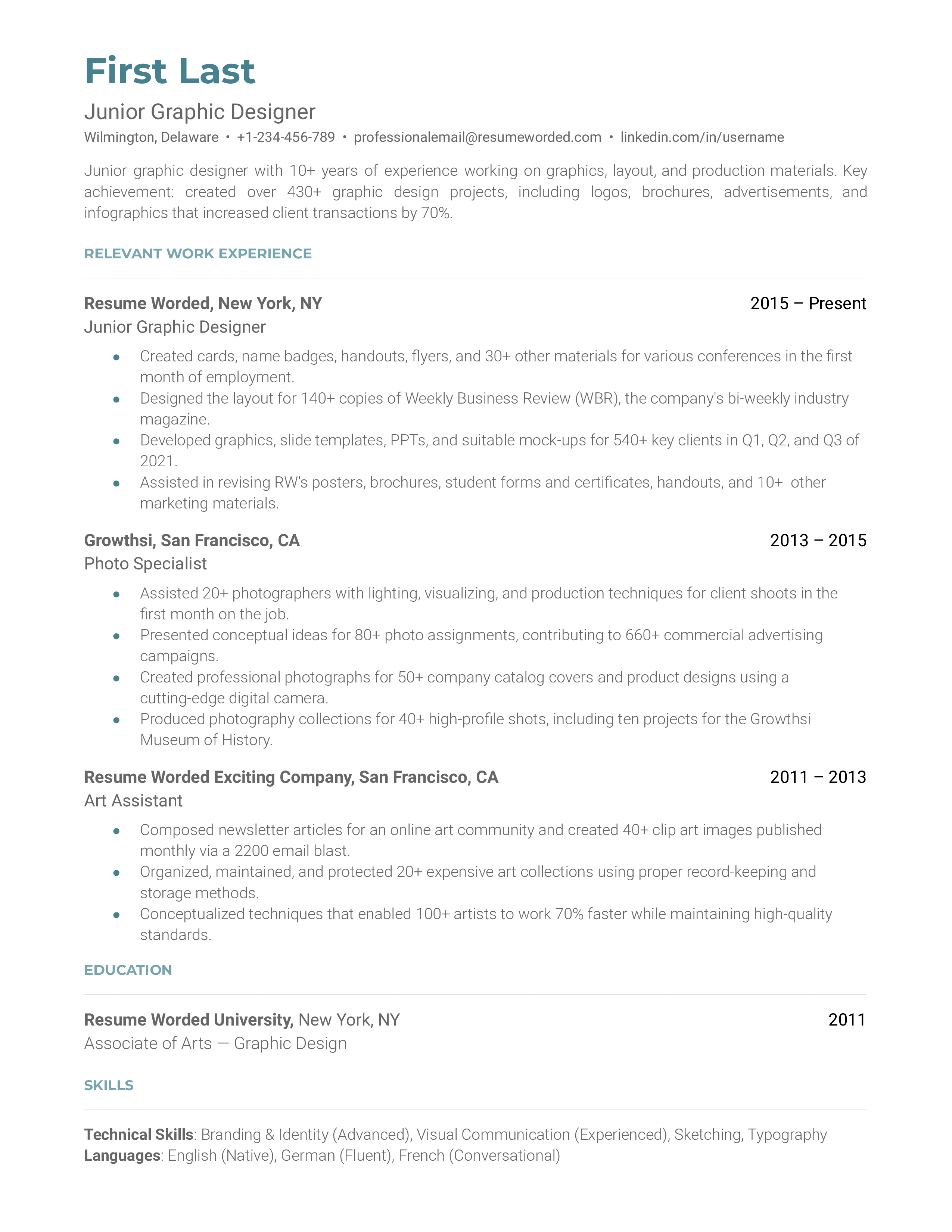
Tips to help you write your Junior Graphic Designer resume in 2024
include relevant art-related experience..
It’s ok if you don’t have extensive experience in graphic design. However, it doesn’t mean you can’t showcase your expertise. You can also include other art-related experiences, such as photography or art assistance. This is an opportunity to showcase your transferable skills.
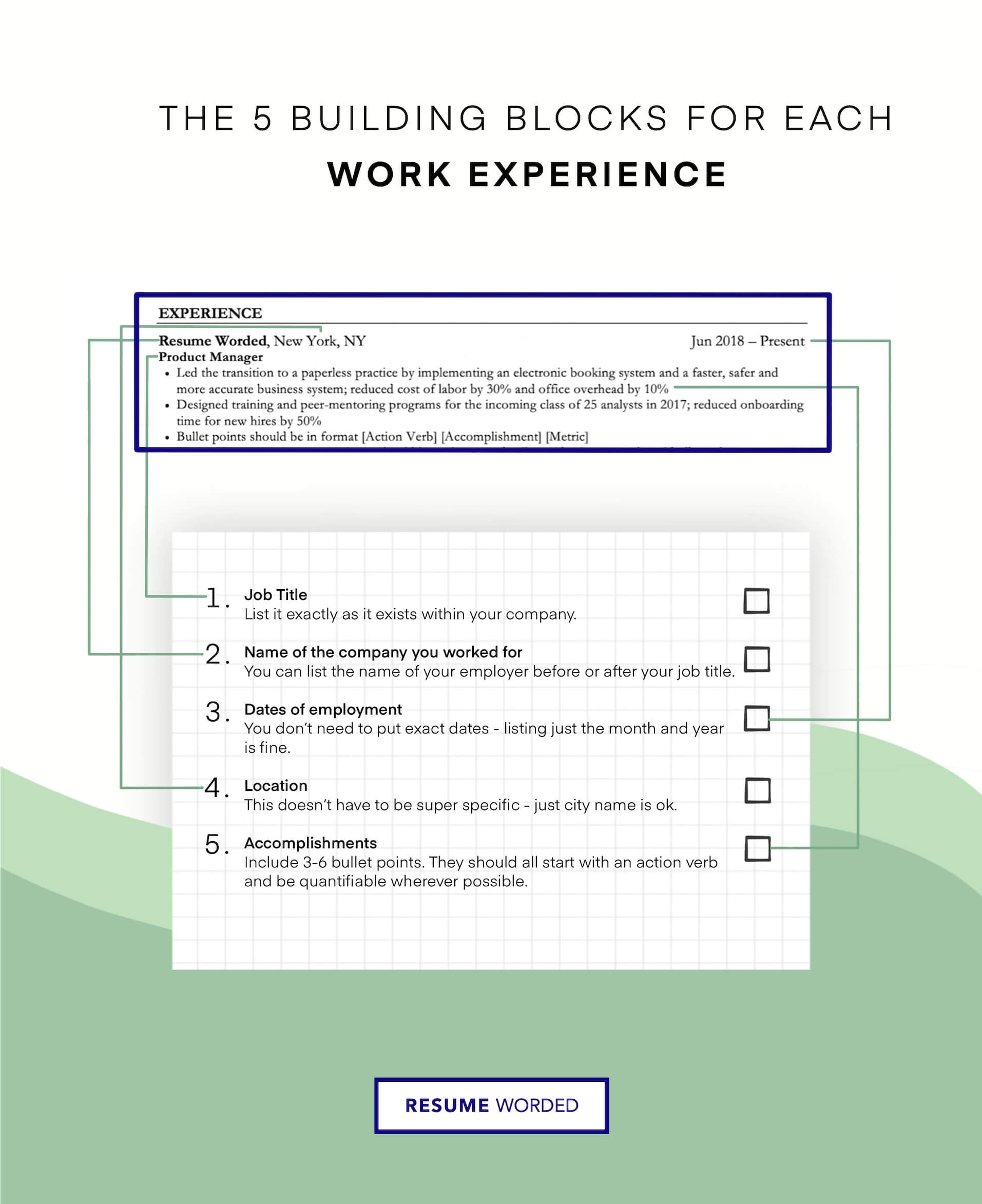
Highlight your collaborative skills.
As a junior graphic designer, you will be constantly working with team members. This is a role that requires excellent collaborative skills. That’s why it is important to highlight them in your resume. You can mention previous experiences in which you coordinated with a varied team.
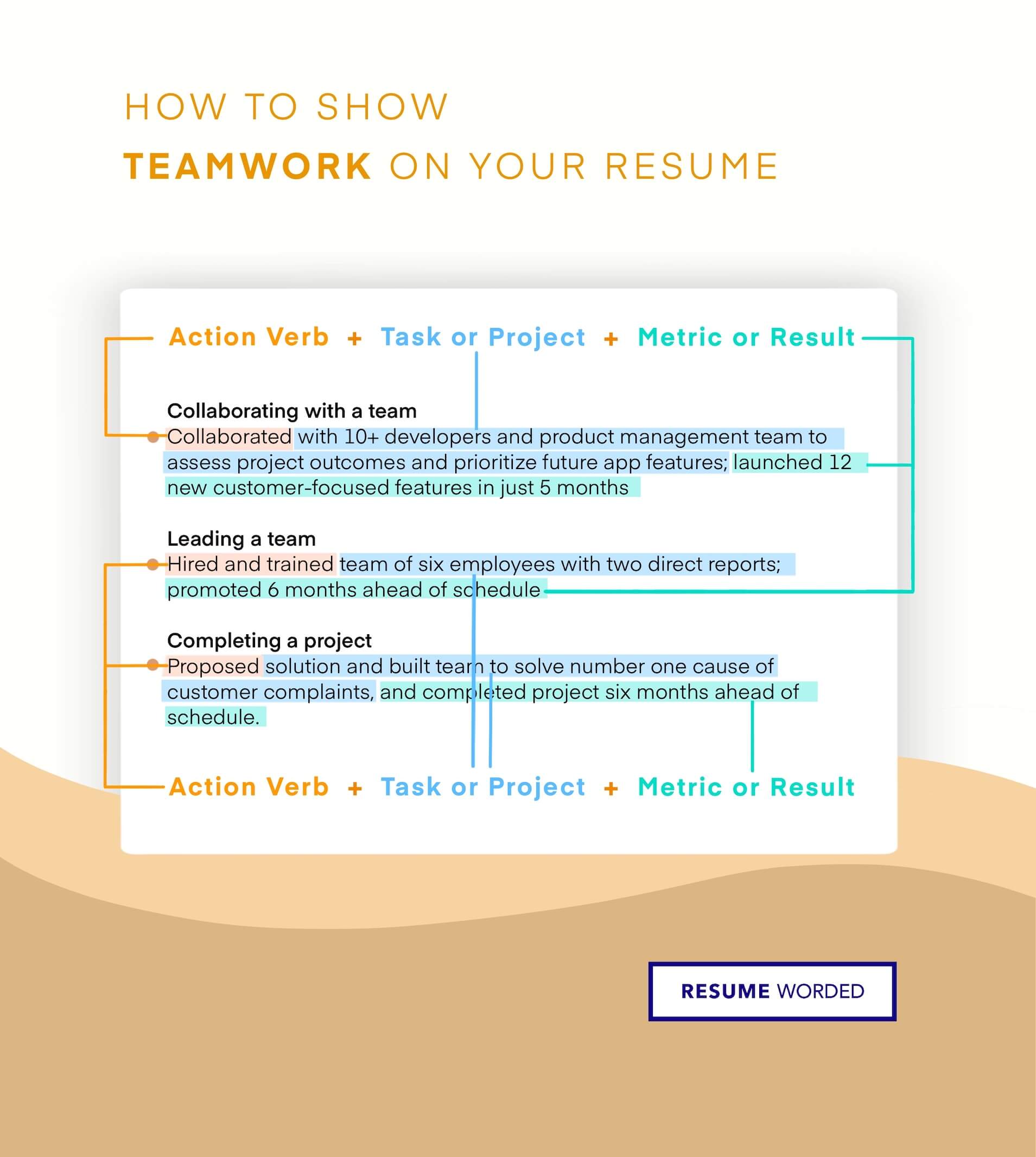
Skills you can include on your Junior Graphic Designer resume
Template 4 of 14: junior graphic designer resume example.
Landing a role as a junior graphic designer isn’t as hard as you might think. Most employers are looking for graphic design ability — as evidenced by your portfolio and qualifications — over extensive experience, which means emphasizing your hard skills and any relevant educational background. If you’re a recent graduate, don’t forget about university projects and internships, which can go a long way toward making up for minimal work experience.
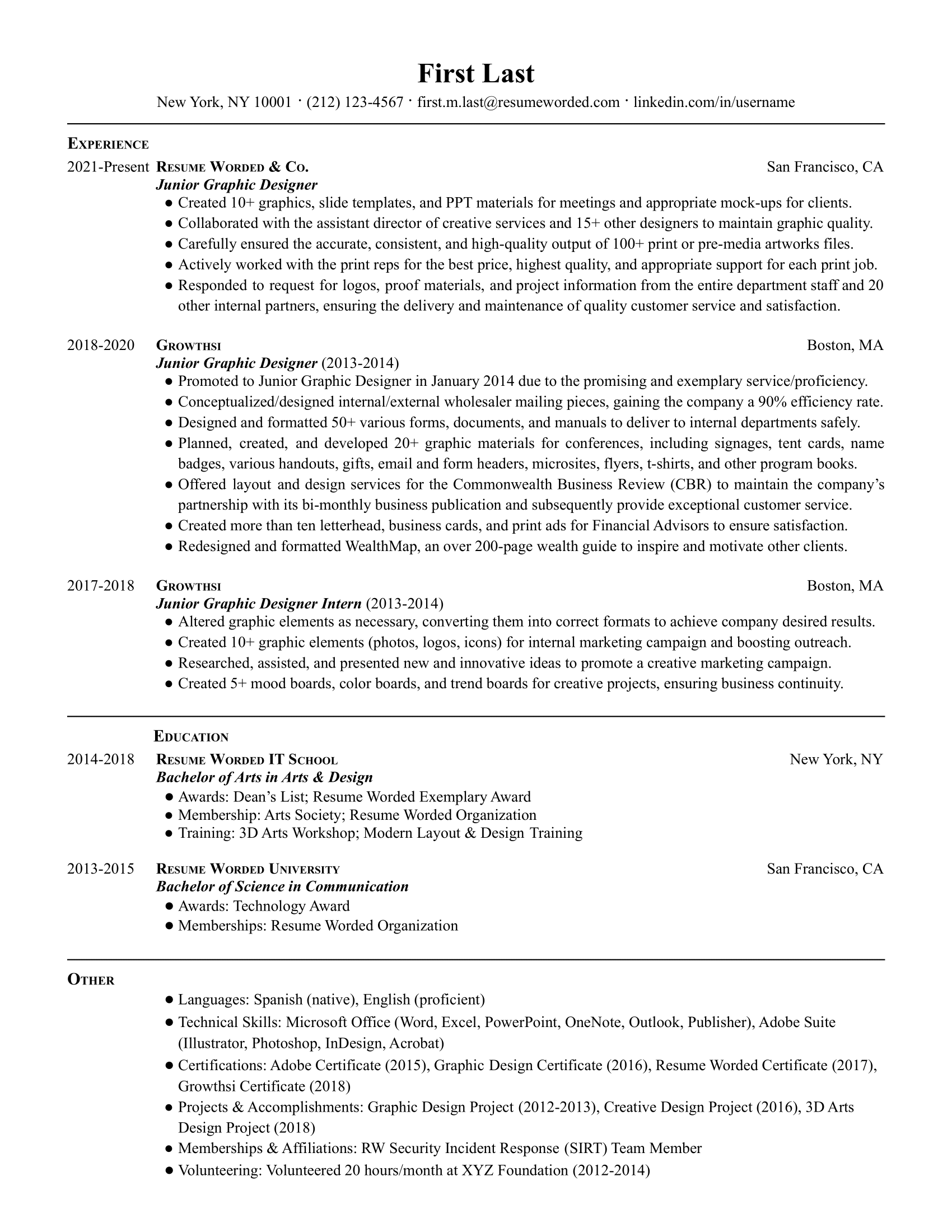
Strong Education section highlighting graphic design interest
As a recent graduate — or even if you’re a few years out and still applying for junior roles — your education section is a lot more important than it is for someone with more experience. You can use your education section to your advantage by listing any awards you’ve won, professional memberships, or specific qualifications that stress hard graphic design skills.
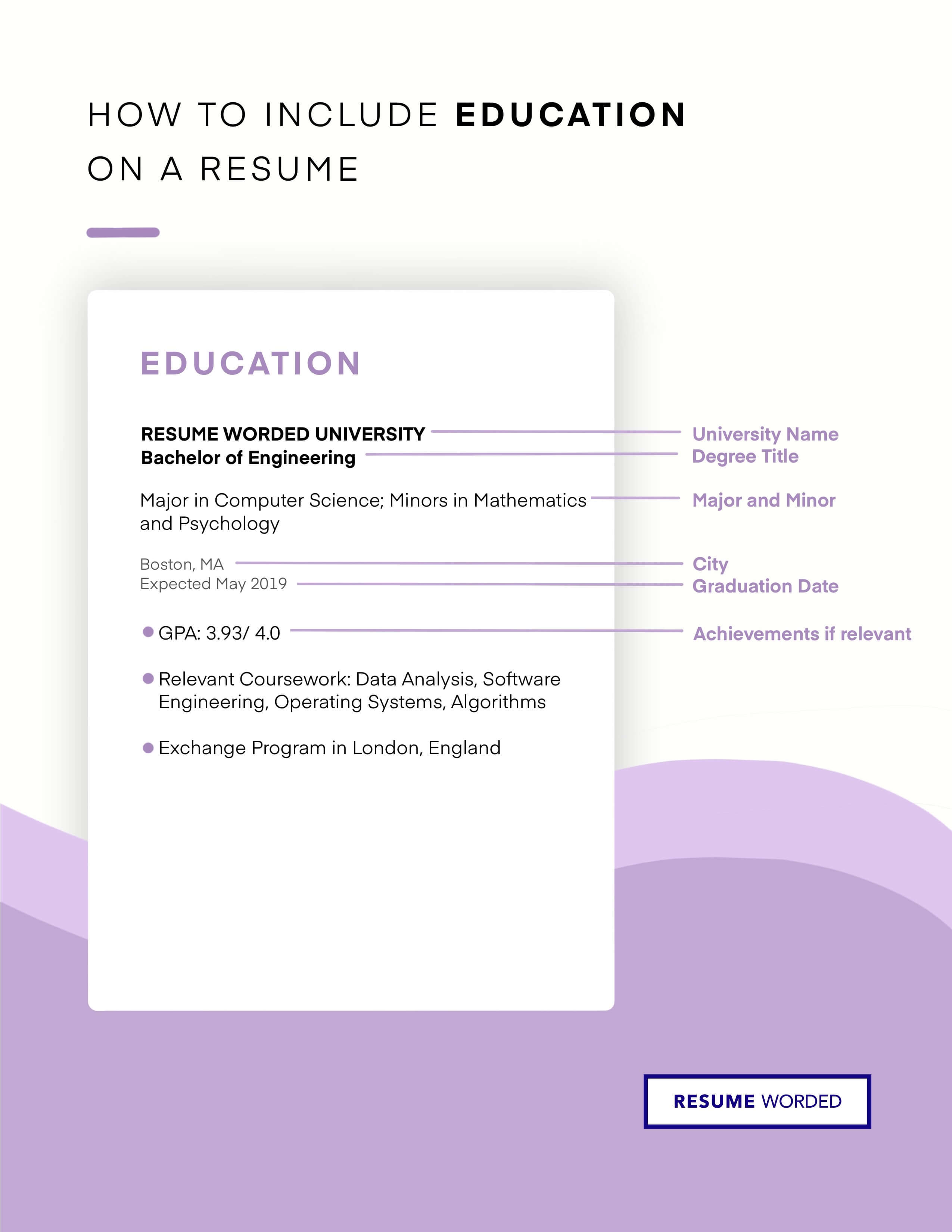
Internships and university projects relevant to graphic design
If you’re applying for an entry-level graphic design role, don’t worry if you don’t have a lot of experience. You can list any internships in the same way as you would regular work experience, using action verbs to emphasize what you accomplished. If you’ve completed any relevant university projects, make sure you highlight those, too.
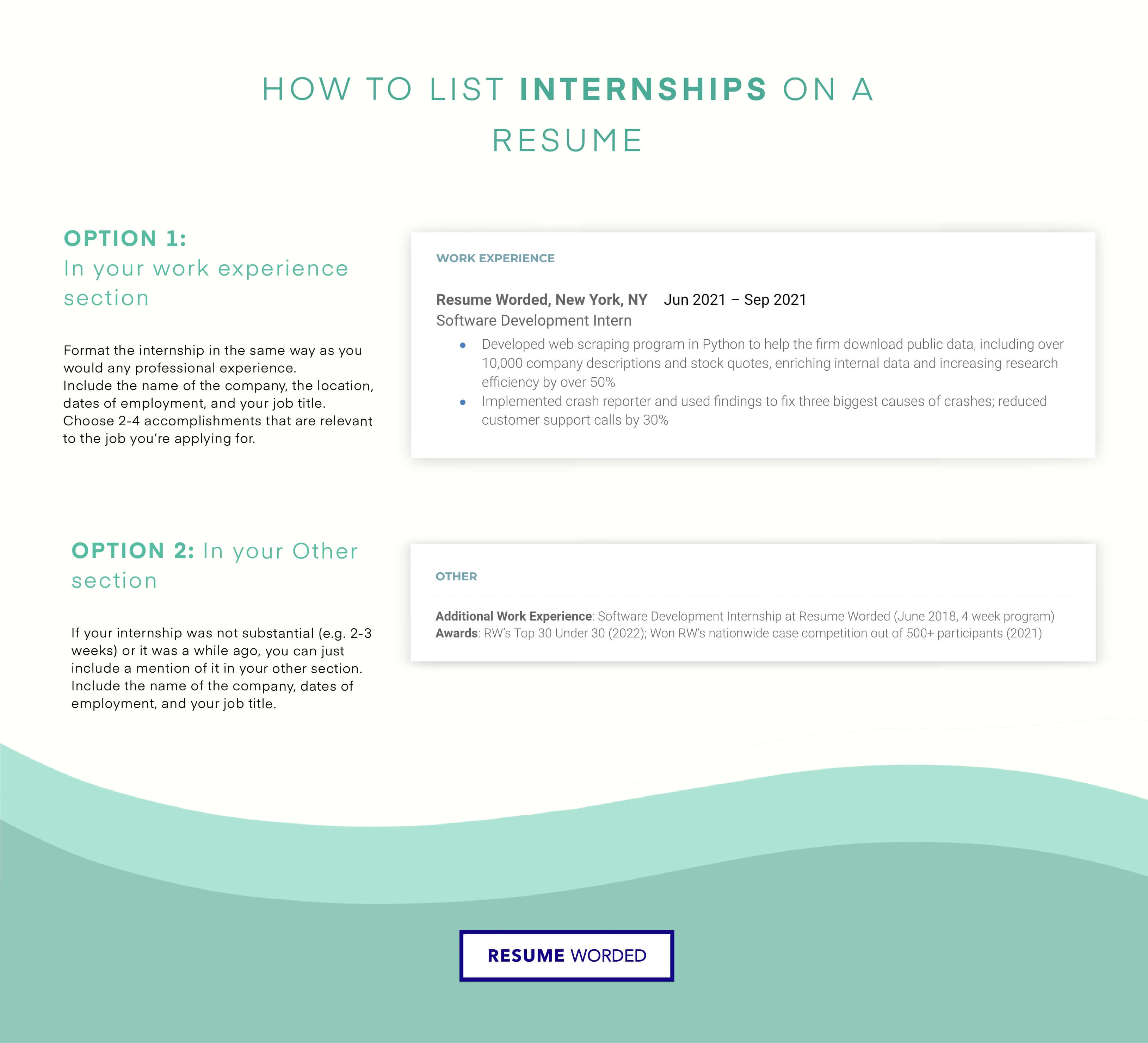
Template 5 of 14: Senior Graphic Designer / Director of Graphic Design Resume Example
A Senior Graphic Designer or Director of Graphic Design is no small gig. You're responsible for shaping the visual aspects of a brand and ensuring it remains consistent across all platforms. Lately, many companies require not just proficiency in design software, but also a solid understanding of digital and interactive design. When writing your resume, remember that while showcasing your design prowess is fundamental, so is demonstrating leadership skills and strategic thinking as they're crucial in steering the design team and efforts. In today's job market, employers are looking for Senior Designers who can balance the art and science of design. That means being able to back up your design choices with data and understanding how your work fits into the bigger marketing strategy. So, as you craft your resume, think about how your design work has directly contributed to business results.
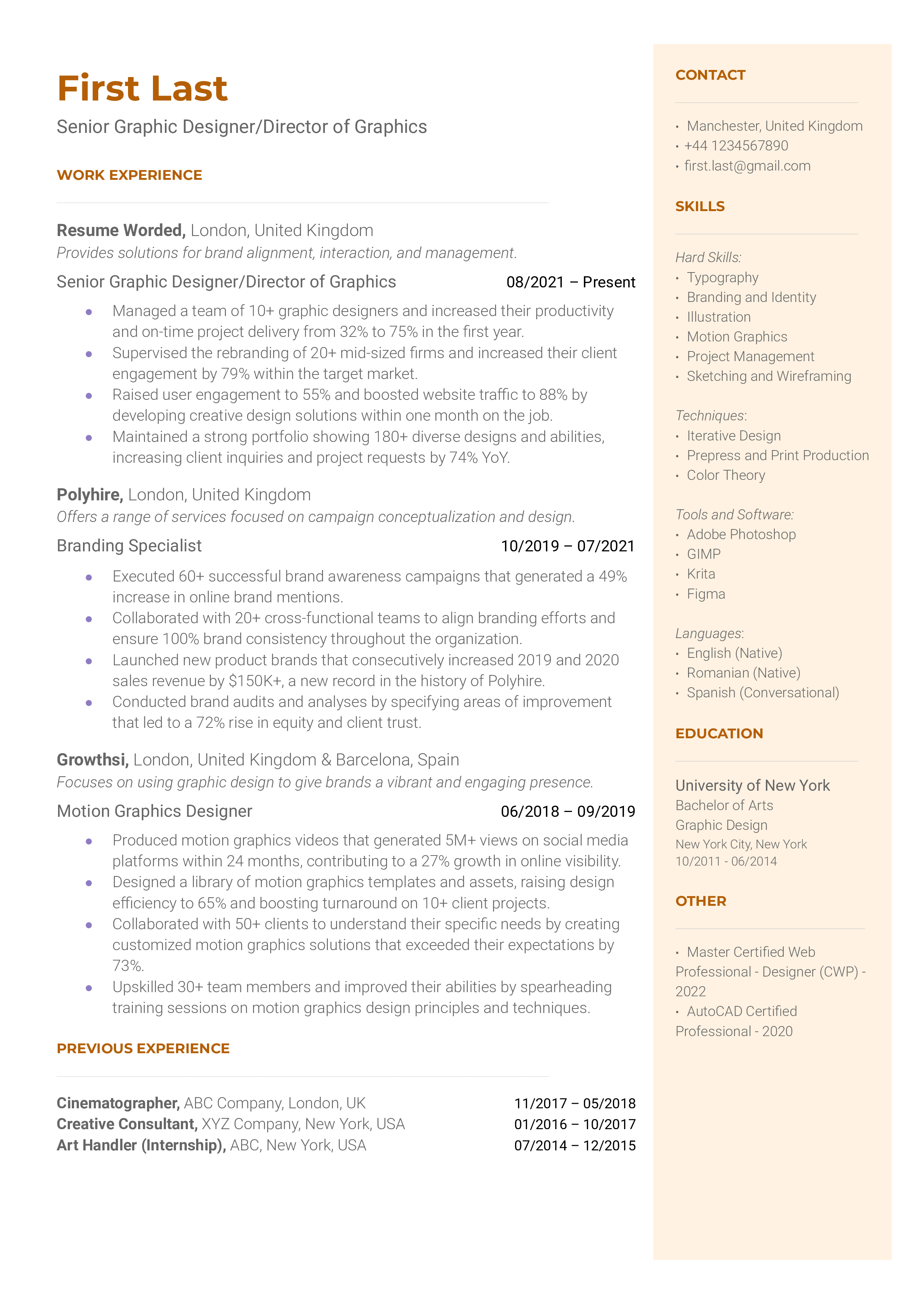
Tips to help you write your Senior Graphic Designer / Director of Graphic Design resume in 2024
highlight leadership experience.
Mention instances where you've led a team or a project. This could involve coordinating with other departments, managing timelines, or mentoring junior designers. A Senior Graphic Designer or Director role often involves more responsibility and managerial tasks, so showing that you've got experience in leadership is key.
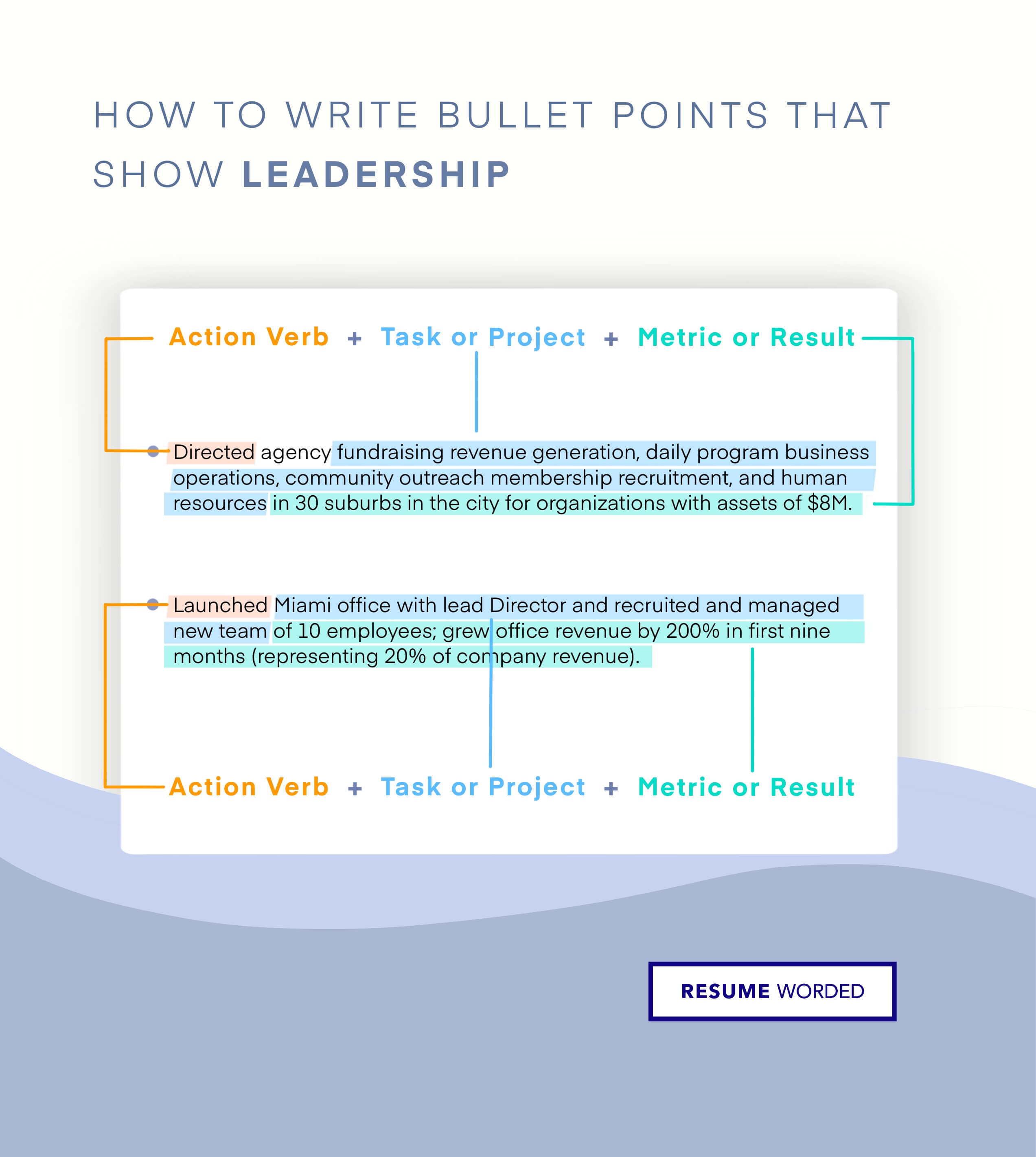
Showcase Data-Driven Design Results
If you were instrumental in a design that led to improved website traffic or conversion rates, include this on your resume. Quantify your results where possible. This adds credibility to your work and shows you understand the link between design and business outcomes.
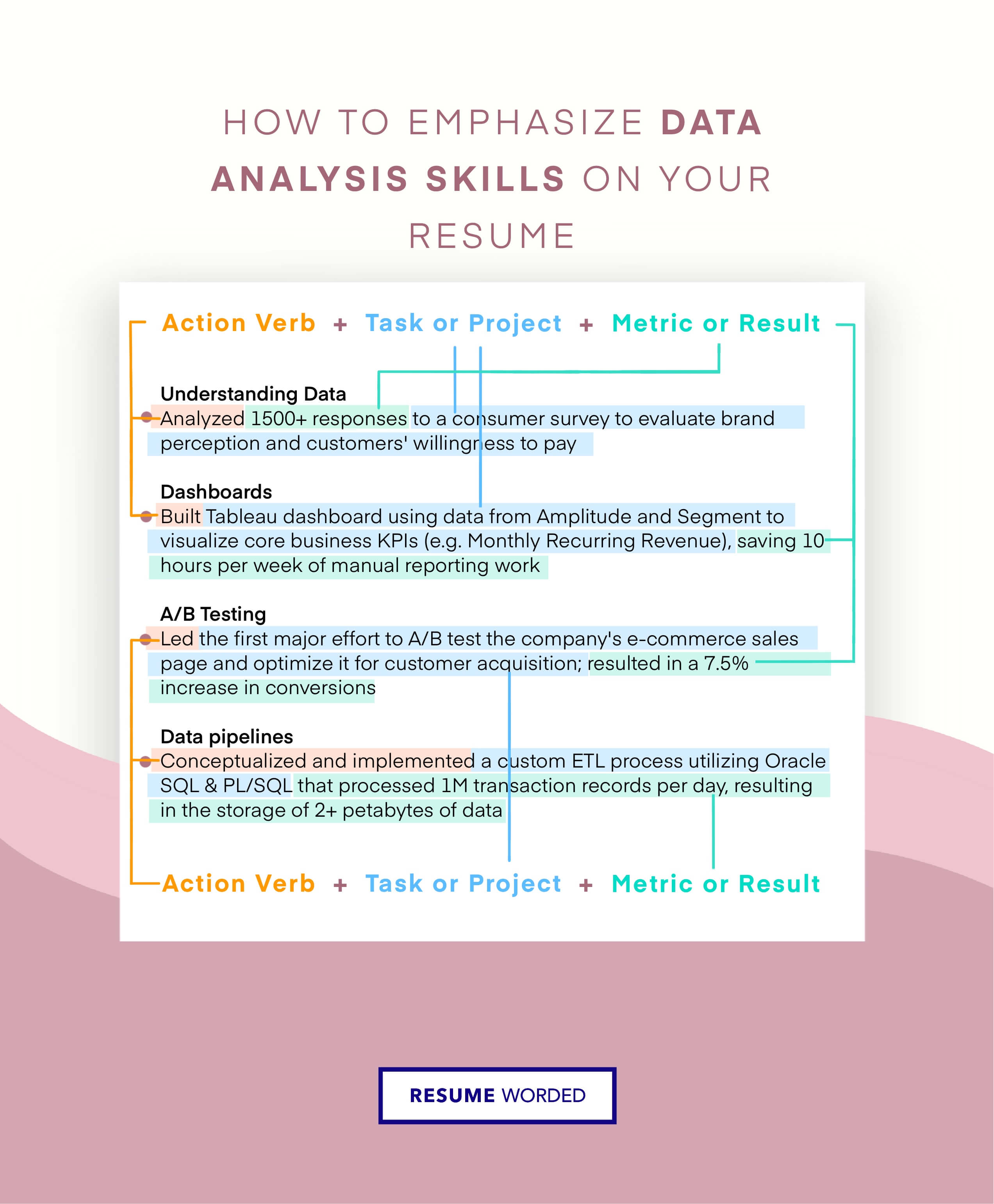
Skills you can include on your Senior Graphic Designer / Director of Graphic Design resume
Template 6 of 14: senior graphic designer / director of graphic design resume example.
As a senior graphic designer or graphic design director, you’ll be taking on high-level responsibilities and overseeing an entire department. Your resume needs to show significant experience as a graphic designer, as well as the capacity to lead a team to success. Make sure you’re emphasizing past leadership roles you’ve held as well as a commitment to ensuring the overall success of a company.
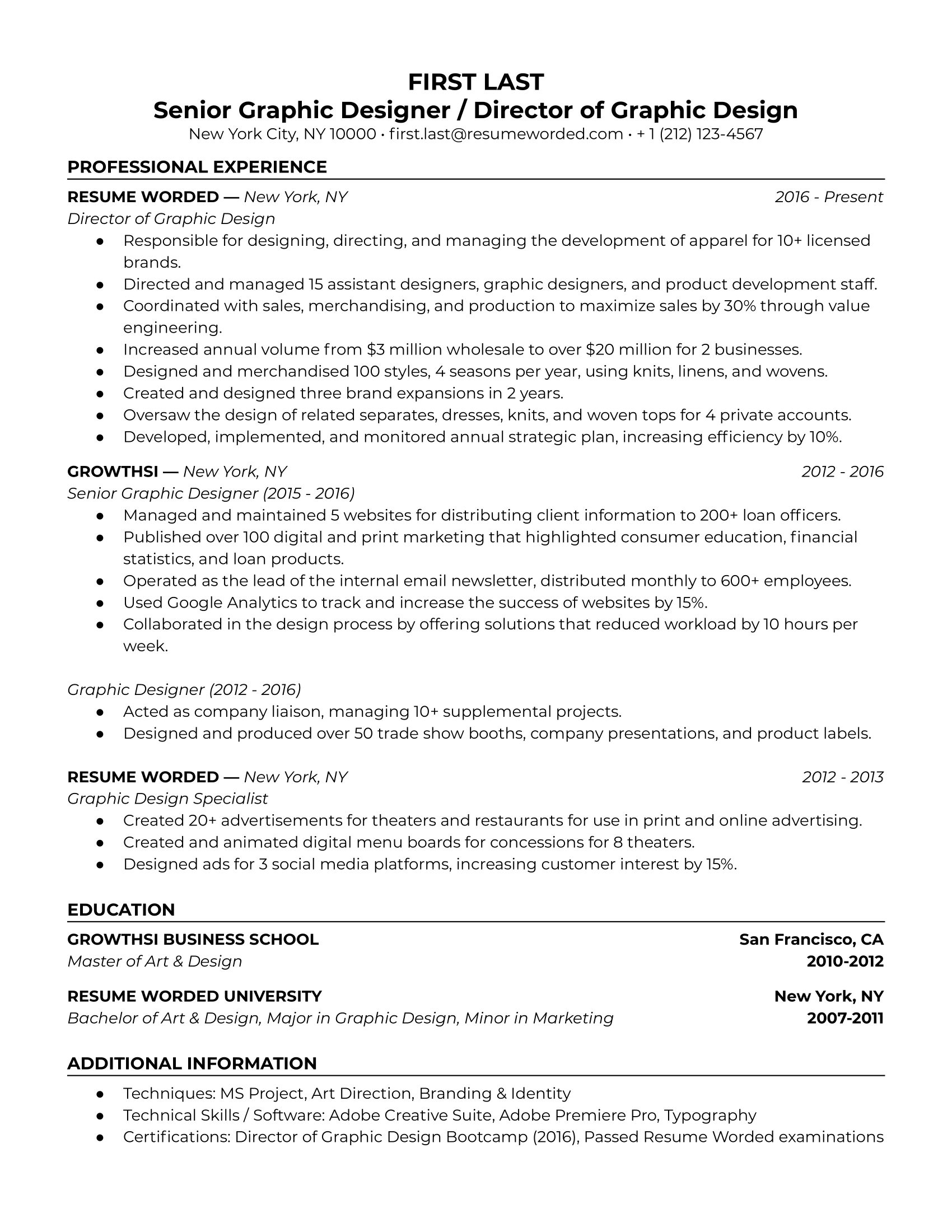
Shows growth in promotions
If you want to land a senior role, you’ll need to show a steady pattern of career growth. If you’ve landed a promotion that represents a significant increase in responsibilities, you can list the positions separately under the same company heading. If the job title alone doesn’t make it clear that this was a promotion, your bullet points will.
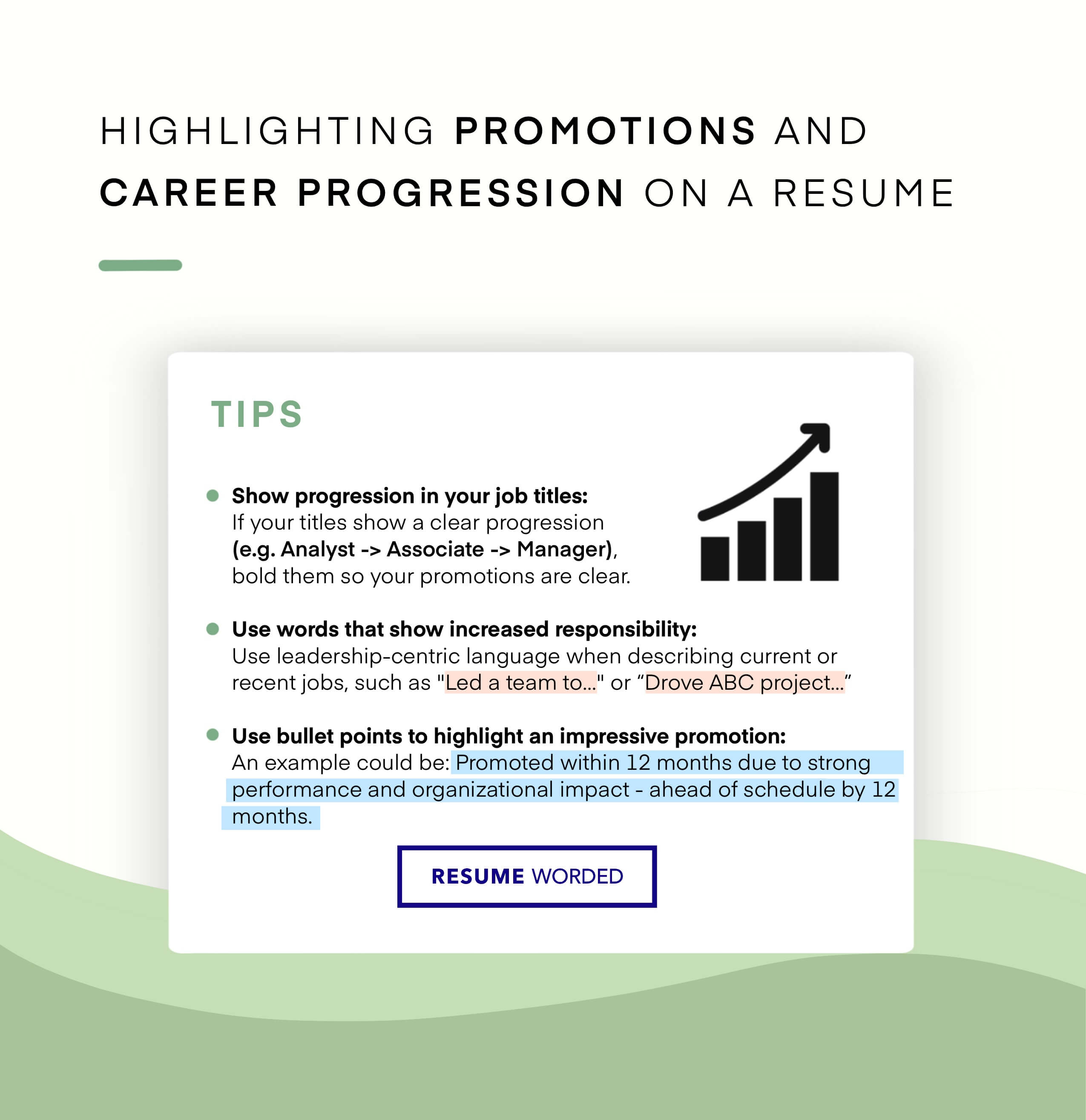
Lists the exact graphic design job title
It’s always a good idea to use the exact title of the job you’re applying for on your resume. If you’ve held a position with the same responsibilities but under a different name, or if the titles are often used interchangeably, you can list both job titles at the start of your resume.
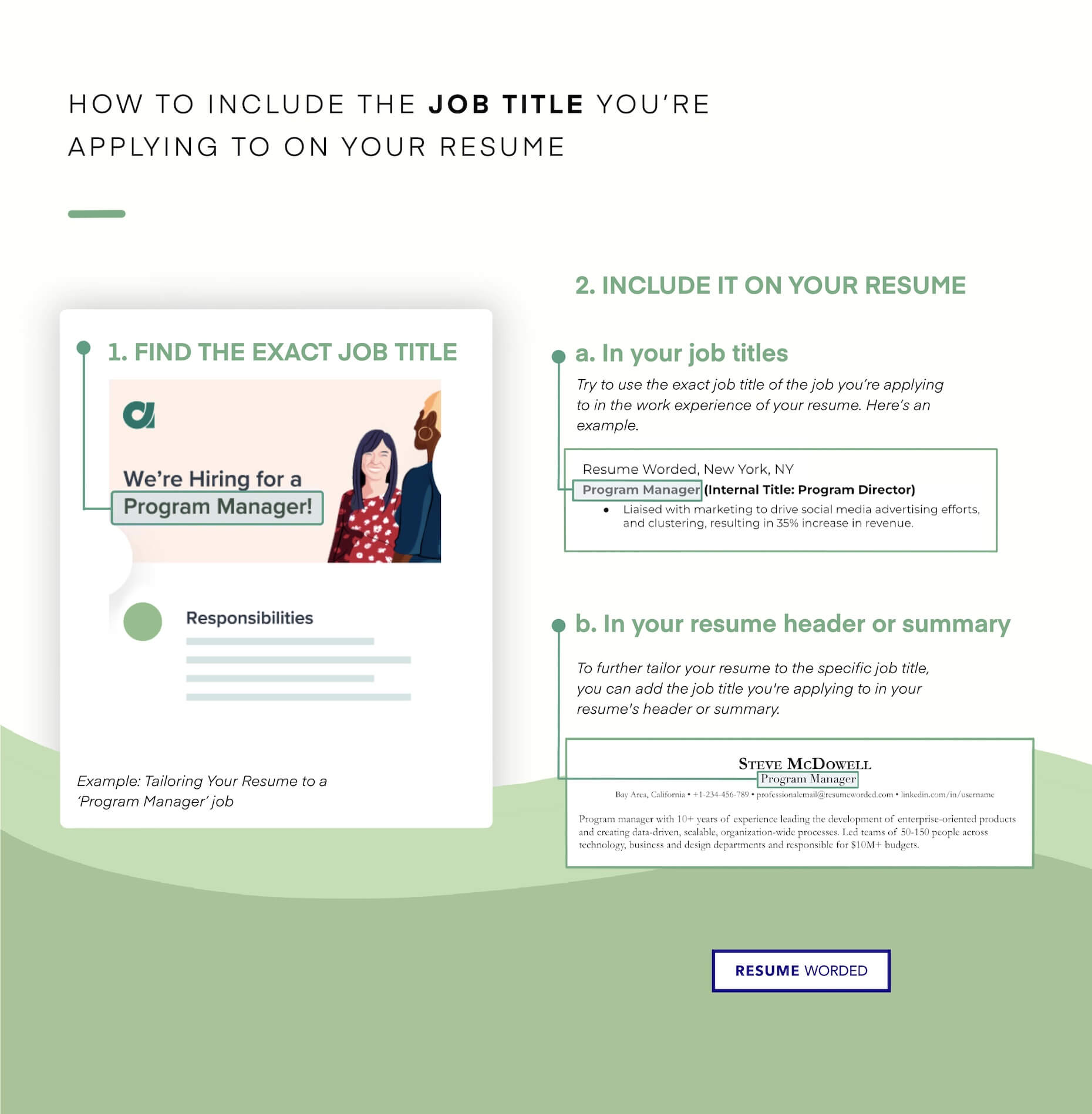
Template 7 of 14: Graphic Design Manager Resume Example
As a Graphic Design Manager, you're a bridge between the creative and strategic sides of a company, bringing visual concepts to life while ensuring they align with the company's goals. In recent years, companies seek individuals who have a strong understanding of digital marketing and UI/UX design, as these components are crucial in the current market. When crafting your resume, it's important to strike a balance between showcasing your artistic capabilities and your managerial skills. Highlight your understanding of branding and digital trends, but also emphasize how well you manage team dynamics and project deadlines.
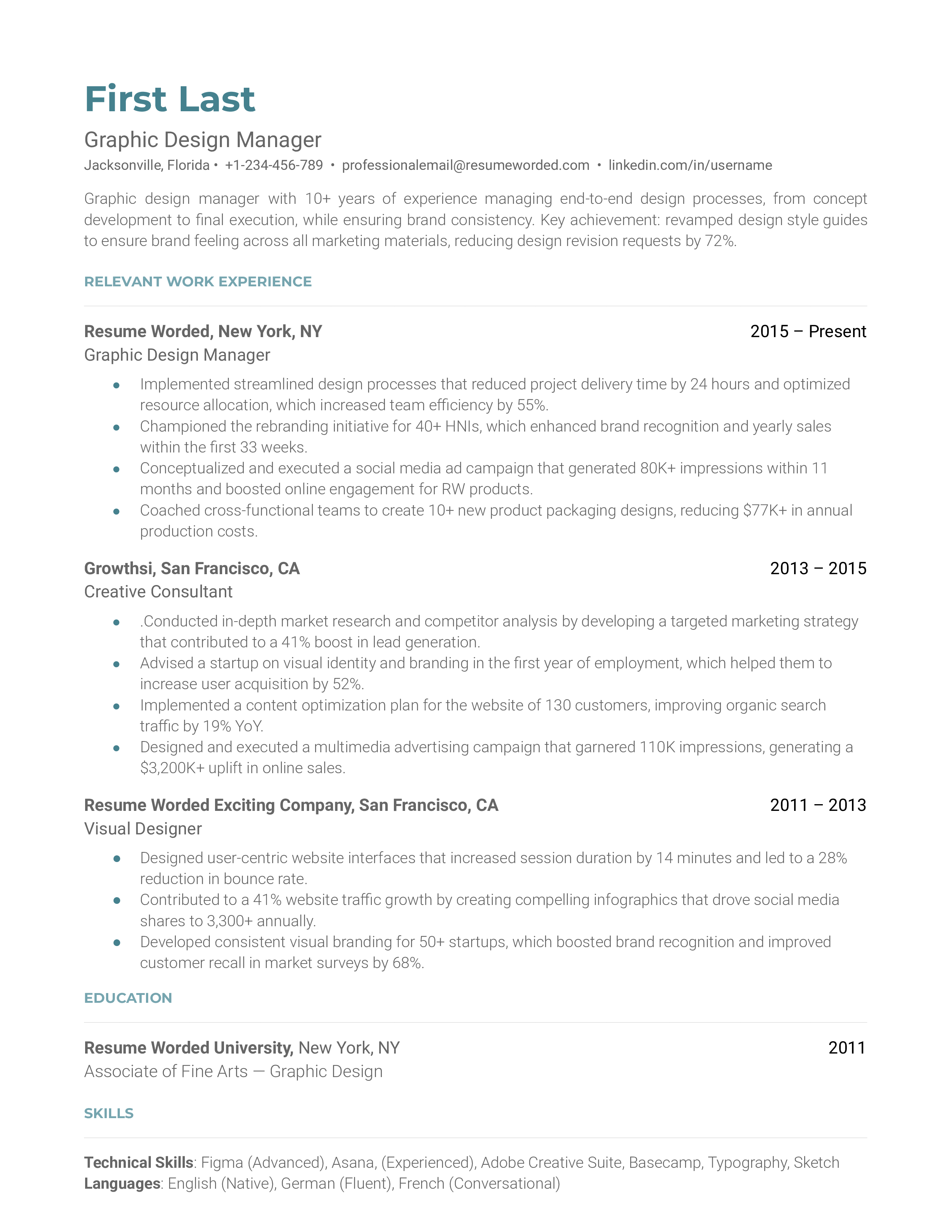
Tips to help you write your Graphic Design Manager resume in 2024
highlight digital design skills.
The industry is increasingly going digital, so make sure your resume reflects your skills in digital design, UX/UI, and even coding. This would be a game-changer for many hiring managers as it showcases your ability to adapt to the digital focus of modern graphic design.
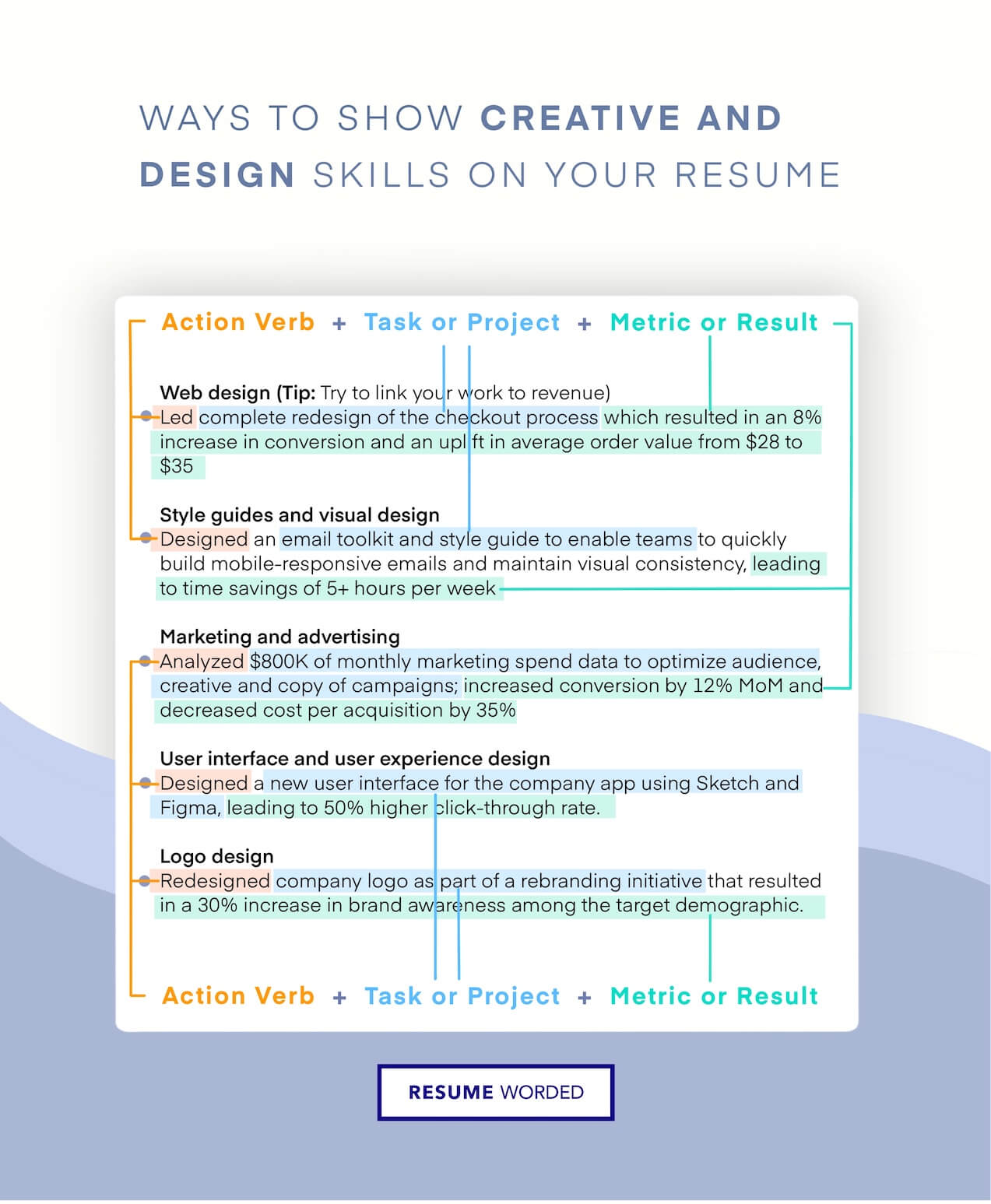
Emphasize team management and leadership
As a manager, you should include instances where you led a team to success, handled challenging projects, or improved team performance. These could be under 'achievements' or 'responsibilities' in your work history section. Show hiring managers that you are not just a good designer, but also a great leader.
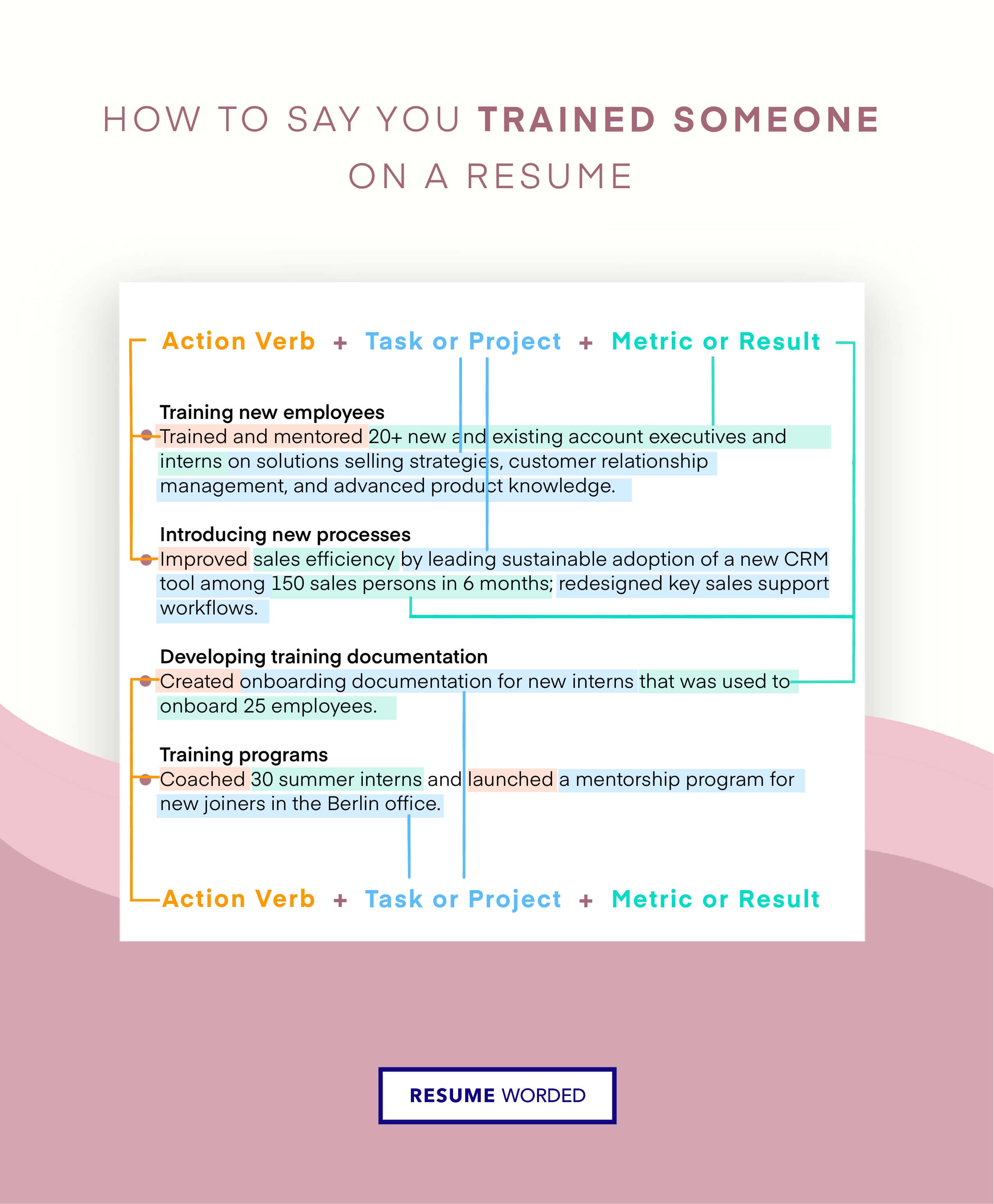
Skills you can include on your Graphic Design Manager resume
Template 8 of 14: graphic design manager resume example.
Graphic design managers have to juggle a lot of different roles. As well as the usual design skills, you’ll need an ability to manage a team, develop strategies, work collaboratively with other departments, and evaluate the performance of other employees. To land the role, make sure your resume reflects soft skills like leadership and conflict management on top of your graphic design experience.
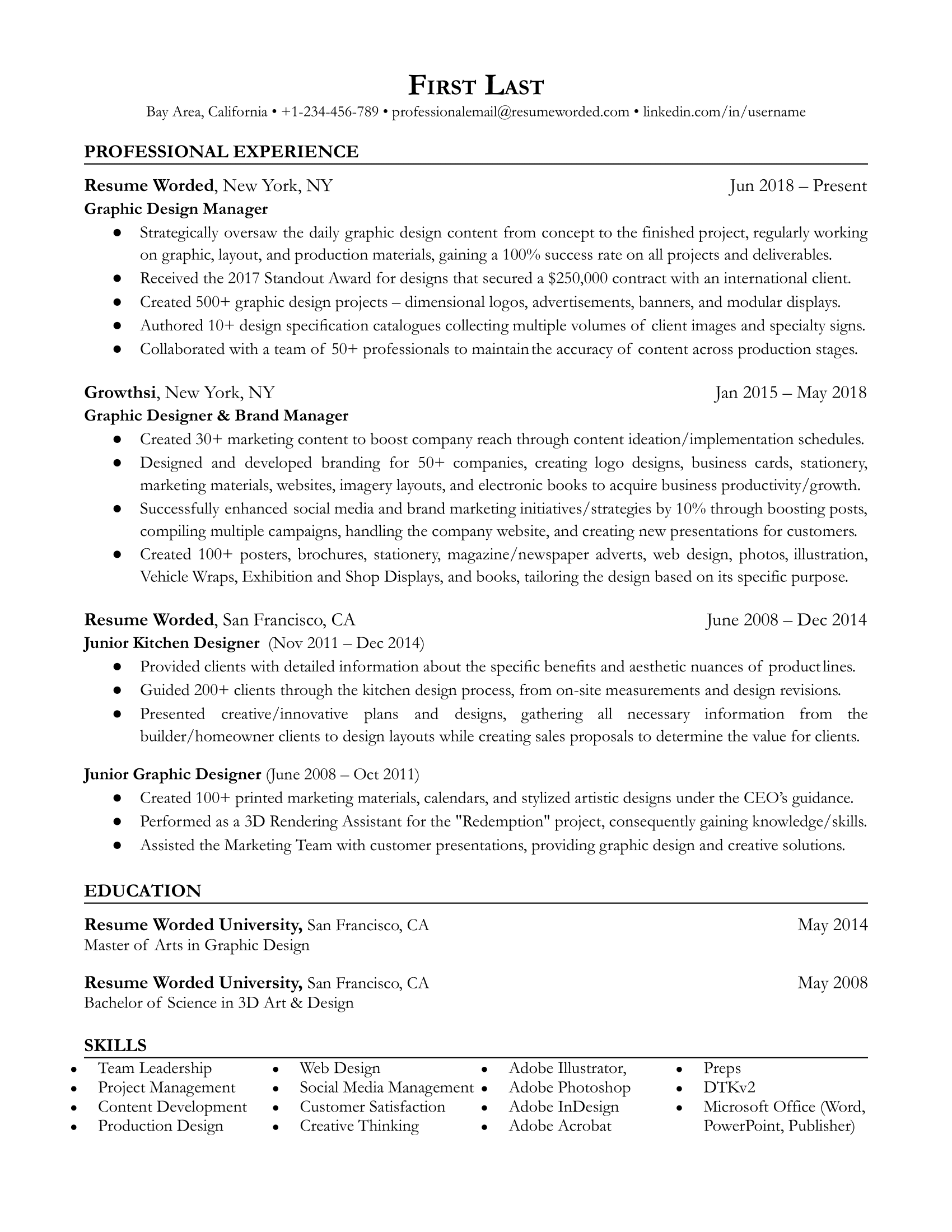
Uses hard numbers and metrics relevant to graphic design achievements
When it comes to listing your achievement in bullet points, the more specific you can be, the better. If you’ve led a team, mention how many people were on it. Explain exactly how many projects you’ve created, what type of graphic design work you’ve done, and the concrete impact that had on your company’s success.
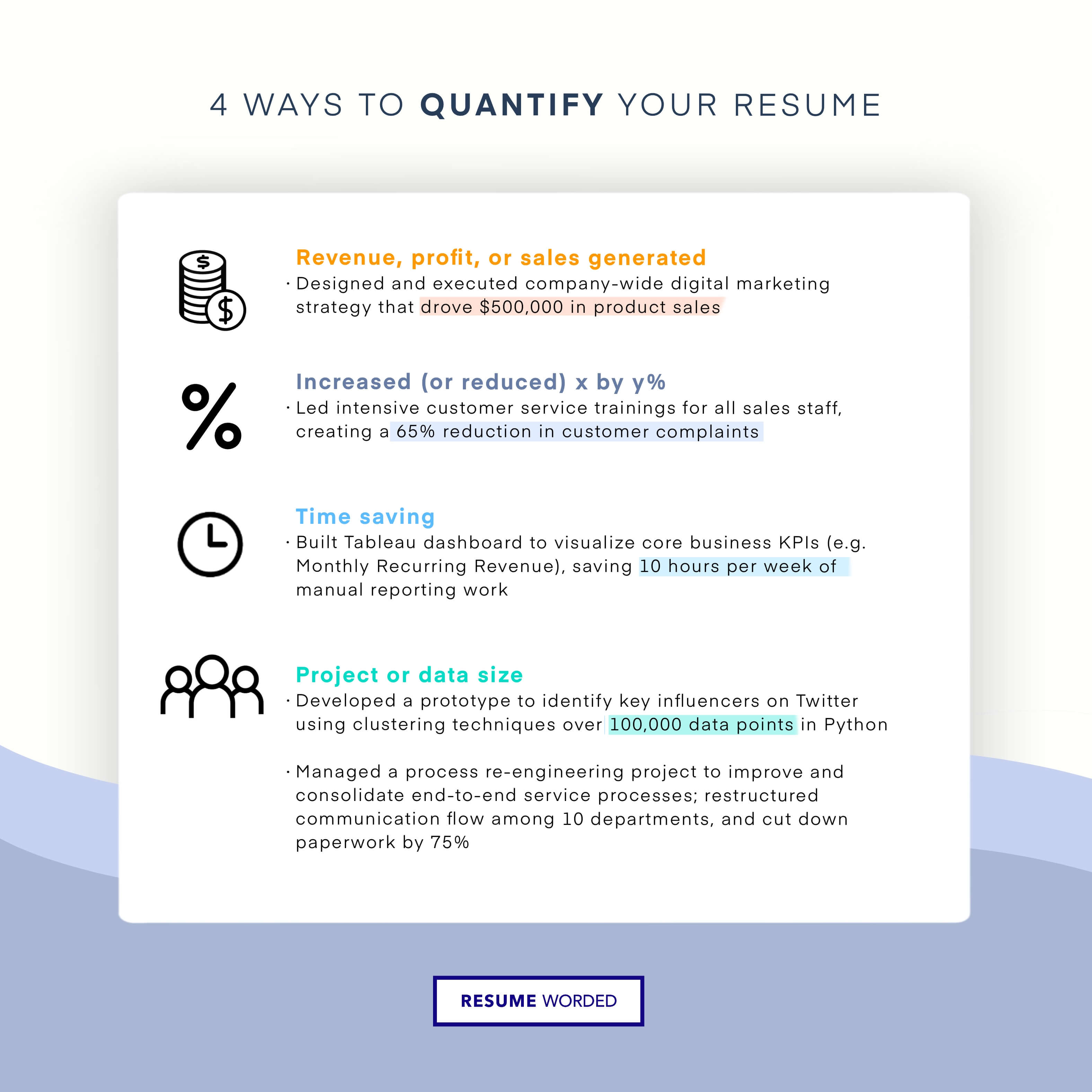
Emphasis on transferable communication and management skills
To lead a team, you’ll need a lot of soft skills as well as hard skills. The best way to emphasize these is through your accomplishments. Mentioning the size of the teams you’ve worked with shows your leadership and teamwork skills, while creating social media strategies, marketing content, or publications is a great way to highlight communication skills.
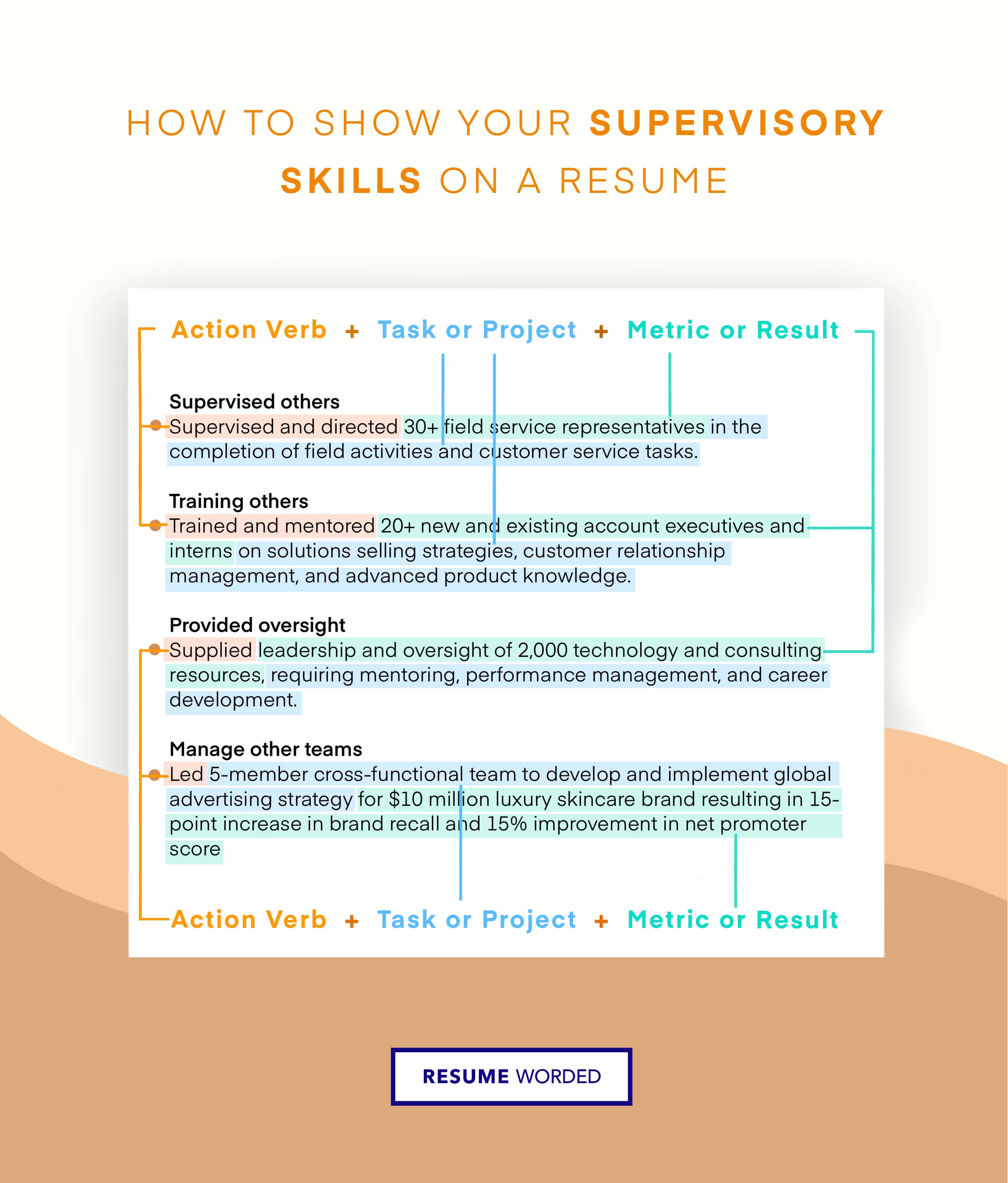
Template 9 of 14: Freelance Graphic Designer Resume Example
A Freelance Graphic Designer's job is a blend of creativity and technical skills, with a dash of entrepreneurial business savvy. You're not only illustrating, designing logos, and manipulating images; you're also managing your business, building client relationships, and working remotely. It's essential to keep your finger on the pulse of the industry, as design trends ebb and flow rapidly. For example, minimalist design is currently all the rage, which means your portfolio should showcase your proficiency in this field. When writing your resume, ensure it reflects the breadth of your skills and experience, as well as your ability to manage your own business.
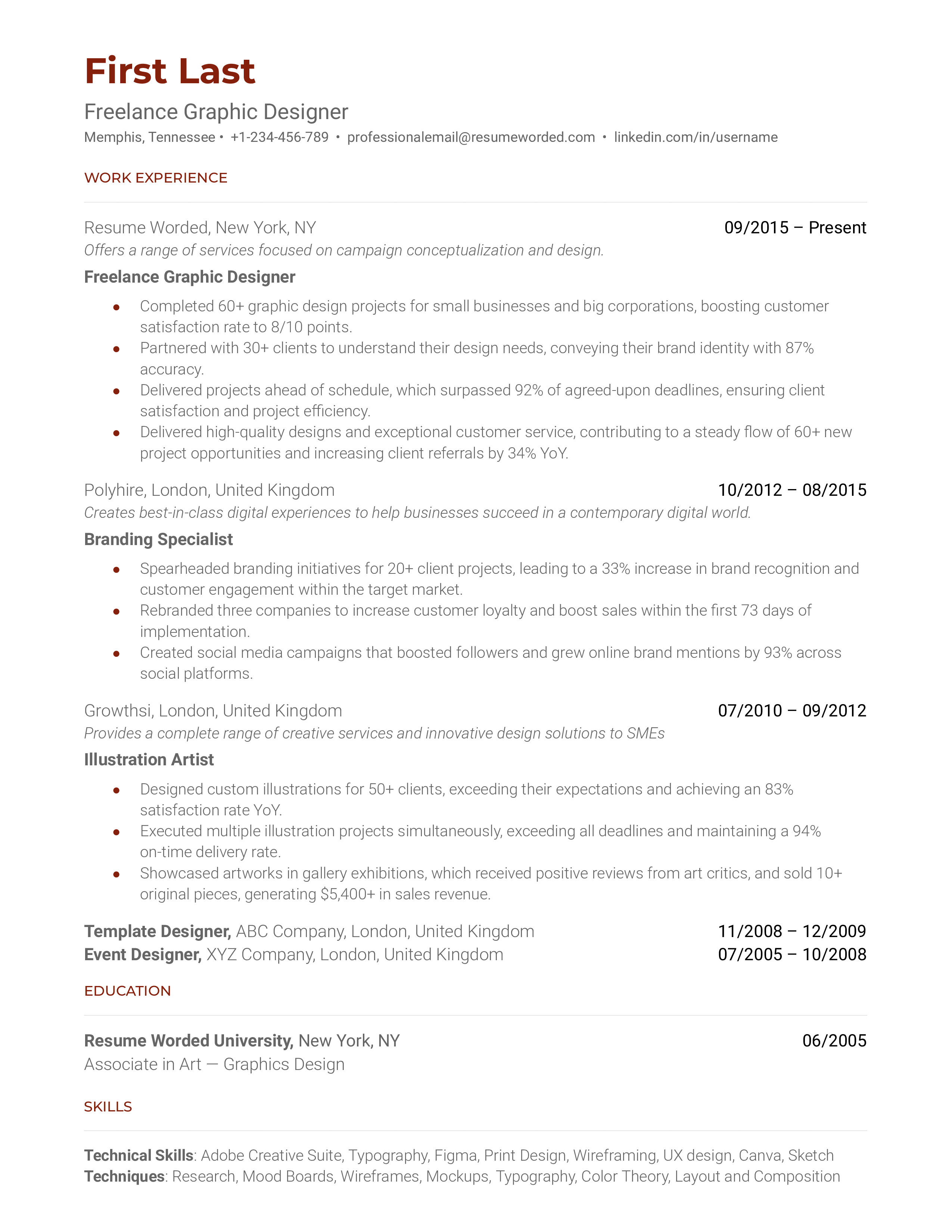
Tips to help you write your Freelance Graphic Designer resume in 2024
highlight relevant software proficiency.
As a Freelance Graphic Designer, your familiarity with software tools is crucial. Therefore, don’t just list them, but give context on how you’ve utilized tools like Adobe Creative Suite and Sketch to create standout designs for various clients.
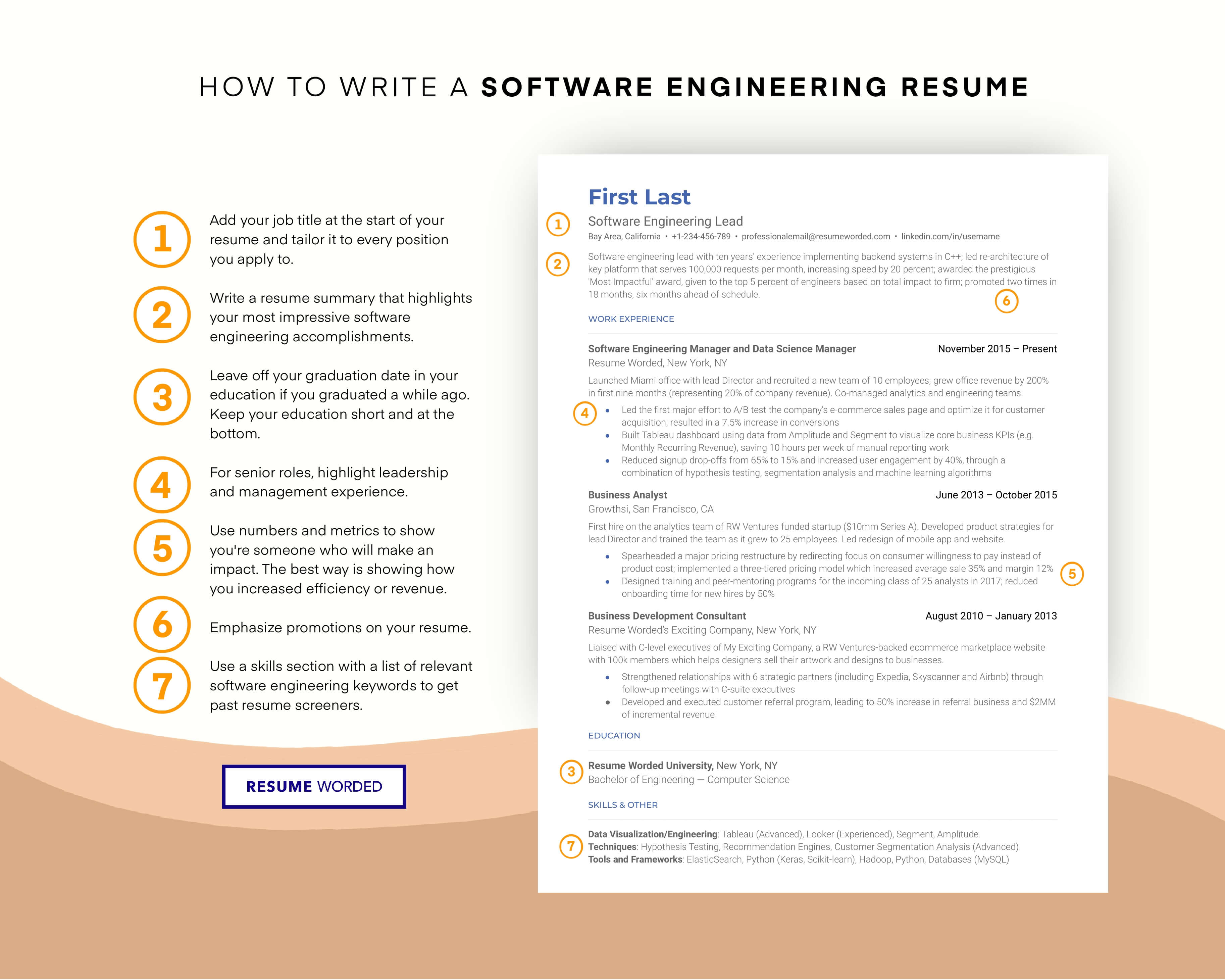
Showcase business skills
You’re not just a designer, but a business owner, too. Highlight any experience you have managing client relationships, scheduling, invoicing, and marketing your services. Any evidence of your entrepreneurial spirit can make you stand out from other designers.
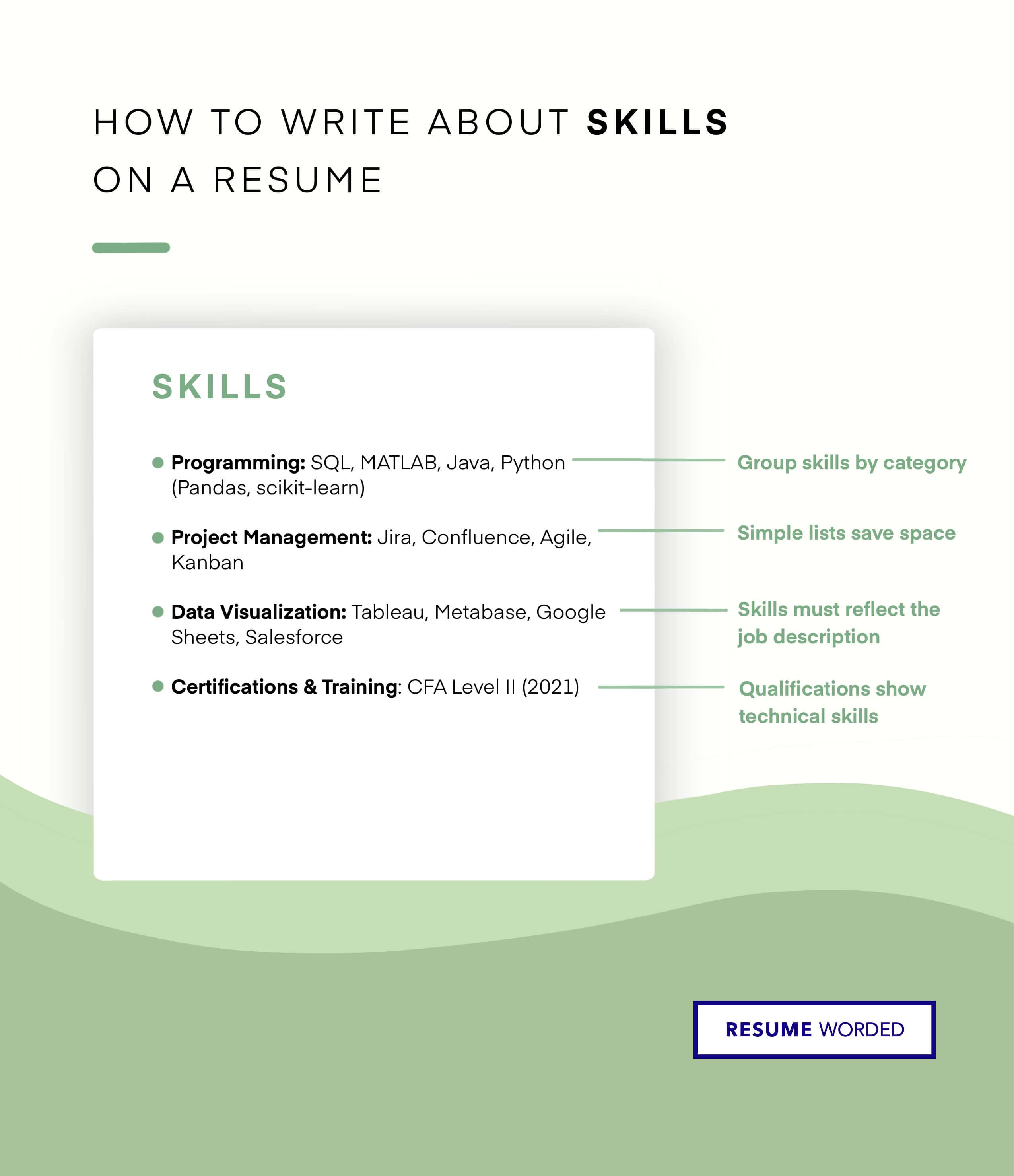
Skills you can include on your Freelance Graphic Designer resume
Template 10 of 14: freelance graphic designer resume example.
Freelance graphic designers work on the same kinds of projects as any other graphic designer, but as self-employed contractors. If you’re looking to pick up more freelance work, or to transition from freelance to regular employment, you’ll need a resume that emphasizes your ability to take initiative, work to a deadline, and understand your clients’ needs.
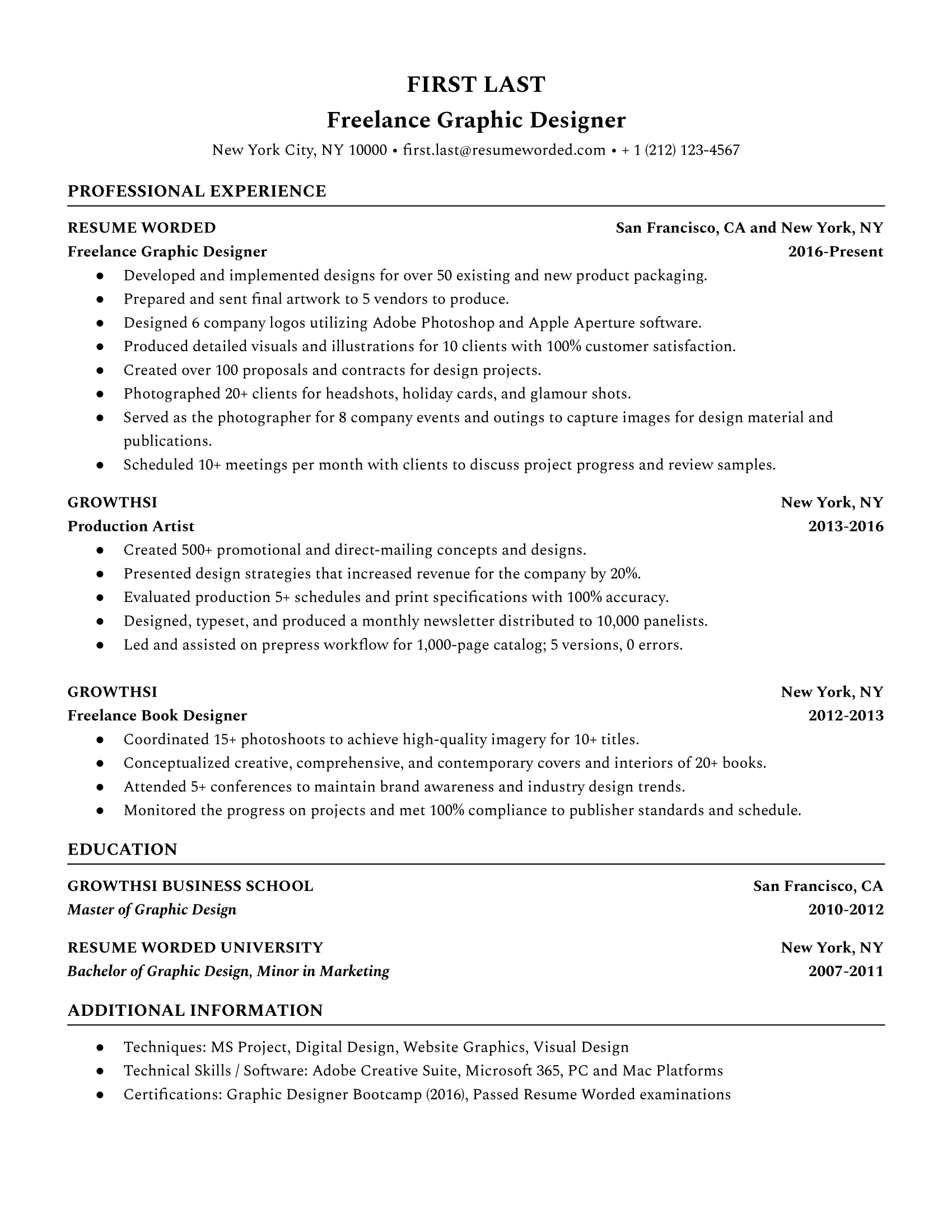
Freelance graphic design projects
If you’ve been freelancing for a while, it might make sense to structure your work experience section according to different projects rather than clients. This lets you highlight your most impressive accomplishments in a way that is easy to follow and is clear about your specific role and achievements.
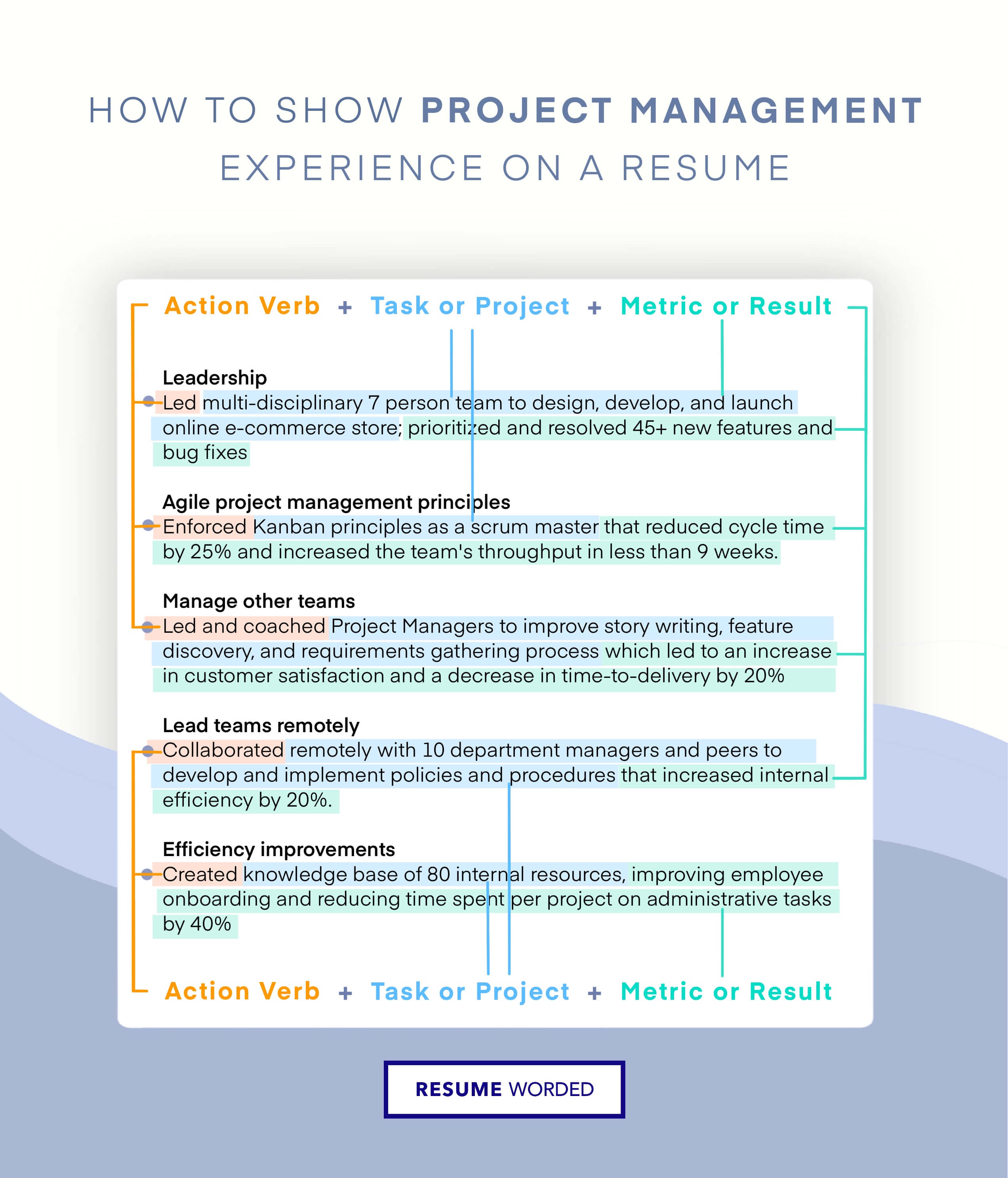
Specific use of metrics
Not all employers fully understand the nature of freelance work, so the more specific you can be about your accomplishments, the better. Listing the number of projects, designs, and proposals you completed makes it clear how you were spending your time and helps emphasize soft skills like time management and work ethic.
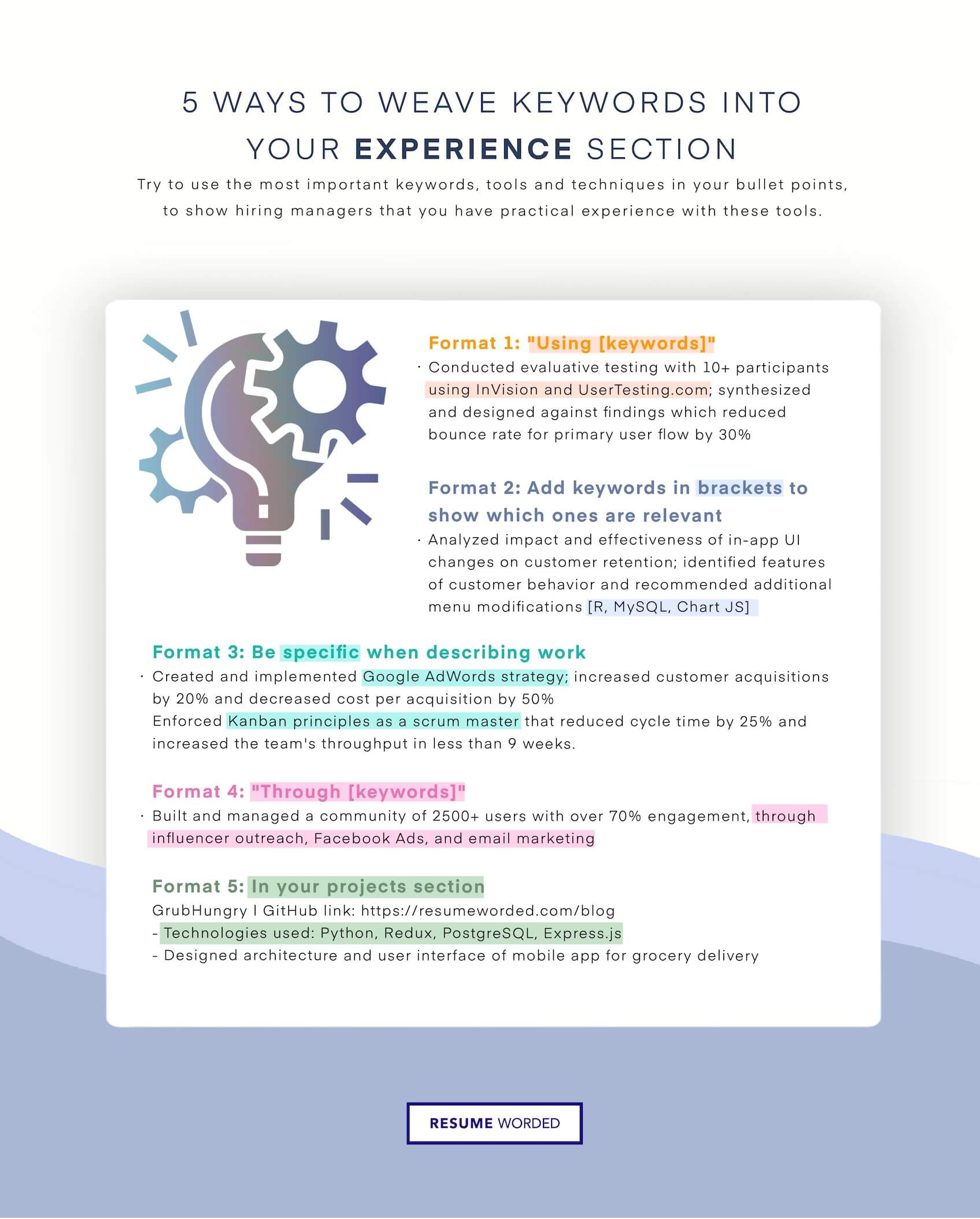
Template 11 of 14: Creative Graphic Designer Resume Example
A creative graphic designer has a strong background in art and visual design. They create visual concepts to communicate a brand’s message to its consumers. They usually work in advertising agencies, marketing companies, or independently as freelance designers. If you want to reflect your expertise in your resume, it’s a good idea to showcase some certifications. These provide a better idea of your abilities and experience in the graphic design industry.
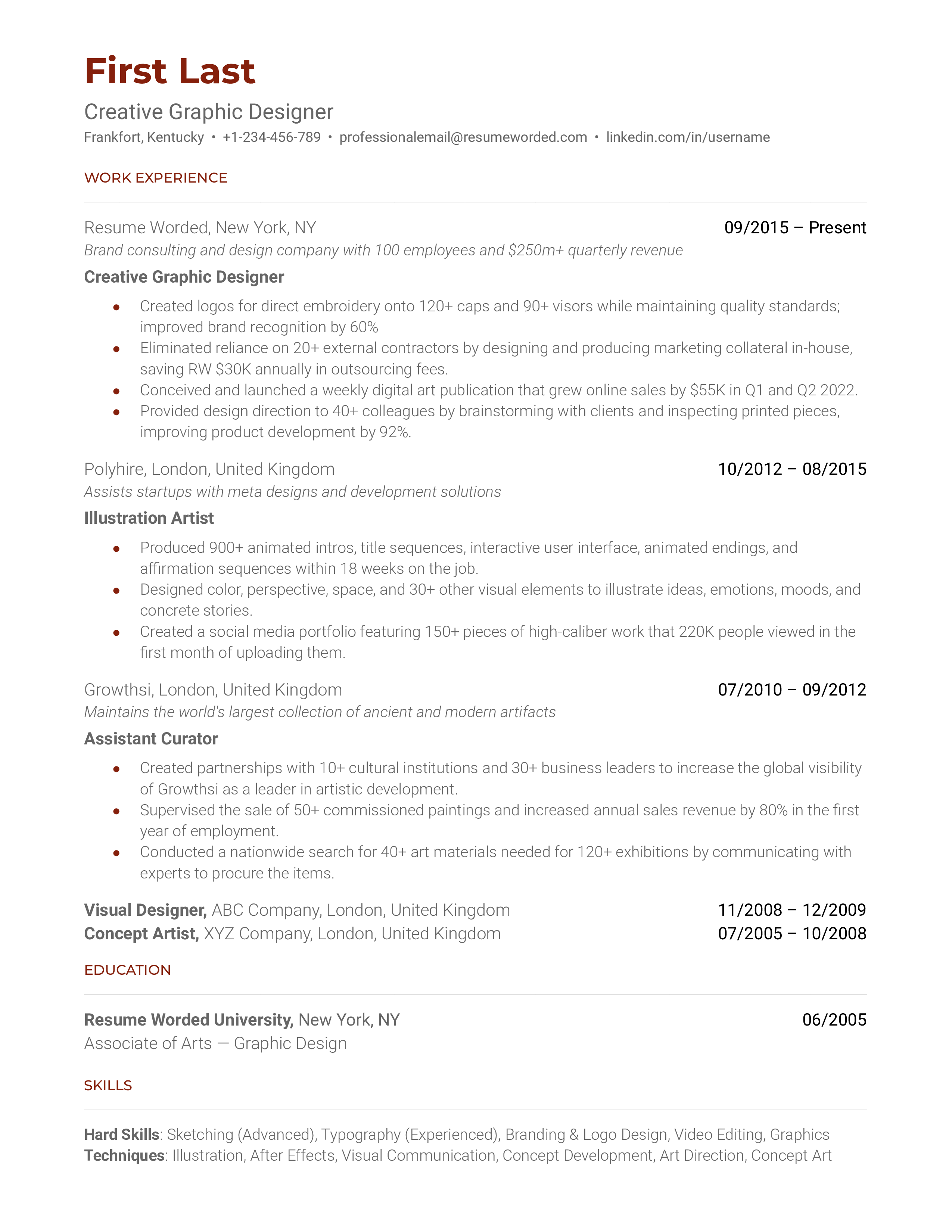
Tips to help you write your Creative Graphic Designer resume in 2024
mention the illustration software you use for graphic design..
Creative graphic designers use multiple tools like Adobe Illustrator, Adobe Photoshop, After Effects, etc. It is a good idea to mention those programs you use for developing your projects in your skills section, or intertwined into your work experiences (e.g. Designed prototypes using Figma...). It’ll give recruiters a practical view of what your tool stack looks like and if it aligns with that of their product/graphic design teams.
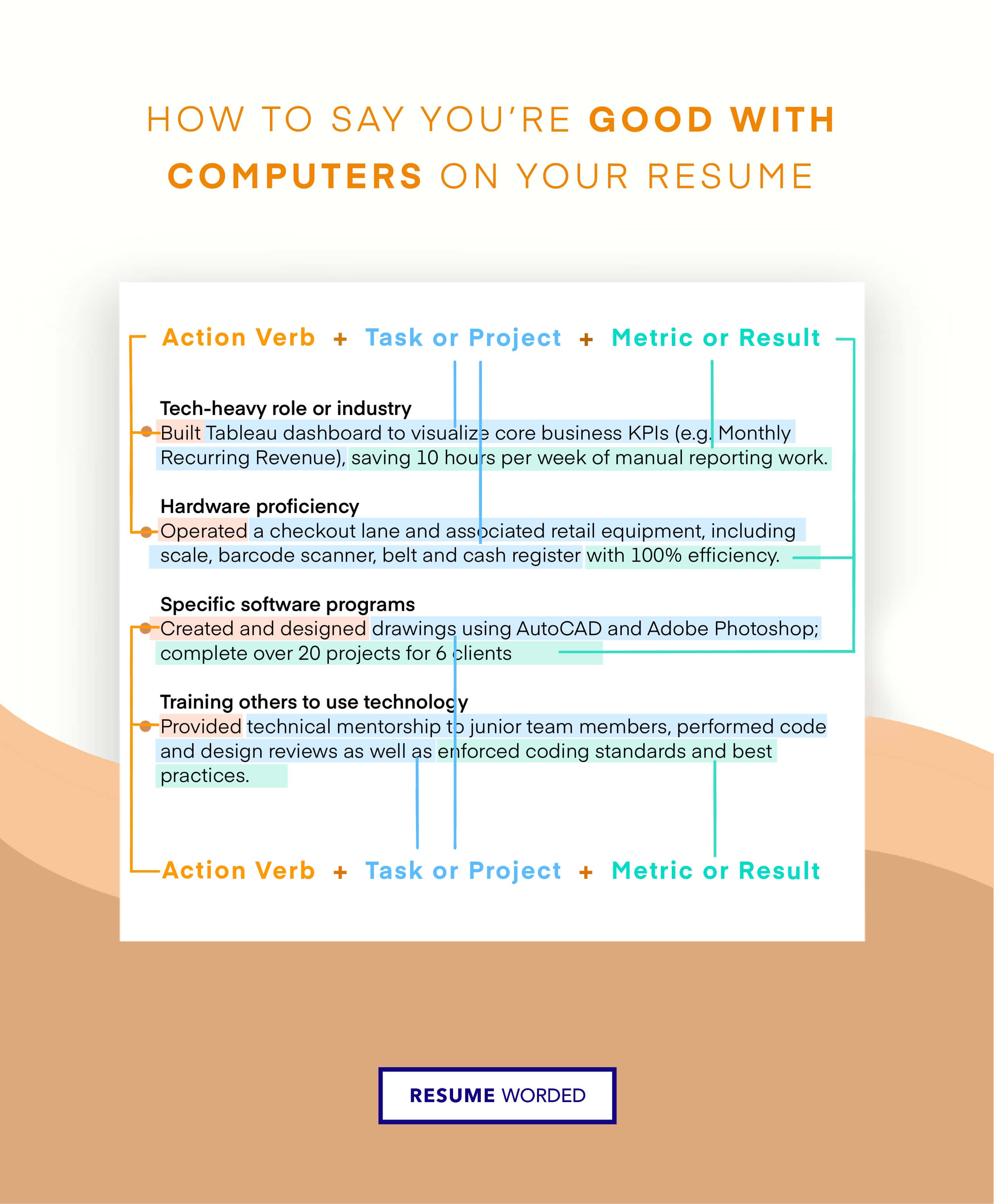
Talk about products or experiences you've prototyped.
Prototyping is an experimental process in which graphic designers propose a design idea to evaluate how end users would react to the final result. It is essentially a 'testing' phase, which helps reduce a company's risk of spending several weeks developing something that isn't usable or doesn't achieve the company's goals. Creative graphic designers should put experimentation at the heart of their work, and it's often useful to emphasize it in your resume. You could use the action verb, "Prototyped", in an example like "Prototyped 25+ designs by rapidly iterating with the client over 8 weeks...".
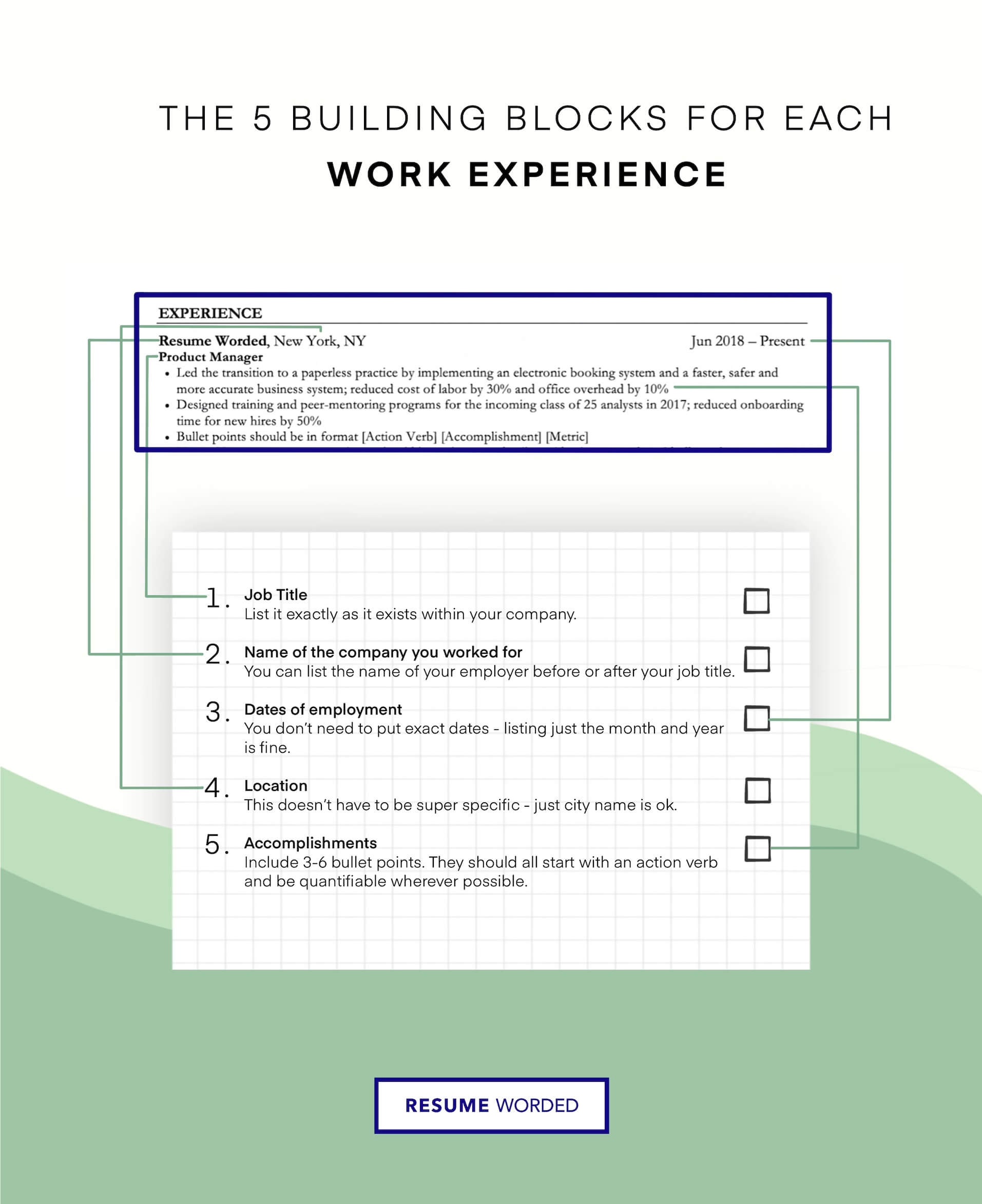
Skills you can include on your Creative Graphic Designer resume
Template 12 of 14: creative graphic designer resume example.
The role of a creative designer can be broader than just graphic design. Creative designers need an excellent understanding of branding, marketing, and social media as well as proficiency with graphic design software. To land a role as a creative graphic designer, make sure your resume highlights your understanding of brand awareness and experience guiding products through the entire creative process.
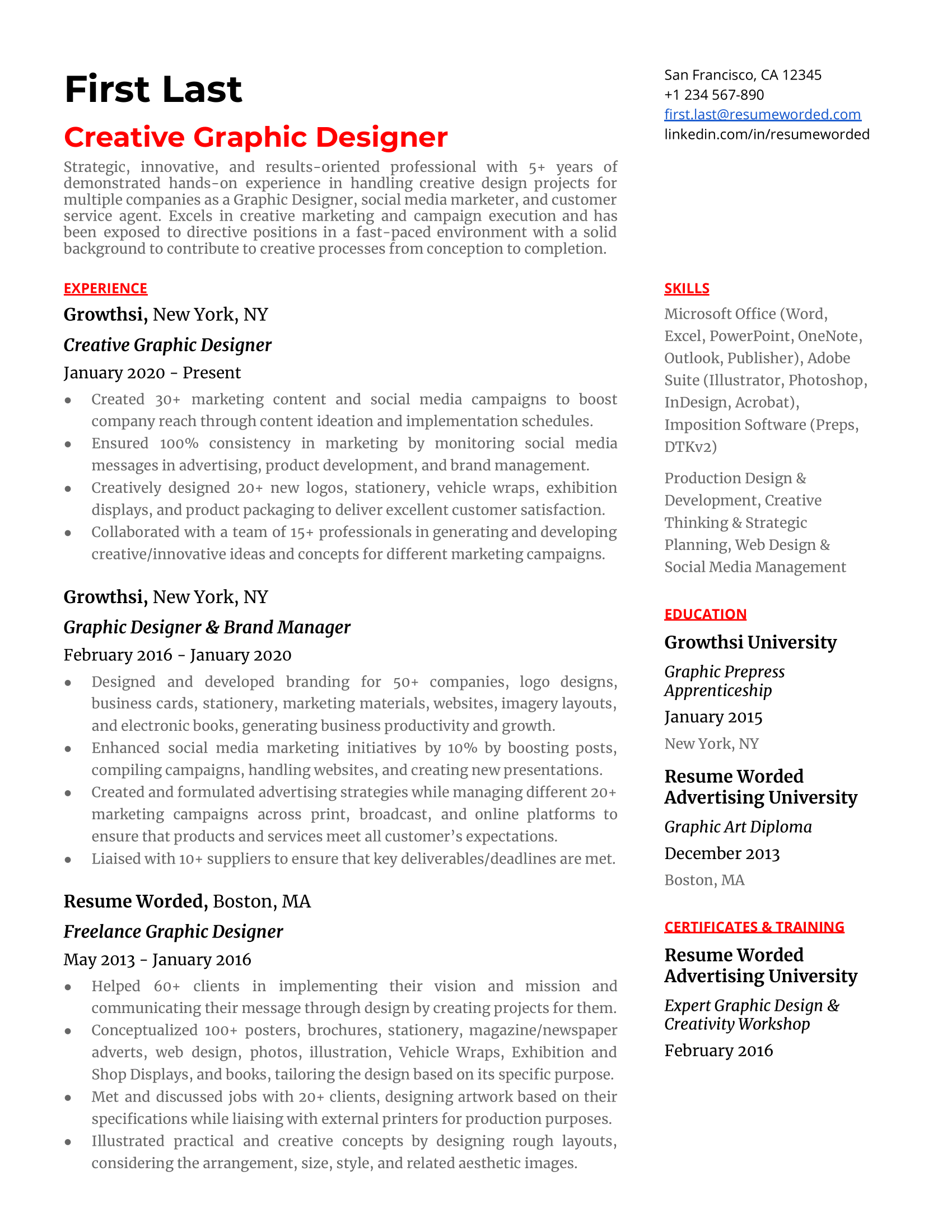
Tailored to the creative design job
Tailoring your resume to the exact job you’re applying for doesn’t have to take a lot of time or effort. Including job-specific keywords in your resume title and skills section are two of the easiest ways to target your resume. Make sure you’re including keywords like product design, social media marketing, and specific graphic design programs that ATS are likely to scan for.
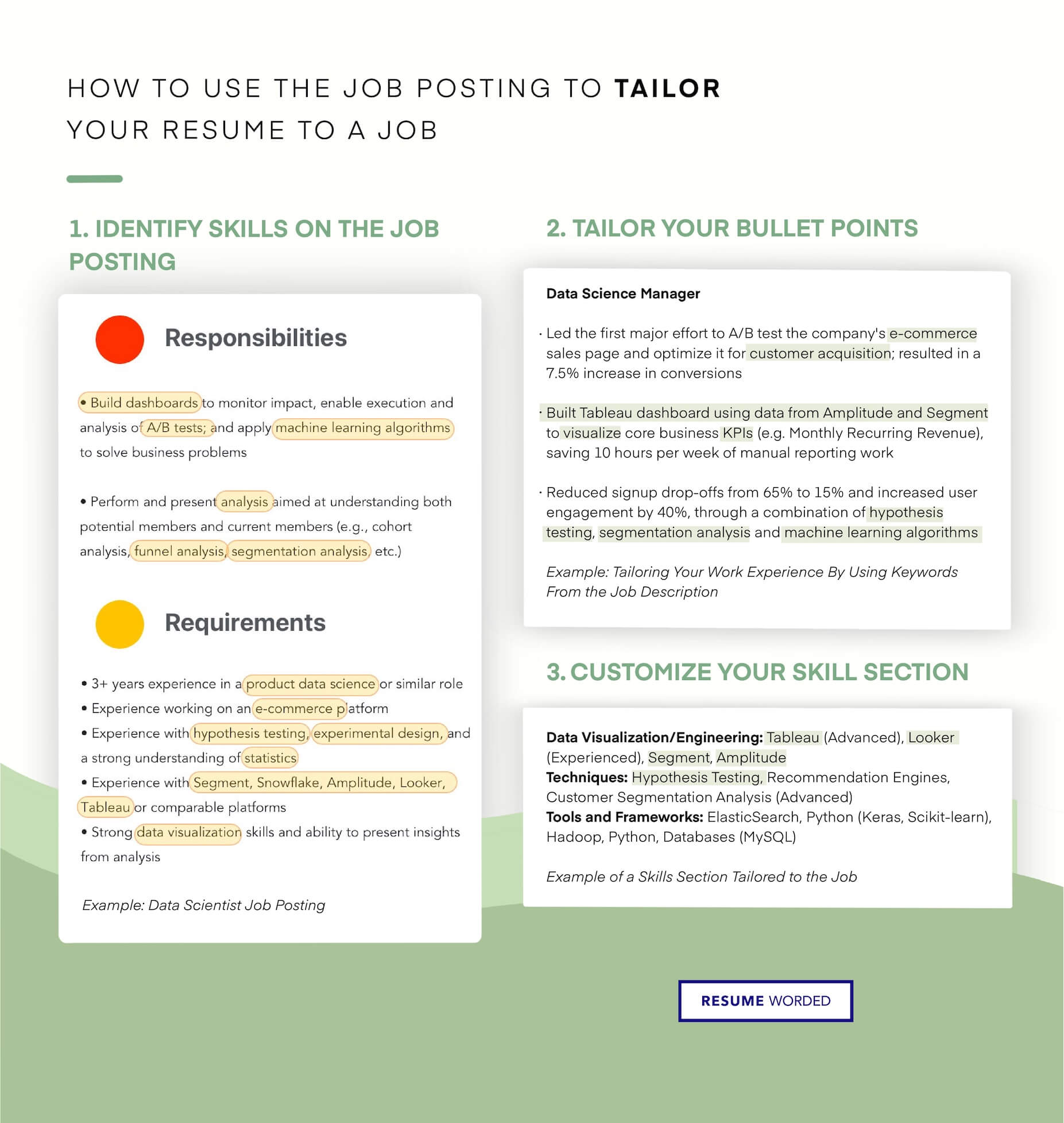
Strong resume summary to tell hiring managers about graphic design focus
Including a resume summary is a great way of tailoring your resume and providing additional information about your background and accomplishments. They’re especially useful for career changers or people without a lot of experience in graphic design, but can be used to great effect to highlight your particular strengths and contextualize the achievements in your bullet points.
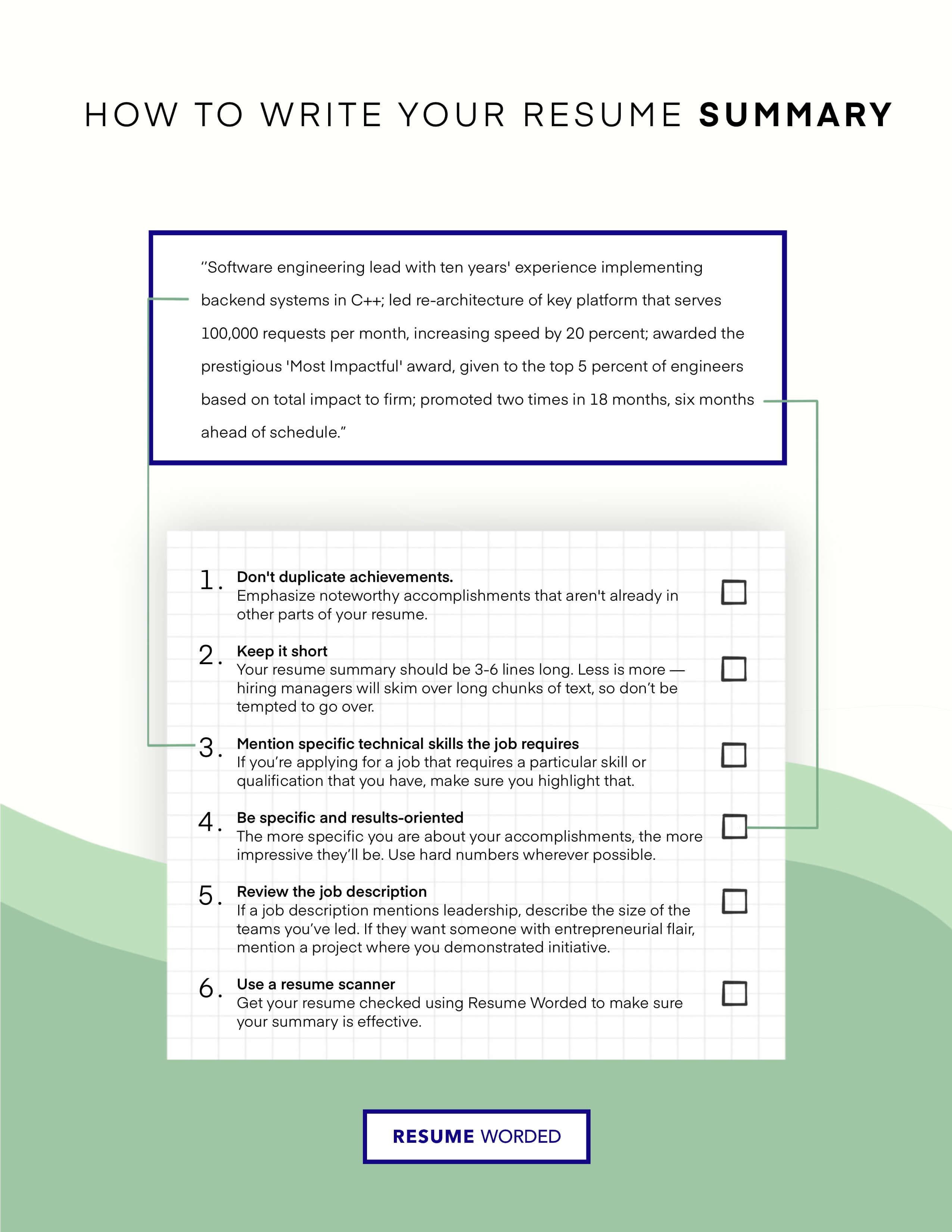
Template 13 of 14: Minimalist Graphic Designer Resume Example
As the name suggests, minimalist design uses only the most basic elements. These designers use limited color palettes and basic shapes to create stunning designs. Recruiters will be looking to see a bachelor’s degree in graphic design or other equally rigorous qualifications. Beyond that, previous experience and your skill set will be of great importance. Take a look at this successful resume sample.
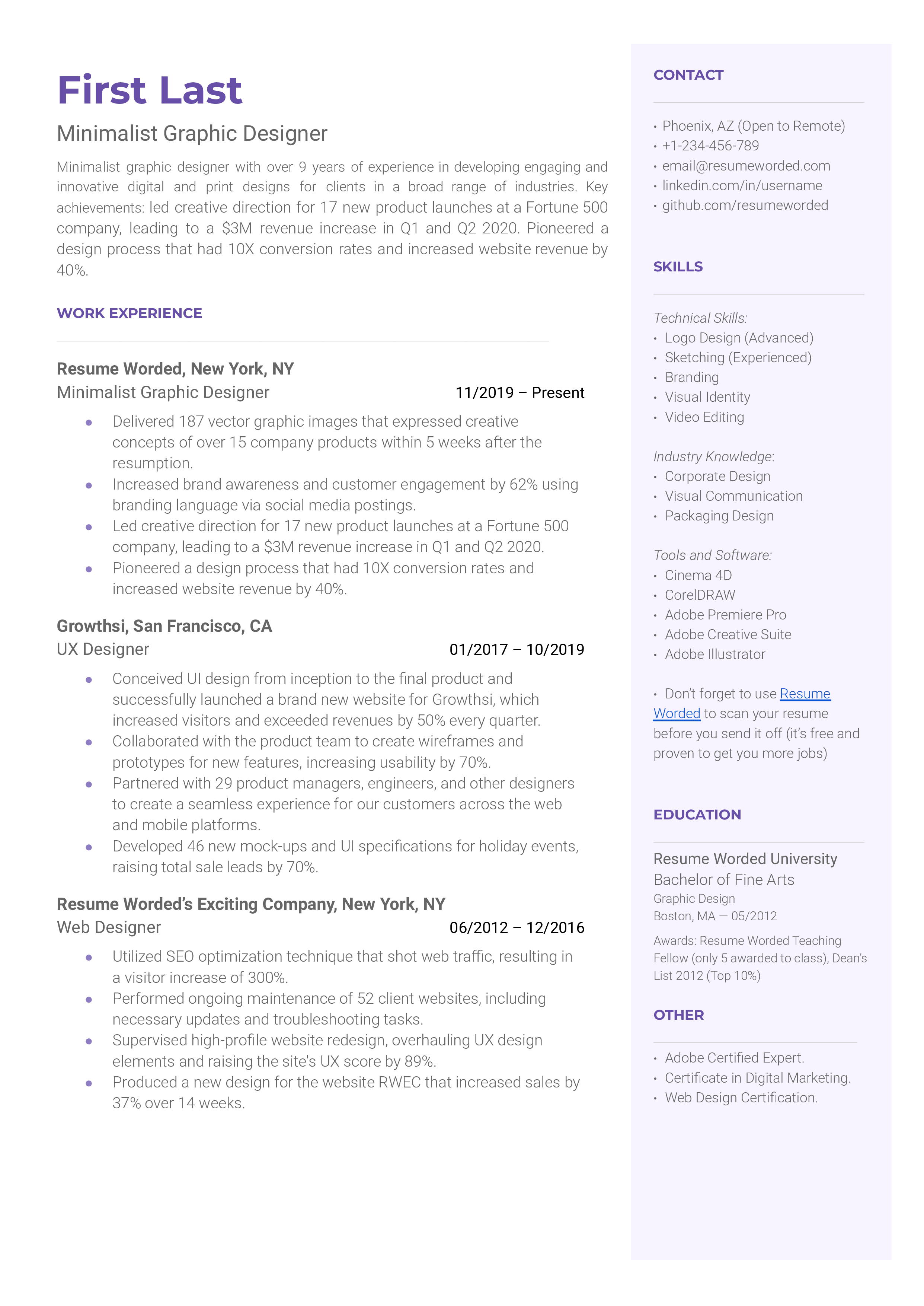
Tips to help you write your Minimalist Graphic Designer resume in 2024
have a minimalist portfolio..
For any graphic designer, you need to attach your portfolio to your resume when applying for a job. Recruiters need to see your designs. For this position compile your most successful and impactful minimalist designs into a portfolio.
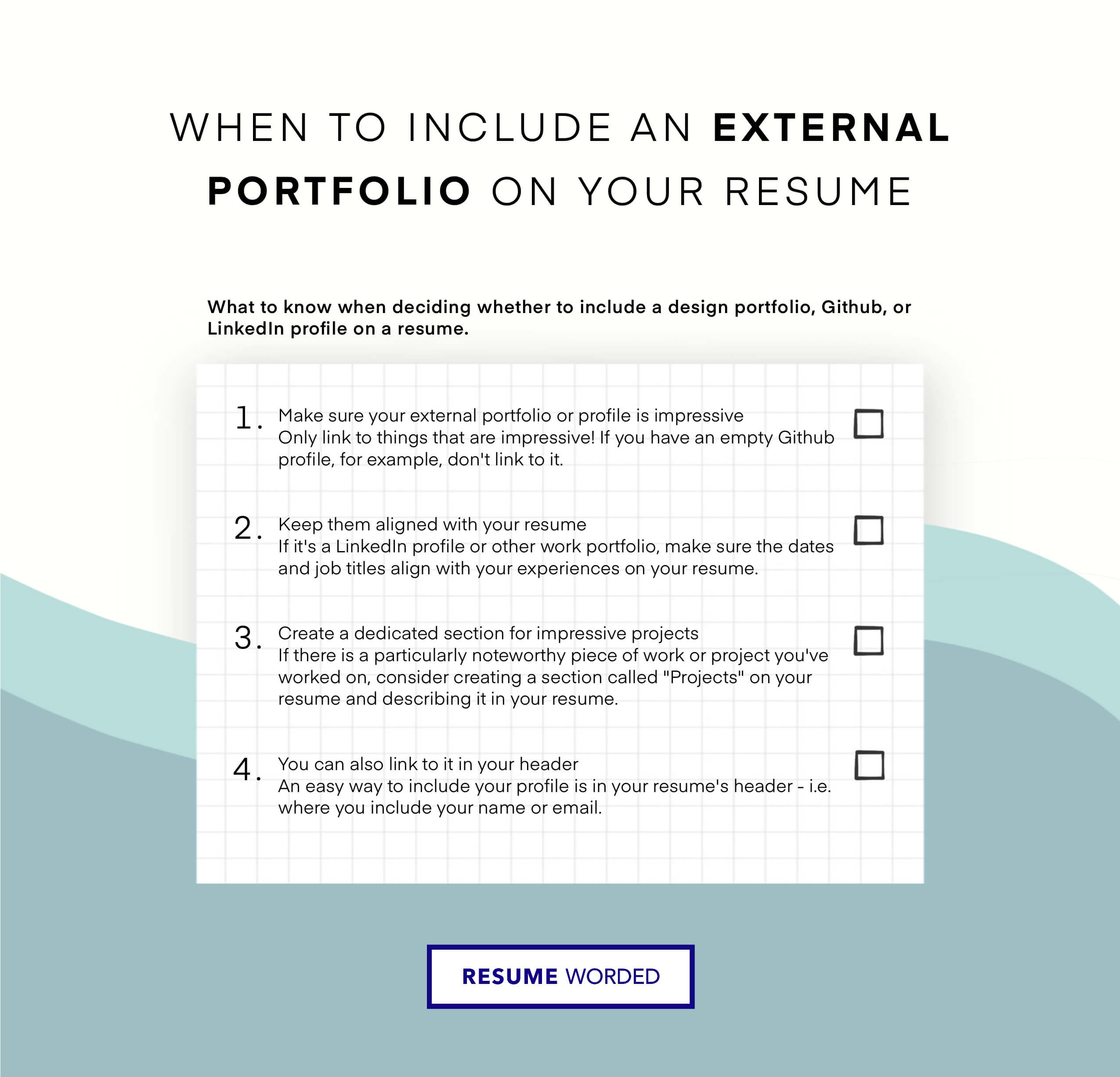
Create a minimalist-looking resume.
Let recruiters see your style and abilities by the look of your resume before they even read it. Show your minimalist skills by designing a resume with a minimalist aesthetic.
Skills you can include on your Minimalist Graphic Designer resume
Template 14 of 14: motion graphic designer resume example.
From animations to credit sequences, moving logos, and websites, motion graphic designers create designs that can move. These designers work largely in industries like film, TV, advertising, and many other industries. Your qualifications and your tools lists will be of great importance for this position. Here is a recruiter-approved resume sample.
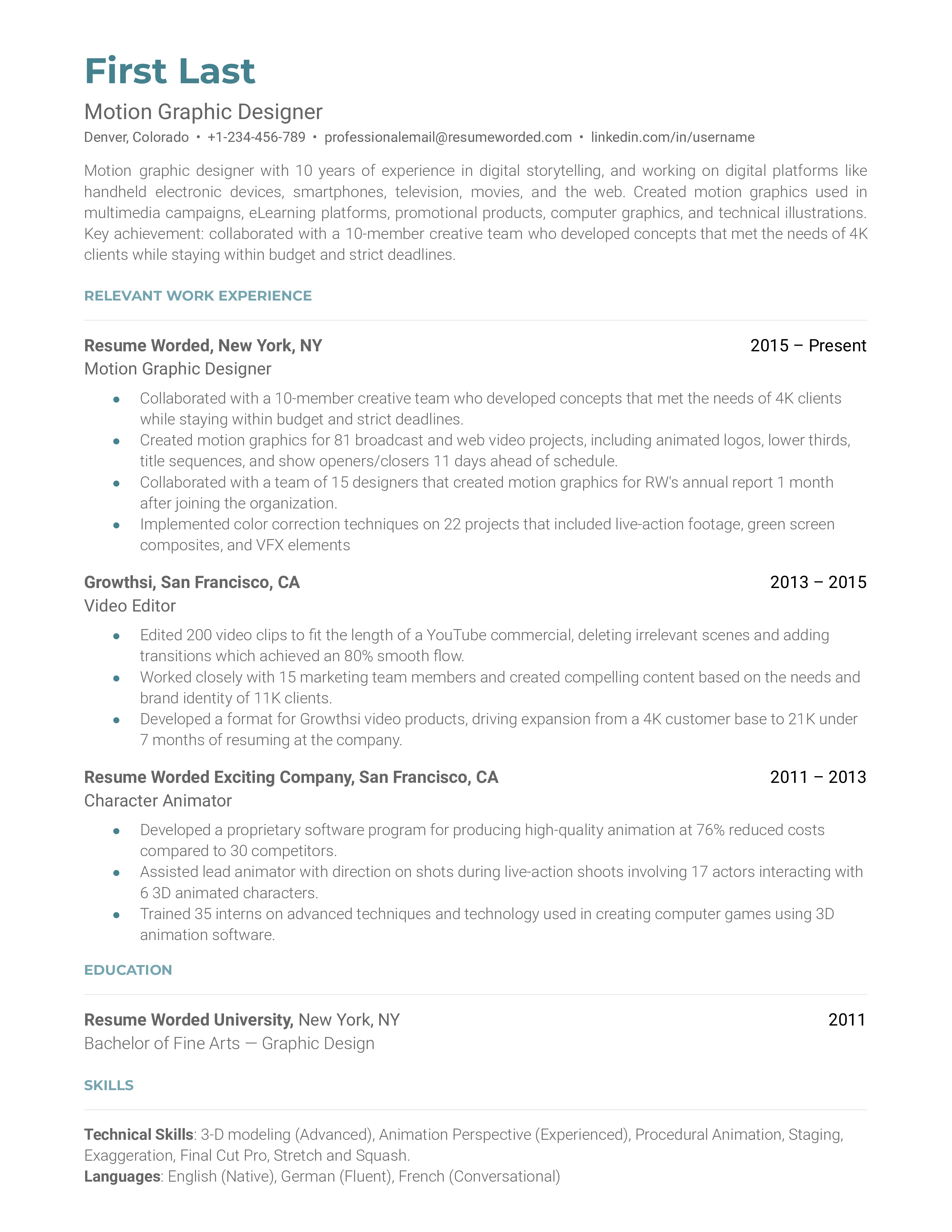
Tips to help you write your Motion Graphic Designer resume in 2024
show the types of motion graphic design you have experience doing..
Recruiters need to know what you can do so they can gauge if you are the right person for them. So mention the different kinds of graphic design that you are experienced with. This applicant has mentioned that they have done animated logos, title sequences, and video edits, among others. If you know the kind of graphic design they want you to do, make sure to emphasize that experience.
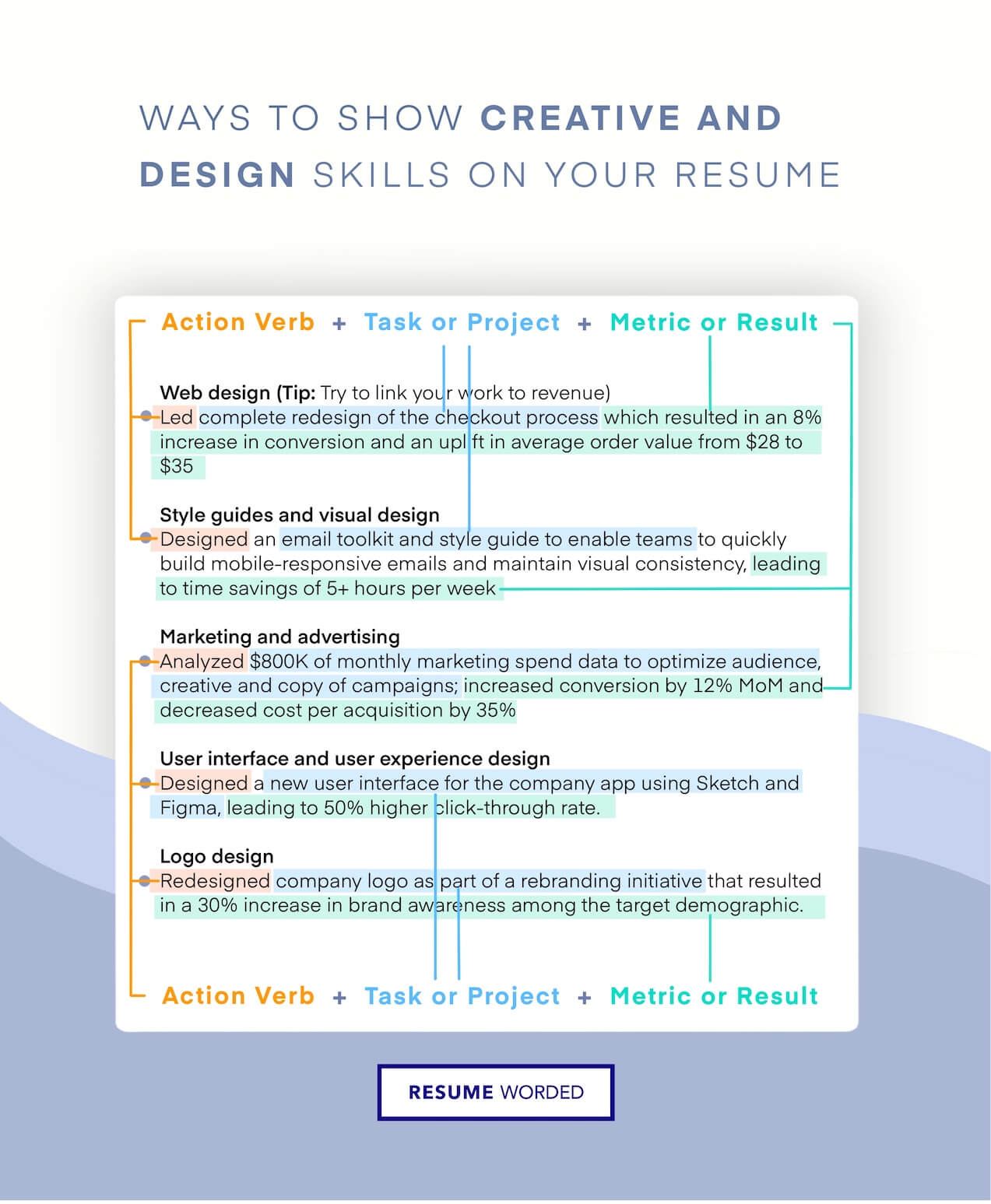
List the types of motion graphic design you are skilled in.
Use your skills section to list the types of motion graphic design you are skilled in. This applicant has lister 3-D modeling, stretch and squash, and staging as some of their skills.

Skills you can include on your Motion Graphic Designer resume
As a hiring manager, I've reviewed countless graphic designer resumes. I've seen applications from candidates vying for roles at top companies like Apple, Google, and Adobe. While the specific skills and experience required may vary depending on the company and role, there are certain elements that consistently make a graphic designer resume stand out. In this article, I'll share some tips to help you craft a compelling resume that showcases your strengths as a graphic designer.
Showcase your versatility as a designer
Employers want to see that you have a diverse skill set and can handle various aspects of graphic design. Highlight your proficiency in different areas, such as:
- Branding and logo design
- Web and mobile app design
- Print design (brochures, posters, packaging)
- Illustrations and infographics
By demonstrating your versatility, you show that you can adapt to different projects and contribute to the company in multiple ways. Remember to provide specific examples of your work in each area to give the employer a clear picture of your capabilities.
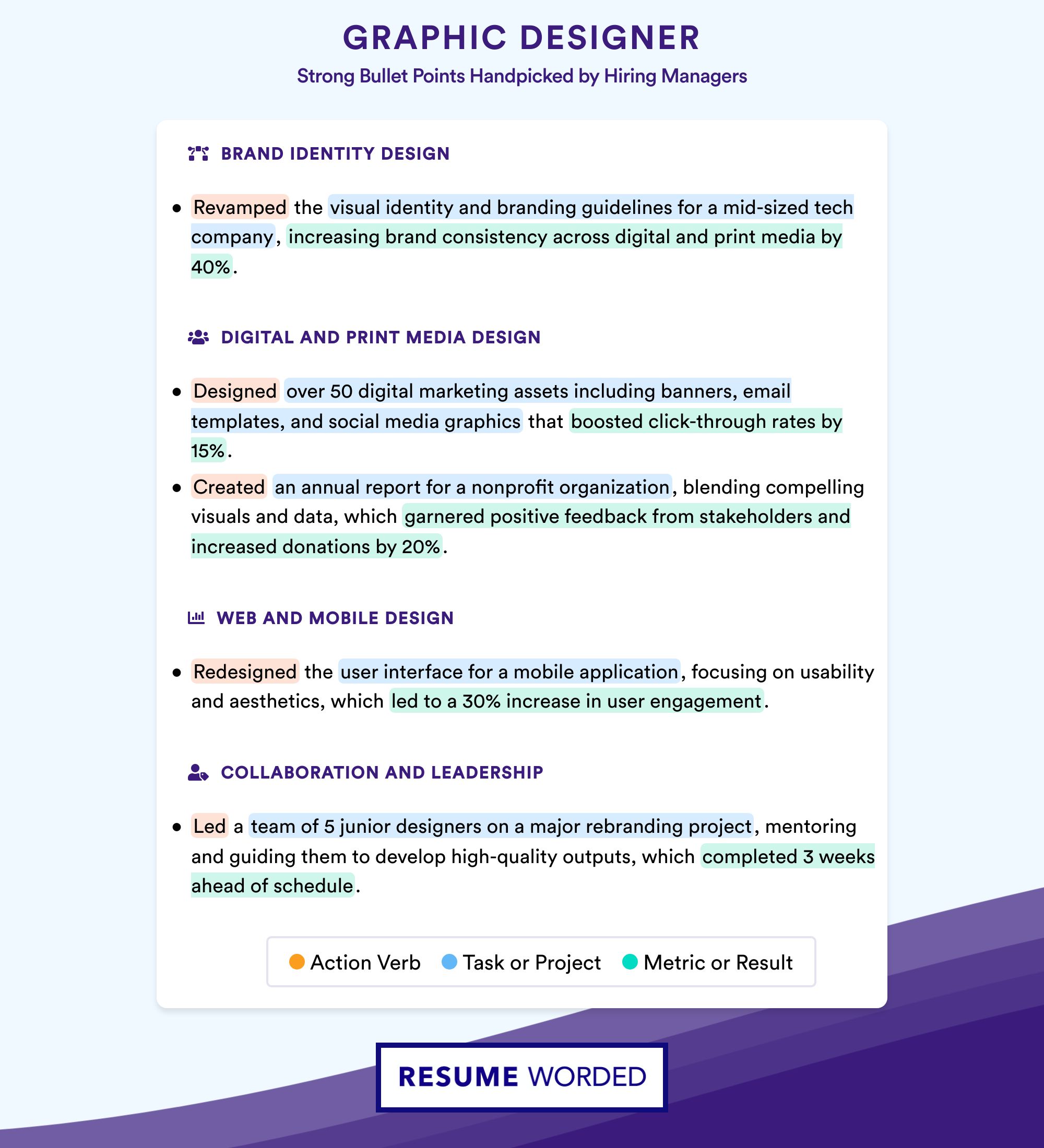
Emphasize your software proficiency
As a graphic designer, your software skills are crucial. Employers want to know that you're proficient in industry-standard tools. Instead of simply listing the software you know, provide context to showcase your expertise:
- Adobe Creative Suite
A more effective way to highlight your skills:
- Advanced proficiency in Adobe Photoshop, Illustrator, and InDesign, with 5+ years of experience creating print and digital designs
- Skilled in using Sketch and InVision to create and prototype mobile app interfaces, collaborating closely with development teams
By providing specific examples and context, you demonstrate the depth of your knowledge and how you apply these skills in your work.
Quantify your impact and achievements
When describing your work experience, use metrics to quantify your impact and achievements. This helps employers understand the scale and significance of your contributions. For example:
- Designed logos for various clients
- Created social media graphics
Instead, try:
- Designed logos for 20+ clients across industries, resulting in an average 30% increase in brand recognition
- Created engaging social media graphics that contributed to a 25% increase in follower count and 40% higher engagement rates
By using numbers and percentages, you provide concrete evidence of your success and make your resume more impactful.
Include non-traditional design experience
Don't limit your resume to just your professional experience. Include relevant projects, even if they weren't part of a paid role. This could be:
- Freelance work
- Personal projects or side hustles
- Pro bono work for non-profits or community organizations
- Design competitions or hackathons
These experiences demonstrate your passion, initiative, and ability to apply your skills in different contexts. They can also help fill gaps in your work history and showcase your continuous learning and growth as a designer.
Tailor your resume to the job description
One common mistake graphic designers make is sending a generic resume to every job application. Instead, take the time to tailor your resume to each specific role and company. Here's how:
- Read the job description carefully and identify the key skills and requirements
- Highlight the experiences and projects that are most relevant to the role
- Use similar language and terminology as the job description to show your fit
- Research the company and incorporate your knowledge into your resume summary or objective
By customizing your resume, you demonstrate your genuine interest in the role and make it easier for the employer to see how you can contribute to their team.
Showcase your unique design style
As a graphic designer, your unique style and creative approach are what set you apart. While it's important to demonstrate your versatility, don't be afraid to showcase your signature style in your resume. Here are a few ways to do that:
- Include a link to your online portfolio or website that showcases your best work
- Incorporate design elements or branding that reflect your personal style (while still keeping the overall resume design clean and professional)
- In your resume summary or objective, mention your unique design philosophy or approach
Passionate graphic designer with a bold, minimalist style and a focus on creating impactful, user-centric designs.
By infusing your resume with your unique design perspective, you give employers a taste of what makes you stand out as a creative professional.
Writing Your Graphic Designer Resume: Section By Section
header, 1. decide on the best name format.
Your name is the most important element in your resume header. It should be the largest text on the page and easy to read at a glance. Decide on the best format for your name, such as:
- First Middle Initial Last
- First M. Last
Avoid nicknames or abbreviations that could be confusing. Use your full name as it appears on your professional documents and online profiles for consistency.
2. Include essential contact details
After your name, include your key contact details so hiring managers can easily get in touch with you. Essential details to include are:
- Phone number
- Professional email address
- Location (City, State)
- LinkedIn profile URL
Keep your email address professional, ideally [email protected] . Avoid outdated email providers like Hotmail or AOL. You can omit your full mailing address, but including your city and state lets employers know your general location.
John Doe, Graphic Designer [email protected]
John Doe Graphic Designer [email protected] | 555-123-4567 | New York, NY | linkedin.com/in/johndoe
3. Showcase your specialty as a graphic designer
As a graphic designer, you likely have a specialty or niche you focus on. Highlighting this in your resume header can help you stand out to employers looking for those specific skills. For example:
- John Doe Product Packaging Graphic Designer
- Jane Smith Graphic Designer specializing in Branding & Logo Design
- Bob Johnson UI/UX Graphic Designer
Keep your specialty concise and targeted. Avoid listing multiple unrelated specialties, which can come across as unfocused. By clearly conveying your niche in the header, you'll position yourself as the go-to candidate for those specific needs.
Summary
A resume summary is an optional section that highlights your most relevant experiences and skills in a few sentences. It's best used by graphic designers with several years of experience, are changing careers, or have a diverse background that needs context. Keep it concise and avoid repeating information already in your resume.
In contrast, resume objectives are outdated and should not be used, as they focus on your goals rather than how you can benefit the company. Instead, tailor your summary to the specific graphic designer position you're applying for, and consider including your target job title and relevant keywords to help your resume perform better in applicant tracking systems (ATS).
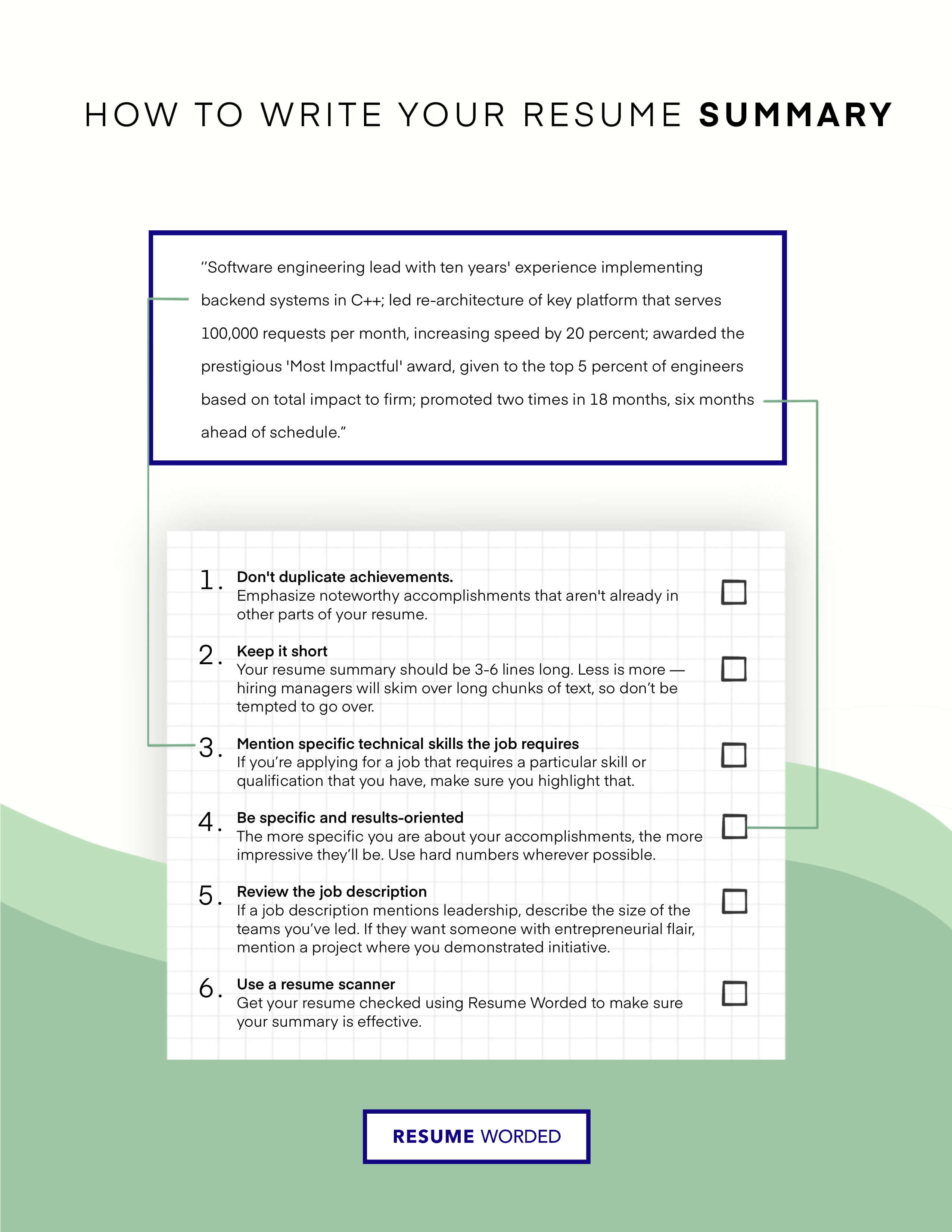
To learn how to write an effective resume summary for your Graphic Designer resume, or figure out if you need one, please read Graphic Designer Resume Summary Examples , or Graphic Designer Resume Objective Examples .
1. Highlight your graphic design expertise
When writing your summary, emphasize your core graphic design skills and expertise that align with the job description. Mention your proficiency in industry-standard software, such as Adobe Creative Suite, and showcase your ability to create visually compelling designs across various media.
Avoid generic statements that could apply to any graphic designer, like:
- Proficient in graphic design software
- Creative and detail-oriented designer
Instead, provide specific examples of your skills and the impact of your work:
- Expert in Adobe Creative Suite, with a focus on creating engaging web and mobile interfaces
- Skilled in developing brand identity systems that drive increased brand recognition and customer loyalty
Ensure your resume showcases your proficiency in the latest graphic design tools and trends. Our Score My Resume tool can provide instant feedback on your resume's content, helping you optimize it for the graphic designer role you're targeting.
2. Demonstrate your impact and achievements
Use your summary to highlight your most impressive achievements and the impact your work has had on your previous employers or clients. Quantify your results whenever possible to give the hiring manager a clear understanding of your value.
Graphic designer with 5+ years of experience creating digital and print designs. Skilled in Adobe Creative Suite and collaborating with cross-functional teams.
While this summary touches on the candidate's experience and skills, it doesn't provide any context on their achievements or the impact of their work. A more effective summary would be:
Results-driven graphic designer with 5+ years of experience creating digital and print designs that engage users and drive business growth. Skilled in leveraging Adobe Creative Suite to develop innovative brand campaigns, resulting in a 30% increase in brand recognition and a 20% boost in sales for key clients.
When tailoring your resume summary to a specific graphic designer role, consider using Targeted Resume to ensure you're including the most relevant keywords and skills from the job description.
Experience
The work experience section is the heart of your graphic designer resume. It's where you showcase your relevant skills, accomplishments, and impact through previous roles. Hiring managers and recruiters look to this section to understand your career trajectory and assess if you're a good fit for the role.
Let's break down the key elements you should focus on when writing an effective work experience section:
1. Highlight your design skills and tools
Throughout your work experience, emphasize the specific design skills and tools you've used to succeed in your roles. Graphic design jobs require proficiency in industry-standard tools, so showcase your expertise.
Less effective work experience statements:
- Designed marketing collateral for product launches
- Created social media graphics and email designs
More effective, tools-focused statements:
- Designed marketing collateral for 5+ product launches using Adobe Creative Suite (Photoshop, InDesign, Illustrator)
- Created engaging social media graphics and email designs in Canva and Adobe Spark, contributing to a 20% increase in click-through rates
2. Quantify your impact with metrics
When describing your achievements in each role, use hard numbers and metrics to quantify your impact whenever possible. This helps hiring managers understand the scope and results of your work.
Weak, unquantified bullets:
- Collaborated with marketing team to design digital ads
- Developed visual brand guidelines for company
Strong, quantified bullets:
- Partnered with marketing team to design 10+ high-performing digital ad campaigns, resulting in a 25% increase in conversions
- Developed comprehensive visual brand guidelines and logo redesign, which were implemented company-wide across 50+ employees
If you don't have access to precise metrics, you can still provide numerical context for your work. For example, mention the size of the team you collaborated with, number of assets designed per month, or number of stakeholders managed.
3. Showcase promotions and career growth
If you've been promoted or taken on increasing responsibilities throughout your career, make sure to highlight that progression in your work experience section. This demonstrates your ability to succeed and grow within an organization.
Junior Graphic Designer, ABC Agency, June 2018 - Dec 2019 • Designed social media graphics and infographics for 5 clients • Assisted senior designers in brainstorming and concept development Senior Graphic Designer, ABC Agency, Jan 2020 - Present • Lead designer for 8 key client accounts, overseeing all visual branding • Mentored and trained 2 junior designers on design best practices and agency processes
By showing the progression from Junior to Senior Graphic Designer, with increasing ownership and leadership, this resume paints a clear picture of the candidate's career growth and impact.
4. Trim details from older or irrelevant roles
As a graphic designer gains experience, their older roles may not need as much detail on the resume. The work experience section should focus primarily on the most recent and relevant positions.
For example, if a senior designer had a past role as a Marketing Intern early in their career, they don't need to provide as much detail:
- Marketing Intern, XYZ Startup, Summer 2015
- Assisted in designing marketing materials for new product launch
The focus remains on the candidate's more recent roles as a Graphic Designer, where they can elaborate on their relevant skills, specialties, and achievements.
To get expert feedback on every section of your graphic design resume, try our free Score My Resume tool. It checks your resume on 30+ key criteria recruiters and hiring managers look for, so you can ensure your work experience section and overall resume are well-optimized.
Education
The education section on your graphic designer resume should be concise and highlight your most relevant qualifications. You want to show the hiring manager that you have the necessary educational background and training to excel in the role. Here are some tips to help you write an effective education section:

1. List your degrees in reverse chronological order
Start with your most recent degree and work backwards. If you have a bachelor's degree or higher, you can leave out your high school information. For each degree, include:
- Name of the institution
- Location of the institution
- Degree earned
- Graduation date (month and year)
- Major and minor (if applicable)
Bachelor of Fine Arts in Graphic Design University of California, Los Angeles Los Angeles, CA Graduated: May 2020
2. Include relevant coursework and projects
If you are a recent graduate or have limited work experience, you can highlight relevant coursework, projects, or extracurricular activities in your education section. This shows the hiring manager that you have hands-on experience and skills related to graphic design.
However, avoid listing every course you've taken. Instead, focus on:
- Advanced or specialized courses in graphic design software, web design, or typography
- Capstone projects or thesis work
- Relevant electives or workshops
3. Showcase your design education and training
Graphic design is a field that values both creativity and technical skills. Use your education section to showcase your training in design principles, software, and tools.
If you attended a prestigious design school or program, make sure to highlight that. You can also mention any specialized training or certifications you've completed, such as:
- Adobe Creative Suite (Photoshop, Illustrator, InDesign)
- UX/UI design
- Web design and development
- Print production and pre-press
4. Keep it brief if you are a senior-level designer
If you have several years of experience as a graphic designer, your education section should be short and sweet. Hiring managers are more interested in your professional accomplishments and portfolio than your degrees from many years ago.
Here's an example of what not to include:
Bachelor of Fine Arts in Graphic Design Rhode Island School of Design Providence, RI Graduated: May 1995 Relevant Coursework: Typography I, II, and III, Web Design, Printmaking, Photography, Art History Survey
Instead, keep it concise:
BFA, Graphic Design, Rhode Island School of Design
Action Verbs For Graphic Designer Resumes
Graphic designers need to be able to conceptualize visuals, create compelling and on-brand designs, and present their ideas to clients. Use action verbs in your resume to highlight those skills — for example, using Illustrated or Fashioned shows your ability to create and finalize a design, while Revitalized and Customized demonstrate an awareness of branding and client needs. Always structure your work experience bullet points with the action verb first. This puts the emphasis on what you actually accomplished, rather than simply listing job duties. For even more ideas to kickstart your graphic designer resume, check out our full list of resume action verbs .

- Conceptualized
- Illustrated
- Streamlined
- Revitalized
- Established
For a full list of effective resume action verbs, visit Resume Action Verbs .
Action Verbs for Graphic Designer Resumes
How to write a graphic designer resume – step by step.
Writing a resume to apply for a graphic designer role is easy if you keep a few things in mind. Let's dive in — these steps are relevant across a range of design role, including graphic design, creative leadership and web design roles.
Getting the Basics right for writing a Graphic Designer resume
1.1: structure your resume to list the most recent sections first (reverse chronological order).
When creating or editing any resume, putting your most recent experiences first makes it easier for recruiters to see your current skill level. They can skim the list and see which one is your most recent role (i.e. the one they are most interested in). This is often called the reverse chronological order.
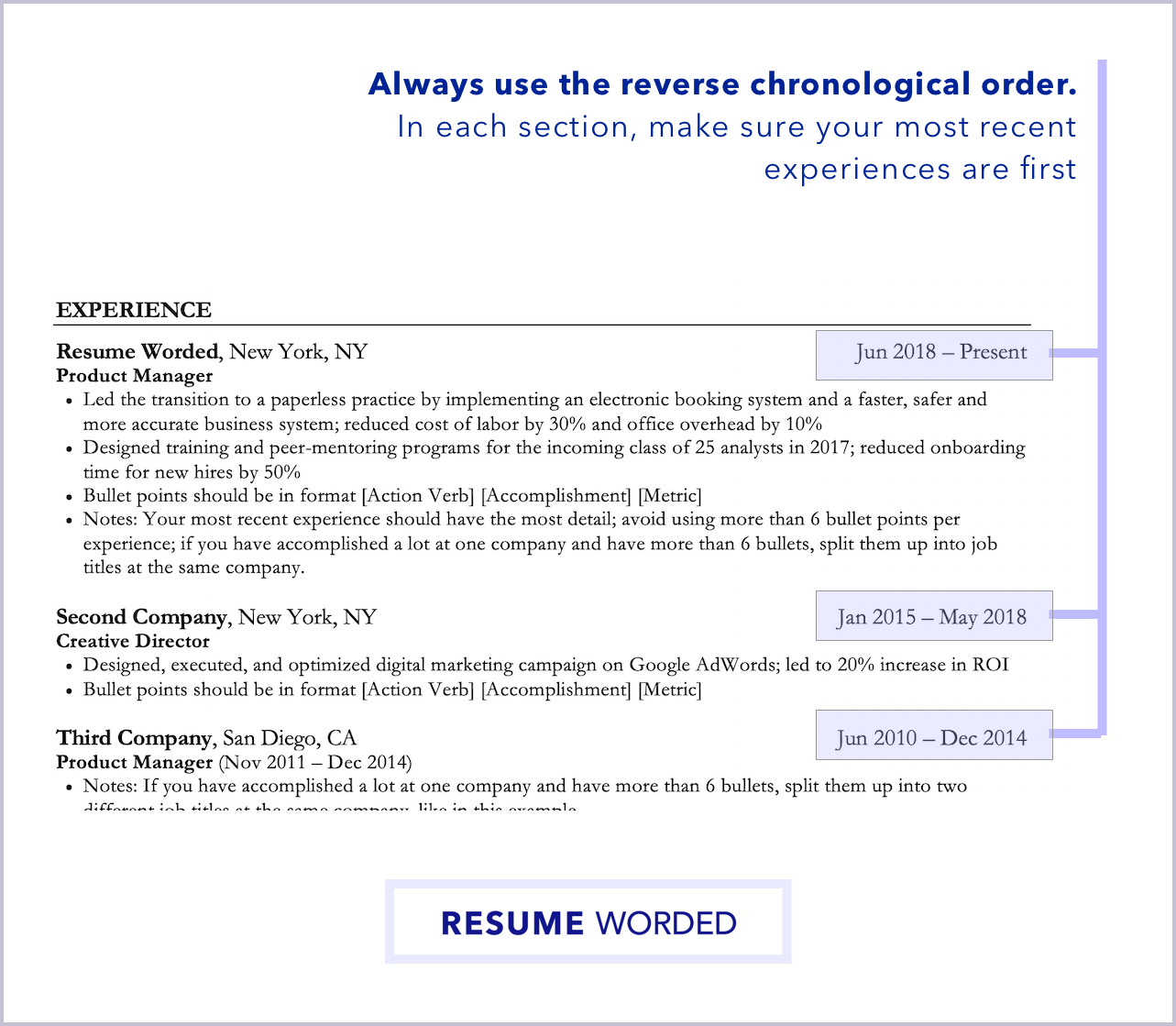
1.2: Include any Portfolio links in the Resume Header
As a graphic designer, you need to have a portfolio of your samples from different past work and projects. Including a portfolio link — whether that's on Behance, Dribbble, or even just LinkedIn — will make it easier for recruiters to see what you can do in a semi-professional environment and strengthens your overall resume. If you don't have a portfolio, don't feel the need to include a link at all — it's an optional part of your resume header.
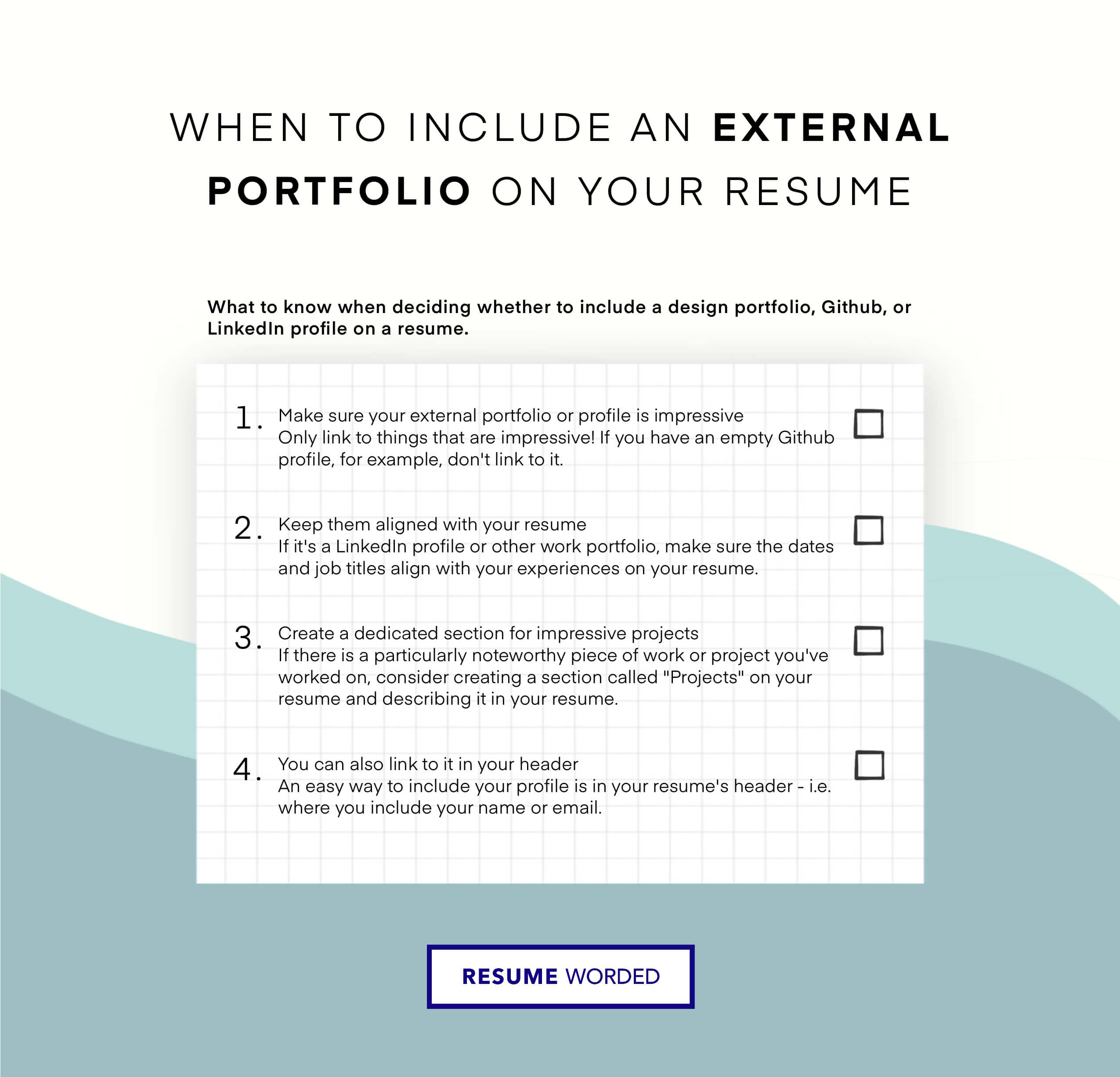
1.3: Highlight your growth in the industry
To land a mid- to senior-level roles like a Senior Graphic Designer or Creative Head, you need to show leadership and initiative. Pointing out promotions at past jobs shows that you are a leader as well as an exemplary employee who is committed to their professional growth. If you have held promotions in the design field, mention them. Bold your job titles so your promotion is more prominent.

Expressing your Design Experience
2.1: highlight your creativity and design-related knowledge in your bullet points.
Keeping your work experience section organised in bullet points is always the right option. Recruiters can skim your resume and find the information they need quickly. Here's an example bullet point for design experience: Collaborated with Lead Engineer to develop a cohesive style guide to standardize 50+ design components for Android and web app
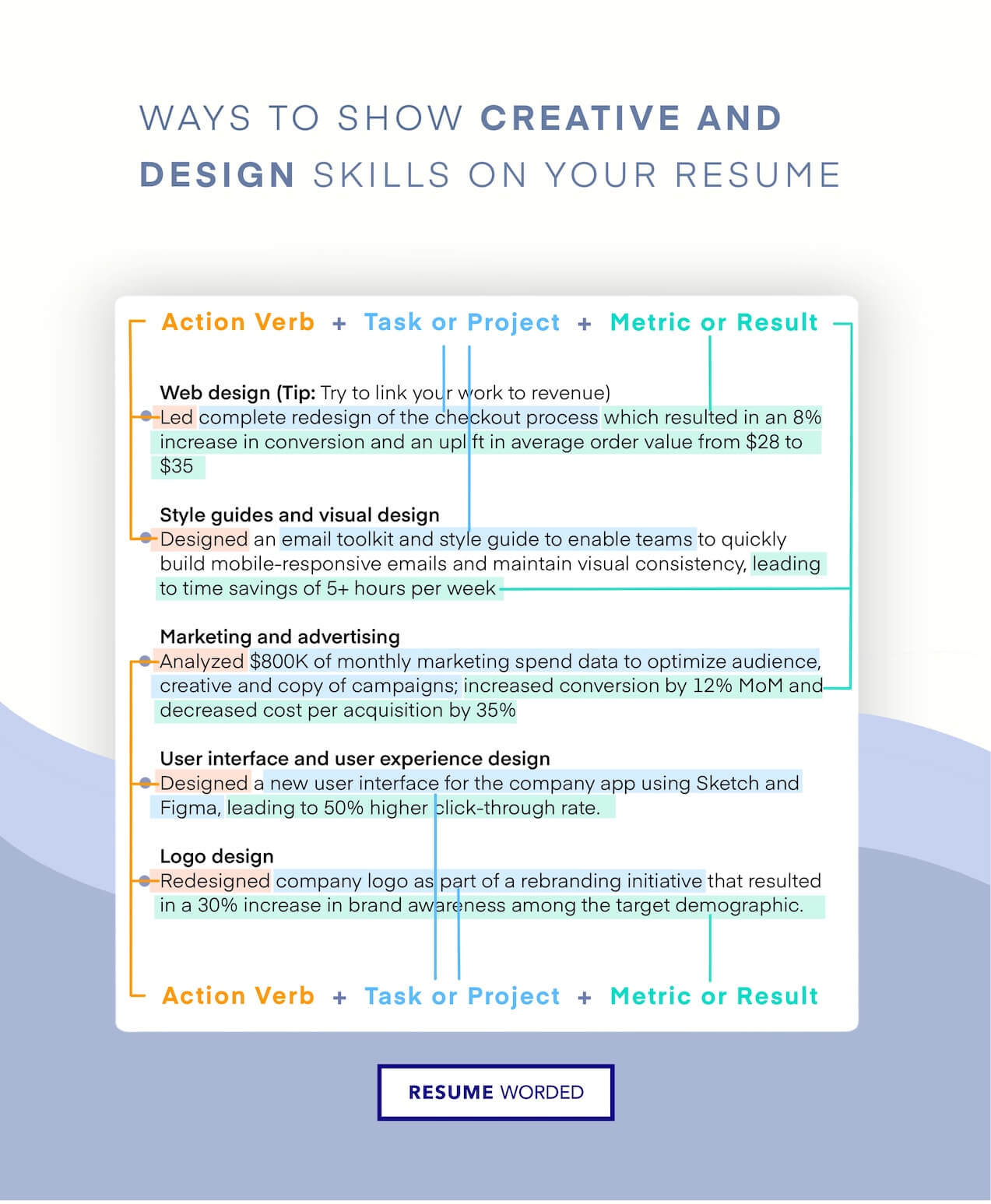
2.2: Stick to the [Action Verb] + [Task] + [Impact of Work] structure
Your bullet points need to be structured by using an action verb. Using an action verb related to graphic design helps emphasize your practical experience and keeps it relevant to the job. Common action verbs graphic designers use are Designed, Conceptualized, Illustrated and Revised. Mentioning the impact of the work is beneficial to showing your success. This can be hard data (e.g. 'created reusable components that saved 25+ hours a week of designer time') or the general outcome such as "improved efficiency".
![how to write a resume graphic design Stick to the [Action Verb] + [Task] + [Impact of Work] structure](https://resumeworded.com/assets/images/resume-guides/how-to-images/action-verbs.jpg)
2.3: Keep your skills section concise and relevant to the job; emphasize the job's skills, whether that's app design, web design or physical designs.
Limit the skill list to only relevant ones for the type of design job you want. Definitely don't include more than 12 hard skills in your skills section. In saying that, only include those specific to the graphic designer role you want and the kind of job you're applying for. For example, if you're applying to a graphic design role that has a focus on website development, you might want to include, "Web design", "Figma" or "CSS" on your resume's skills section. If you're applying to a role that focuses on branding and physical designs, you might want to include, "Illustrator", "Branding" or "Canva" on your resume.

2.4: Include the graphic design software through your use of bullet points
Always remember to list the software you're experienced using for your graphic design processes, especially ones you currently use. The Adobe Creative Cloud suite, Sketch, Figma and general web development languages like CSS are big ones that recruiters often look for.

Getting past the resume screeners and Applicant Tracking Systems
3.1: ensure the resume scanning software can read your resume template.
Applicant tracking system software scan your resume to identify if you'd be a good fit, essentially by checking if you have the essential skills the job needs. If the software can't read your resume, it might just think you don't have the right skills and immediately reject you by default. Word of warning: Don't create your resume in design software like Photoshop or Canva! These tools will convert your resume into an image which will make it impossible to be read by these ATS tools. Instead, just use Google Docs or Word.
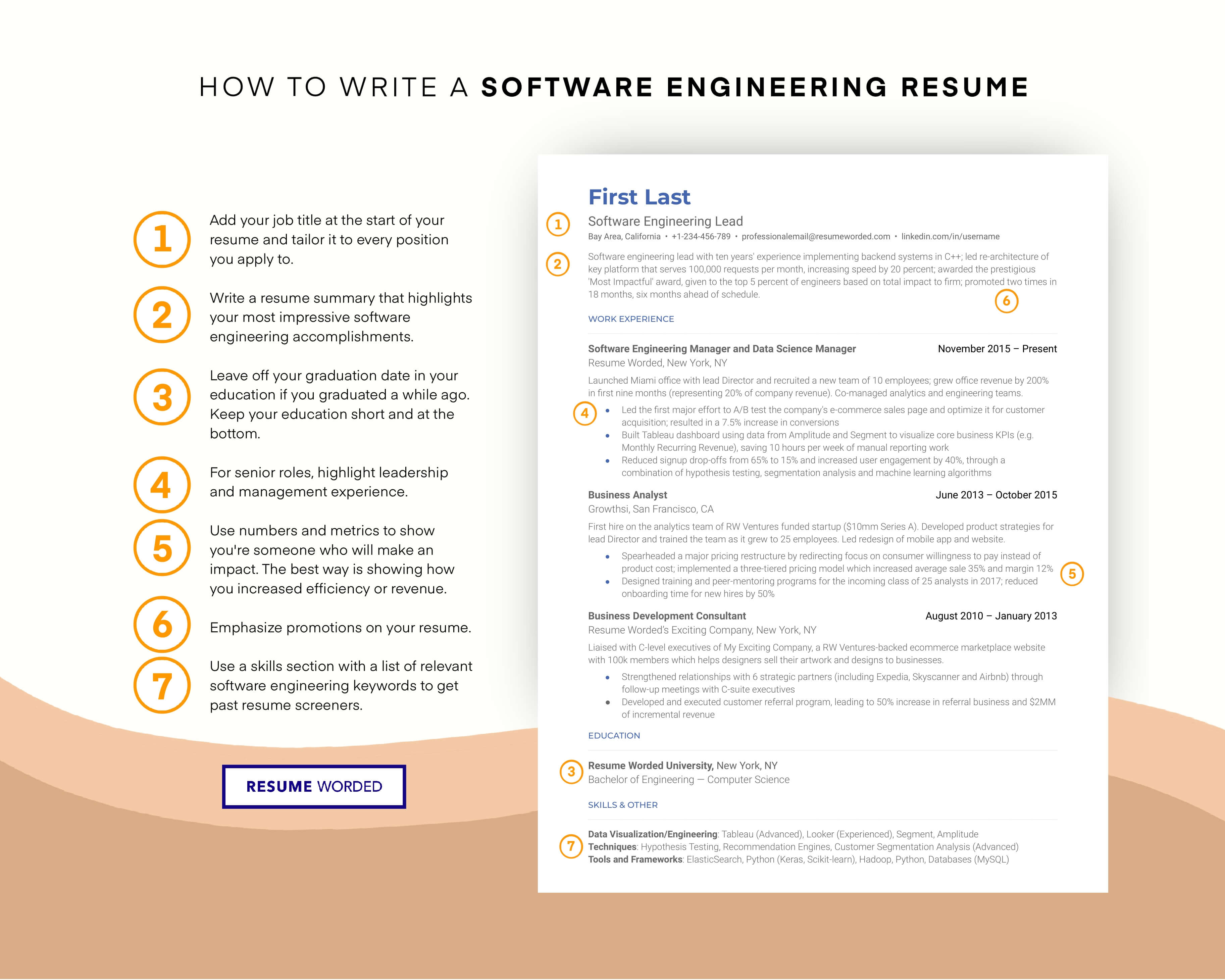
3.2: Don’t include skills you’re not comfortable with in a professional setting
Please don't claim knowledge of a tool or design framework on your resume, but not be able to answer questions about it in an interview. It's much better to have deep expertise in one or two design methodologies or software, than to say you know everything (which also shows a lack of focus, something you shouldn't anyway do if you're tailoring your resume).
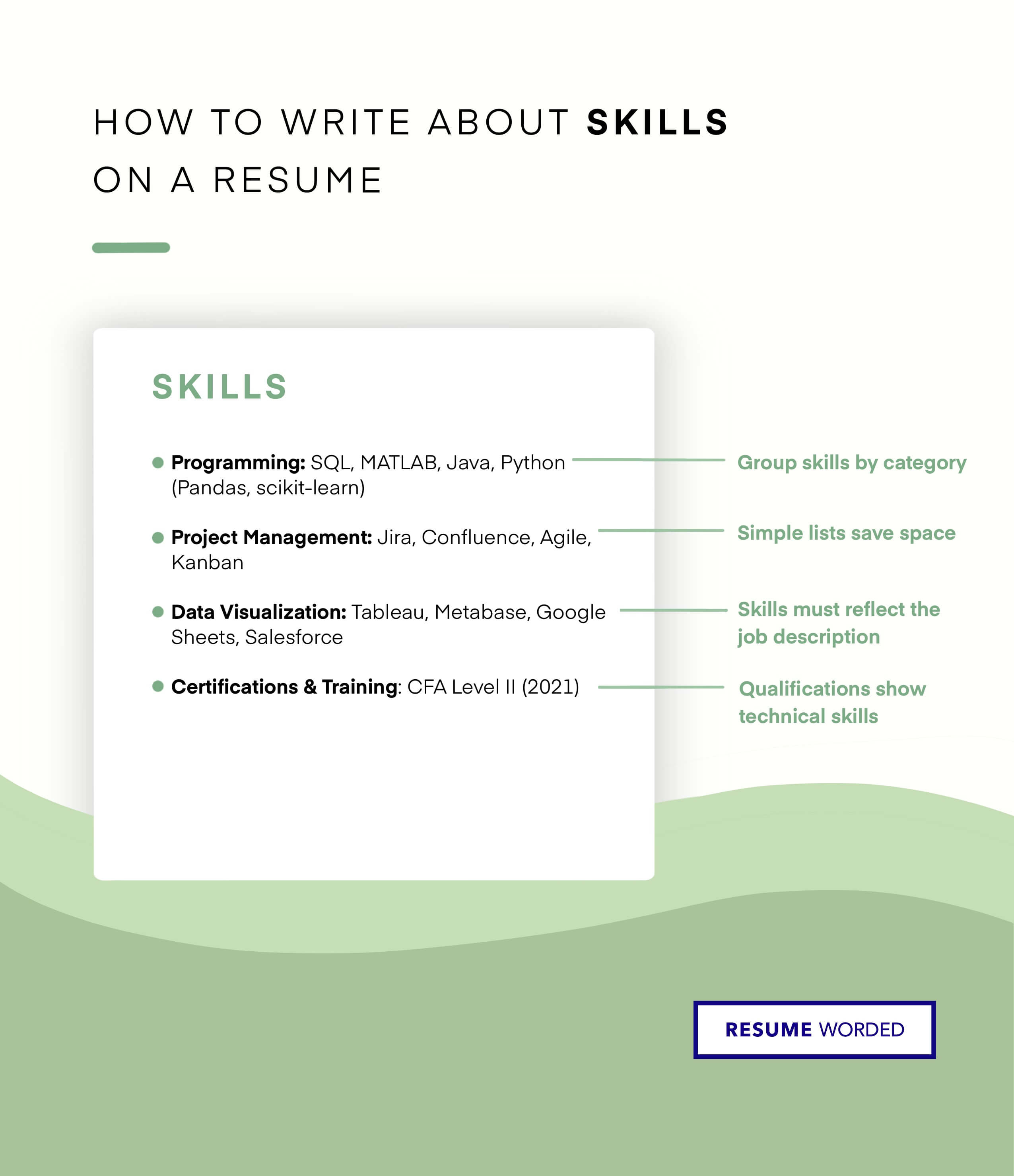
3.3: Submit the resume as a PDF
Using word processing software to write a resume is a must. However, if it's opened in different software, the layout, formatting, and font might change. Saving the resume as a PDF once you're happy with it ensures there's no chance of it being altered to work with other software.
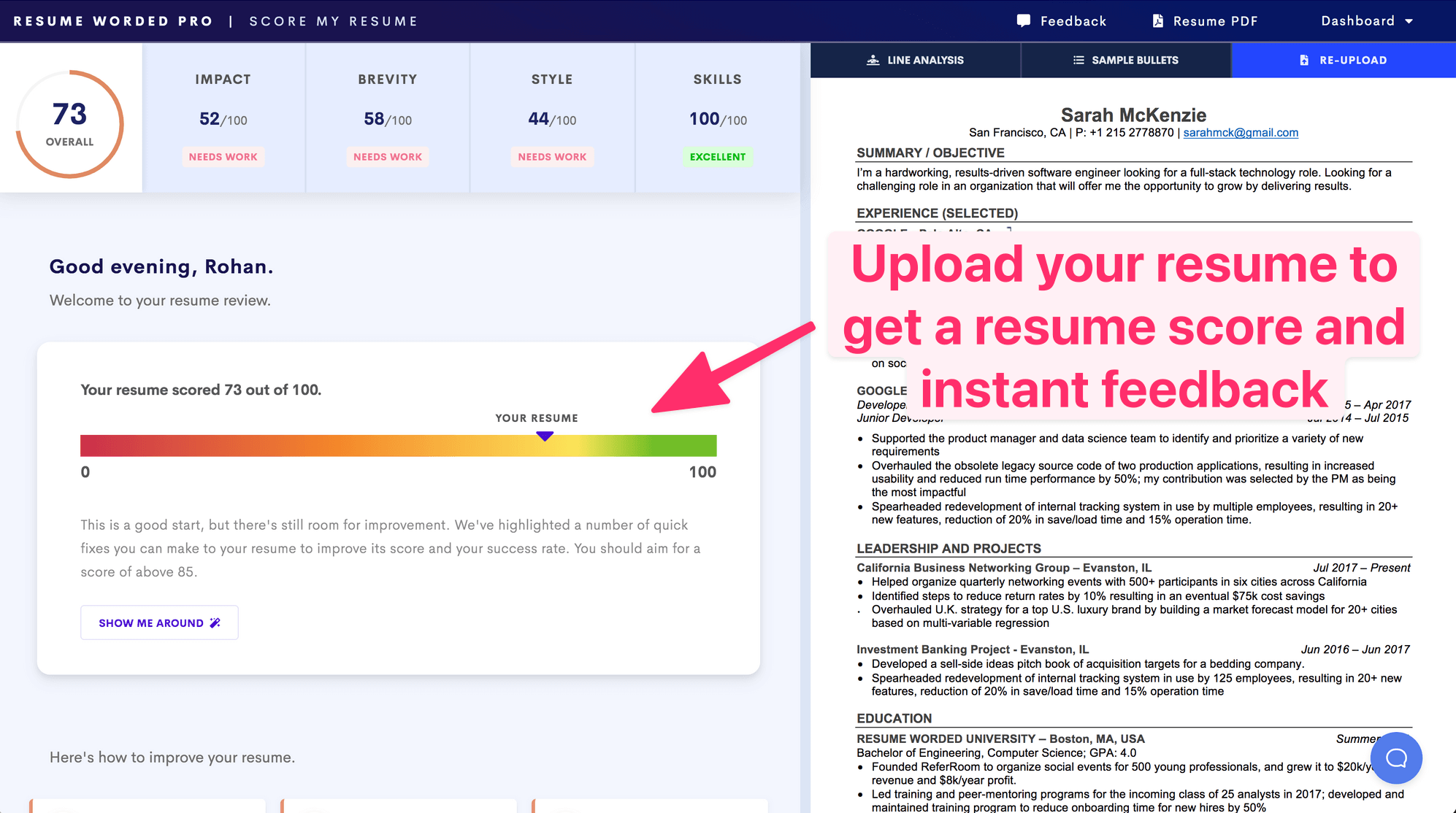
Putting the final touches on your Graphic Designer resume
4.1: add a resume summary if you're changing careers.
A resume summary is optional and not essential but is helpful if you're changing careers into the creative field. It needs to highlight your previous achievements not included in the rest of the resume. Use this to highlight achievements and mention transferable skills that are relevant to across industries, whether that's communicating with stakeholders or leading a design project.
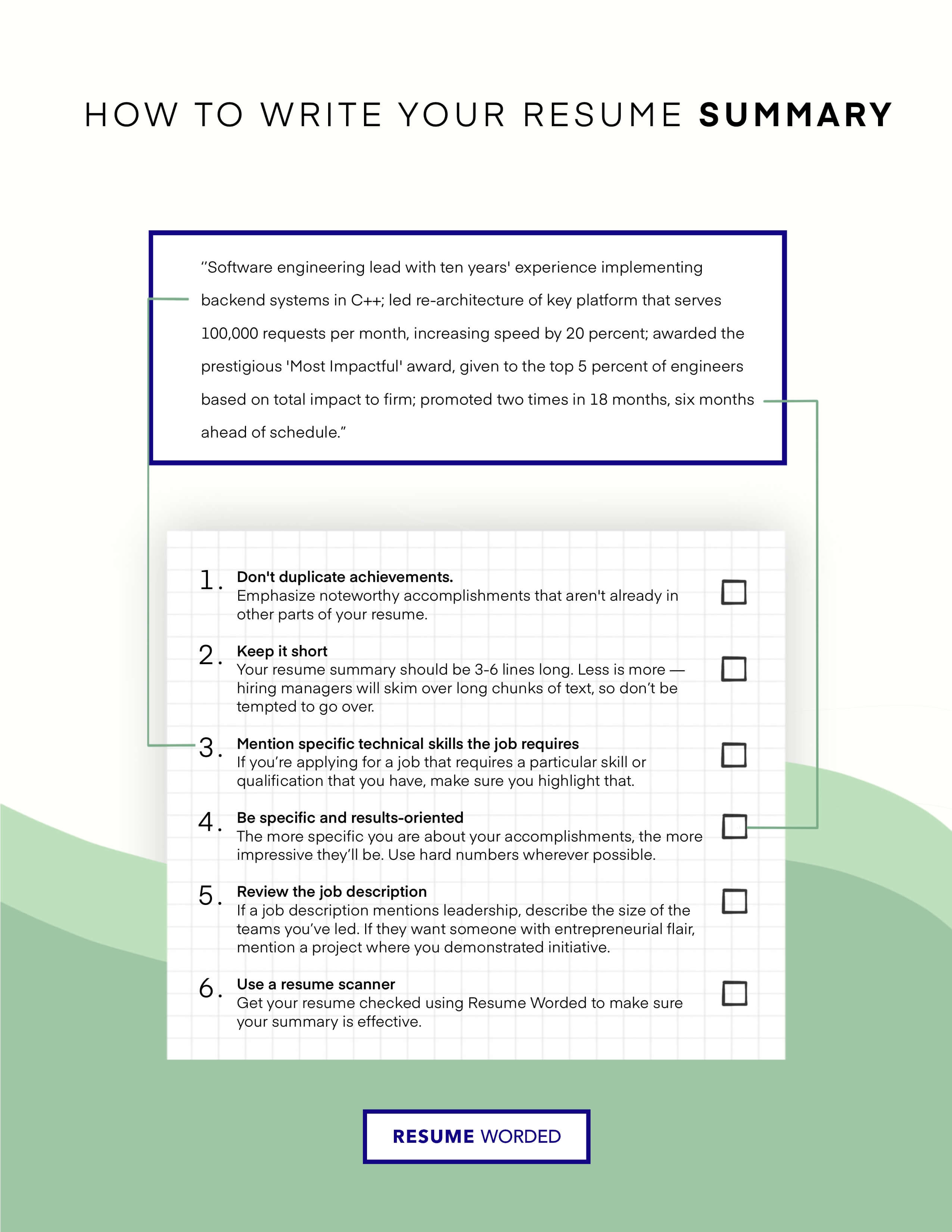
4.2: The Education section doesn't need to be long
If you're a mid or senior level job seeker, the education section isn't the most important thing on the resume to a recruiter. Just include the degree name, the school, graduation date (if under ten years ago) and any accomplishments relating to the job.
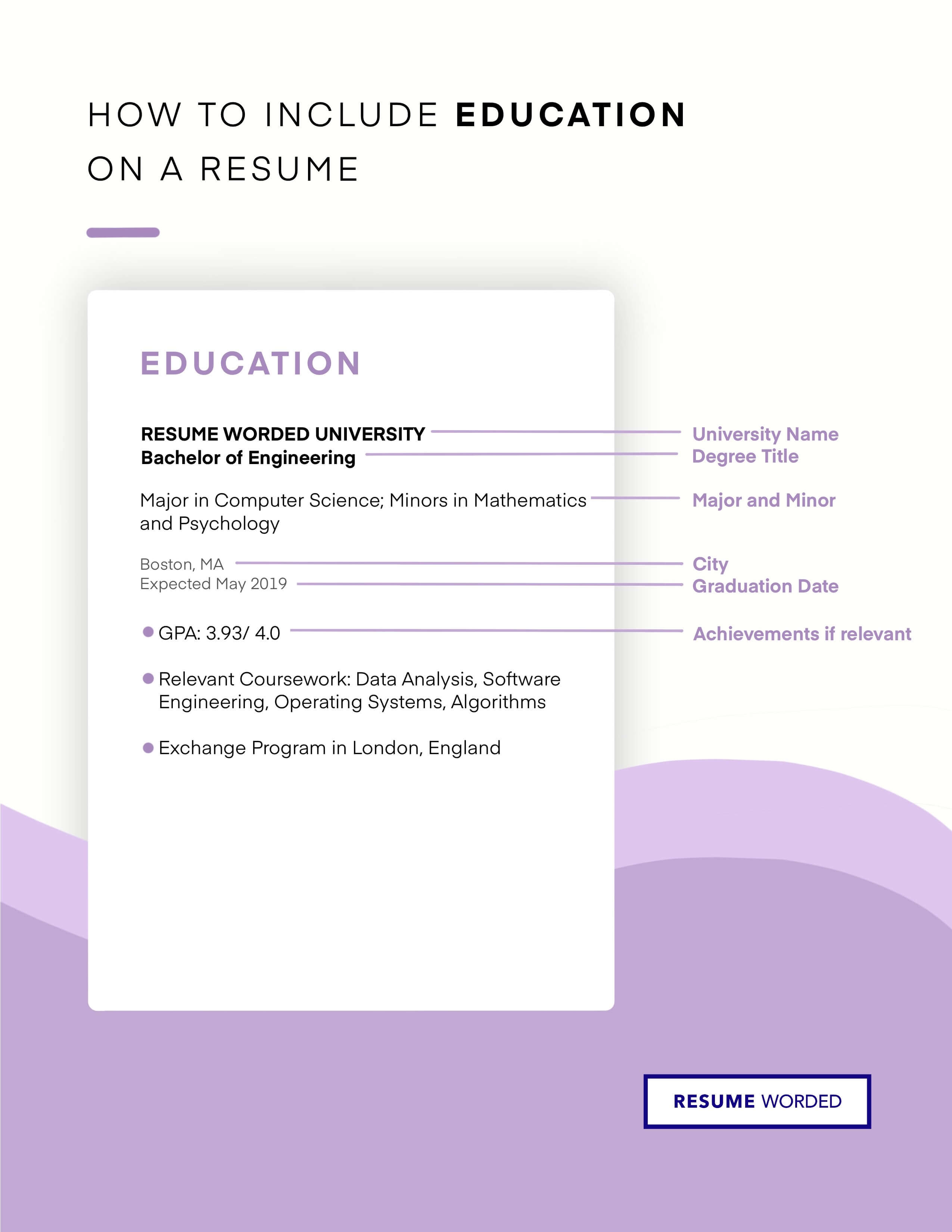
Skills For Graphic Designer Resumes
Unsurprisingly, the most important hard skills for graphic designers are design software skills. Developing proficiency with a few key design programs — whether that’s self-taught or through formal qualifications — is essential to landing a role as a graphic designer. Make sure to list these skills somewhere in your resume, either in your bullet points or a separate skills section, to bypass any Applicant Tracking Systems and impress recruiters. The exact skills you need may depend on the exact job you’re applying for, so always read the job description thoroughly to find out which skills are the most important and tailor your resume accordingly. Our Targeted Resume tool will point out any important skills or keywords you’re missing and give you personalized advice on how to improve your resume.
- Logo Design
- Graphic Design
- Adobe Illustrator
- Adobe InDesign
- Page Layout
- Video Editing
- Adobe Photoshop
- Illustration
- Art Direction
- Visual Communication
- After Effects
- Photography
- Digital Photography
How To Write Your Skills Section On a Graphic Designer Resumes
You can include the above skills in a dedicated Skills section on your resume, or weave them in your experience. Here's how you might create your dedicated skills section:

Skills Word Cloud For Graphic Designer Resumes
This word cloud highlights the important keywords that appear on Graphic Designer job descriptions and resumes. The bigger the word, the more frequently it appears on job postings, and the more 'important' it is.

How to use these skills?
Resume bullet points from graphic designer resumes.
You should use bullet points to describe your achievements in your Graphic Designer resume. Here are sample bullet points to help you get started:
Conducted 25+ user-testing focus groups leading to 3 new product features in 6 months
Redesigned company's homepage and lead generation forms using only existing site components; reduced bounce rates by 40% and increased leads by 15%
Analyzed impact and effectiveness of in-app UI changes on customer retention; identified features of customer behavior and recommended additional menu modifications [R, MySQL, Chart JS]
Led application design sessions with client teams on 20+ projects to develop functional and technical requirements
Decreased uninstallation rate by 40% by introducing an interactive tutorial at app launch
For more sample bullet points and details on how to write effective bullet points, see our articles on resume bullet points , how to quantify your resume and resume accomplishments .
Frequently Asked Questions on Graphic Designer Resumes
What should a graphic designer put on a resume.
- A link to your portfolio in the header section: Alongside your name and address in the header, it is a good idea to include a link to a portfolio that demonstrates samples of your design work. The portfolio should contain three to five examples that display your skillset. Including a job title such as 'Graphic Designer’ or ‘User Interface Graphic Designer’ will help tailor your resume to a specific role. You can also include a link to your LinkedIn profile.
- Professional experience: Graphic design hiring managers prefer that you use bullet points for this section as they are easy to skim. In your bullet points, highlight specific experience with common graphic design tasks like creating logos, developing mockups, and creating infographics.
- Education: Where did you learn your craft? List your degree, online courses, or graphic design certifications here. For recent graduates, you can include design projects you did at university. Experienced designers should just list the certification name, school, and graduation date.
- A Skills section
What skills should you put on a graphic designer resume?
How to improve graphic design resume.
Designed logos for 40 companies in the first six months (against a target of 25) thus growing the division’s revenue by 30%.
Other Design Resumes
Game design.
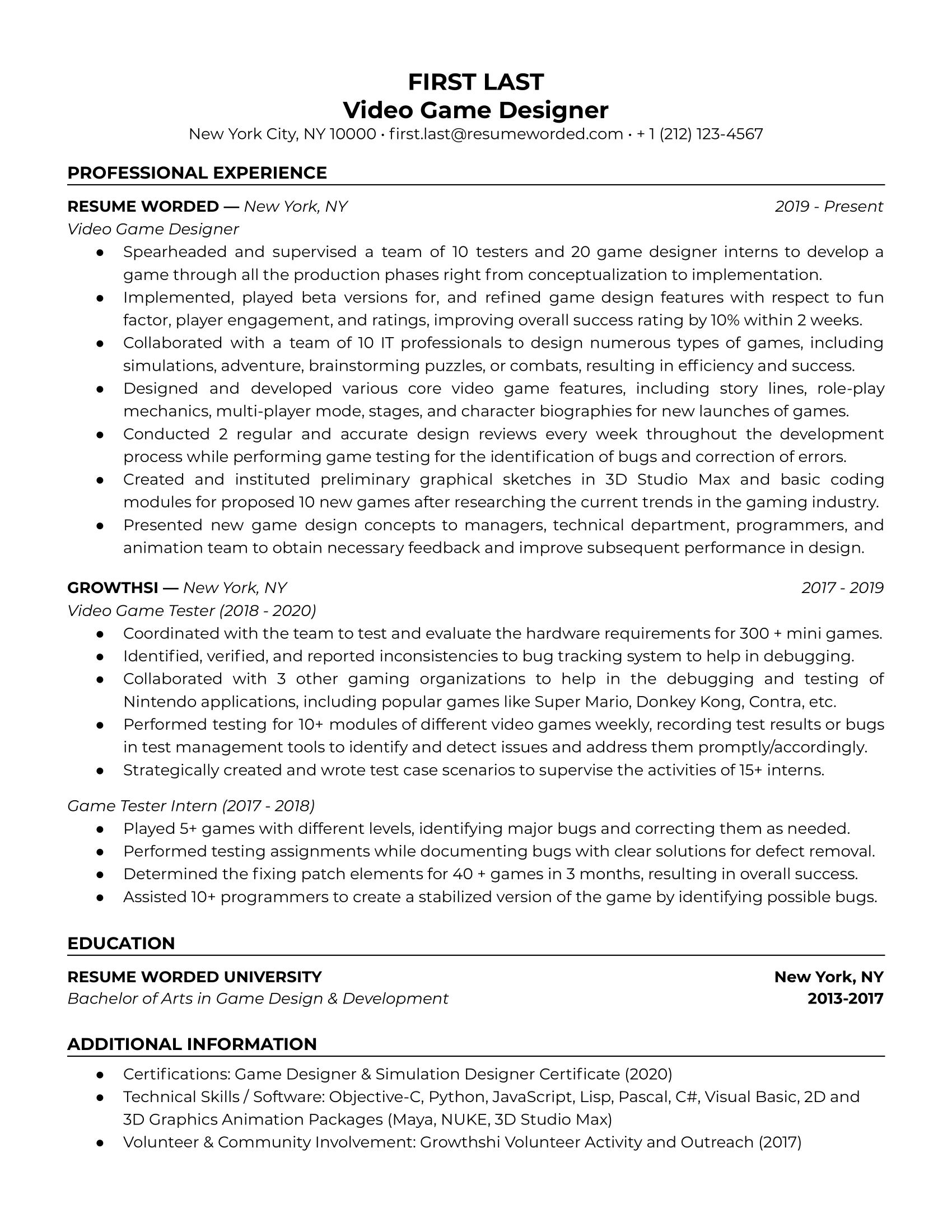
Instructional Design
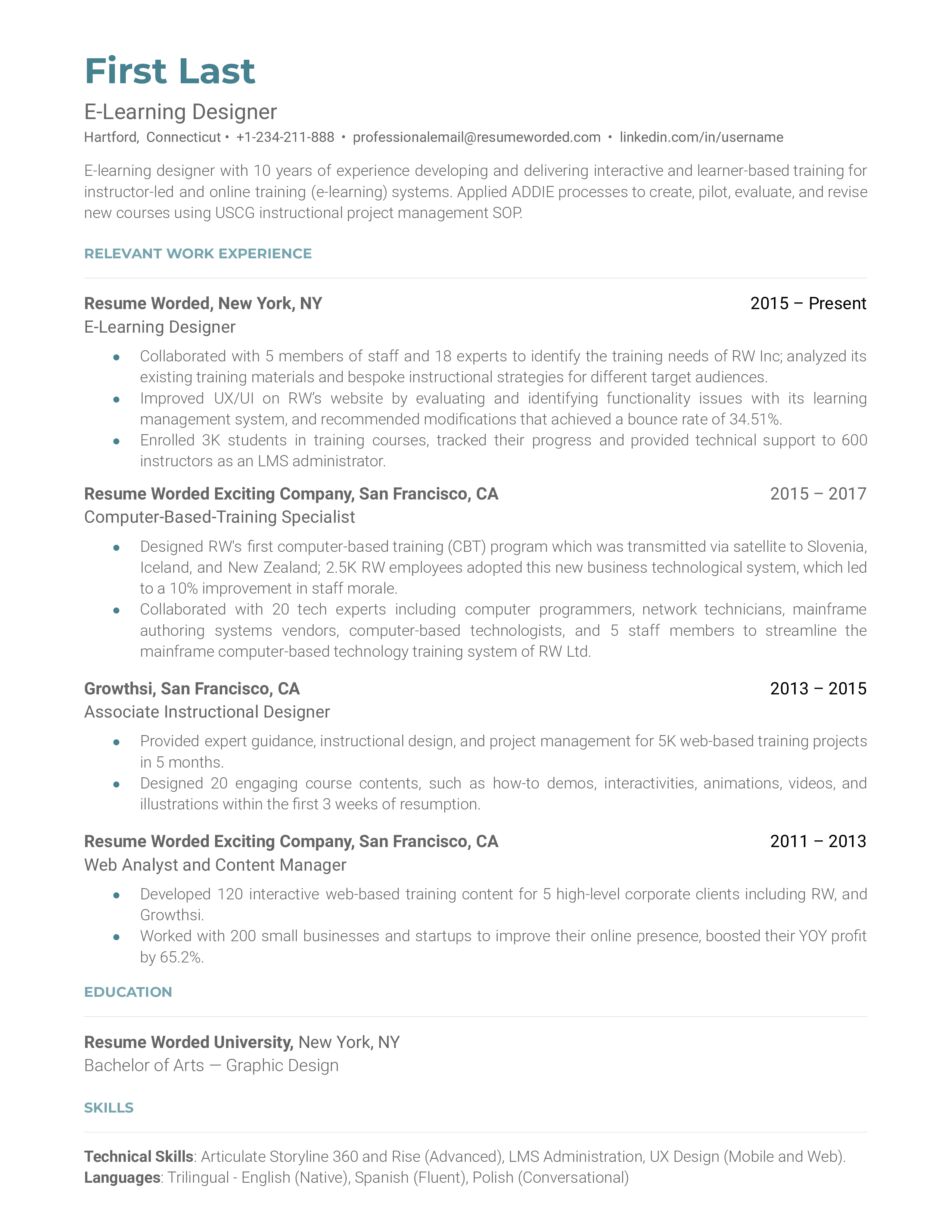
Interior Design
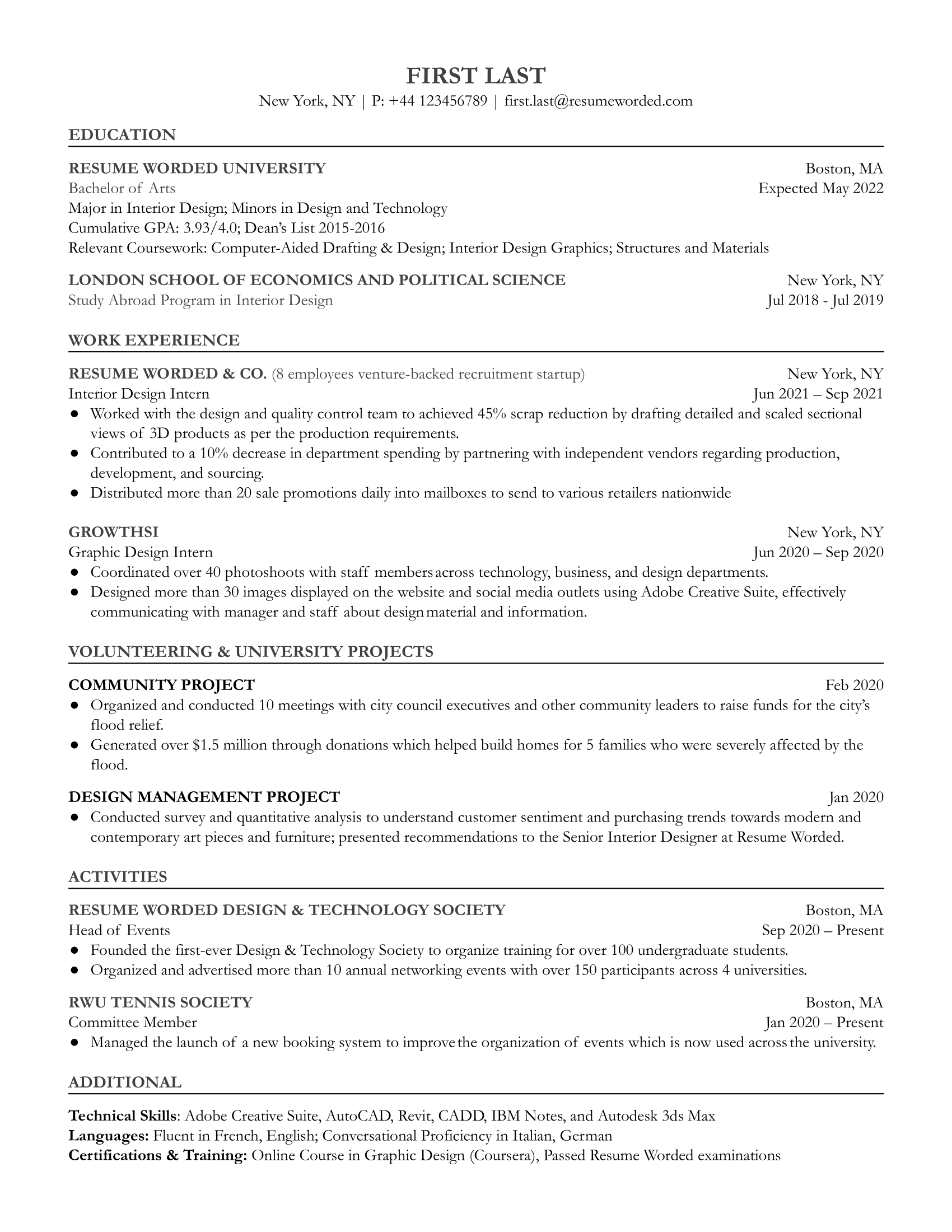
- UX Designer Resume Guide
- UX Researcher Resume Guide
- Architecture Resume Guide
Graphic Designer Resume Guide
- 3D Artist Resume Guide
- Game Design Resume Guide
- Interior Design Resume Guide
- Production Assistant Resume Guide
- Instructional Design Resume Guide
- Art Director Resume Guide
- Design Director Resume Guide
- Graphic Designer Resume Example
- Junior Graphic Designer Resume Example
- Senior Graphic Designer / Director of Graphic Design Resume Example
- Graphic Design Manager Resume Example
- Freelance Graphic Designer Resume Example
- Creative Graphic Designer Resume Example
- Minimalist Graphic Designer Resume Example
- Motion Graphic Designer Resume Example
- Tips for Graphic Designer Resumes
- Skills and Keywords to Add
- Sample Bullet Points from Top Resumes
- All Resume Examples
- Graphic Designer CV Examples
- Graphic Designer Cover Letter
- Graphic Designer Interview Guide
- Explore Alternative and Similar Careers
Download this PDF template.
Creating an account is free and takes five seconds. you'll get access to the pdf version of this resume template., choose an option..
- Have an account? Sign in
E-mail Please enter a valid email address This email address hasn't been signed up yet, or it has already been signed up with Facebook or Google login.
Password Show Your password needs to be between 6 and 50 characters long, and must contain at least 1 letter and 1 number. It looks like your password is incorrect.
Remember me
Forgot your password?
Sign up to get access to Resume Worded's Career Coaching platform in less than 2 minutes
Name Please enter your name correctly
E-mail Remember to use a real email address that you have access to. You will need to confirm your email address before you get access to our features, so please enter it correctly. Please enter a valid email address, or another email address to sign up. We unfortunately can't accept that email domain right now. This email address has already been taken, or you've already signed up via Google or Facebook login. We currently are experiencing a very high server load so Email signup is currently disabled for the next 24 hours. Please sign up with Google or Facebook to continue! We apologize for the inconvenience!
Password Show Your password needs to be between 6 and 50 characters long, and must contain at least 1 letter and 1 number.
Receive resume templates, real resume samples, and updates monthly via email
By continuing, you agree to our Terms and Conditions and Privacy Policy .
Lost your password? Please enter the email address you used when you signed up. We'll send you a link to create a new password.
E-mail This email address either hasn't been signed up yet, or you signed up with Facebook or Google. This email address doesn't look valid.
Back to log-in
These professional templates are optimized to beat resume screeners (i.e. the Applicant Tracking System). You can download the templates in Word, Google Docs, or PDF. For free (limited time).
access samples from top resumes, get inspired by real bullet points that helped candidates get into top companies., get a resume score., find out how effective your resume really is. you'll get access to our confidential resume review tool which will tell you how recruiters see your resume..

Writing an effective resume has never been easier .
Upgrade to resume worded pro to unlock your full resume review., get this resume template (+ 13 others), plus proven bullet points., for a small one-time fee, you'll get everything you need to write a winning resume in your industry., here's what you'll get:.
- 📄 Get the editable resume template in Google Docs + Word . Plus, you'll also get all 13 other templates .
- ✍️ Get sample bullet points that worked for others in your industry . Copy proven lines and tailor them to your resume.
- 🎯 Optimized to pass all resume screeners (i.e. ATS) . All templates have been professionally designed by recruiters and 100% readable by ATS.
Buy now. Instant delivery via email.
instant access. one-time only., what's your email address.

I had a clear uptick in responses after using your template. I got many compliments on it from senior hiring staff, and my resume scored way higher when I ran it through ATS resume scanners because it was more readable. Thank you!

Thank you for the checklist! I realized I was making so many mistakes on my resume that I've now fixed. I'm much more confident in my resume now.

- See All Courses >
- SUCCESS STORIES
- GET YOUR FREE LINKEDIN HEADLINE SCORE >>
- GET YOUR FREE RESUME SCORE >>
- GENERATE YOUR JOB-WINNING COVER LETTER >>
- FIND ANY CONTACT’S EMAIL ADDRESS >>
- ResyMatch.io Scan and score your resume vs. any target job.
- ResyBuild.io Build a job-winning resume using proven templates and advice.
- CoverBuild.io Have AI generate a personalized, job-winning cover letter in
- HeadlineAnalyzer.io Transform your LinkedIn headline into a job-generating machine.
- ResyBullet.io Scan, score, and upgrade your resume bullets.
- Mailscoop.io Find anyone’s professional email address in seconds.
- The Job Search Email Playbook Our 100+ page guide to writing job-winning emails.
- Value Validation Project Starter Kit Everything you need to create a job-winning VVP.
- No Experience, No Problem Learn how to change careers with no experience.
- The Interview Preparation System A proven system for job-winning interview prep.
- The LinkedIn Launch Formula A proven system for six-figure success on LinkedIn.
- See All Blog Posts Check out all of our job search articles & posts.
- HeadlineAnalyzer.io Scan your LinkedIn Headline and turn it into a job-generating machine.
- LinkedIn Profile Optimization Our comprehensive guide to optimizing your LinkedIn profile.
- LinkedIn Headlines Learn how to write a crazy-effective LinkedIn headline.
- LinkedIn Profile Picture Learn how to create a job-winning LinkedIn profile picture.
- LinkedIn About Section Write a job-winning About section (with examples!)
- LinkedIn Cover Photos Learn how to create a job-winning LinkedIn cover photo.
- GET YOUR FREE LINKEDIN HEADLINE SCORE >>
- ResyMatch.io Scan your resume and turn it into a job-generating machine.
- ResyBuild.io Build a beautiful, job-winning resume using recruiter-approved templates.
- Resume Examples Check out example resumes for a range of job titles and industries.
- How To Write A Resume Learn how to write a resume that actually wins job offers.
- Resume Summaries Our guide on writing a job-winning resume summary.
- Resume Tips & Action Words 175+ tips & examples to supercharge your resume.
- GET YOUR FREE RESUME SCORE >>
- CoverBuild.io Use our tool to generate a personalized, job-winning cover letter in
- Cover Letter Examples Check out example cover letters for a range of job titles and industries.
- How To Write A Cover Letter Learn how to write a cover letter that actually wins job offers.
- Cover Letter Templates Check out our proven, job-winning cover letter templates.
- Addressing A Cover Letter Learn how to start a cover letter the right way.
- GENERATE YOUR JOB-WINNING COVER LETTER >>
- Mailscoop.io A tool to help you find anyone’s professional email in seconds.
- How To Get A Job Without Applying Online Our flagship guide for effective job searching in today’s market.
- How To Network Our comprehensive guide on learning how to network.
- Tips For Better Networking Emails 6 tips for writing networking emails that actually get results.
- What To Ask In An Informational Interview 10 great questions to ask during a networking conversation.
- FIND ANY CONTACT’S EMAIL ADDRESS >>
- How To Prepare For Interviews Our proven preparation framework for turning more interviews into offers.
- How To Create A Job-Winning Interview Presentation Learn our “silver bullet” Value Validation Project presentation strategy.
- Interview Questions & Answer Examples Job-winning example answers for common interview questions.
- What To Wear To An Interview A simple guide to dressing for the job you want.
- How To Write A Job-Winning Thank You Note Learn how to write a post-interview thank you that wins job offers.
Graphic Designer Resume Examples For 2024 (20+ Skills & Templates)
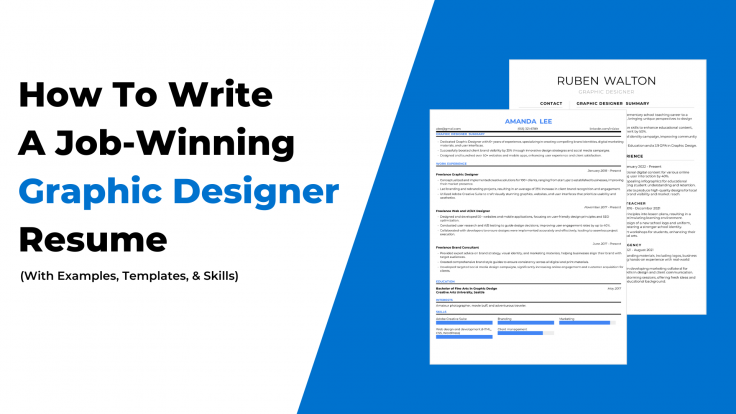
- LinkedIn 48
- Pinterest 0
Looking to score a job as a Graphic Designer?
You're going to need an awesome resume. This guide is your one-stop-shop for writing a job-winning Graphic Designer resume using our proven strategies, skills, templates, and examples.
All of the content in this guide is based on data from coaching thousands of job seekers (just like you!) who went on to land offers at the world's best companies.
If you want to maximize your chances of landing that Graphic Designer role, I recommend reading this piece from top to bottom. But if you're just looking for something specific, here's what's included in this guide:
- What To Know About Writing A Job-Winning Graphic Designer Resume
- The Best Skills To Include On A Graphic Designer Resume
How To Write A Job-Winning Graphic Designer Resume Summary
How to write offer-winning graphic designer resume bullets.
- 3 Graphic Designer Resume Examples
The 8 Best Graphic Designer Resume Templates
Here's the step-by-step breakdown:
Graphic Designer Resume Overview: What To Know To Write A Resume That Wins More Job Offers
What do companies look for when they're hiring a Graphic Designer?
Companies typically look for Graphic Designers with a combination of technical skills, creativity, and relevant experience. Technical skills include proficiency in design software such as Adobe Creative Suite — like Photoshop, Illustrator, and InDesign — Figma, Microsoft Suite, G-suite, and an understanding of design principles and techniques. Creativity, on the other hand, is a valued skill in developing unique and compelling designs that appeal to the company's audience.
Plus, relevant experience demonstrated through a portfolio of past work shows an ability to complete projects and tackle challenges in a professional setting.
Companies may also value communication skills and the ability to work well in a team, as designers often collaborate with other departments.
Your resume should show the company that your personality and your experience encompass all these things.
Additionally, there are a few best practices you want to follow to write a job-winning Graphic Designer resume:
- Craft your resume to the job description you are applying for: Tailor your resume for each application, aligning your skills with the specific requirements of each job description.
- Detail previous experiences: Provide detailed descriptions of your roles, emphasizing hard and soft skills related to the job description. Highlight your proficiency with software like Abobe Creative Suite, Microsoft Suite, G-suite, and Figma.
- Bring in your key achievements: Showcase measurable achievements in previous roles and share your best work.
- Highlight your skills: List relevant hard and soft skills, such as proficiency in design software tools, creativity, marketing, and communication.
- Make it visually appealing: You're a designer — so design! Use a professional and clean layout with bullet points for easy readability. Also, ensure formatting and font consistency throughout the resume and limit it to one or two pages.
- Use keywords: Incorporate industry-specific keywords from the job description to pass through applicant tracking systems (ATS) and increase your chances of being noticed by hiring managers.
- Proofread your resume: Thoroughly proofread your resume to eliminate errors (I recommend Hemingway App and Grammarly ). Consider seeking feedback from peers or mentors to ensure clarity and effectiveness!
Let's dive deeper into each of these so you have the exact blueprint you need to see success.
The Best Graphic Designer Skills To Include On Your Resume
Keywords are one of the most important factors in your resume. They show employers that your skills align with the role and they also help format your resume for Applicant Tracking Systems (ATS).
If you're not familiar with ATS systems, they are pieces of software used by employers to manage job applications. They scan resumes for keywords and qualifications and make it easier for employers to filter and search for candidates whose qualifications match the role.
If you want to win more interviews and job offers, you need to have a keyword-optimized resume. There are two ways to find the right keywords:
1. Leverage The 20 Best Graphic Designer Keywords
The first is to leverage our list of the best keywords and skills for a Graphic Designer resume.
These keywords were selected from an analysis of real Graphic Designer job descriptions sourced from actual job boards. Here they are:
- Communication
- Development
- Illustrators
- Organization
- Cross-Functional
- Time Management
- Consistency
- Social Media
- Presentations
2. Use ResyMatch.io To Find The Best Keywords That Are Specific To Your Resume And Target Role
The second method is the one I recommend because it's personalized to your specific resume and target job.
This process lets you find the exact keywords that your resume is missing when compared to the individual role you're applying for.

Here's how it works:
- Open a copy of your updated Graphic Designer resume
- Open a copy of your target Graphic Designer job description
- In the widget below, paste your resume on the left, paste the job description on the right, and hit scan!
ResyMatch is going to scan your resume and compare it to the target job description. It's going to show you the exact keywords and skills you're missing as well as share other feedback you can use to improve your resume.
If you're ready to get started, use the widget below to run your first scan and get your free resume score:

Copy/paste or upload your resume here:
Click here to paste text
Upload a PDF, Word Doc, or TXT File
Paste the job post's details here:
Scan to compare and score your resume vs the job's description.
Scanning...
And if you're a visual learner, here's a video walking through the entire process so you can follow along:
Employers spend an average of six seconds reading your resume.
If you want to win more interviews and offers, you need to make that time count. That starts with hitting the reader with the exact information they're looking for right at the top of your resume.
Unfortunately, traditional resume advice like Summaries and Objectives don't accomplish that goal. If you want to win in today's market, you need a modern approach. I like to use something I can a “Highlight Reel,” here's how it works.
Highlight Reels: A Proven Way To Start Your Resume And Win More Jobs
The Highlight Reel is exactly what it sounds like.
It's a section at the top of your resume that allows you to pick and choose the best and most relevant experience to feature right at the top of your resume.
It's essentially a highlight reel of your career as it relates to this specific role! I like to think about it as the SportsCenter Top 10 of your resume.
The Highlight Reel resume summary consists of 4 parts:
- A relevant section title that ties your experience to the role
- An introductory bullet that summarizes your experience and high-level value
- A few supporting “Case Study” bullets that illustrate specific results, projects, and relevant experience
- A closing “Extracurricular” bullet to round out your candidacy
For example, if we were writing a Highlight Reel for a Graphic Designer role, it might look like this:

You can see how the first bullet includes the Graphic Designer job title, the years of experience this candidate has, and it wraps up with a value-driven pitch for how they've helped companies in the past.
The next two bullets are “Case Studies” of specific results they drove at their company. The last bullet wraps up with extracurricular information, such as volunteer work and awards.
This candidate has provided all of the info any employer would want to see right at the very top of their resume! The best part is that they can customize this section for each and every role they apply for to maximize the relevance of their experience.
Here's one more example of a Graphic Designer Highlight Reel:
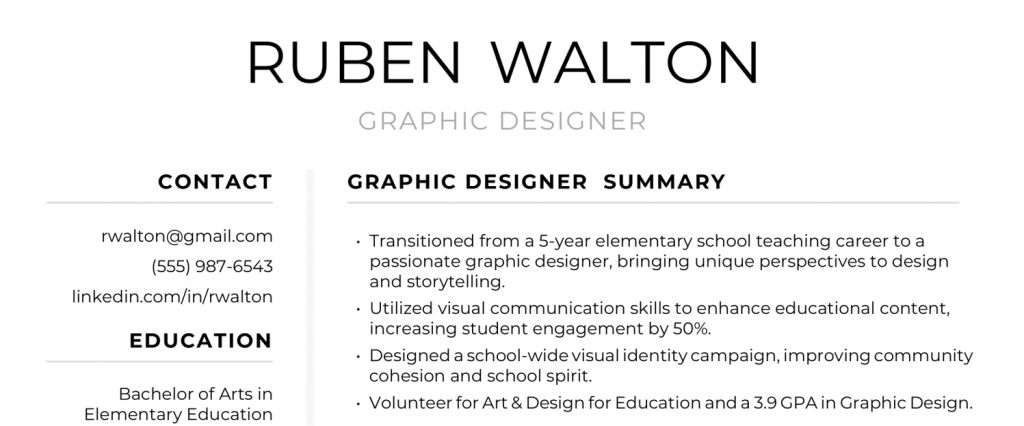
The content of this example showcases the candidate's years of experience and wraps up the first bullet with a high-value pitch, while the following bullet points focus on measurable results and relevant experience. Then, they highlight their focus on volunteer work and high GPA.
If you want more details on writing a killer Highlight Reel, check out my full guide on Highlight Reels here.
Bullets make up the majority of the content in your resume. If you want to win, you need to know how to write bullets that are compelling and value-driven.
Unfortunately, way too many job seekers aren't good at this. They use fluffy, buzzword-fill language and they only talk about the actions that they took rather than the results and outcomes those actions created.

If you apply this framework to each of the bullets on your resume, you're going to make them more compelling and your value is going to be crystal clear to the reader. For example, take a look at these resume bullets:
❌ Graphic Designer with 8+ years of experience
✅ Graphic Designer with 8+ years of proven experience, excelling in brand development and digital marketing strategies, boosting customer acquisition by 30% through effective collaboration
The second bullet makes the candidate's value so much more clear, and it's a lot more fun to read! That's what we're going for here.
That said, it's one thing to look at the graphic above and try to apply the abstract concept of “35% hard skills” to your bullet. We wanted to make things easy, so we created a tool called ResyBullet.io that will actually give your resume bullet a score and show you how to improve it.
Using ResyBullet To Write Crazy Effective, Job-Winning Resume Bullets
ResyBullet takes our proprietary “resume bullet formula” and layers it into a tool that's super simple to use. Here's how it works:
- Head over to ResyBullet.io
- Copy a bullet from your resume and paste it into the tool, then hit “Analyze”
- ResyBullet will score your resume bullet and show you exactly what you need to improve
- You edit your bullet with the recommended changes and scan it again
- Rinse and repeat until you get a score of 60+
- Move on to the next bullet in your resume
Let's take a look at how this works for the two resume bullet examples I shared above:
First, we had, “Graphic Designer with 8+ year of experience.”
ResyBullet gave that a score of 25/100. Not only is it too short, but it's missing relevant skills, compelling language, and measurable outcomes:

Now, let's take a look at our second bullet, “Graphic Designer with 8+ years of proven experience, excelling in brand development and digital marketing strategies, boosting customer acquisition by 30% through effective collaboration.”
ResyBullet gave that a 69 / 100. Much better! This bullet had more content focused on the experience in the Graphic Designer role, while also highlighting measurable results:

Now all you have to do is run each of your bullets through ResyBullet, make the suggested updates, and your resume is going to be jam-packed with eye-popping, value-driven content!
If you're ready, grab a bullet from your resume, paste it into the widget below, and hit scan to get your first resume bullet score and analysis:
Free Resume Bullet Analyzer
Learn to write crazy effective resume bullets that grab attention, illustrate value, and actually get results., copy and paste your resume bullet to begin analysis:, 3 graphic designer resume examples for 2024.
Now let's take a look at all of these best practices in action. Here are three resume examples for different situations from people with different backgrounds:
Graphic Designer Resume Example #1: A Traditional Background
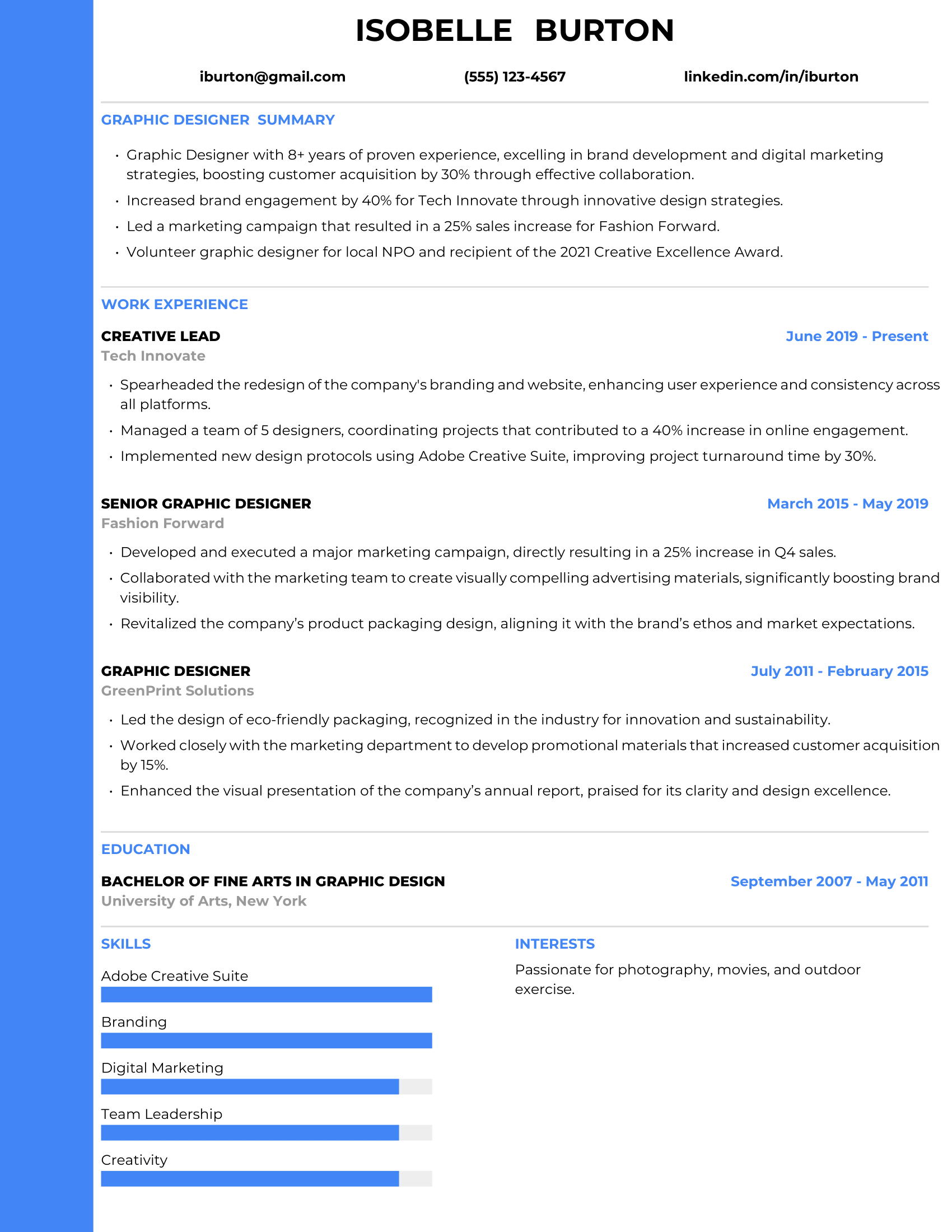
Graphic Designer Resume Example #2: A Non-Traditional Background
For our second Graphic Designer Resume Example, we have a candidate who has a non-traditional background. In this case, they are coming from a background as an elementery school teacher, but leverage experiences that can help them transition to a Graphic Design role. Here's an example of what their resume might look like:
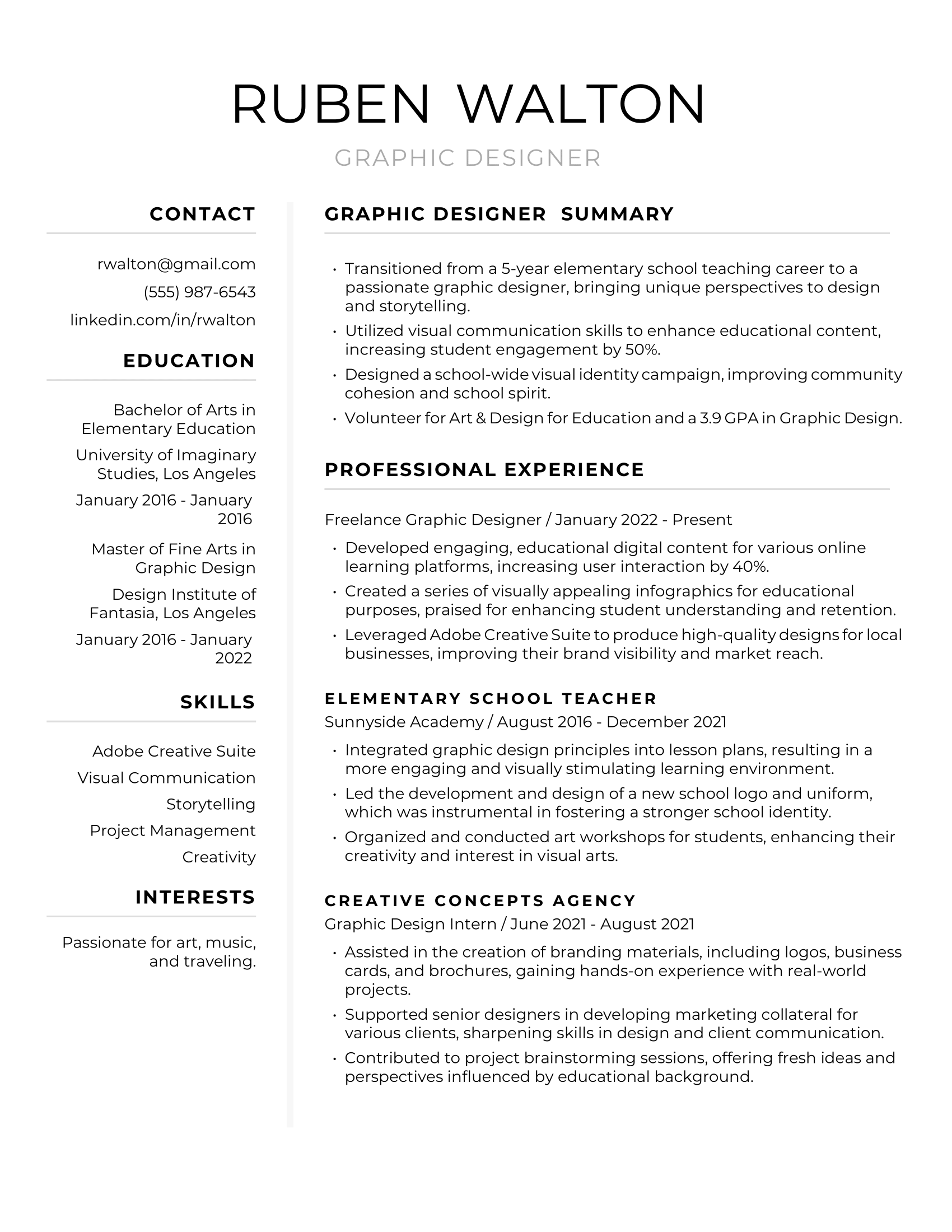
Graphic Designer Resume Example #3: Graphic Designer With Experience As A Freelancer
For our third Graphic Designer Resume Example, we have a candidate who has only worked as a freelancer. Here's an example of what their resume might look like when applying for Graphic Designer roles:
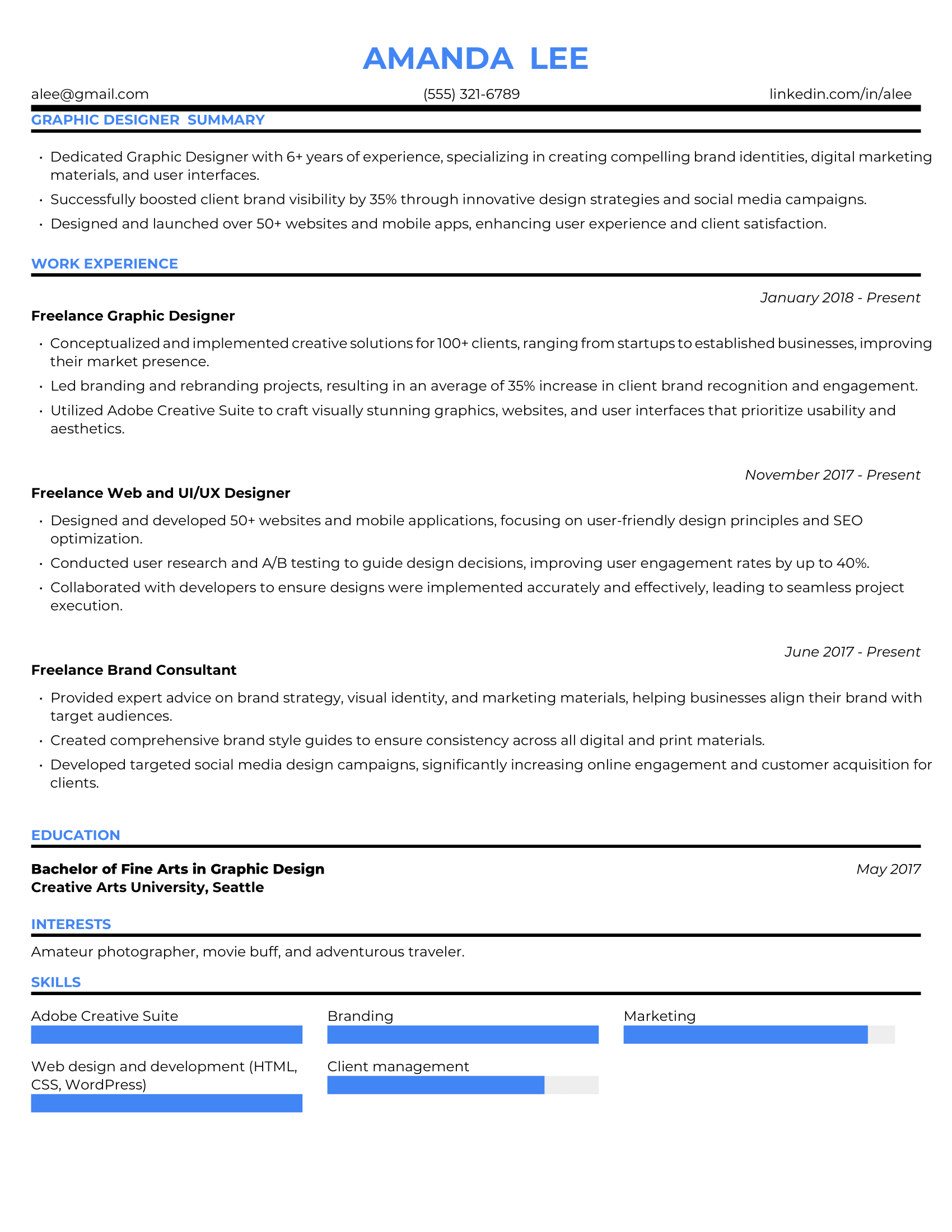
At this point, you know all of the basics you'll need to write a Graphic Designer resume that wins you more interviews and offers. The only thing left is to take all of that information and apply it to a template that's going to help you get results.
We made that easy with our ResyBuild tool . It has 8 proven templates that were created with the help of recruiters and hiring managers at the world's best companies. These templates also bake in thousands of data points we have from the job seekers in our audience who have used them to land job offers.
Just click any of the templates below to start building your resume using proven, recruiter-approved templates:

Free Job-Winning Resume Templates, Build Yours In No Time .
Choose a resume template below to get started:.
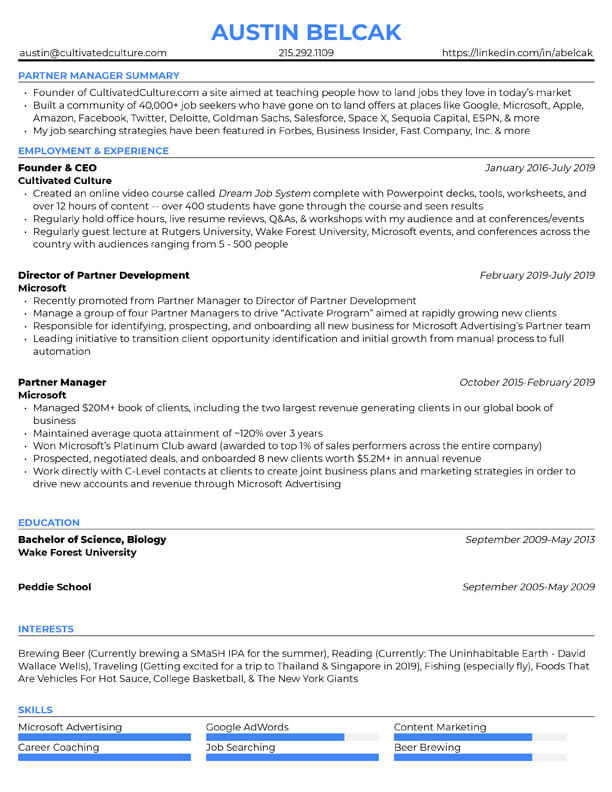
Key Takeaways To Wrap Up Your Job-Winning Graphic Designer Resume
You made it! We packed a lot of information into this post so I wanted to distill the key points for you and lay out next steps so you know exactly where to from here.
Here are the 5 steps for writing a job-winning Graphic Designer resume:
- Start with a proven resume template from ResyBuild.io
- Use ResyMatch.io to find the right keywords and optimize your resume for each role you apply to
- Open your resume with a Highlight Reel to immediately grab your target employer's attention
- Use ResyBullet.io to craft compelling, value-driven bullets that pop off the page
- Compare the draft of your resume to the examples on this page to make sure you're on the right path
- Use a tool like HemingwayApp or Grammarly to proofread your resume before you submit it
If you follow those steps, you're going to be well on your way to landing more Graphic Designer interviews and job offers.
Now that your resume is taken care of, check out my guide on how to get a job anywhere without applying online!

Paula Martins
Paula is Cultivated Culture's amazing Editor and Content Manager. Her background is in journalism and she's transitioned from roles in education, to tech, to finance, and more. She blends her journalism background with her job search experience to share advice aimed at helping people like you land jobs they love without applying online.
LEAVE A REPLY Cancel reply
You must be logged in to post a comment.
Most Popular Posts

YOU’VE SEEN AUSTIN IN

WHAT CAN I HELP WITH?

Welcome Back To Cultivated Culture!
Log into your Cultivated Culture account using one of the options below:
You have exceeded the maximum number of phone messages in a 24 hour period. We limit the number of times you can request security codes in order to protect your security. Please try again later or /contact">contact us for assistance with accessing your account.
Forgot your password? Click here to reset.
Need a free acount? Click Here To Sign Up
By logging in, you agree to Cultivated Culture's Terms of Use , Privacy Policy , and agree to receive email updates.
One Free Account, Four Job-Winning Tools
Sign up for a free Cultivated Culture account and get access to all of our job search tools:
Your Bullet Score is:
Sign up for a free Cultivated Culture account to get the full breakdown of your bullet along with suggestions for improving it:
Sign Up To Save & Export Your Resume
Sign up to create, save, and export your resume and get access to our suite of job search tools!
Sign Up To Get More Free Email Searches
Create a free account to unlock more email searches and get access to all four of our job-winning tools:
Your Headline Score is:
Sign up for a free Cultivated Culture account to get the full breakdown of your headline along with suggestions for improving it:
Already have an acount? Click Here To Log In
We Just Need You To Verify Your Email.
We just emailed you a 6-digit code. Please check your email and enter it below.
Note: Your progress will not be saved until your email is verified. Closing this pop up or window might cause you to lose your progress.
Invalid Code
Choose one of the options below to get the verification code we sent you!
We'll need you to verify your email address before you're able to unlock free scans.
We'll need you to verify your email address before you're able to unlock free templates, saves, and exports.
We'll need you to verify your email address before you're able to unlock free email searches.
We sent a verification code to your email, all you have to do is paste that code here and submit to get full access!
Looks Like You Still Need To Verify Your Email Address!
Whoops! Looks like you still haven't verified your email address. We'll need you to do that before granting free, unlimited access to our tools.
If you can't find the original verification email, click the link below and we'll send a new one:
Sent! Please check your email.
Oops you've hit your credit limit..
Looks like you've used all 10 of your free credits for the month. Your credit limit will refresh in days. You can learn more about your credit limit here.
Want to stop worrying about credits?
Sign up for our Unlimited plan to get instance unlimited access to all of our jon search tools for one low price. Click below to learn more:
Go Unlimited!
Change plan.
Upgrade your plan to get unlimited access to all 5 of our offer-winning job search tools and 200 email searches / week:
Go Unlimited (& Save 10%)!
Upgrade to get unlimited access to our resume tools, 200 email searches / week, and 10% off our regular pricing thanks to your friend :
Your Unlimited plan comes with...
Unlimited access to all 5 of our resume tools
200 Mailscoop searches per week
No obligations - cancel any time
By clicking "Upgrade My Plan," you agree to Cultivated Culture's Terms of Service and Privacy Policy
By clicking "Change Plan," you agree to Cultivated Culture's Terms of Service and Privacy Policy
Confirm Your Plan Change
Here is a summary of your plan change:
Current Plan:
Please note the following for plan changes:
Your new plan and rebill date will be effective immediately
The number above depict retail plan pricing, any adjustments or credits will be available in the Invoices section of your Billing tab
If you're moving to a lower cost plan, the difference will be credited to your account and applied towards your next payment
By clicking "Confirm Plan Change," you agree to Cultivated Culture's Terms of Service and Privacy Policy
Unlimited Plan Upgrade
Change payment method.
Promo code has been applied to your purchase!
Note: This is a monthly subscription, your card will be automatically charged every month until you cancel your plan.
Terms of Use | Privacy Policy
(C) 2024 Cultivated Culture
Note: You will not be charged for updating your credit card using this form. After your new card is added, you will be billed on the date of your next billing cycle.
Upgrade Complete!
You are officially a
Unlimited Member
Invoice Details
Paid Today:
Start Date:
Subscription:
Next Bill Date (Est.):
Note: This receipt and future invoices will be available in the Billing Tab of your Account Dashboard .
Do You Want To Secure Your Account?
Increase your account security with one of our multi-factor authentication options:
Choose An Authentication Method
Awesome! Let's make your account more secure.
Choose your preferred authentication method:
Text Message Authentication
Enter the phone number that you want to use to set up text-based authentication for your account:
Text Message Verification Code Sent!
Please check your phone for verification code and enter below:
Email Verification Code Sent!
Please check your email for verification code and enter below:
No problem, we'll skip this for now. Do you want us to remind you to secure your account?
It's great to have you. We just have a few questions so we can personalize your experience with our tools:
- I haven't applied to any jobs yet and I am not sure where to start
- I know what types of jobs I am looking for and I have started applying or I plan to start soon
- I have been applying to jobs for 3 months or longer, but haven't gotten the results I'd hoped for
- Get a job in the same industry I currently work in
- Switch careers and get a job in a new industry
- Get promoted at my current company
- Improve my resume
- Improve my cover letter
- Enhance my LinkedIn presence
- Find jobs that I am compatible with
- Skip to Content
- Skip to Sidebar
- Skip to Footer
Resume Genius
The World's Smartest Resume Builder
Monday to Friday, 8AM – 12AM (Midnight) and Saturdays and Sundays, 10AM – 6PM EDT (866) 215-9048
Resume Examples Graphic Design Resume
12 Graphic Design Resume Examples & Templates

Our graphic design resume examples and detailed writing guide will help you write a professional resume that stands out from the competition.
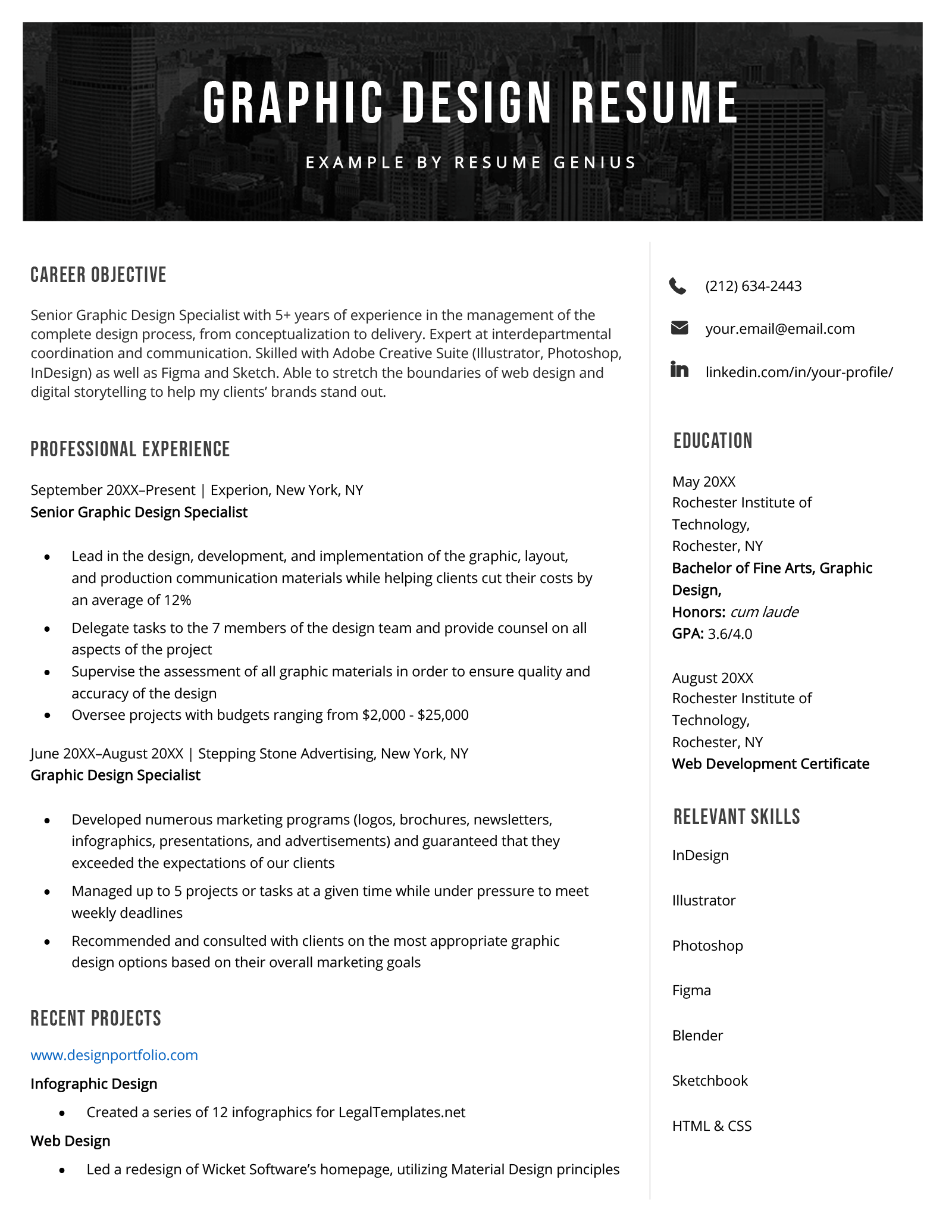
Graphic designer resume templates (text format)
Graphic design resume examples by specific role, average graphic designer salaries in the us, how to write a graphic design resume.
Copy-and-paste text format
FIRST AND LAST NAME
Email: [email protected]
Phone: (123) 456-7891
Address: Street, City, State
LinkedIn: linkedin.com/in/your-profile
Professional Profile
Graphic Design Specialist with 5+ years of experience in the management of the complete design process, from conceptualization to delivery. Expert at interdepartmental coordination and communication. Skilled with Adobe Creative Suite (Illustrator, Photoshop, InDesign) as well as Figma and Sketch. Able to stretch the boundaries of web design and digital storytelling to help my clients’ brands stand out.
Professional Experience
- Lead in the design, development, and implementation of the graphic, layout, and production communication materials while helping clients cut their costs by an average of 12%
- Delegate tasks to the 7 members of the design team and provide counsel on all aspects of the project
- Supervise the assessment of all graphic materials in order to ensure quality and accuracy of the design
- Oversee the efficient use of production project budgets ranging from $2,000 – $25,000
- Developed numerous marketing programs (logos, brochures, newsletters, infographics, presentations, and advertisements) and guaranteed that they exceeded the expectations of our clients
- Managed up to 5 projects or tasks at a given time while under pressure to meet weekly deadlines
- Recommended and consulted with clients on the most appropriate graphic design options based on their overall marketing goals
- Illustrator
- HTML and CSS
Here are some more resume examples to help you get started when writing your graphic design resume:
Entry-level graphic design resume
Check out our entry-level graphic design resume to use as a reference when writing your resume.
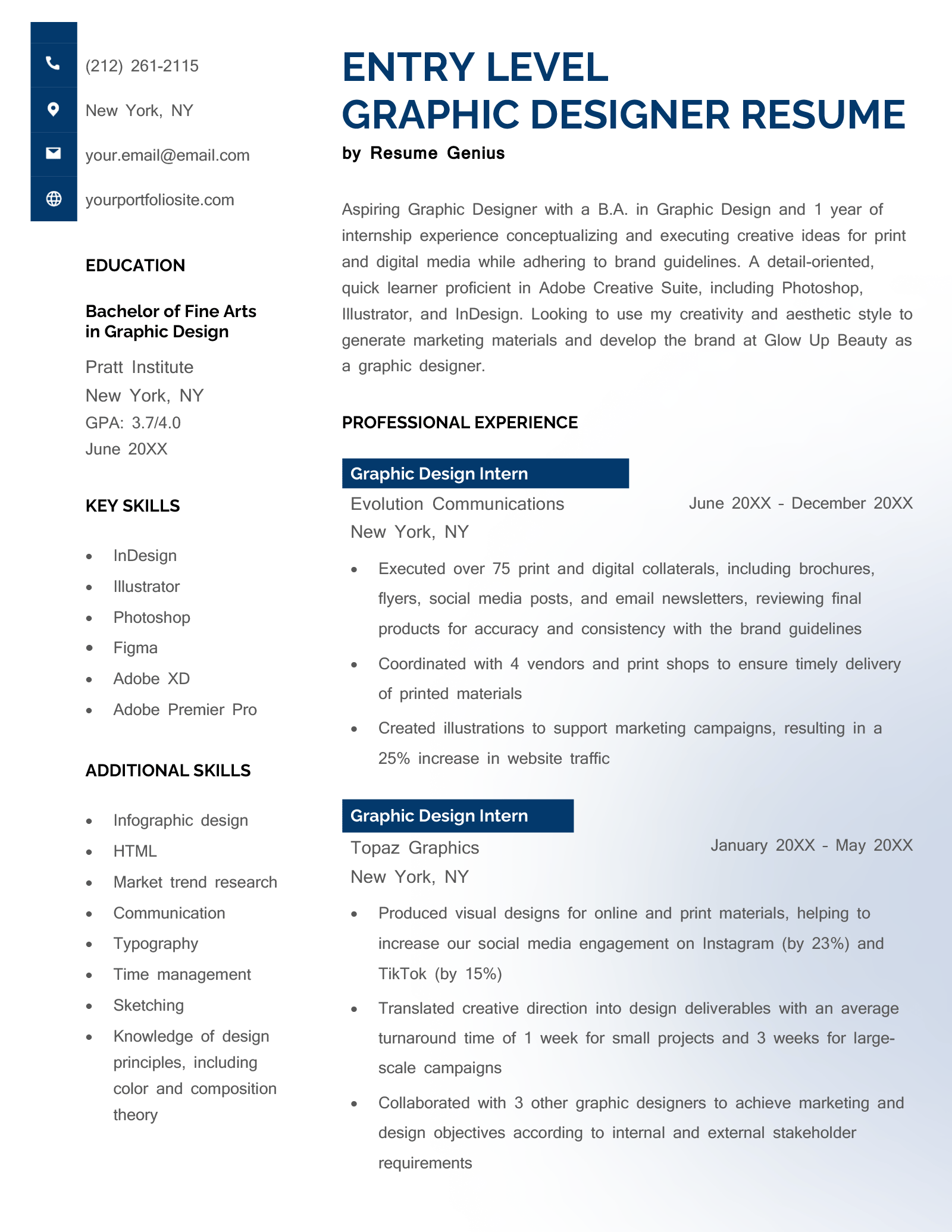
Why this example works
- Strong introduction: The candidate mentions key graphic design skills in the introduction so that employers can quickly get a sense of their qualifications.
- Subtle graphics: The background graphic element adds visual appeal without taking away from the content of the resume.
Web designer resume
A good web designer resume should showcase your proficiency with web design software, as well as basic visual coding languages like HTML, CSS, and Javascript:
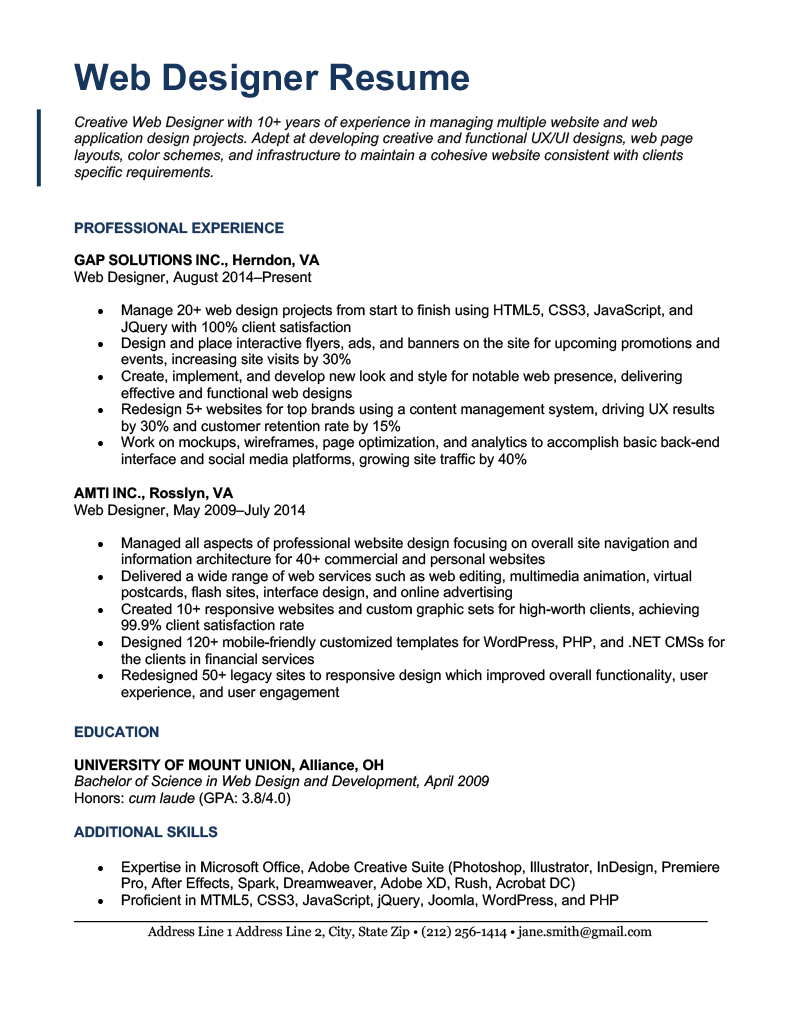
- Includes hard numbers: The candidate quantifies the achievements on their resume to provide employers with a sense of the scope of their contributions to previous workplaces.
UX designer resume
Use our UX designer resume sample as a guide when writing your own resume:
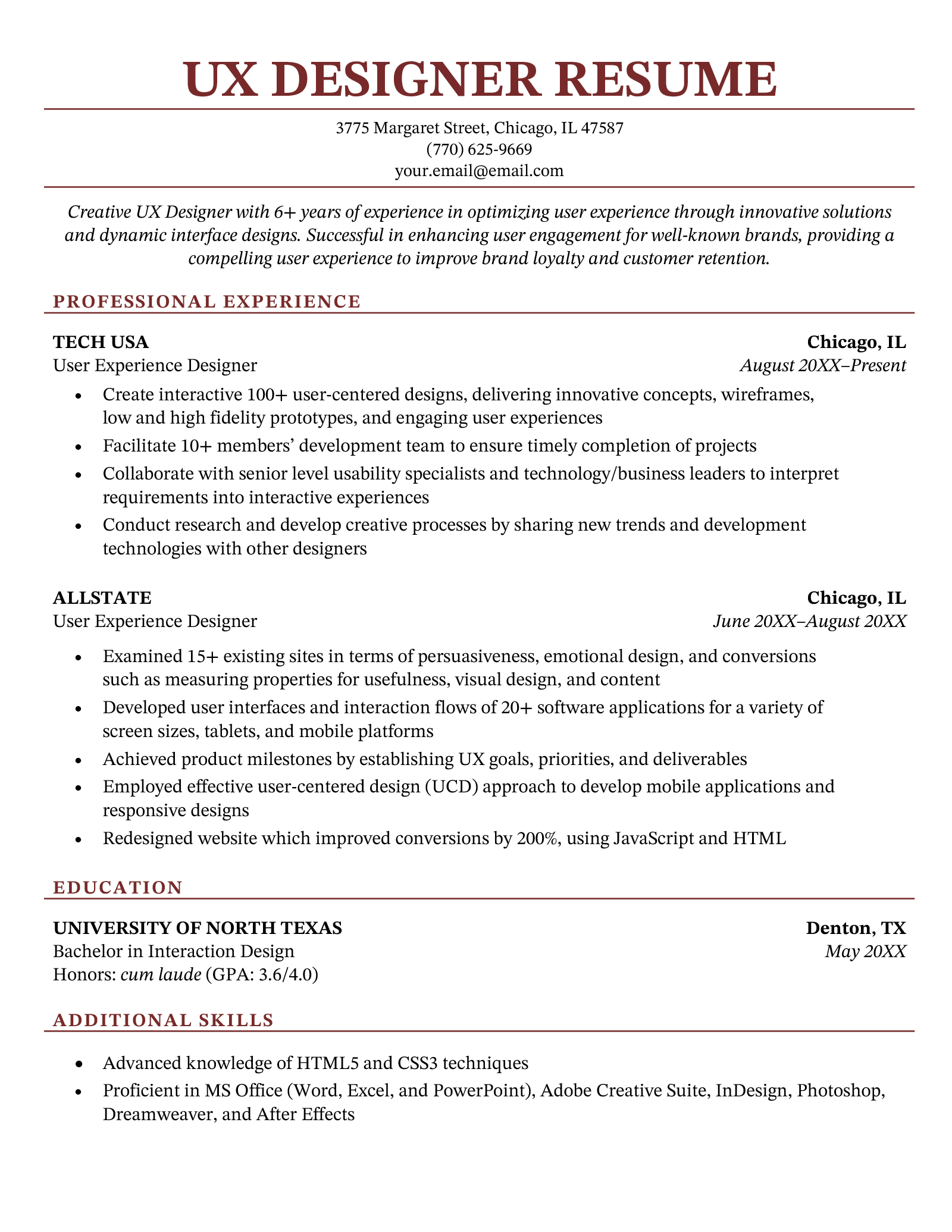
- Strong action verbs: Each work experience bullet point starts with a strong action verb that makes the resume more engaging to read.
Freelance graphic designer resume
As a freelance graphic designer, you are a creative entrepreneur, combining your artistic talents with business acumen to deliver exceptional visual solutions to clients.
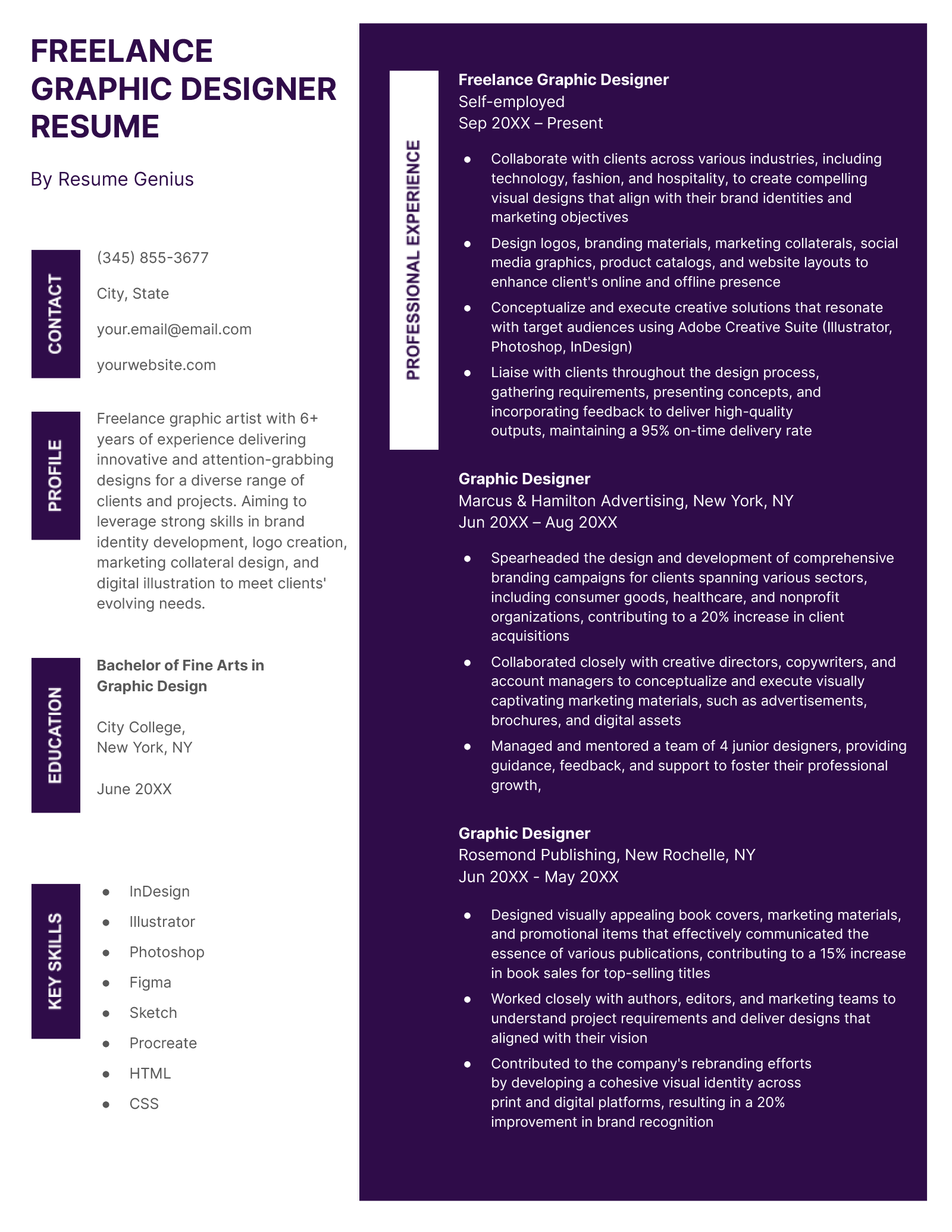
- Eye-catching design: The color blocking stands out and is sure to grab the reader’s attention
- Emphasis on work experience: The eye is immediately drawn to the work experience section, and there’s plenty of room for the candidate to elaborate on their achievements
- Technical skills: The candidate highlights their technical skills in both the skills and work experience sections
Graphic design student resume
As a graphic design student, your resume serves as a crucial tool to showcase your talents, skills, and creative potential to prospective employers.
While you may have limited professional experience, your resume should highlight your relevant coursework, design projects, or freelance work you’ve undertaken.
Here’s an example:
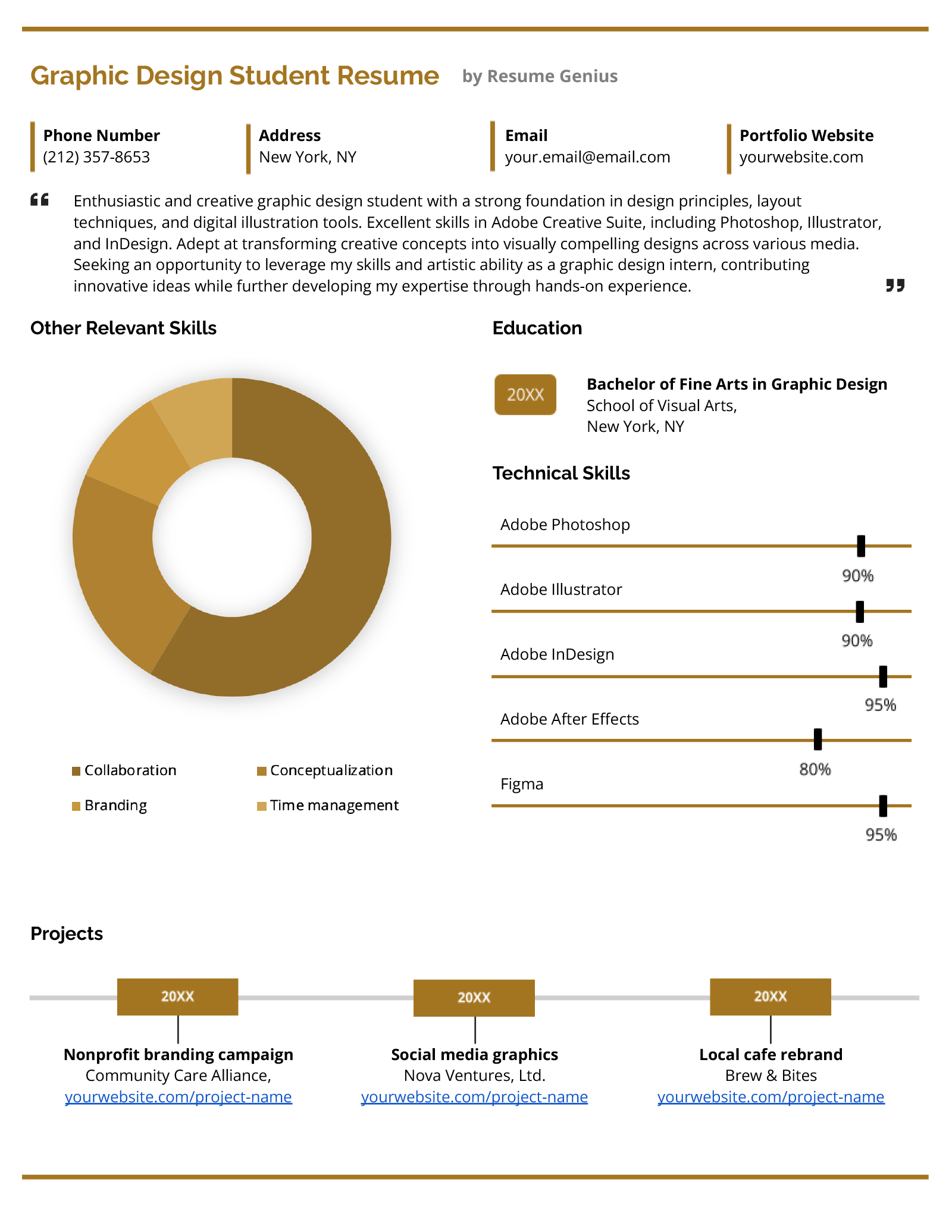
- Complements the portfolio: While this template doesn’t replace a traditional resume, it highlights specific projects and makes a nice addition to a portfolio website
- Highlights skills: Students have limited work experience, so it’s important to emphasize skills
- Attention-grabbing graphics: The graphic elements add a visual flair while showcasing key skills
Graphic design intern resume
Whether you’re a graphic design student or a recent graduate seeking an internship, your resume should showcase your relevant coursework, projects, and any experience you may have, even if it’s limited:
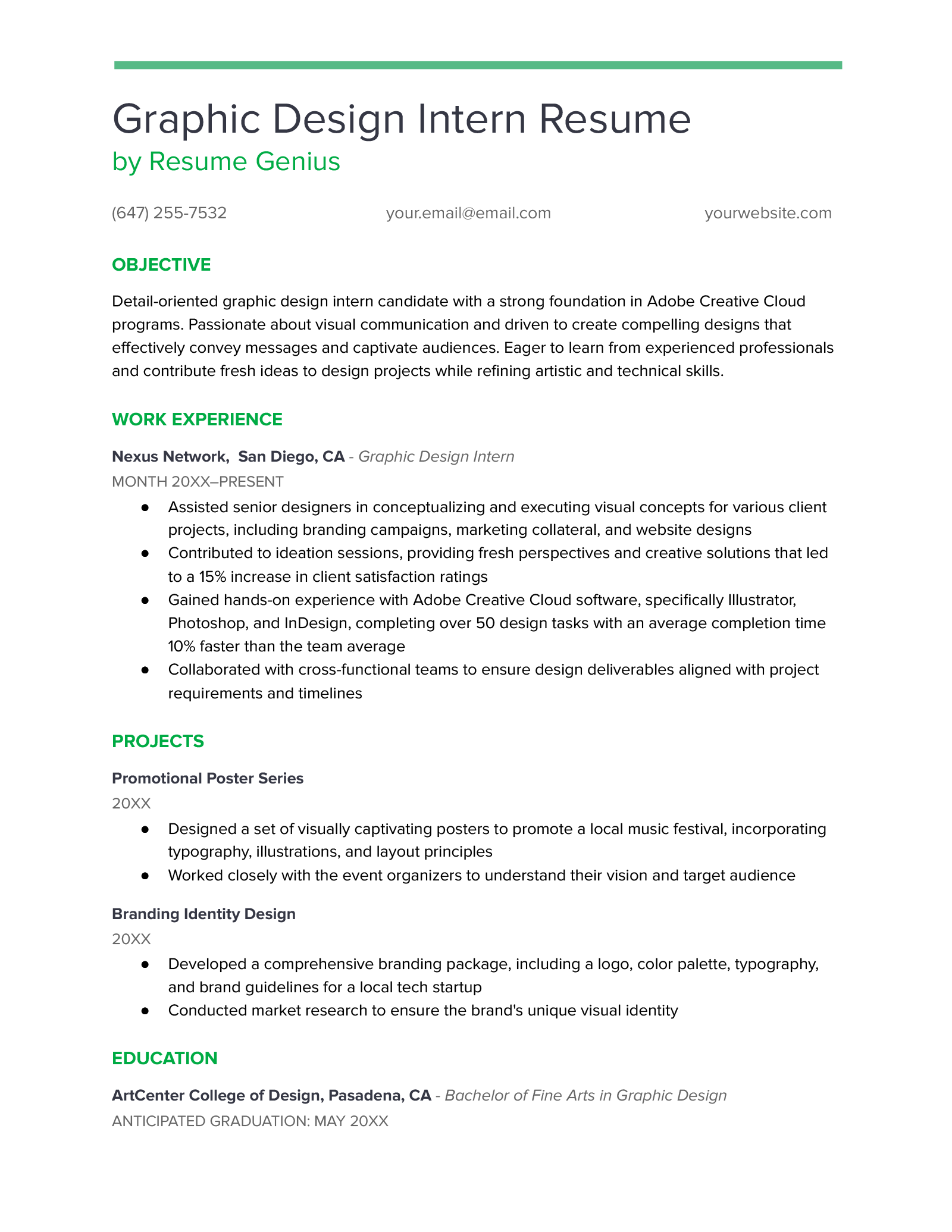
- Clean layout: The simple layout makes sure the focus is on the candidate’s experience
- Strong resume objective: The introduction outlines the candidate’s key skills and eagerness to succeed in their next role
- Emphasis on projects: The candidate has limited work experience, so elaborating on past projects helps showcase their skills
Brand designer resume
In the competitive world of marketing, a well-crafted resume is essential for demonstrating your expertise:
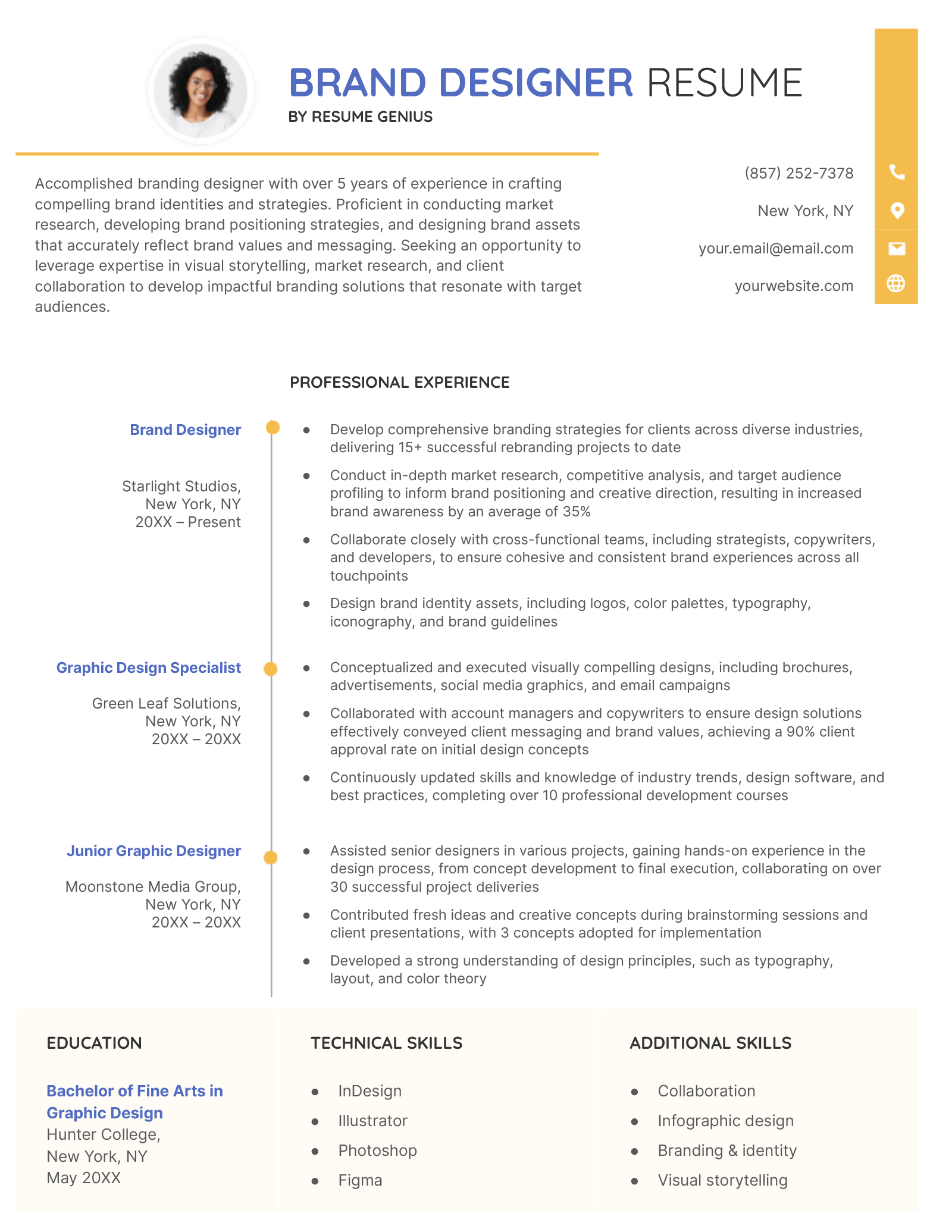
- Striking design: The unconventional layout and pops of color make the resume stand out without being distracting
- Graphic elements: The timeline graphic draws the eye to the work experience section
- In-depth work experience: The candidate explains their past achievements in great detail and uses quantifiable metrics where possible
Motion graphic designer resume
A motion graphic designer’s resume needs to capture the essence of their creativity, technical expertise, and ability to bring stories and ideas to life through captivating animations and motion graphics, like this example:
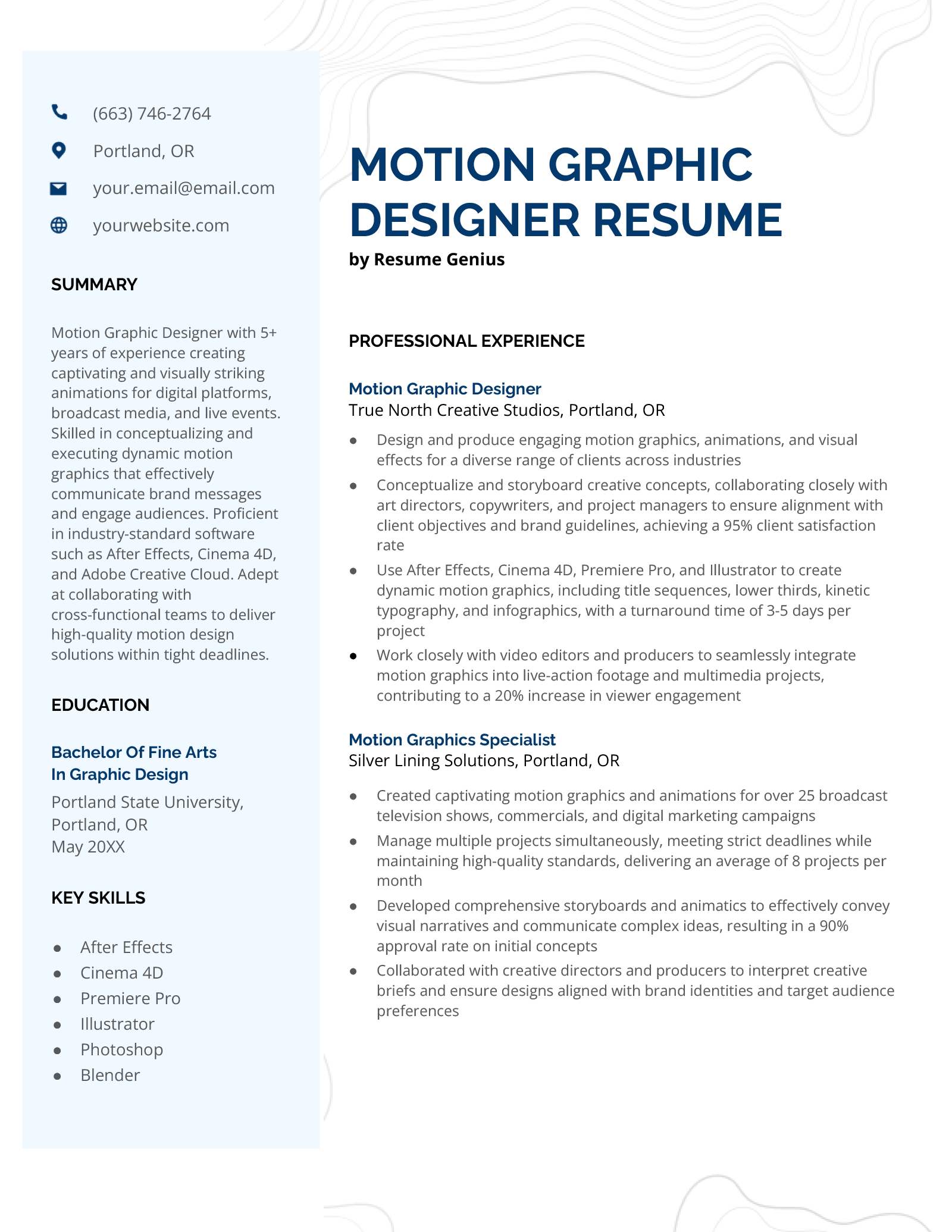
- Crisp design: There is a clean layout and graphic elements that add visual interest without being distracting
- Quantifiable metrics: The candidate backs up their achievements with numbers
- Strong summary: The resume summary mentions key skills and achievements
Visual designer resume
A compelling visual designer resume is essential for showcasing your talent in creating aesthetically pleasing and user-friendly designs:
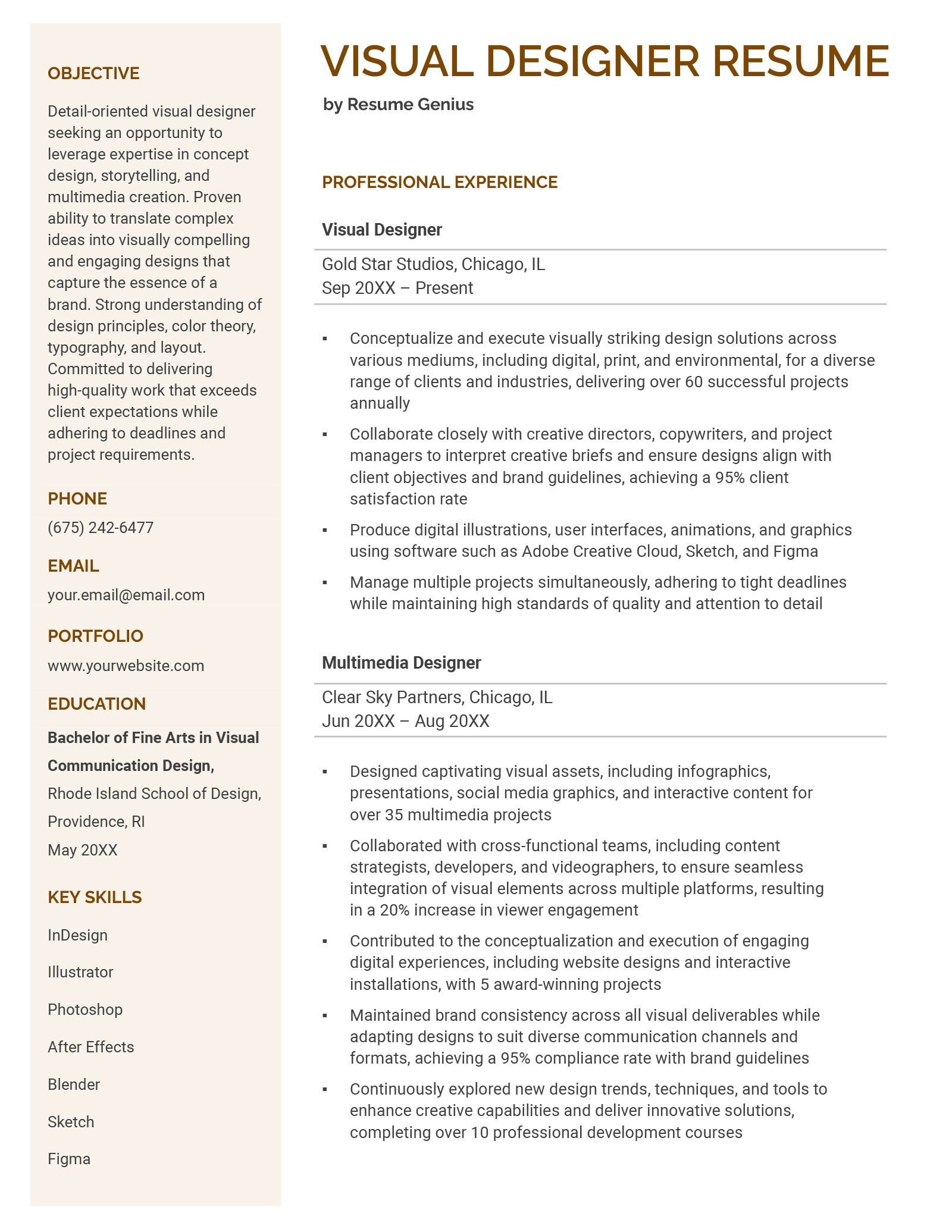
- Clean layout: The two-column format allows both skills and work experience to stand out
- Detailed work experience: The candidate provides a lot of context around their professional achievements
- Highlights skills throughout: The candidate not only lists their technical skills in the skills section, but also mentions them in context when detailing their work experience
Logo designer resume
Creating a memorable and impactful logo is a true test of a designer’s ability to capture the essence of a brand. Learn how to showcase your skills and expertise in this highly specialized field with our logo designer resume example:
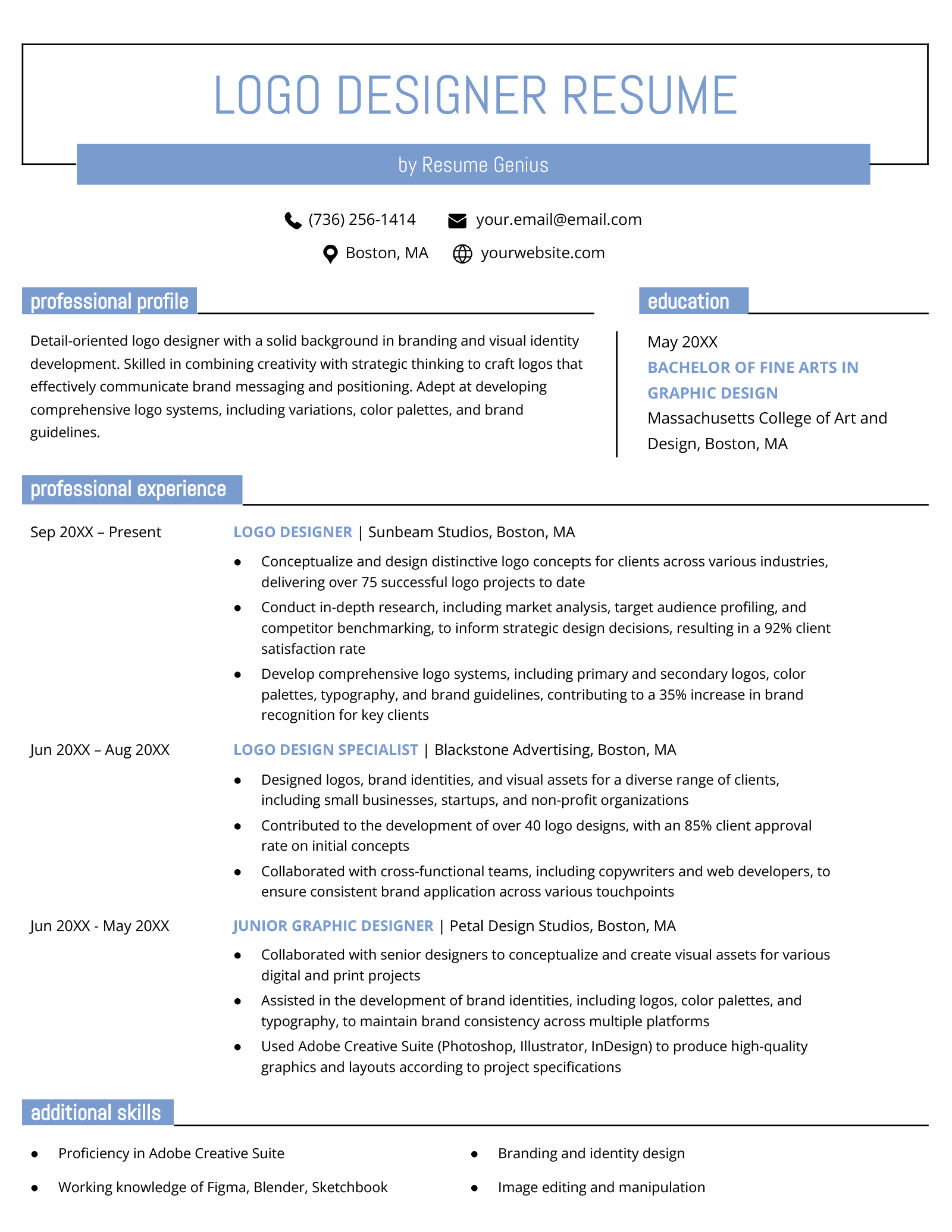
- Starts with a compelling introduction: The candidate’s introduction is concise yet memorable
- Mentions quantifiable achievements: The candidate provides metrics to show how they contributed in previous roles
- Lists relevant skills: The candidate includes the skills most relevant to their specialization
Creative graphic designer resume
Graphic designers need to be able to think outside the box and craft impactful designs that resonate with audiences. Show off your artistic flair with our creative graphic designer resume example:
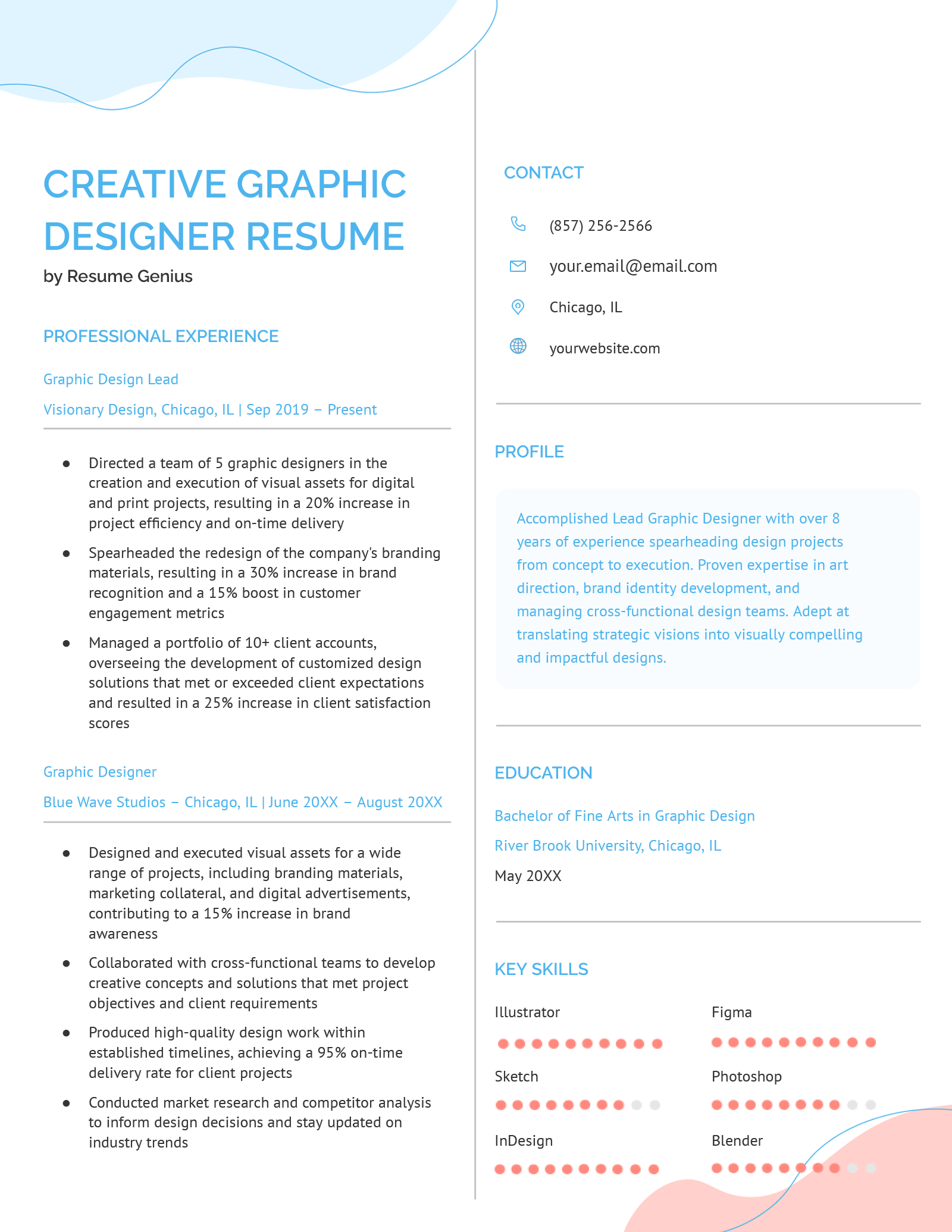
- Creative design: The graphic elements add pops of color without detracting from the resume’s content
- Two-column layout: This format emphasizes both the skills and work experience sections
- Emphasis on technical skills: The candidate highlights their proficiency with different graphic design software programs
Professional graphic designer resume
If you work in a more formal industry, our professional graphic designer resume example will show you how to highlight your expertise in a no-frills way.
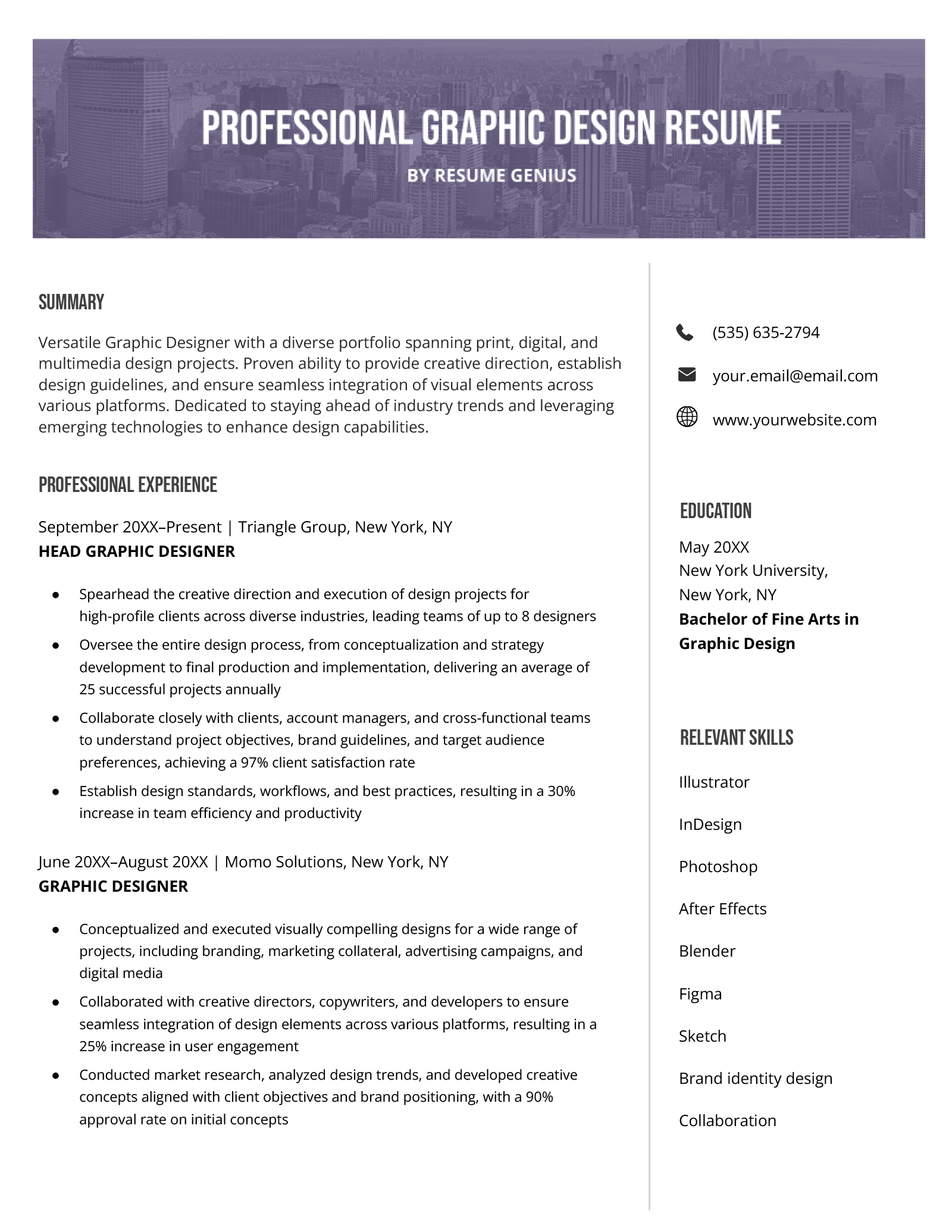
- Clean layout: The understated layout is perfect for more formal industries
- Stand-out summary: The candidate introduces themself in a concise yet impactful way
- Demonstrates experience: The work experience section includes key achievements backed up by numbers
| State | Salary |
|---|---|
| California | $74,360 |
| Texas | $53,100 |
| New York | $74,410 |
| Florida | $53,970 |
| Pennsylvania | $52,000 |
| Illinois | $57,090 |
| Ohio | $50,470 |
| Georgia | $56,460 |
| North Carolina | $53,710 |
| Michigan | $51,110 |
| National Average | $54,331 |
As a graphic designer, you probably already know how to choose an eye-catching design for your resume , but here we’ll show you how to make a resume that impresses potential employers.
Start your resume with a strong introduction
If you’re just starting out, try writing a resume objective to outline your key skills and career goals. Here are some examples:
Graphic design student resume objective
Motivated and creative graphic design graduate seeking an entry-level position to apply my skills in typography, layout design, and Adobe Creative Suite while continuing to learn and grow as a designer. With a strong foundation in design principles and a passion for visual storytelling, I am eager to contribute fresh ideas and collaborate with experienced professionals. My versatility and ability to adapt to new challenges make me a valuable asset to any design team.
Graphic design intern resume summary
Passionate graphic design intern looking for an opportunity to showcase my design abilities and keen eye for detail in an environment that values creativity and innovation. Proficient in Adobe Creative Cloud, Figma, and Sketch. Eager to contribute fresh ideas and learn from experienced professionals.
Entry-level graphic designer resume objective
Aspiring graphic designer with a passion for visual storytelling and deep appreciation for design principles. Proficient in designing typography, branding, and advertising campaigns. Eager to join a team of professionals and contribute fresh ideas while expanding knowledge and experience.
If you already have a decent amount of work experience, start with a resume summary that provides a concise overview of your relevant experience, achievements, and skills. For example:
Mid-level graphic designer resume summary
Highly creative and versatile Graphic Designer with 5+ years of experience in developing innovative designs and marketing materials across print and digital platforms. Proficient in Adobe Creative Suite, skilled in branding, typography, and layout design. Adept at collaborating with teams to deliver visually impactful solutions aligned with client objectives.
Senior graphic designer resume summary
Award-winning Senior Graphic Designer with over 7 years of experience in developing cutting-edge designs for renowned brands. Proven ability to translate complex concepts into visually striking and meaningful designs. Exceptional skills in typography, color theory, and layout design. Passionate about staying up-to-date on the latest design trends and software.
Describe your work experience in detail
You might think that potential employers are just going to look at your portfolio to learn about your past work, but don’t neglect your work experience section .
Make sure to provide further context about what you did in past roles and back up your achievements with numbers wherever possible.
Here are some areas where your impact as a graphic designer can be measured:
- User engagement
- Conversions
- A/B test results
- Customer reviews and comments
- Social media activity
Here’s an example of how you can use metrics in the experience section of your resume:
Work experience section with quantified achievements
Graphic Designer Brightstar, New York, NY June 20XX – January 20XX
- Designed new website layouts, graphics, and user experience that increased customer engagement by 27% based on heatmap analysis and time on site metrics
- Created branded graphics and visuals for marketing campaigns that generated over 500 new 5-star customer reviews praising the modern, appealing designs
- Revamped UI/UX for mobile app that led to a 15% improvement in customer retention rates according to cohort analysis
- Conducted A/B tests on multiple homepage design variations resulting in a 9% uplift in clickthrough rates for the winning design
- Collaborated with marketing team on graphics for social media campaigns that boosted follower growth by 34% year-over-year
What to do if you don’t have work experience
If you’re writing a resume for your first job as a graphic designer, focus on the skills and qualifications you do have. Instead of a traditional work experience section, you can include information about independent design projects, university projects, or freelance work that you’ve done.
For example:
Projects section of a graphic design resume
Projects Brand Identity Project Brand Identity Design, University of Georgia
- Developed a comprehensive brand identity system including logo, color palette, typography, and brand guidelines for a new fitness apparel startup
- Conducted market research and presented brand rationale to a panel of professors and peers
- Brand identity package was selected for the Annual Student Design Exhibition
Social Media Campaign Visual Content Creation for Social Media Marketing, University of Georgia
- Created digital graphics, animations, and video content for an awareness campaign promoting sustainability on campus
- Campaign visuals were used across Instagram, Facebook, and other university social channels
- Campaign reached over 10,000 students and received 500+ likes/shares
Magazine Layout Redesign Typography Fundamentals, University of Georgia
- Analyzed an existing magazine’s design, layout, and readability pain points
- Redesigned the magazine’s interior layout, cover design, and typography system using Adobe InDesign to improve readability and visual appeal
- Implemented user feedback and iterative design processes to refine the layout and improve overall effectiveness
Feature your portfolio prominently
Ultimately, the most important thing an employer considers when hiring a graphic designer is the quality of their work.
It’s great to be able to describe your past work in your work experience section, but potential employers are going to want to see it for themselves. That’s why it’s essential to provide a link to your portfolio on your resume.
You can either put it in its own section, like this:
Example of a portfolio section for a graphic design resume
PORTFOLIO www.sarapearsondesigns.com
Example of a portfolio link in a resume’s header
Bernice Doggett Lead Graphic Designer (435) 283-1405 [email protected] www.bernicedoggett.com
If you’ve included a Projects section, you can add links to the projects you want to show off the most, like this:
Projects section of a graphic design resume with portfolio links
Projects Branding & Logo Design | Jan 20XX – Mar 20XX Greentree Charity, Seattle, WA www.jacklarsondesigns.com/greentree
- Rebranded company’s visual identity including new logo, color palette, typography, and brand guidelines
- Collaborated with marketing team to develop branding strategy aligned with company’s vision
- Designed brand assets for digital and print marketing materials
Branding Revamp | Aug 20XX – Dec 20XX Bean & Leaf Cafe, Seattle, WA www.jacklarsondesigns.com/beanandleaf
- Developed a new brand identity, including logo design, color palette, typography, and visual elements, to reflect the coffee shop’s unique personality and appeal to the target demographic
- Created branded materials such as menus, signage, packaging, and promotional materials to maintain consistency
- Implemented the new brand identity across physical and digital platforms, including the coffee shop’s interior decor, website, social media profiles, and marketing campaigns
Fill in your education section
Though employers will ultimately place the most weight on your portfolio and work experience, it’s still important to fill in your resume’s education section correctly.
You should start with your highest level of education achieved, and include the following for each degree you have:
- Name and location of the school
- Degree name/major (and minor, if applicable)
- Graduation date (or anticipated graduation date)
Example education section for a graphic design resume
Education Bachelor of Fine Arts in Graphic Design New York University, New York, NY May 20XX
If you’re a recent graduate, you can also include relevant coursework on your resume, like this:
Example education section for a graphic design resume with relevant coursework
Education Bachelor of Arts in Graphic Design California College of the Arts, San Francisco, CA June 20XX
Relevant Coursework:
- Typography and Layout Design
- Branding and Identity Design
- Digital Illustration Techniques
- Web Design Fundamentals
- Print Production and Design
- Motion Graphics and Animation
Highlight your graphic design skills
Employers need designers who are experienced with the latest design software and have a well-developed set of skills. Make sure you showcase your technical abilities in the skills section of your resume .
Whether you’re a freelancer or looking for an in-house job, here are some of the top graphic design skills that employers are looking for:
- Adobe InDesign
- Adobe Photoshop
- Adobe Illustrator
- Adobe After Effects
- Adobe Dreamweaver
- Branding and identity design
- Logo designcreation
- Infographic design
- Photo editing
- UI/UX design
- Motion graphic design
- Digital illustration
- Print design
- Packaging design
- Color theory
Additionally, make sure to write a great graphic design cover letter to complete your application.
Build your resume in minutes
Use an AI-powered resume builder and have your resume done in 10 minutes. Just select your template and our software will guide you through the process.
Make a resume in minutes
Pick your template, fill in a few details, and our builder will do the rest.
4+ Graphic Design Resume Examples & Templates
Click to rate this article
4.6 Average rating

Lauren Mastroni
Related Articles
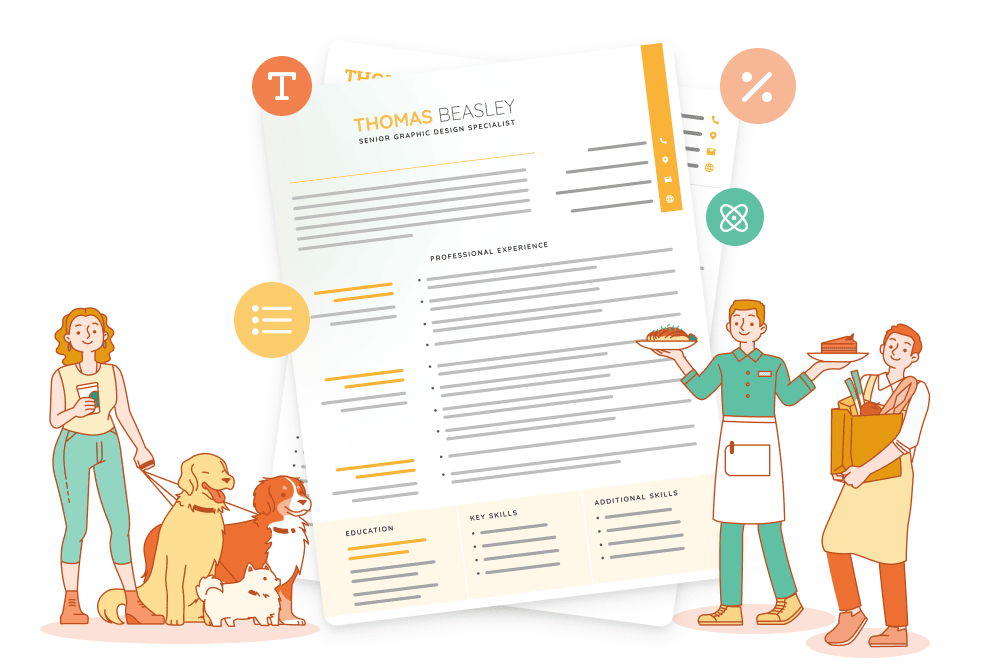
Resume Help

Conrad Benz, Hiring Manager
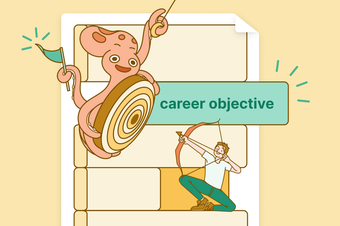
Emily Crowley
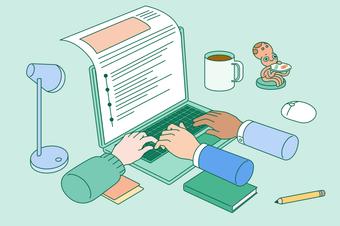
Ida Pettersson

Corissa Peterson, CPRW
Thanks for downloading our free template!
Would you leave us a review?
We hope we’ve helped you on your path to career success. If you have time, a quick review would really make our day (it'll only take 15 seconds). Thanks again, and good luck!
- Resume Templates Simple Professional Modern Creative View all
- Resume Examples Nurse Student Internship Teacher Accountant View all
- Resume Builder
- Cover Letter Templates Simple Professional Modern Creative View all
- Cover Letter Examples Nursing Administrative Assistant Internship Graduate Teacher View all
- Cover Letter Builder
- Resume Examples
- Graphic Designer
Graphic Designer resume example & writing guide

How to beat the ATS bots
What if i have no experience.
Graphic designers possess what is known as “visual intelligence” — the smarts to produce compelling information design and illustration, presented in an eye-catching way. If you’re a graphic designer, these skills will come in handy in producing what may be your most important work of art — the resume that lands you your dream job.
Here at Resume.io, we have everything you need to create the professional future of your dreams. We have a library of 350+ resume examples to help you perfect the art of writing your next application. Within this writing guide and, the accompanying resume example, we will explore the following topics.
What do graphic designers do?
Salary and job outlook for graphic designers, how to write a graphic designer resume.
- Advice on the resume summary, work history, education and skills sections
- Choosing the best resume format for a graphic designer.
Graphic designers are artists, illustrators, visual geniuses — people who can draw a portrait, create a logo, produce a map, or break down a blizzard of information in an easy-to-read chart. They may be fine artists, pop artists, commercial artists or all three.
And they don’t just do artwork. Good graphic designers are skilled in typography, layout, photo editing and all other aspects that affect the look and feel of the final product, whether it’s a book cover, a magazine spread, a website design, a business card or the front of a box of cereal.
Graphic artists are skilled at every step of the creative process, from concept and visualization to design and execution. They may also have to meet with clients and managers , come to an intuitive understanding of their wants and needs, negotiate the production process, and navigate the hazardous shoals of “design by committee” in which too many cooks may spoil the soup.
The median annual salary for graphic designers in the United States was $50,710 in May 2021, according to the Bureau of Labor Statistics . That means half earned less and half earned more. Of course, many graphic designers work on an hourly rate instead. The average pay per hour for this job is currently set at $24.38.
How much do graphic designers make?
Median annual wages for U.S. graphic designers in the top industries that employed them in 2021:
- Specialized design services - $58,610
- Advertising, public relations, and related services - $52,050
- Newspaper, periodical, book, and directory publishers - $44,540
- Printing and related support activities - $39,090
The job outlook for graphic designers in the decade ahead is not so promising. The BLS projects a loss in jobs for graphic designers of 3% from 2021 through 2031 — which is lower than average.
Why isn't the sector growing faster? Well, for starters, do you subscribe to daily newspapers and monthly magazines like your parents did, or spend a lot of time browsing in your neighborhood book store, if there’s even one left? Most people nowadays don’t. The digital revolution has had a devastating effect on print media, which previously employed lots of graphic designers to make its products look great.
The upside is that positive growth is projected for graphic designers specializing in online and multimedia design — because all those apps and websites the world has migrated toward don’t just design themselves.
Graphic design remains a popular field for job candidates to pursue, but facing a dwindling number of total jobs, those with 21st-century skills are most likely to prevail. And, we hasten to add — those with superior resumes.
A graphic designer resume should be a one-page document that consists of just five essential components. Your professional CV needs to include:
- The resume header
- The resume summary (aka profile or personal statement)
- The employment history section
- The resume skills section
- The education section
Writing is not always graphic designers’ strongest suit, or else they might have become writers instead of artists. But if you’re in this category, never fear — you’ve got ONE PAGE to write, and none of it has to be in complete sentences.
This one page can, and usually should, be supplemented by an online portfolio of your published work, and employers will often speed-read your resume anyway, when what they really want to see is your artwork.
The header is an attractively designed section at the top of the resume (and sometimes along the sides) that contains your name, occupation, address, phone number and email. In the old days, these were known as letterheads, and companies used to buy reams of fine paper that were blank except for this informative element at the top. Then the office secretary would roll them into their Selectric typewriters and “take a letter.”
Some things don’t change. You still need a nice-looking section at the top of your page that provides your critical contact info. Here you may be totally in your element, working with creative typography, a nice layout, an appropriate use of white space, a little color, maybe some icons. You may or may not choose to include a photo of yourself.
Choosing the best resume format for a graphic designer
Most of the time, you should use a reverse chronological format for your graphic designer resume. That means that you start with your most recent experience and certificates at the top of the page and work your way back in time as you move down.
However, there are exceptions to every rule. If you have worked as a freelance graphic designer, for example, or you're new to the career, a functional resume format may be better. This structure emphasizes your skill set and talents over the positions you've held.
Resume.io divides its resume templates into styles called Simple, Creative, Professional and Modern. As a graphic designer, you might want to lean toward the creative templates , which have just a bit more visual pizzazz. But even if you design your resume yourself, you need to think carefully about its format and design. You are, after all, a designer, so the look of your resume should actually demonstrate to potential employers that you’re good at what you do.
If you find a design here you like, simply click on it, and our easy-to-use builder tool will walk you through the steps of turning this into a resume that’s ready to send.
Looking for some creative inspiration? Check out our other resume samples:
- Art Director resume example
- Motion Graphics Artist resume sample
- Visual Artist resume sample
- Creative Director resume sample
Resume summary example example
A resume is mostly a collection of lists — lists of jobs, schools, and skills — but the resume profile, sometimes called a summary, is one exception. It consists of a few lines of text under your header that describes your “superpowers” in your own words.
It doesn’t need to contain the word “I,” and it doesn’t need to be written in complete sentences. If you start with “Wildly creative graphic designer with vast experience in editorial and commercial illustration and layout,” the employer will know who you’re talking about.
This section is sometimes called a “job objective” if it identifies the type of job you’re looking for. But it may be obvious from your experience and skills that you’re looking for the same kind of job you’re already good at.
Put a lot of thought into your graphic designer resume profile. Use imaginative, evocative language, never flabby or dull. This profile is your best opportunity to describe yourself on your own terms, so squander it at your peril.
You never want to sound arrogant or egotistical, like you’re God’s gift to graphic design, but you do want to sound like a standout candidate. Pump yourself up a bit without going overboard.
Here’s an example of a decent profile/summary for a graphic designer:
Experienced Graphic Designer adept in creating powerful visual designs using digital illustrations, images, and typography. Committed to helping clients shape their brand identity through the use of compelling graphic designs. Accustomed to collaborating with creative professionals to achieve goals.
Many large employers use Applicant Tracking Systems (ATS), which are computer programs that perform automated searches of resumes for job-related keywords and filter them according to their relevance.
The way these systems work is that employers input important job qualifications into the ATS — for example, “graphic designer” would probably be the first crucial keyword for a graphic designer job — and then run your resume through the software to see whether you mention these all-important keywords.
If your resume never mentions the words “graphic designer” — and that’s the only thing the employer is looking for — then your resume is likely to be rejected by the ATS search bots before any human being even glances at it.
In fact, an estimated 75% of resumes are automatically rejected by ATS software without any human review. This is why it’s so important to review job listings closely and make your resume match the job requirements as closely as possible.
Customize your resume
The tip that appears above brings us to another essential point — why it’s critical to customize your resume for each potential employer.
A resume is not a one-size-fits-all document that you create once and then send to 100 employers. It’s a dynamic, editable document that you can and must adjust to address the needs and wants of each employer.
Resume ATS optimization is the process of tweaking your resume slightly for each job application so that it speaks to what each employer is looking for. If you skip this step and trust that your one-off resume is good enough for all, you are bound to fail the ATS test again and again.
Employment history sample
Many graphic designers ignore or underplay the role of their resume employment history, focusing instead on their visual achievements. This is a mistake.
The work history section of your graphic designer resume is still very important: if you’re applying to a company, not only are your skills and accomplishments relevant, but the employer also needs proof you can work within a team and a corporate structure. The employment history IS that proof.
“What have you done for me lately?” — in addition to being a great Janet Jackson song — is probably all employers’ top question. In other words, for companies that are hiring, nothing carries more weight than recent, relevant, impressive experience in the field.
Which brings us back to that idea of a portfolio. You need to find a way to showcase your published work, and attaching 25 images to an email isn’t going to work. If you can create a personal website dedicated to showcasing your artwork, that’s probably ideal. Then you can send a recruiter all your greatest hits in one link.
But you’ll also need an employment history section on your resume that highlights the top jobs you’ve held and what you did there. Many graphic designers are self-employed, so this doesn’t necessarily have to be the standard reverse chronological recitation of all your most recent jobs. But it does need to highlight your best work ever.
What if your graphic designer work history is made up of freelance gigs?
Don’t worry, that’s not an obstacle. You just need to apply some creative thinking to how you format/structure this section. There are a couple of options:
- Add your largest freelance gigs as projects, but in the same format as formal job positions (mention the dates and add bullet points below describing project accomplishments, milestones and relevant facts). This approach is good when 50% or more of your career has been in freelance.
- If your freelance projects are in the minority, you can either omit the months in the dates and/or note “Freelance project” in parenthesis next to your project role.
- “Self-employed” (once again - in the same format as a regular job) is another way to note your freelance work when it doesn’t compose the majority of your career history. Mention the years and add your major projects as bullet points below. You can see examples of this all over LinkedIn in freelancer profiles.
Don’t just say where you worked or for how long, but be specific about what you did at each of these jobs, using facts and figures wherever possible. Use bullet points and strong action verbs to describe your specific achievements, accomplishments and milestones.
Here’s an example of a good graphic designer work history:
Graphic Designer at First Run Creative, New York September 2019 - Present
- Worked directly with clients to produce appealing and compelling presentations that engaged target audiences.
- Utilized extensive knowledge of Keynote, PowerPoint, and Adobe Creative Suite.
- Brought forth advanced experience working with typography and graphic design principles.
- Created designs for different screen types and media platforms.
- Successfully packaged and optimized presentations for ultimate client satisfaction.
Graphic Designer at Outlook Media, New York May 2016 - August 2019
- Developed a strong working knowledge of our client's brand.
- Worked collaboratively with team members to produce work in an efficient manner.
- Remained committed to producing quality content in accordance with deadlines.
- Worked to ensure that client brand standards were upheld.
- Utilized knowledge of typography, grid systems, and page layout.
It’s always good to have experience, but everybody has to start somewhere. If you’re just starting out, or changing careers, then you need to find a creative way to highlight anything you’ve done that’s relevant to the job you’re seeking.
This might include internships, fellowships, volunteer work or at times work totally outside your field. If you have no experience because you’re still in college, it might be a good idea to list your educational qualifications first — and to go the extra mile in your profile/summary to explain why you know this is the right field for you.
CV skills example
Obviously, you’re not going to get anywhere without skills. Skills are the main reason anyone would hire a graphic designer, so you should put considerable emphasis on this section in your resume. In terms of priority, they are equally important (or perhaps - very slightly below) your profile and work history. In some cases, the skills section will actually be the most important one for a graphic designer. For example, if an employer wants you to work with website designs, they will expect to see Figma or Sketch in your skill list alongside Photoshop. Forgetting to mention these may even become a deal-breaker.
Typically, the skills section of a graphic designer resume will highlight both “hard” and “soft” skills. Hard skills are technical capabilities, like knowledge of Photoshop or InDesign, that allow you to sit down and do your job all alone. Soft skills are “people skills” that mean you play well with others — you’re a good listener, a good talker, a good coordinator, a good negotiator.
Make a master list of all the things you’re good at, even if they’re things you take for granted. Then pare it down to six or eight items that are actually unusual, and marketable, and put them on your final list.
To avoid clichés, try to think of skills that won’t be on everybody else’s resume, or at least find a different way to describe them.
The BLS lists the following as important qualities for graphic designers:
- Analytical skills
- Artistic ability
- Communication skills
- Computer skills
- Time-management skills
Source: https://www.bls.gov/ooh/arts-and-design/graphic-designers.htm#tab-4
Here’s an example of a good skills section for a graphic designer:
- Adobe InDesign
- Digital Photography
- Graphic Design Principles
- Adobe Photoshop
- Effective Time Management
Graphic designer resume education example
The graphic designer resume education section is usually brief and to the point, with simple formatting. Graphics designers looking for a job usually need a bachelor’s degree in a related field —graphic design, fine art or the like. A bachelor’s degree in an unrelated field can also work with additional design-related training and/or certification. You rarely need more than one degree or certification to be qualified for a graphic designer position.
But plenty of famous artists had little formal training. If you’re good, you’re good, and if your portfolio proves it, your chances are as strong as anyone’s.
The National Association of Schools of Art and Design provides accreditation for some 363 member institutions, establishing national U.S. standards and providing credentials for art and design disciplines. AIGA is another professional design association that offers courses in graphic design to keep designers’ skills sharp and up to date.
Here’s an example of a graphic artist education section:
Bachelor of Graphic Design, Purchase College, Harrison September 2012 - May 2015
High School Diploma, White Plains High School, White Plains September 2008 - May 2012
Resume layout and design
Graphic design is your bread and butter. That means that hiring managers will judge your resume more harshly than usual. The reader expects the document to be impeccable. Here are some tips to help you along the way:
- Use the white space! As a creative professional, you already know the value of white space. Don't overcrowd your resume with too much information. Allow for space around the various sections to make it easy to read.
- Be careful with color. You may be tempted to splash every color onto the page here. However, you don't want to go overboard. Keep things simple with a couple of tones.
- Pick professional fonts. It's Typeface 101 all over again. Different fonts suit different purposes. When picking your fonts, make sure they reflect your professionalism.
Pick from the recruiter-approved resume templates offered by Resume.io. These have been tested on the market and are effective at one specific thing: working well with recruiter psychology and hiring practices. So, when writing your graphic designer resume, make sure you are doing so on a template that’s been vetted in real conditions.
Key takeaways
- Graphic designers make our world more colorful, adding art and illustration to almost every product we see. But it’s an industry in decline, making it essential for you to have a superior job pitch in a highly competitive field.
- A graphic designer resume should be a visual demonstration of your skills, but it also needs the crucial components that every resume needs.
- These elements include a well-designed header and well-written profile, work history, education and skills sections.
- You must customize your resume for each job you want, making it reflect the qualifications mentioned in the job listing in order to be greenlighted by the electronic ATS test.
- Graphic designers should choose a resume format that best highlights their job skills.
Beautiful ready-to-use resume templates
- English (UK)
- Português (BR)
- Resume Examples
Graphic Designer Resume: Examples and Tips for 2024
So you're a graphic designer, and you don't need a resume? Wrong! Follow our step-by-step guide and learn how to nail your graphic designer resume with perfect graphic design samples.

Why’s it hard to write a good graphic designer resume? It’s not. But nobody does it. Why not? Poor branding.
Fix that, and you’ll get so much work you’ll need a new Wacom in a month. It all comes down to proving you’re no stranger to Photoshop, Illustrator, typography, and print design.
This guide will show you:
- A graphic designer resume examples better than most.
- How to ace your graphic designer job description on a resume.
- How to write a graphic design resume that gets the interview.
- Why picking the right few graphic design achievements is the #1 key to get hired.
Save hours of work and get a job-winning resume like this. Try our resume builder with 20+ resume templates and create your resume now.
Create your resume now

What users say about ResumeLab:
I had an interview yesterday and the first thing they said on the phone was: “Wow! I love your resume.” Patrick I love the variety of templates. Good job guys, keep up the good work! Dylan My previous resume was really weak and I used to spend hours adjusting it in Word. Now, I can introduce any changes within minutes. Absolutely wonderful! George
Looking for a different creative position? Explore our other guides:
- 3d Artist Resume
- Animator Resume
- Film Industry (General) Resume
- Game Design Resume
- Instructional Designer Resume
- Production Assistant Resume
- Social Media Manager Resume
- UX Designer Resume
- UX Researcher Resume
- Web Designer Resume
- Visual Artist Resume
Haven't found what you're looking for? Check all our Professional Resume Examples.
Graphic Designer Resume Example
Shauna Paiva Graphic Designer
Phone: 501-872-2516 Email: [email protected] www.paiva.com linkedin.com/in/shaunapaiva twitter.com/shaunapaiva
Creative graphic designer with 4+ years' experience. Seeking to deliver design excellence for Erica N. at Google with proven creativity and graphical skills. At KS Inc., developed 350+ projects, slashing costs 20% in 16 months. In team that received 2017 Shopify Design Award.
Senior Graphic Designer Kenna Senno Inc., New York 2016–2018
- Handled all daily production for high-volume design firm.
- Led three designers to develop production and graphic materials.
- Slashed production costs by average of 20% in 16 months.
- Developed 350+ graphic design projects (catalogs, brochures, presentations).
- Boosted client transactions by average of 25%.
Graphic Designer Ama Tama Designs, New York 2015–2016
- In charge of daily design for popular, prolific design firm.
- Led team project meetings for drive to increase ecommerce client revenue. Project achieved 120% of revenue targets for all client sites.
- Contributed to design for site that received 2016 Shopify Design award .
Graphic Designer Passalaqua Designs, Inc. New York 2014–2015
- Created 100+ page designs and 20+ wireframes for several client websites.
- Used Photoshop, Illustrator, and InDesign, in daily production.
- Frequently integrated photographic, graphic, and typographic elements.
- Commended 4x by management for Photoshop skills.
BA Graphic Design, Broad Hill State University 2010–2014
- GPA 3.8 (Magna Cum Laude)
- Accepted to Senior Achiever Program to create own ecommerce site.
- Worked for student paper weekly articles illustrator.
- Pursued passion for online layout and product packaging design.
- Illustrator
- Communication
- Collaboration
- Time Management
Portfolio at www.Paiva.com
- Web Design. Redesigned website for tripswithbikes.com to elevate the brand and produce easy user experience.
- App Design. Designed flow of Book Pal App to ensure eye-friendly, smooth navigation through multiple screens.
- Cookbook Design. Created engaging, clean design and layout for “The Ketogenic Companion.”
Additional Activities
- Certified in Adobe CS5 & Autodesk
- Award: D&AD New Blood 2013
- Volunteer Work: Designed website for animal shelter that raised donations 25%.
A graphic designer creates visual designs and graphics for a wide range of projects, including websites, advertisements, marketing materials, packaging, and more. A graphic design job requires creativity, strong visual design skills, and proficiency in using design software and tools.
Now, here’s how to write a graphic designer resume:
1. Use the Right Graphic Design Resume Format
Get your graphic design resume format right. If you don’t, the manager knows you can’t tell CMS from crop marks.
Here’s how to format your resume :
- Pick the reverse-chronological resume format . It puts your most hi-res achievement first.
- Use the best resume fonts , 10–14pt, 1-inch resume margins , big headings, and negative space.
- Avoid creative graphic design resumes printed on pizza boxes or brochures. Cute won’t get you hired. If you're going to apply in person, make sure your graphic design resume is printed on a good-quality resume paper .
- Go for a one-page resume. This is the most appealing resume length .
- Start with a resume header . Name, phone number, email address. No snail mail or photo.
- After the resume header , add the following resume sections : graphic designer resume objective , then work experience , then education , graphic design skills.
- Add resume extra sections like additional activities, and hobbies to make the hiring manager notice you.
Expert Hint: Use a graphic designer resume PDF unless the job description says no. They’re noiseless, and they’re also machine-readable.
2. Start With a Hero Graphic Design Resume Objective
What’s first?
Lead off with a resume profile . Make it like a hero graphic, with—
1. An adjective (Talented, hard-working, creative)
2. Job title (Graphic Designer)
3. Years of experience (3+, 4+)
4. How you’ll help (provide high-quality design)
5. Flashiest achievements (cut costs by 15%)
These two graphic design resume summary examples are your proof:
Graphic Designer Resume Example—Summary
Bam. That first graphic design resume sample is responsive. The measurable achievements will make hiring managers ooh and ahh.
But, what if you have no experience? You’ve still got achievements . Pack them into your graphic designer resume objective:
Graphic Designer Resume Example—Objective
See? No job, but a great graphic designer resume summary .
Should you write a graphic designer resume objective or a resume summary? An objective used to list your goals. It’s more powerful to show how you can help.
Expert Hint: Write your resume objective or summary for graphic designer jobs last. That’ll give you a whole palette of great material to pick from.
3. Write a Gorgeous Graphic Designer Resume Job Description
Most applicants won’t write a good resume job description . All they do is list their responsibilities. But no description or proof as to whether they did them well, or not at all.
If you write your graphic design job description right, you’ll stand out like Paula Scher.
Here’s how:
1. Read the job ad.
2. Highlight the graphic design resume skills and duties in the form of resume keywords .
3. In your resume bullets, show you bleed those things.
Let these graphic designer resume examples paint the picture.
Graphic Design Resume Example—Work Experience
- Handled daily production for high-volume design firm.
- Developed production and graphic materials.
- Worked directly with clients.
Why will #1 excite the art director? It’s those juicy measurable resume achievements .
Graphic Design Resume Example—No Experience
Freelance Graphic Designer Hartford, Connecticut 2017‒2018
- Awarded 99 Designs Award for best web & app design, February, 2017.
- Designed logo for Solomon Grocery and Cafe, Hartford, Connecticut.
- Designed brochure for Amalfi & Reiger, Inc., Indianapolis, Indiana.
Even with no job experience, you can write a graphic design resume sample like that.
Don't directly copy what the company wants without expanding on it. To hiring managers, that looks like forgetting to k e r n. So, for example:
Job ad wants: (1) daily design experience (2) leadership skills (3) strong design skills.
- In charge of (1) daily design for popular, prolific design firm.
- (2) Led team project meetings for drive to increase ecommerce client revenue. Project achieved 120% of revenue targets for all client sites.
- Contributed to design for site that received (3) 2016 Shopify Design award.
That graphic designer resume example fits you to the job like it was sprayed on. Those accomplishments with numbers do the trick. By they are not just saying "I did X." They show you were in charge, present quantified achievements, and a received reward.
All of that on top of what the company wants!
This approach is known as creating a targeted resume and is by far the most effective way of creating your job application.
The ResumeLab builder is more than looks. Get specific content to boost your chances of getting the job. Add job descriptions, bullet points, and skills. Easy. Improve your resume in our resume builder now .
CREATE YOUR RESUME NOW

Nail it all with a splash of color, choose a clean font, and highlight your skills in just a few clicks. You're the perfect candidate, and we'll prove it. Use our resume builder now .
4. Showcase an Esthetic Graphic Designer Resume Skills List
Ok, why would you need to write down your skills? Doesn't the rest of your graphic design resume already show you're abolutely awesome ? Of course it does, but a curated graphic designer skill list can make it even better .
The first major advantage of listing graphic design skills is that they are easy to read for ATS software. The other? It shows the recruiter you've read the job ad, understand the company needs, and have the skills to be a valuable employee.
And remember, Don’t copy skills lists. And don't flood your resume with them. 5-10 is the sweet spot. For reference, here are the most important resume skills for a graphic designer:
Graphic Design Hard Skills:
- Print Design
Graphic Design Soft Skills:
- Color Theory
- Planning and Organization
- Problem Solving
- Taking Criticism
If you know a lot of graphic design software, you may choose to remove them from your skill list, and instead show them in a separate known software bonus secion.
Expert Hint: Got stock imagery skills? Those are in demand. Check out this study by Graphic Design USA.
5. Turn the Education Section Into a Reason to Hire You
Who cares about education? The sad truth? On graphic designer resumes: not many people. But—
Use your resume education section as a rebrand and you’ll stand nine feet above the rest. These graphic design resumes examples show how:
Graphic Design Resume Example—Education
- Received degree.
- Excelled in accounting classes.
That first graphic designer sample is a Rembrandt. Those achievements prove your passion. Why?
You cared about it way back when.
Expert Hint: Is your graphic design resume experience thinner than a raster layer? Show more resume education achievements like teams, groups, and projects.
6. Beautify Your Graphic Designer Resume With Bonus Sections
Most graphic designer resumes look identical. Like Lorem Ipsum text.
Make yours stand out, and you’ll look like David Carson in a world of kitsch. To do it, add resume extra sections that show you love design.
These two graphic design resume examples will help you decide what to include on your resume :
Graphic Designer Resume Sample—Extra Sections
Portfolio at www.paiva.com
- Certified in Adobe CS5 & Autodesk.
- Award: D&AD New Blood 2013.
- Volunteer Work: Designed website for animal shelter that raised donations by 25%.
See portfolio online at www.paiva.com
- Walking my dog.
- Collecting vinyls.
Those first graphic design resume samples stick out like a Banksy. They prove you love your art. That means you’ll self-motivate. And it drastically improves your value in the eyes of the recruiter.
After all, they want you to grow and exceed their expectations.
Expert Hint: For rave reviews, add a cover letter to your resume for graphic design jobs. Your job options will fractalize. Learn how to write a cover letter from our handy guide.
Double your impact with a matching resume and cover letter combo. Use our cover letter generator and make your application documents pop out.
CREATE YOUR COVER LETTER NOW

Want to try a different look? There's 21 more. A single click will give your document a total makeover. Pick a cover letter template here .
For a great graphic designer resume:
- Use the graphic designer resume template up top. It’s got all the elements to get you in the door.
- Customize your graphic design resume like a Maceala MacKenzie original. Each bullet point should match the job description.
- Don’t be arbitrary. Even education in a resume for graphic designer jobs should show accomplishments that fit.
- Add aesthetic extras like conventions and pro associations. But only if they match the job offer.
Do you need to write a cover letter as well? Check out the guide to write a cover letter for a Graphic Design position .
Got questions on how to write a great resume for a graphic designer? Not sure how to show graphic design on a resume? Leave a comment. We’re happy to reply.
About ResumeLab’s Editorial Process
At ResumeLab, quality is at the crux of our values, supporting our commitment to delivering top-notch career resources. The editorial team of career experts carefully reviews every article in accordance with editorial guidelines , ensuring the high quality and reliability of our content. We actively conduct original research, shedding light on the job market's intricacies and earning recognition from numerous influential news outlets . Our dedication to delivering expert career advice attracts millions of readers to our blog each year.

Having published over 200 career-advice articles, Tom Gerencer is a career expert who covers the whole array of job-seeking topics for people at all career stages, from interns to C-suite members. His insights, commentary, and articles reach over a million readers every month. With inside knowledge of key industry players and in-depth research, Tom helps job seekers with advice across all professions and career stages.
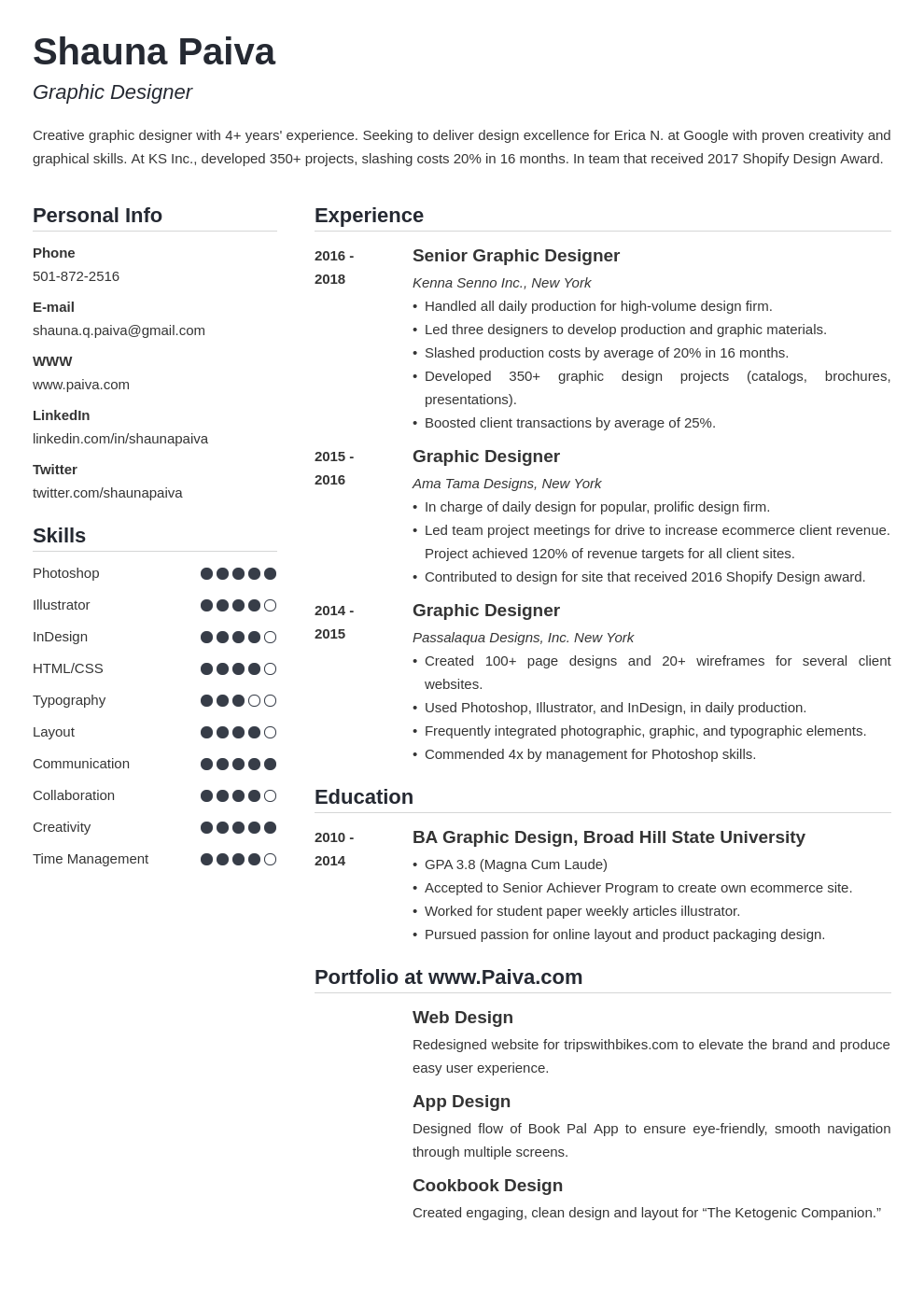
Was it interesting? Here are similar articles
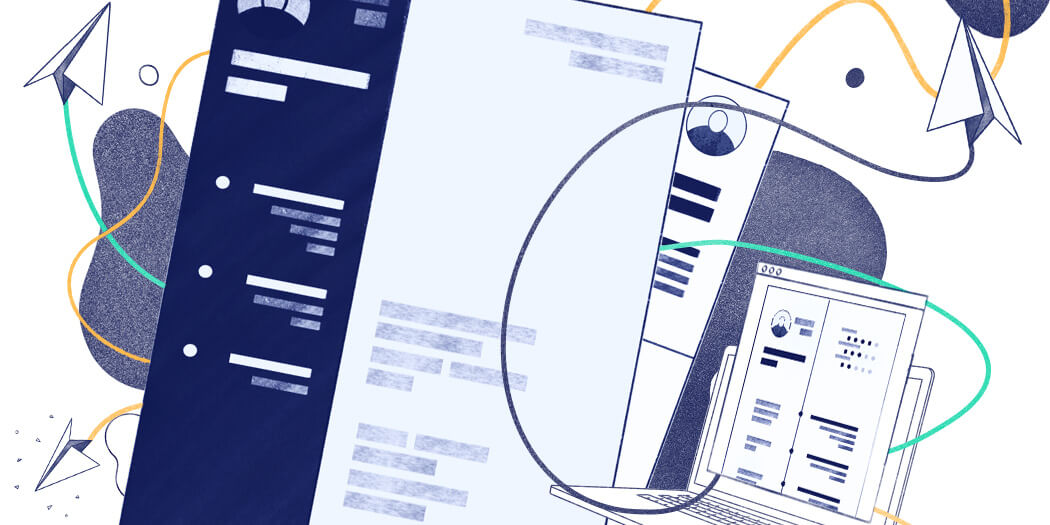
What to Write in an Email when Sending a Resume in 2024
Learn how to email a resume the right way and start getting more job offers. See a proven resume email sample and learn how to write one yourself.

Michael Tomaszewski, CPRW
Certified Professional Resume Writer, Career Expert

How to Show Promotions & Multiple Positions on a Resume
How to show a promotion on a resume? What should a resume with multiple positions at the same company look like? Find answers, best examples and tips here.

Maciej Duszynski, CPRW

Resume AI—Should You Use AI to Write Your Resume?
Resume AI writing is a hot topic as of late. And the growing potential of ChatGPT is stirring up the creative industry. Let's explore the pros & cons of AI tools for resume-making.

Mariusz Wawrzyniak
Career Expert
- • Led the redesign of Adobe's main product page, increasing user engagement by 30% through improved UX and clearer CTA placements.
- • Conducted over 50 user interviews and 10 usability tests to gather insights, leading to a 25% decrease in bounce rates.
- • Implemented a new design system using Figma, enhancing brand consistency across all web platforms.
- • Collaborated with product managers to refine user personas, resulting in a more targeted and effective product development strategy.
- • Initiated and led a cross-functional team to integrate accessibility features, making the website fully compliant with WCAG 2.1.
- • Spearheaded a project to utilize atomic design principles, shortening the development cycle for new features by 20%.
- • Redesigned the checkout process, resulting in a 15% increase in conversion rates.
- • Developed comprehensive user flows and wireframes to streamline navigation, reducing user frustration and support tickets by 40%.
- • Conducted A/B testing on various design elements, which informed the final design decisions and improved user satisfaction scores by 20%.
- • Created and maintained a UI library in Figma to accelerate the design process and ensure consistency across teams.
- • Facilitated user research sessions to understand pain points in the shopping experience, leading to significant UI improvements.
- • Implemented a new user research framework that increased the efficiency of user studies by 25%.
- • Analyzed user behavior data to inform the design team, resulting in a 10% increase in user retention.
- • Collaborated with the UX design team to translate research findings into actionable design improvements.
- • Led usability testing sessions that informed the iteration of key product features.
- • Achieved a 40% increase in daily active users and a 25% improvement in user retention within the first three months post-launch.
13 Graphic Designer Resume Examples & Guide for 2024
A designer resume must clearly showcase your creative skills and design proficiency. It's essential to highlight your strongest projects and the impact they've had. Ensure your technical competencies, including mastery of design software, are prominent. Your experience should be presented in a way that reflects your unique design perspective and problem-solving abilities.
All resume examples in this guide
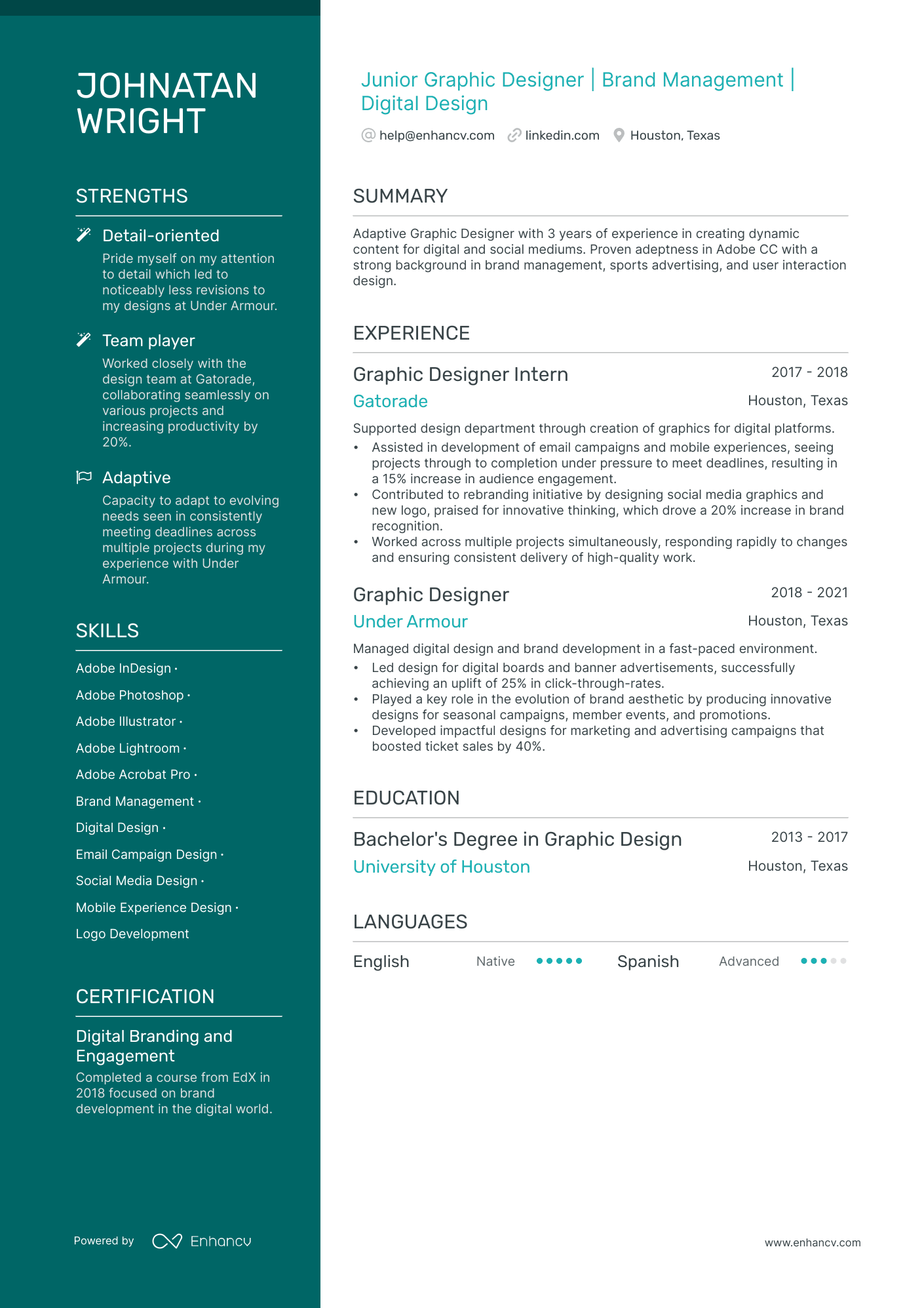
Junior Graphic Designer

Senior Graphic Designer
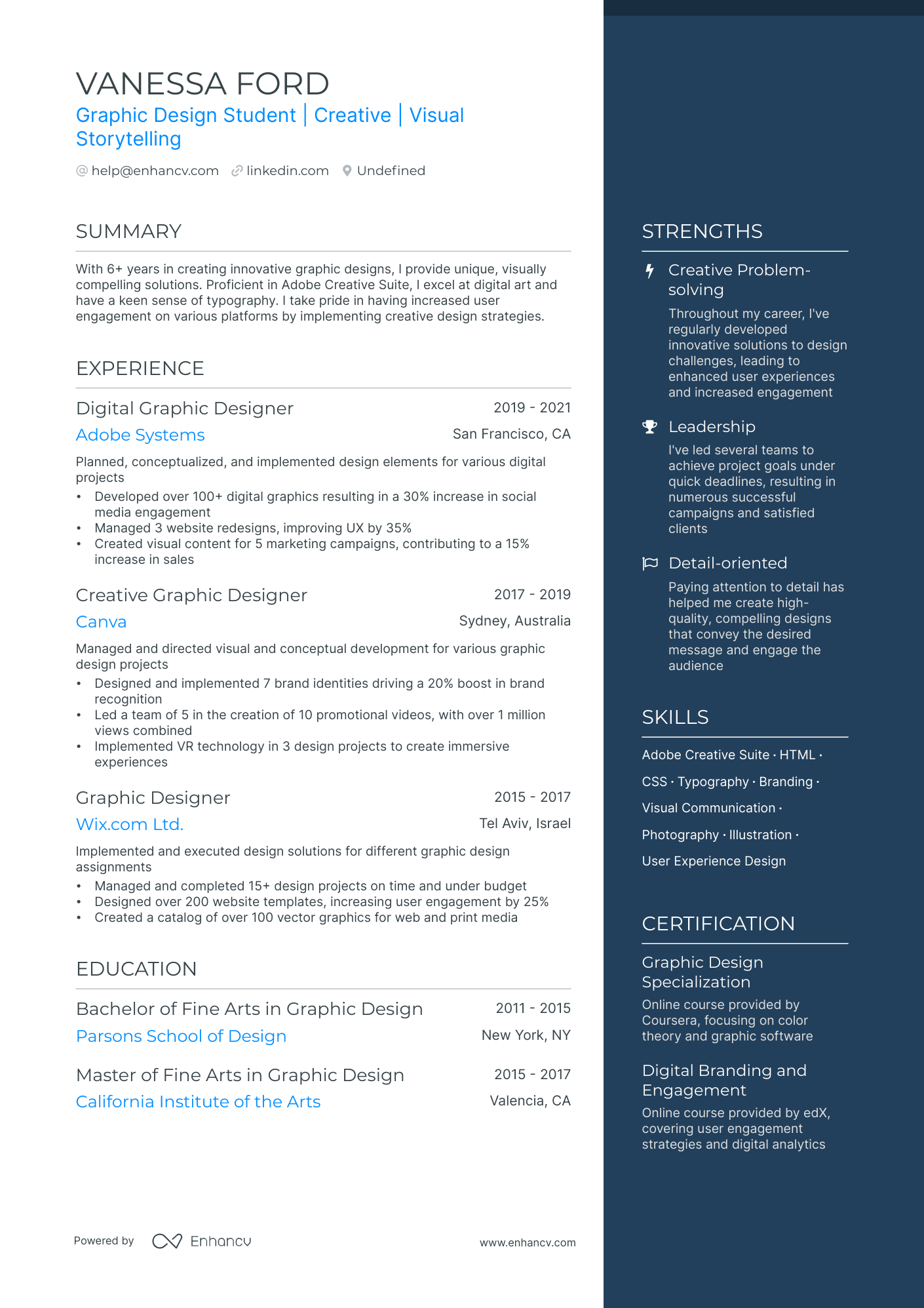
Graphic Design Student
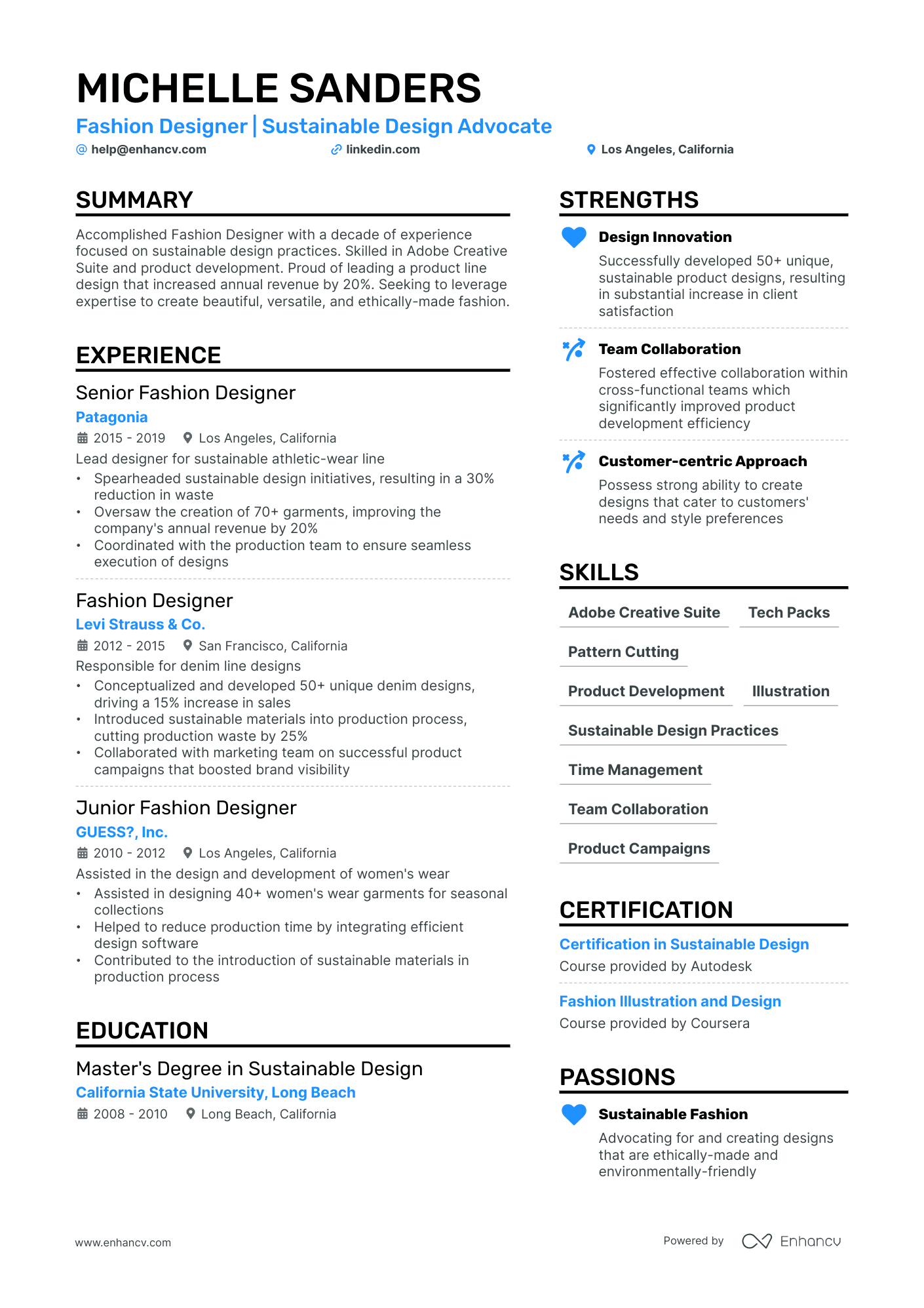
Design Intern
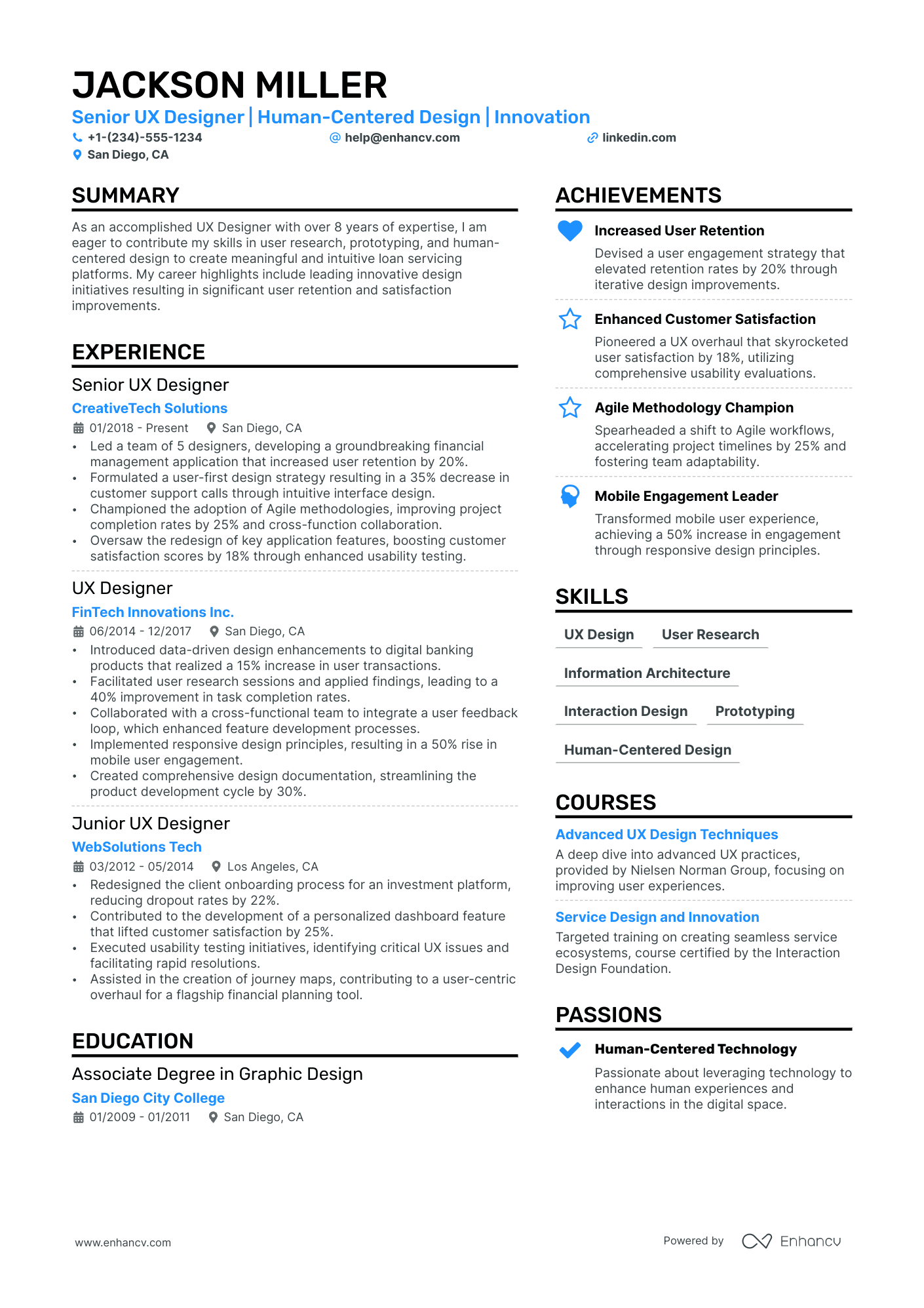
App Designer
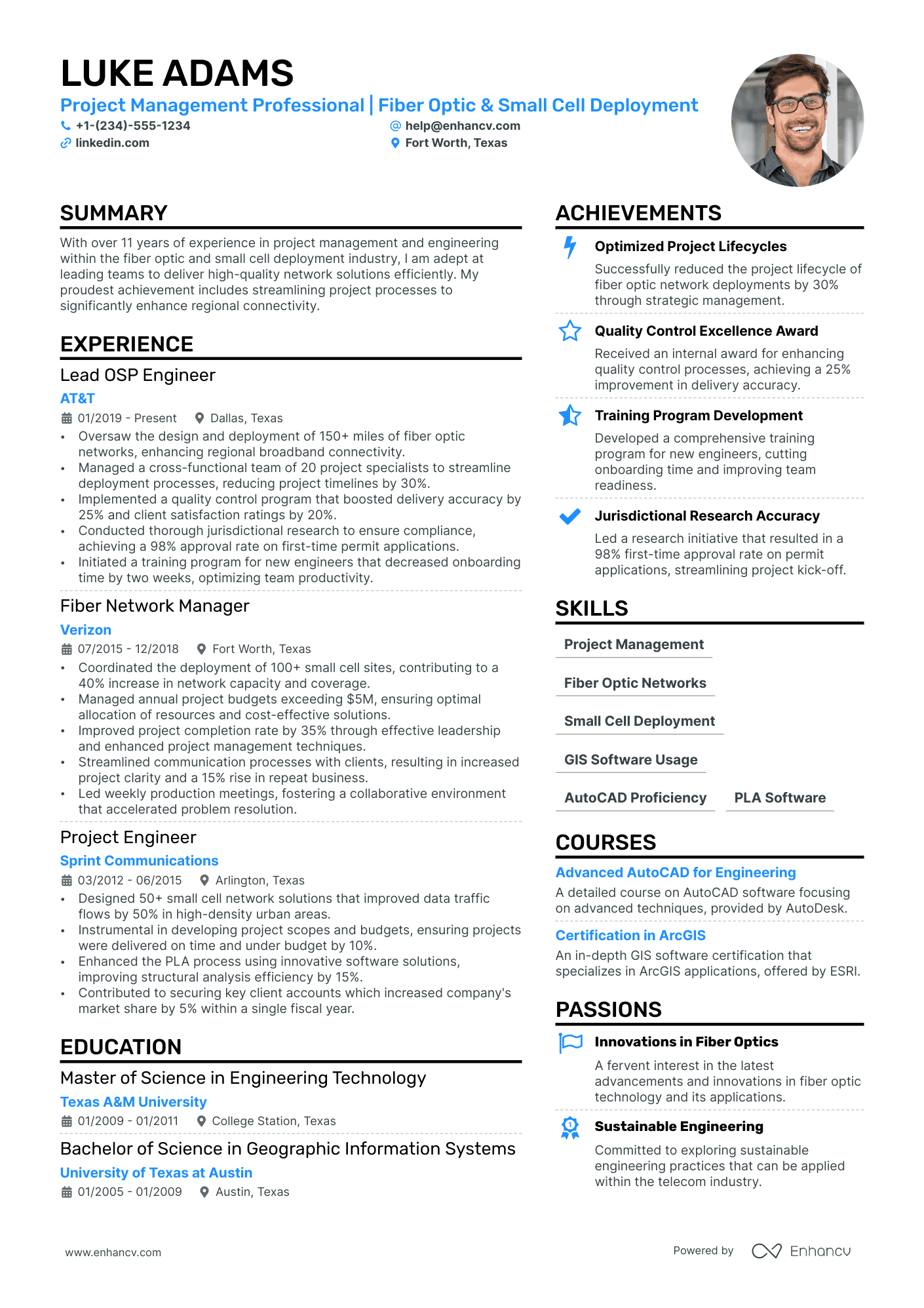
Design Manager
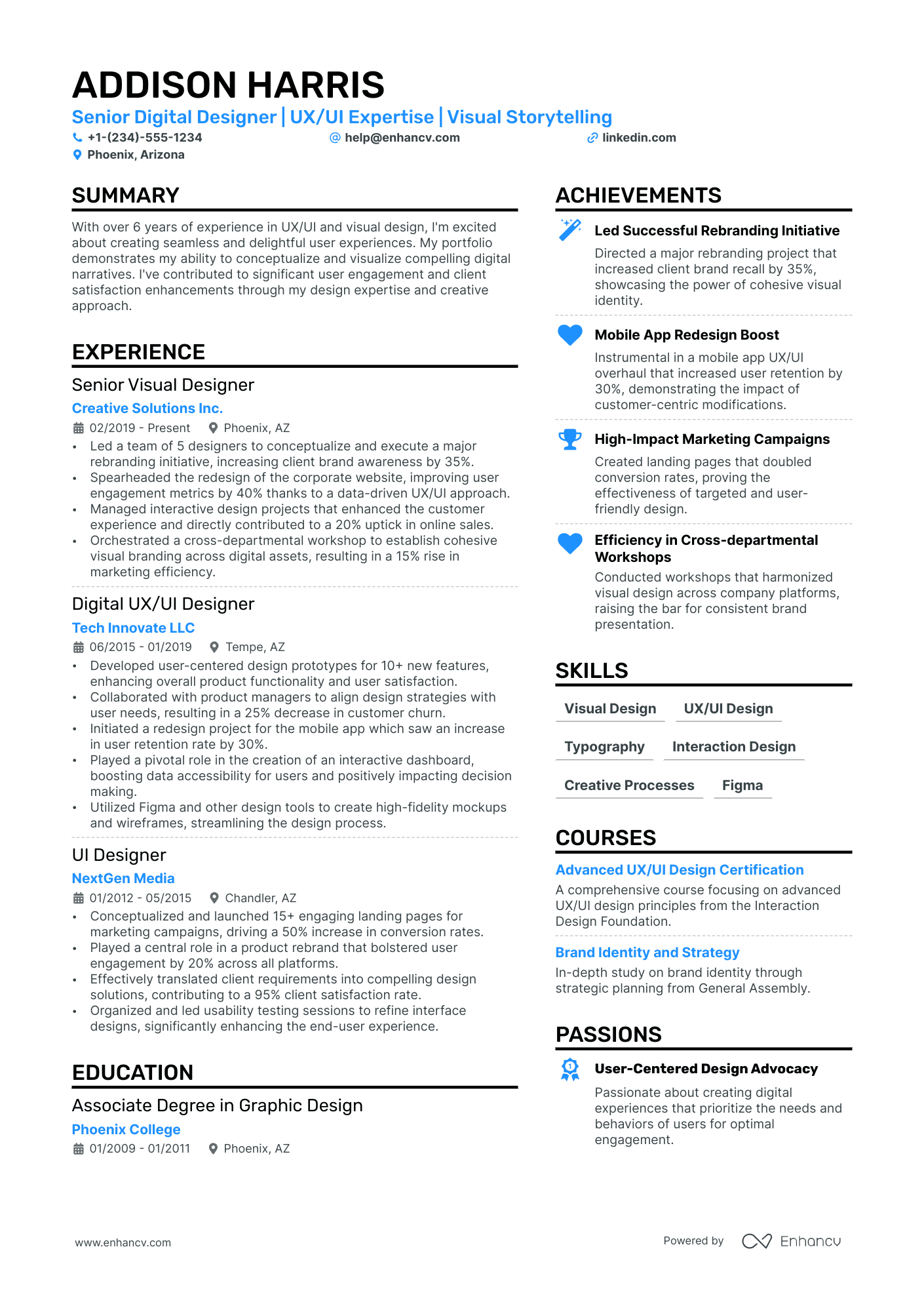
Digital Designer

Freelance Designer
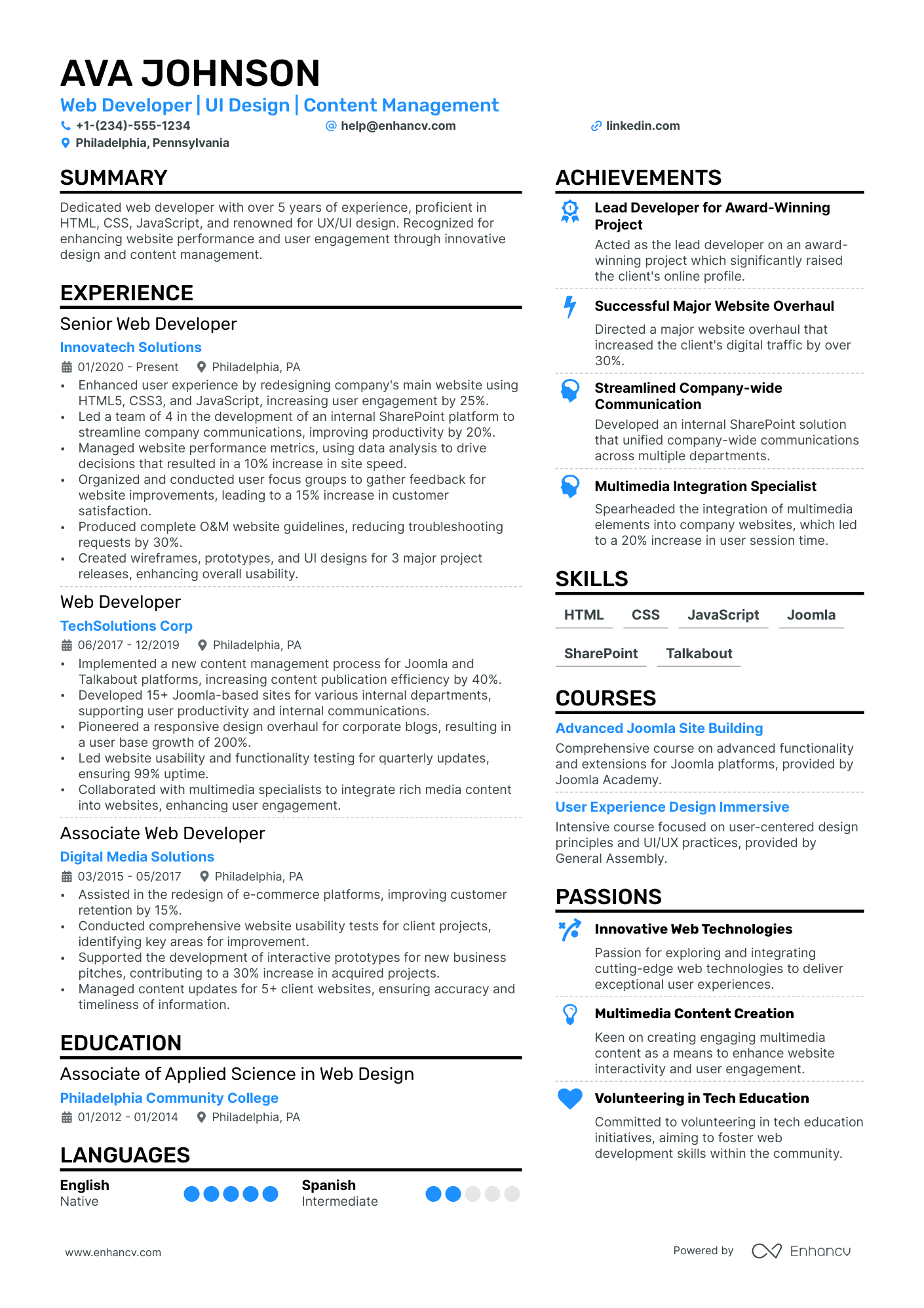
Multimedia Designer
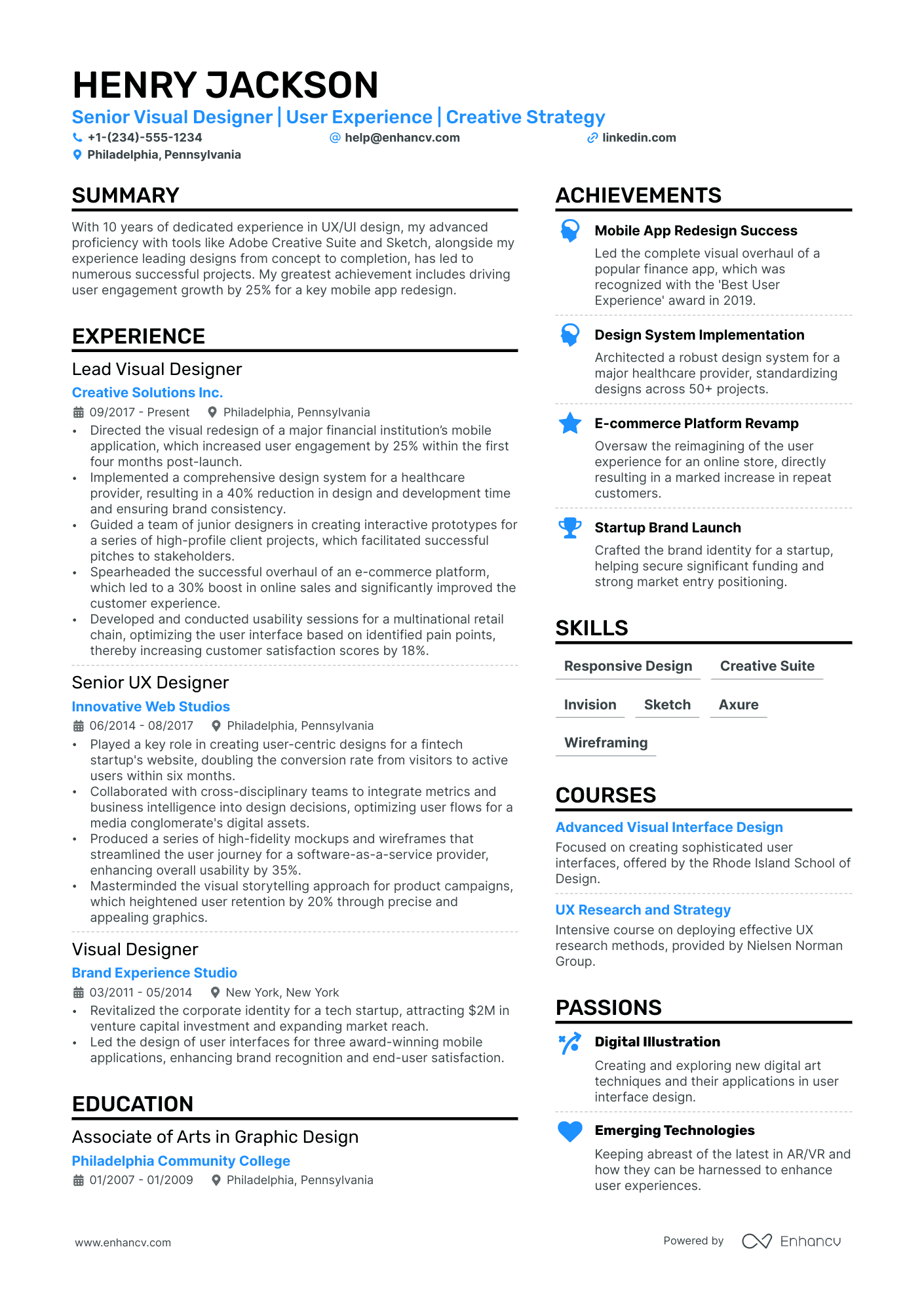
Visual Designer

Web Designer
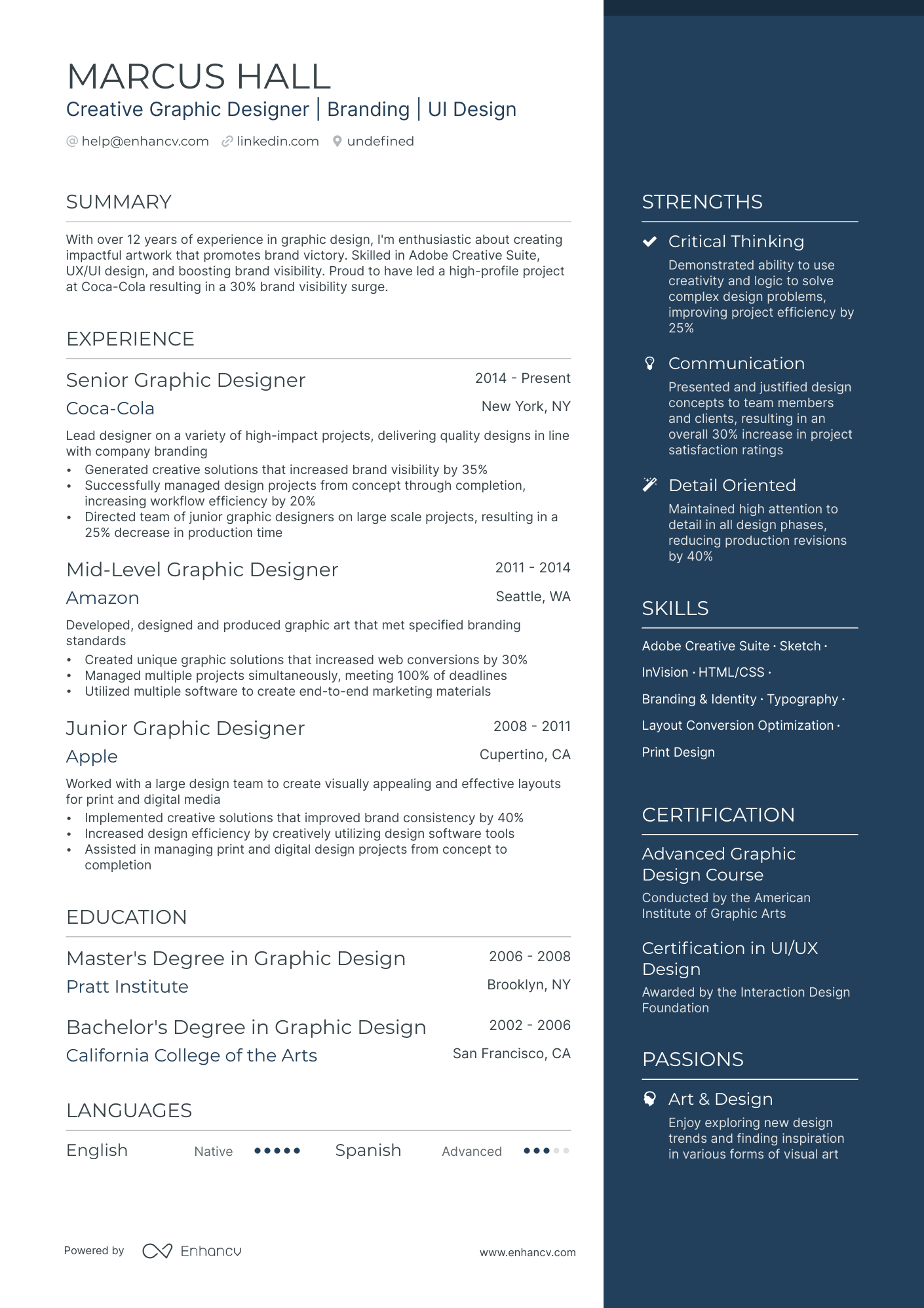
Creative Graphic Designer
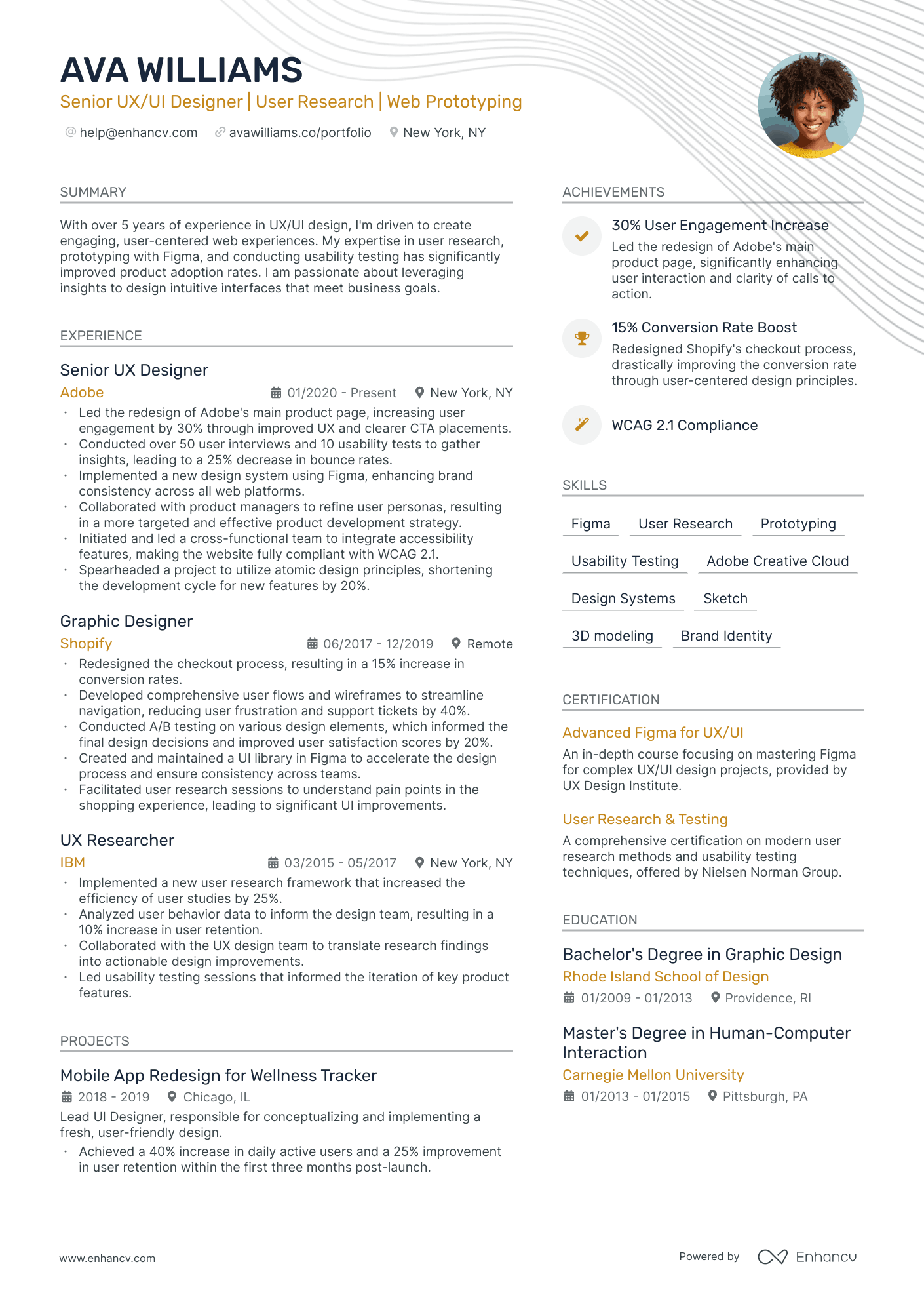
Senior UX/UI Designer | User Research | Web Prototyping resume example
Resume Guide
Resume format
Resume experience
Hard & soft skills
Certifications and education
Resume summary/Objective
Additional sections
Key takeaways
By Experience

The job outlook for designers is always improving. It doesn’t matter if business es realize it or not—there's a place for designers in any field. Whether it’s making a new product, launching a new service, or starting a new advertising campaign—there's design work associated with it.
In today’s marketing world, design makes the most impact when it comes to creating interest and attracting leads. A design concept can make or break a potential customer's decision within the very first seconds of interacting with it.
Graphic designers have a deep understanding of how human beings perceive and communicate with their outside world. The best of them know how to grab customers’ attention and keep them interested. That’s what keeps creative directors and lead designers constantly on the lookout for talented designers.
If you’re serious about landing the job, your resume needs to show that you can:
- Use a large range of tools and techniques to create high-quality deliverables including logos, flyers, business cards, brochures, magazines, etc.
- Meet clients’ needs by developing design concepts and layouts that are uniquely tailored to each client's distinct preferences.
- Communicate with team members, print ing houses, and outside agencies to ensure a smooth design process.
- Prove you deliver your work on time to guarantee client satisfaction.
Before we dive in, why don’t you browse through our database of design-related resume guides?
- Brand designer resume
- Digital designer resume
- UX/UI designer resume
- Junior UX designer
- Creative director resume
- Designer cover letter

How to format a graphic designer resume
Crafting a designer’s resume is very similar to design work. You start with an idea that you want to communicate through your work. Then, you turn that idea into a visual message that the viewer can understand.
You convey that message by creating a unique concept that captures their interest and makes an impact.
Those are the same steps you follow when creating your resume. The idea you start with is that you’re the perfect candidate and deserve the job. You have to illustrate that in your message and do so by creating a flawless resume .
While you may be a pro at communicating visually, a resume demands paying attention to some very specific details like ATS-friendly fonts and acceptable file formats. Below, we break down the formatting principles you should follow when building this type of professional document.
The resume header is the ideal spot to highlight your creative side. This section not only features your portfolio link but also allows you to personalize it to an extent that truly captures your authentic self.
Fonts : While you may want to choose a unique typeface that shows your creative side, be mindful of applicant tracking systems that may not recognize it. Instead, go with a professional font like Lato, Arial, Rubik, Calibri, Bitter, or PT Serif , sized 10-12 pt.
Margins : This part of your resume should comply with industry standards and shouldn’t be less than 1-inch wide. Margins provide white space on a resume and make it easily readable.
Layout : Go for a clean layout (a single- or double-column resume) to avoid overwhelming the reader with too many graphic elements. The best advice here is to keep your resume length no more than 1 page long.
Language : Proofread your resume for typos and grammar mistakes. Some designers tend to neglect spelling for the sake of visual impact. If you’re not confident in that, use our resume checker which will do the optimization for you.
PDF format : Many people have expressed frustration with their resumes failing to pass the ATS assessment. In many of those cases, the file format is the reason. So, make sure you save your resume as a PDF file to preserve the layout across all devices and platforms.
Which resume format is the best for graphic designers?
Usually, we talk about three main types of resume layouts:
The reverse chronological resume listing employment history starting with the most recent positions first, is best suited for experts with extensive experience. On the other hand, the functional resume , which emphasizes skills over chronological work history, is ideal for entry-level candidates or those with career gaps.
In your case, however, the decision depends not only on how experienced you are but also on your craft. A designer’s job requires a strong set of creative skills, so you need a structure that emphasizes that, without losing the importance of your previous experience.
Thus, the hybrid, or combination format is your best bet. It allows you to showcase both your skills and employment history in reverse chronological order. This resume format is also great for those who have done a lot of freelance work, which is often the case with people in the creative industry.
If you already have a resume built, chances are it might not be ATS-friendly. Click the button below to see if it passes the test or not.
Is your resume good enough?
Drop your resume here or choose a file . PDF & DOCX only. Max 2MB file size.
Now that we’ve touched on the most important formatting steps, check out the sections you should include in your resume.
The top sections on a designer’s resume
- Professional summary : Showcases your design philosophy and career goals, making a strong first impression.
- Design skills : Highlights your proficiency in design software and artistic techniques, essential for the role.
- Portfolio link : Directs recruiters to your online portfolio, demonstrating your work quality and style.
- Work experience : Details your previous design roles and projects, showing your practical expertise.
- Education and training : Lists your formal education and any design-specific courses, proving your foundational knowledge.
Hiring managers will pay special attention to these sections as they need to demonstrate the must-have skills for the position of a graphic designer. This is what they’ll gather from your resume:
What recruiters want to see on your resume
- Portfolio quality : Demonstrates your design skills, creativity, and ability to deliver professional work.
- Technical skills : Highlights proficiency in design software and tools crucial for creating and editing designs.
- Work experience : Shows practical application of skills in professional settings, including project and client diversity.
- Creativity and originality : Indicates the ability to produce innovative designs that stand out in a competitive market.
- Communication skills : Essential for understanding client needs, collaborating with teams, and presenting designs effectively.
Having clarified that, let's now delve into more detail for each of the above-mentioned resume sections.
How to feature your design experience in your resume
Design is a wide field with lots of different requirements and outcomes. Depending on the position and the industry, two designers can have entirely different skills, work on completely different projects, and produce different deliverables all the time.
So, recruiters often have a specific profile in mind for the designer they want to hire. They already know what they want. That’s why it’s crucial to display in your experience section that you’re the best designer they can hire.
How can you do that exactly? You tailor your resume to each specific job description and mark down keywords that you’ll include when writing your experience section .
Consider these two examples:
- • Developed creative concepts for website and print initiatives.
- • Created a wide range of deliverables.
- • Worked with outside agencies on managing supplemental design-related projects.
This experience section is far from convincing. It shows no evidence of the candidate’s skills and successes.
Recruiters want to know how your design work affected your former employer’s business positively. They need to be certain that you can do what the new designer position requires you to do.
They want answers for:
- What was the nature of the design concepts you created?
- What type of projects did you handle as a graphic designer in your previous job?
- Do you have experience working in teams and communicating with clients directly?
- Will your experience allow you to do your job at the new company better than any other candidate?
Below is the enhanced version.
- • Solved design challenges by reviewing clients’ existing work and providing advice for improvement.
- • Created wireframes and mockups for digital content that increased online engagement rates by 24%.
- • Worked with other designers and printing houses to ensure the delivery of print deliverables for 19 different projects.
Here’s why this version works better:
- Demonstration of problem-solving skills : The first bullet point highlights the designer's ability to assess and improve existing work, showcasing critical thinking and problem-solving skills. Recruiters will spot the candidate’s ability to enhance visual communication and meet clients' needs and objectives.
- Quantified achievements : The second bullet point provides a specific, quantifiable achievement (increasing online engagement rates by 24% through wireframes and mockups). This not only shows the designer's skill in creating effective digital content but also provides a measurable impact of their work.
- Collaboration and project delivery : The third bullet point emphasizes the designer's ability to collaborate with other professionals and manage deliverables for multiple projects simultaneously. This showcases practical skills but also project management and teamwork abilities.
In the following passage, we’ll give you ideas about how you can measure your successes in the design field.
How to quantify impact on a design-related resume
Feel free to use any of the following tips to maximize your impact as a graphic designer.
- Include the percentage increase in user engagement or customer conversions due to your design improvements to show your ability to create value through design.
- Mention the specific decrease in bounce rate on webpages or apps you've designed, demonstrating your skill in retaining audience interest.
- Highlight the number of design iterations conducted before final approval , reflecting your persistence and dedication to perfection.
- Detail the reduction in load time for digital assets you've optimized , indicating your understanding of technical aspects that improve user experience.
- Specify the amount of revenue generated from campaigns or projects you contributed to, showcasing your designs' direct impact on business success.
- Quantify the growth in social media followers or engagement rates resulting from your graphic content. This emphasizes your role in boosting brand visibility.
- State the number of A/B tests you've conducted for various design elements and the improvement metrics, highlighting your data-driven approach to design.
- Document the cost savings achieved by streamlining design processes or utilizing more efficient tools and resources. This shows your contribution to operational efficiency.
But what happens if you have no professional accomplishments yet? No worries, you can still create a resume that stands out.
How do I write a graphic designer resume with no experience
According to a Learn G2 article , “19% of businesses don’t use graphic designers, but 67% of those companies would if there were a quicker, less expensive way to create graphic design materials”. This means that the industry will continue to hire junior designers for their availability and lower rates.
Use this insight to create a resume that no recruiter can say no to. Here’s how:
- A portfolio link is a must. Entry-level or not, this is the one element you can’t go without when applying for a designer role. Make sure it’s prominently featured in your resume header.
- Start strong with a sleek resume objective . These are the 3 sentences at the top of your resume, highlighting your skills and motivation to contribute to the company you’re applying to.
- Emphasize your education or certifications . Many job seekers in your field don’t have formal design education. However, it’s important to be familiar with design fundamentals and prove your knowledge through r elevant coursework or projects you’ve worked on.
- Dedicate a section to your self-improvement projects . Especially for those with limited work experience, specific projects such as classroom assignments, internships, or shadowing work, can demonstrate your design skills and willingness to grow. Describe the project, your role in it, and any positive outcomes.
- Quantify your work experience , as limited as it may be. For entry-level candidates , this can include internships, part-time jobs, or freelance work. Focus on your responsibilities and achievements in each role, quantifying your impact whenever possible (e.g., "Designed a new logo that increased brand recognition by 20%").
Whatever you choose to feature in your resume, the key is to always adapt it to the requirements of the job you’re applying for.
Now, let’s focus on your strongest asset—your versatile skill set.
How to list your hard and soft skills on your resume
Clients always ask for different projects with different requirements. At the same time, they want the outcome to be unique to their brand. That's why the more relevant design skills you have, the better you are at your job.
Being a designer requires you to master a variety of design software programs as well as an ability to sketch concepts and layouts by hand. Below is a list of the most common practical skills a designer should have.
Best hard skills for your graphic designer resume
- Adobe Photoshop
- Adobe Illustrator
- Adobe InDesign
- UX/UI design
- Branding and identity
- Print design
- Motion graphics
- 3D modeling
- After Effects
- Graphic optimization for web
- Digital illustration
- Packaging design
- Color theory
- Prototyping
- Responsive design
You’ll likely be constantly working with other designers, outside agencies, printing houses, and clients. That’s why your resume needs to show that your teamwork and communication skills are on point. Avoid dedicating a separate section for soft skills on your resume due to limited space. Instead, integrate them within other sections, allowing recruiters to discern these qualities on their own.
Best soft skills for a graphic designer resume
- Attention to detail
- Time management
- Critical thinking
- Problem-solving
- Adaptability
- Client management
- Feedback receptivity
- Project management
- Collaboration
- Stress tolerance
- Organization
- Visual storytelling
- Negotiation
- Continuous learning
Finally, let us remind you that the skills you pick need to be strictly linked to the keywords of the job posting . Before you start building your resume, make sure you make a list of all the skills highlighted in the job description, then put the ones you really do have in your document.
How to list your certifications and education on your resume
When it comes to creative fields like design, education shouldn’t be the most important section. Hiring managers won't rely on it to make their final hiring decision. Instead, they’re more into seeing your work samples and learning more about your experience.
A master’s degree in graphic design won’t get you hired if your work is of low quality. Yet, when there are hundreds of resumes stacking up in the recruiter’s inbox, education may come in handy . It’s especially true if it’s related to arts or graphic design or you graduated from a top-tier university.
Sure, you may have an amazing portfolio with many top-notch projects with your past employer, but so might another dozen candidates applying for the same position.
If your educational background is relevant to the job you're applying for, make sure to include it. Here's how to do it correctly:
- Begin with your degree and major.
- Mention the name of the educational institution.
- Include the duration of your studies along with the location.
A more important element in designers’ resumes is the certification section. Since people obtain certificates based on their interests and willingness to learn new things, this section will give recruiters a more accurate picture of your profile.
Check out this list of must-have certifications if you’re considering a career in graphic design.
Best certifications for a graphic designer resume
- Graphic Design Master
- Brand Identity Design
- Graphic and Digital Design Certificate
- Adobe Certified Expert (ACE)
- International Society of Typographic Designers (ISTD)
Now that we’ve covered the experience and certifications sections , it’s time to go back to the header because something’s still missing there—your resume summary.

How to write your graphic designer resume summary or objective
Summaries are typically written last, once you have a complete overview of your career. Your summary should be memorable to the recruiter, highlighting your value and experience. To achieve this, address the following areas in no more than five sentences:
- The technical skills and design tools you are proficient in;
- The impact of your design work on previous clients or employers;
- Specific design projects and deliverables you have managed;
- Your aspirations and what you look forward to achieving in the new role.
Let’s take a look at the two versions of the same resume summary , one that is effective, and one that falls short.
This summary (if it can be called one at all) lacks details and specificity. It doesn’t highlight the effect of the candidate’s design work—neither quantified achievements nor anything specific they’re proud of.
Now look at this:
Three major factors make the above a good summary:
- Comprehensive expertise : The summary showcases the candidate's experience and diverse skill set in graphic design, including proficiency in both digital tools like Adobe Creative Suite and traditional methods such as sketching and hand drawing.
- Quantified achievements : By highlighting specific achievements, such as supervising 23 print design projects that led to a 32% increase in savings and creating 18 brand identities, the summary provides concrete evidence of the candidate's success in previous roles.
- Targeted intent : The final sentence clearly states the candidate’s intent to apply their skills and experience to contribute to The Digital Hyve’s visual messaging. This shows that the candidate is not only aware of the employer's needs but is also eager to fulfill them.
Read the job description carefully and understand what exactly the hiring company is looking for. After that, write your summary accordingly while highlighting your potential and ability to be the best at that job.
Additional sections for a graphic designer resume
A graphic designer's resume often includes several key sections beyond the standard ones found in many professional resumes. They allow you to add some flair to the document and boost the qualities that make you stand out in the design world. These may include:
- Projects section —perfect for including prominent freelance work. Make sure you include the scope of the project, your specific contributions, and the final outcomes.
- Workshops and training courses : You can feature participation in workshops, seminars, and courses relevant to graphic design, as well as any certifications received from online platforms like Coursera, Udemy, LinkedIn Learning, Domestika, etc.
- Awards and recognitions : Have you received any industry awards and recognitions? Or won contests where your work was featured? Had speaking engagements or publications in design magazines and websites? Any of these can add to the resume’s effectiveness.
Of course, it’s vital to include a link to your portfolio . We discuss that in the following section.
Where to put a portfolio link in a designer’s resume
This is arguably the most crucial addition to a graphic designer's resume. Having compiled the best samples of your work, the next step is determining where to feature the direct link (URL) to your online portfolio.
Placing it in the resume header, directly beneath your name and title, stands out as a logical choice. If your portfolio is on your own site, this spot is your best bet. It will make it easier for recruiters to draw a connection between your personal name and website. For portfolios hosted on platforms like Behance or Dribble, consider using a link shortener to ensure it fits neatly into the given space.
The other option is to place the link in your summary or objective statement.
Our resume-building app enables you to personalize your resume by rearranging sections, allowing you to place the portfolio link in a dedicated place, for example, right before the experience section. Regardless of where you choose to insert this crucial piece of information, ensure the link is clickable in the final PDF.
Wrapping this up, remember: crafting your graphic designer resume is a bit like designing a billboard for the world's pickiest client—yourself. It has to emphasize more than your design skills. Let’s go through the main things you should keep in mind when building your resume.
- Design is a very large field that requires lots of different skills, experiences, and expectations. Make sure you tailor your designer resume to match the job description.
- Your portfolio is your greatest asset as a designer. It has to be prominently displayed and easy to link with.
- The summary section is a great place to apply the famous “less is more” design principle. Keep it relevant to what the recruiter is expecting to know about you.
- When done correctly, education and certifications can increase your chances of getting hired.
I don't think it's an 'additional' which implies it's optional—which I do not think it is :) but I may be wrong
Designer resume examples
Explore additional designer resume samples and guides and see what works for your level of experience or role.

Looking to build your own Designer resume?

- Resume Examples
5 Essential Notes to Take Before Your Next Interview (With Tips to Succeed)
How to answer the "what are you looking for in a new position" interview question, how to write an australian resume, do resume templates work, how to write a great linkedin connection message [with examples], what to write in email when sending resume to a friend.
- Create Resume
- Terms of Service
- Privacy Policy
- Cookie Preferences
- Resume Templates
- AI Resume Builder
- Resume Summary Generator
- Resume Formats
- Resume Checker
- Resume Skills
- How to Write a Resume
- Modern Resume Templates
- Simple Resume Templates
- Cover Letter Builder
- Cover Letter Examples
- Cover Letter Templates
- Cover Letter Formats
- How to Write a Cover Letter
- Resume Guides
- Cover Letter Guides
- Job Interview Guides
- Job Interview Questions
- Career Resources
- Meet our customers
- Career resources
- English (UK)
- French (FR)
- German (DE)
- Spanish (ES)
- Swedish (SE)
© 2024 . All rights reserved.
Made with love by people who care.
- Get Started
how to become a graphic designer (2024 Guide)
Graphic Designer Resume Examples
BrainStation’s Graphic Designer career guide is intended to help you take the first steps toward a career in graphic design. Read on for graphic design resume examples and templates to help you get a job as a Graphic Designer.
Become a Graphic Designer
Speak to a Learning Advisor to learn more about how our bootcamps and courses can help you become a Graphic Designer.
By clicking “Submit”, you accept our Terms .
Couldn’t submit! Refresh the page and try again?
We will be in touch soon.
What Are Graphic Designer Resumes?
Graphic Designer resumes outline your skills, experiences, and successes in graphic design. Resumes should be tailored to the specific position you are applying for. Your resume should focus on relevant design projects and the results you achieved. The resume, along with your cover letter and portfolio, shows employers why you would be an asset to their team.
Your resume is also your first chance to show off your design skills, though you shouldn’t go overboard. Instead, include a link to your portfolio so employers can see more of your work.
Graphic Designer Resumes – a Step-by-Step Guide
To craft a standout Graphic Designer resume, follow these steps:
- Write a compelling Graphic Designer summary or profile
- Describe your design experience and achievements
- Add your education
- List your relevant graphic design skills
- Mention awards, activities, and interests
- Include a link to your digital portfolio
You can break down the resume creation process into three phases: planning, writing, and editing. Keep these best practices in mind for each phase.
Planning your Graphic Designer resume
- Do your research : Your resume should be tailored to the company’s needs—this means first understanding their work, mission, values, and challenges. Browse through their website and social media and search for any news or articles about the company.
- Review the job posting : The job posting has specific information about what the company is looking for in an ideal candidate. Highlight key skills and qualifications in the job posting. You will want to include those in your resume. Remember that some companies use resume-screening software, so make sure you have keywords to get you through that initial screening.
- Select your most relevant work : You may have an extensive portfolio of designs and a long list of skills, but you’ll need to pare it down to the most relevant details. For example, if the company is looking for someone with experience in branding, highlight your achievements in creating memorable and consistent brand assets.
- Create a simple and appealing design : As a graphic design job applicant, a generic resume template won’t cut it. While the content is key, Hiring Managers will also be looking at how you present the content. Create a clean but aesthetically pleasing design. Stick to one or two fonts, use color sparingly and make sure there’s plenty of white space to make your resume easy to read. Add in a few creative elements to show your skills, but don’t go overboard.
Writing your Graphic Designer resume
- Customize your resume : Write a new resume for each Graphic Designer job you apply to. An all-purpose resume may seem tempting, but customized resumes help you stand out. Point to specific skills and projects relevant to the position.
- Be brief : Stick to one page in length. Your resume should be focused, not comprehensive.
- Stay organized : Readability should be a top priority. Use clear headings, sections, and bullet points to structure your content.
- Use action verbs : Highlight your accomplishments through impactful action verbs such as spearheaded, advised, conceptualized, enhanced, and shaped.
- Show evidence of your skills : Don’t tell the employers what you can do—show them. Share examples of past design projects and include links to your work. Use numbers and figures, such as revenue or response rates, to indicate the measurable impact of your work as a Graphic Designer.
- Craft accomplishment statements : For each professional experience you list, write an accomplishment statement in the form of action verb + task + result. For example, “Designed new print and digital materials for the client, which helped achieve 120% of revenue target.”
Editing your Graphic Designer resume
- Review with fresh eyes : After creating a first draft, set your resume aside for a few hours or a day. Then, read it over and see if there are any changes or edits you want to make.
- Get a second opinion : Ask a trusted friend, colleague, or mentor to review your resume and check for readability, flow and spelling/grammar errors.
- Proofread : Run a spelling and grammar check before submitting. Read your resume out loud to catch any awkward phrasing or additional errors. Be diligent about proofreading—resumes with excessive errors may be rejected right away.
Getting Started – What Is the Purpose of the Resume?
A resume is a marketing tool—it pitches your skills and qualifications to an employer and convinces them you are the best candidate. While your portfolio shows off your design skills, your resume explains the impact of your work. Your resume demonstrates that you have the necessary training and experience to deliver results.
Your Graphic Designer resume is not a comprehensive list of everything you have done. Rather, it’s a snapshot of your top achievements. Focus on how your graphic design skills can help the company achieve their goals.
How to Create an Outline for a Graphic Designer Resume
Follow this outline to create a strong and well-structured Graphic Designer resume.
- Start with a header with your contact information.
- Write a strong profile/summary that highlights your top skills and accomplishments.
- Describe your most relevant graphic design experiences and the impact of your work.
- Add in your education and training.
- List technical skills that match the job description.
- Include other awards or activities that help you stand out.
What to Include in Your Graphic Designer Resume?
Your Graphic Designer resume should include a profile, an overview of your design experience, a list of your education/training, a synopsis of your most relevant design skills, and a section for additional activities, awards, or interests. Include a link to your digital portfolio and links to specific projects throughout.
Start off with a compelling profile or summary to grab the Hiring Manager’s attention. In two to four sentences, sum up why you are the best candidate for the position. Include your top skills and achievements and what you can bring to the company.
List your relevant professional experience in a reverse chronological order. Include your job title, employer, start and end date and the location. Write two to three bullet points about each experience.
For your bullet points, focus on your achievements rather than your responsibilities. For example, instead of “Created new branding for client” rewrite it as, “Conceptualized new branding for e-commerce client, which helped grow customer awareness and increase sales by 20%.”
Include the name of the institution, the degree or certification, and the start and end date. If you recently graduated from a graphic design program and do not have as much work experience, you can mention your educational achievements and relevant projects.
Skills and tools
List your top technical skills along with tools and software you are proficient in. The skills you list should match those included in the job posting.
Awards/activities/other
Add additional sections as needed to list your awards or activities, such as membership in professional organizations or meetups you attend. This section can help show your passion for design.
What Skills Should You Put on a Graphic Designer Resume?
Simply put, your skills section will depend on the job posting. Overall, Graphic Designers are responsible for conveying messages in a visually appealing manner—but the specifics of what you will be doing can vary depending on the role, the company, and the industry. Refer back to the job posting to see what specific skills are required. Then, match those to your own skillset and list them on your resume.
A few of the top skills that employers look for in Graphic Designers are:
- Adobe Creative Suite (Photoshop, Illustrator, InDesign, Acrobat, After Effects, Dreamweaver)
- Logo creation
- Storyboard creation
- Color sense
- Color theory
- Composition
- Illustration
- Photography
- Print knowledge/designing for print
- Marketing and branding
- HTML and CSS
- Social media
- Typography and selecting fonts
- Design principles
- UX/UI design
- Photo editing
- QuarkXpress
Graphic Designer Resume Template
- [Phone Number]
- [Portfolio]
Enthusiastic Graphic Designer with experience in [most relevant experiences]. Used expertise in [top skills] to achieve [major graphic design accomplishment or project]. Eager to bring passion and creativity to help [way you could help the company].
[Job title, Company, Location]
[Month, Year – Month, Year]
- [Action word] [skill/task] [result/impact]
[Degree earned, School name]
[Graduation date]
- [Relevant courses]
- [Academic achievements]
- [Technical skills]
- [Software/tools]
AWARDS AND ACTIVITIES
- [Conference]
- [Meetup group]
get started
Kickstart Your Graphic Design Career
We offer a wide variety of programs and courses built on adaptive curriculum and led by industry experts.
Work on projects in a collaborative setting.
Take advantage of our flexible plans and scholarships
Get access to VIP events and workshops
Recommended graphic design courses
The User Experience Design bootcamp is designed to introduce the skills and concepts required to become a UX Designer.
User Interface (UI) Design is the practice of transforming user goals and requirements into compelling designs.
The part-time User Experience (UX) Design course was developed for professionals with an interest in user experience design and user-focused web development.
The Design Thinking training course gives you the skills to solve complex business problems using design thinking methodologies.
We use cookies to improve your experience on our site, and to deliver personalized content. By using BrainStation, you agree to our privacy policy .
- Knowledge Base
- Free Resume Templates
- Resume Builder
- Resume Examples
- Free Resume Review
[ Click here to directly go to the complete graphic designer resume sample ]
How to write a resume for graphic design?
"There are three responses to a piece of design – yes, no, and WOW! Wow is the one to aim for." - Milton Glaser
Text, images, and colors are an integral part of a graphic designer's life. The same applies for a graphic designer resume.
While the text is the common ground between a graphic designer and a resume, the writing style of both differs vastly. A resume is typically divided into sections such as header, personal information, title, etc.
- Spearheading the Design team of 10+ to steer design, development & implementation of the revamped graphic layout
- Supervising procurement of production & communication materials for clients to achieve reduction in costs by ~12%
- Managing up to ~5 projects simultaneously as part of developing appropriate designs based on overall marketing goals
- Governing & ensuring efficient use of production project budgets up to USD ~25,000
- Ensuring quality & accuracy of design by overseeing assessment of graphic materials
- Designing marketing programs including Ads & Infographic Presentations to meet client expectations
- Secured a project worth USD ~1M for the company based on the recommendation by a previous client
- Envisioned a new art-proofing system to increase overall production quality & enhanced customer satisfaction to 97%
- Effectively utilized large format printing for billboards & digital photography to enhance proposed work
- Planned & executed the presentation of detailed scale models in the form of graphic arrangement
- Ensured compliance with approved design standards to deliver timely & quality bound projects
- Developed 10+ advertisements & logos weekly in InDesign along with creating flyers & banners for a Dutch newspaper
Graphic designers occupy approximately 250,000 jobs in total and a majority of graphic designers are surveyed to be self-employed. The recruitment of graphic designers is estimated to increase by 5% in the coming 10 years, which is also the average growth rate in recruitment for all other job occupations.
The broad-level work of graphic designers is to create visual images via hand or by using latest tools and technologies.
These visuals are made in order to communicate information to the people. The objective can be to encourage people to do something, to convey information or to acquire consumers.
A graphic designer conceptualizes, develops and produces the overall layout and design of all marketing creatives encompassing advertisements, magazine, brochures, corporate reports, etc.
The increasing demand of graphic designer is leading to thousands of applicants for a handful of vacancies.
The field of graphic designers will see a constant growth in the coming years as they are required for brand promotion by every company. The requirement of Graphic Designers, Graphic Design and Information Consultants, Visualization Specialists and Graphic Design Specialists is likely to grow by 20% in the next 10 years.
After going through our 2022 Guide on Graphic Design Resume, you'll be able to:
How to write a Graphic Design Resume?
- How to write summary for your graphic designer resume?
- Present your certification in the best way possible
- Write your professional experience section to entice the recruiter
- Ensure a recruiter-friendly and ATS-optimized resume skills
...All in order to make a job-winning graphic design resume!
To build your graphic designer resume, you can use Hiration's Online Resume Builder for an easy breezy resume making experience.
However, if you want to make your resume on your own, then follow the steps given in this article below to make a job-winning resume today. Also, refer to the graphic designer resume example given below for more clarity.
In addition to this, once you are done with your resume, you can get it professionally reviewed by Hiration's select industry experts today.
What is a Graphic Design Resume & Why do you Need it?
[ Back to Table of Content ] A graphic designer resume is a resume that demonstrates the proficiency of a graphic designer in his/her field.
The duties of a graphic designer involve things like attending conferences with the clients, meeting with the manager of the art/marketing department to decide the scope of design and recommend clients on approaches to grasp a specific audience type.
A graphic designer needs to decide the information a composition should represent.
Graphic designer's job requires them to develop computer graphics for brand demonstration, logotypes and internet sites. They also need to choose colors, photographs, subject matter style and outline of the graphics they are creating.
In some cases, they need to demonstrate the composition to the client or the manager of the art/marketing department.
A graphic designer should have a basic semblance of color and design, needs skills like typography, should be good at using technical tools and should be creative.
A graphic designer resume incorporates all this information and demonstrates it in a professional way. It is used when you apply for a graphic designer job.
Graphic design resume will help the recruiter know the level of your proficiency as a graphic designer.
Having a resume shows professionalism in a person and having one will get you your desired job sooner.
Graphic design resumes tell the recruiter, briefly, about your professional and educational trajectory.
A graphic designer gets approximately $4,000 a month, which can range up to $7,000 a month in case of people who have more relevant experience and have a senior position in the company.
Freshers in this field get a starting salary of approximately $3,000. In order to further climb this ladder, you need to keep updating your resume every time you switch a job.
This will give the recruiter an insight on the number of years of experience you've had for computing your compensation accordingly.
Maintaining a graphic design resume will let the recruiters know that you are the most creative graphic designer out there.
You can opt for Hiration's Online Resume Builder to make your resume with ease today!
[ Back to Table of Content ] Writing a graphic designer resume is no rocket science. To make it simpler for you, we've broken down the process into simple and easily understandable steps.
Just follow these steps and you'll become a master in making a graphic design resume.
Also, you can use Hiration's Online Resume Builder, where you will find pre-written ready-to-use graphic designer resume templates. These templates have been prepared by industry experts and using them will astronomically bolster your chances of getting shortisted.
It saves time, is easy to use and allows you to tailor your graphic designer resume as per your target job listing. You can tweak the information around your work experience - it's super easy to customize your resume and make it your own!
Don't believe us? Check it out for yourself!
Most graphic designers go overboard when it comes to using an eye-catching resume template. They overlook the nuances of the recruitment process and proceed with stuffing and showcasing their entire gamut of skills in a humble one-pager resume.
While using jazzy resume templates and innovative ideas for your graphic design resume template is good when you're being internally referred, or when you are utilizing your network for sending your resume, think twice before using the same for your standard applications.
That's because the jazzier the resume template, the more difficult it gets for the ATS (Applicant Tracking System) to scan and parse your resume.
The entire exercise is pointless if you spend countless days and sleepless nights beautifying your resume, but when it actually mattered, you ended up in the reject pile.
Pro-tip: Being a graphic designer, you sure have the liberty to play around with resume template and design, but make sure that it's ultimately ATS-friendly and can be parsed by standard applicant shortlisting software.
Graphic Design Resume Format
[ Back to Table of Content ] There are three resume formats that you can use to write a graphic designer resume. They are:
- Reverse Chronological Resume Format
- Functional Resume Format
- Combination Resume Format
Reverse Chronological Format for your Graphic Design Resume
In this format, you will write your most recent job first and then date back to your other jobs in your professional experience section. Same goes for your other sections like that of Education, Certification and Awards & Recognition.
This format of resume is perfect for those professionals who have an exhaustive work experience history and their professional trajectory is not dotted with long, unexplained gaps.
Functional Format for Graphic Designer Resume
Functional Resume, also known as skill-based resume format , makes your skills and experience sections the center of attraction. It stresses on your skills and experience more as opposed to your educational background.
It is great for those job seekers who are looking for a career change and have gaps in their employment history.
Combination Format for Graphic Design Resume
Combination resume format is quite similar to reverse chronological resume format and is applied in two sections of the resume: Skills section and Professional Experience section.
In both the sections, information is written under the buckets of your acquired skills. Also, the professional experience section is written in the reverse chronological order using the same method.
This format can be used by everyone - it does not matter if you have an exhaustive work history or have gaps in your employment history.
Also Read: How to create a freelance graphic design resume in 2022?
Writing your Graphic Design Resume
[ Back to Table of Content ] Your graphic design resume will be made in four stages:
- Compilation Graphic Designer Resume
- Master Graphic Design Resume
- First Draft Graphic Designer Resume and
- Final Graphic Design Resume
- Compilation Stage for your Graphic Designer Resume : It simply means collecting all your information in a single place. In this step, you will collect all the information that you have related to your graphic designer resume skills, work experience, internships, education, awards and recognition, and extra-curricular activities.
The idea is to dump all the information in a single place. It can act as a lo ng-term solution for all your resume troubles. Maybe months or years later, say if you want to switch profiles again or apply for a job, you'd have a single authoritative source containing everything you've ever done.
When you will proceed further in the graphic design resume making process, you will know that you have all your information compiled at a single place and you don't have to look at any other documents to customize and finalize your graphic designer resume.
- Master Graphic Designer Resume : In the master graphic design resume making stage, you will sort and arrange your professional experience section and your internship section. At this stage, make sure you have the following information and that it is arranged and placed at their proper places.
Look for the following information for both the sections:
- Company name
- Dates of joining and resigning or completion of tenure
- Designation
- Points arranged in terms of importance for every section
Lastly, save a copy of the master graphic designer resume. By doing so, you will be able to customize your resume later according to every job description that you apply for.
- First Draft for your Graphic Designer Resume : In the first draft, you will work on other sections including your name, personal information, title, education, awards and recognition, extracurricular activities, additional information, etc.
Sort and arrange information in these sections by writing the most recent information first (reverse chronological resume format). For instance, mention your current/last-held profile, then the profile before that, and so on.
Hiration Pro-tip: Doing this will ensure that you follow the reverse-chronological format for your graphic design resume, which is the most conventional and recruiter-friendly resume format out there.
By this stage, three-fourth of your graphic design resume will be complete.
- Final Graphic Designer Resume : All that is left at this stage are 3 things:
First, write your graphic designer resume skills section .
- Scan your entire professional experience section and compare it against the job description of your choice.
- From these two things, you will pick up all the relevant key skills that you possibly can, while making sure they're relevant and validated in your professional experience section.
Secondly, write your summary/objective section .
- Look for points in your professional experience section that highlight your contribution to the organization.
- Pick information from those points and write them in your summary section mentioning how you can use your graphic designer resume skills to benefit the organization.
Hiration Pro-tip: Go for a professional summary section if you've more than 2-3 years of relevant experience. Choose a graphic design resume objective section if you're an entry-level professional.
Thirdly, bold all the important words/phrases & achievements in your professional experience, internship, awards and recognition, and extracurricular activities sections.
Now let us look into how to write each section in detail.
Graphic Design Resume Sections
[ Back to Table of Content ] Your graphic designer resume will include the following sections in the order given below:
- Personal Information
- Summary/Objective
- Technical Skills (if applicable and relevant)
- Professional Experience
- Awards and Recognition
- Extracurricular Activities/Additional Information
Graphic Design Resume: Professional Experience
[ Back to Table of Content ]
For a graphic design resume, the professional experience section is the most important section of the graphic designer resume.
It demonstrates the overall work experience that one has as a graphic designer.
Also, this is the section that gives a deeper insight of your ability of graphic designing to the recruiter. In this section, we will tell you how you need to write your work experience so that it will leave an impact on the recruiter.
For people with a lot of work experience as a graphic designer, this section is of prime importance.
Leadership & Design Project Management
Budgeting & Client Servicing
- Ensuring quality & accuracy of design by administering the assessment of all graphic materials
- Governing & ensuring the efficient use of production project budgets worth up to USD ~25,000
- Designing & developing marketing programs including Ads & Infographic Presentations to meet client expectations
This is an example of bucketing . Let's say you've written 8-10 points under your work profile. Those points will still look like a wall of text unless they're presented in a way which would make it easier for the recruiter to go through.
Clubbing similar points together and grouping them under a relevant skill is an excellent way to showcase your expertise before the recruiter.
Let's say a Graphic Design Lead's role majorly involves leading a team, coordinating with the Sales/Marketing department, directing fulfillment of all deliverables, etc.
You can simply mention a few points under each of these major functions and assign them under relevant subheadings like Team Leadership, Stakeholder Management, Delivery Fulfillment, etc.
Have a brief look at the graphic designer resume sample below to get more clarity on how to include all the information in your work experience section:

Graphic Designer Resume for Fresher
Now, you might be wondering, what about a fresher in the field of graphic designing with no work experience?
Worry not, we're here to rescue the graphic design resumes of freshers as well. For freshers in the field of graphic designing, the internship section will come in the place of professional experience section.
You will be naming the section as 'INTERNSHIP' and not as 'PROFESSIONAL EXPERIENCE' as professional experience section and internship sections differ from each other.
Internships are basically work experiences that you gain while working as an intern in an organization; on the other hand, professional experience is when you work for a company full-time with an official designation.
Also, internships, most often than not, are unpaid (or a stipend at most), whereas, full-time jobs are always paid and you get salary for working in an organization.
When you are a fresh graduate, you are likely to have done one or two internships in college. As these internships form the foundation of being a professional graphic designer, these internships also hold a lot of importance in a graphic design freshers resume.
Mentioning these internships gives the recruiter an idea of how serious you are when it comes to being a professional, and that you did not waste the crucial time of your life.
These internships also give you an edge over those freshers who haven't done any internships at all. Doing internships give you a sense of being responsible and lets the recruiter know that he/she is hiring a responsible fresher.
Development & Maintenance
- Developed and maintained print & web collateral including graphical standards
- Coordinated and maintained both Wordpress & CSS/HTML websites
Hiration Pro-Tip: Try to write all the points in your professional experience section and internship section in S-T-A-R format - Situation, Task, Action & Result.
Take a quick look at the graphic designer example below to get more clarity on how to write the internship section:

To get your graphic design resume professionally reviewed by select industry experts, opt for Hiration's Resume Reviewing Service Now!
Graphic Design Resume: Key Skills
The graphic design resume skills section comes fourth in your graphic designer resume section but it should be the second last section that you will write.
The reason behind it is that after you're done making the above-mentioned sections, you can scan all these sections to look for the graphic design resume skills that you possess.
This process will give you more graphic design resume skills than you thought you had.
When writing your graphic design resume skills in this section, you will include a bullet before each skill. For example: * Typography * Web Designing * UI/UX Design and so forth.
Make sure all your graphic design resume skills just come in three lines and not more. Bold the whole section once you're done writing your graphic design resume skills.
The bolding will directly seek the recruiter's attention towards the graphic design resume skills section, hence, giving him/her the broad level idea of your graphic design resume skill set.
If you have graphic design resume skills like that of using Adobe, Photoshop or Illustrator, then don't include them in the graphic designer resume skills section that you just made.
Within the graphic design resume skills section, create another sub-section of 'TECHNICAL SKILLS' and list these skills under the technical skills section.
Italicizing this section will make it clearly visible and will also separate it from the key skills section above.
To get a better idea, look at the graphic designer resume sample given below:

Also, you can add that special touch of being a graphic designer by using Hiration's Online Resume Builder where you get the option of adding bar graphs and pie charts to make your skills section in our California template. Use Hiration's Online Resume Builders Today!
Graphic Design Resume: Summary
After you're done with the rest of the graphic design resume making, the last thing that you will write is the summary section .
This section is written in the end so that you can refer the rest of your graphic designer resume and pick the points that are the highlight of your career to add in the summary section.
A summary is written in a manner in which you explain how you used your graphic design resume skills for the benefit of the company. A summary section basically serves the purpose of those who have professional experience of more than 3 years.
Use your summary section to tell the recruiter what you can do for the organization by highlighting how you used your graphic design resume skills for the previous company.
See the graphic designer resume sample below to see how you can optimize your summary section:

Also Read: How to build a web designer resume in 2022?
Graphic Design Resume: Objective
If you are a fresher, then the last thing that you will make is an objective section .
You will write this section at end so that you can pick points from the rest of the graphic designer resume and then write them after rephrasing them a little.
An objective section is for freshers or entry level professionals. In the objective section you will write what you can offer to the organization and not what you expect the organization to provide you with.
Hiration Pro-tip: When it comes to the Summary/Objective debate, we like to misappropriate a JFK quote along the lines of 'Ask not what the company can do for you, but what you can do for the company'.
Instead of mentioning a shopping list of things you are looking for, highlight the quantifiable impact you can deliver to the recruiter.
See the sample given below to get more clarity on how to write an objective section:

Graphic Designer Resume: Header
[ Back to Table of Content ] So, now you must be wondering:
What exactly is a header in a graphic design resume?
A header is the first thing that you write in your graphic designer resume. It is basically made up of your name. And now you're wondering what is so special about it?
Well, it differs from your graphic design resume to other graphic design resumes that are posted or sent for the same profile. Also, it prevents your graphic design resume from getting misunderstood as someone else's graphic designer resume.
The header is supposed to be the largest text in your entire graphic design resume. It must be written between the font size of 16-20 points. Correct spacing in the names is of utmost importance.
A single space needs to be given between your first name and your surname. Improper spacing errors, like that of no space or double space, gives out the impression of you being careless when it comes to important things.
If you have a middle name, then the correct way to write it is: 'Robyn R. Fenty'. Only the initial of your middle name will be written and a full-stop after that initial will be given.
Give a single space after the full-stop and then write your surname. Also, refrain from writing nicknames in your graphic designer resume. You're not "Robyn 'Hurricane' Fenty". You're just "Robyn R. Fenty".
If you decide on making your graphic design resume on your own, then refer to the example given below to get a better idea of how a perfect header should look like:

Graphic Design Resume: Personal Information
The second section in the graphic design resume comprises your personal information . Your personal phone number, professional e-mail ID and the current location of residence comes in this section.
Personal Phone Number
Write your personal phone number on which you are 24x7 available.
In case you have more than one phone number, then do not include both the phone numbers in your graphic designer resume. Write only that number which you use primarily. Mentioning two (or more) numbers unnecessarily creates confusion.
Also, there is a certain manner in which you need to write your phone number. You just can't go and simply scribble down your number in your graphic design resume.
The number will be written on the left-hand side of the graphic designer resume, just below the graphic design resume header.
Now, there are two things to remember when writing your phone number:
First, write the International Subscriber Dialing (ISD) code of the country where you live in and add a plus sign (+) before it. After this, give a single space and write your mobile number. Then give a single space after the first five digits of your personal mobile number.
Write only that phone number which you use personally, so that if the recruiter contacts you, you are available to pick his/her call.
Personal E-mail ID
E-mail ID is the second thing to be written in the personal information section.
If you have multiple e-mail IDs, then choose the one that you use frequently or on a daily basis and write that one in the personal information section.
It will be written right next to the phone number, in the center. E-mail ID names like '[email protected]' are considered very unprofessional. So, ensure that your e-mail ID looks professional and is ideal for putting into a graphic designer resume. For example: '[email protected]' is a professional looking e-mail ID.
Also, you can provide a hyperlink of various social media sites, like that of Facebook, LinkedIn, Instagram, etc. if you think they are relevant to your target profile and will showcase your ability as a graphic designer.
Before adding these links to your graphic design resume, ensure that these sites are in sync with each other in terms of information. They need to be up-to-date with respect to your professional history, especially LinkedIn.
Hiration Protip: It's not imperative to include your LinkedIn profile or other online portfolios. But if you do, make sure the information is consistent across all these platforms.
In addition to this, you can also provide hyperlinks to any of your personal websites or portfolios that support the work that you have done so far.
Writing the e-mail address is of critical importance as it is one of the ways through which the recruiter might contact you for the interview after seeing your graphic designer resume.
Current Location
Your current location is the third thing that you will write in your personal information section. It will be written right next to your e-mail ID, on the right-hand side.
In your location, you will write your current location.
In case you live in some other city, far from your home city, then also, you will mention the city in which you are living and not the city which is your home town.
You will write your city name first and then your country pin code followed by a comma after the city name.
There is no need to write the whole address , as it is of no use to the recruiter. Only the city name followed by the country code will give the recruiter the idea whether you will have to change the city or relocate if you choose to work with that company.
Take a glance at the graphic designer resume sample below to get a better understanding of how to write the personal information section:

Graphic Designer Resume: Profile Title
The third thing that goes into your graphic design resume is a profile title .
Adding a profile title is crucial as it helps the recruiter to know for which profile you're applying for.
When it comes to telling the recruiter how able you are to do your work, that's when the profile title comes in. It helps the recruiter to understand how able you are at the workings of your field and what is the level of the same.
For example: Graphic Design Lead, Creative Director, Art Director, etc.
It is supposed to be the second largest text in your graphic designer resume and should be of the font size 14-16 points .
Take a glimpse of the graphic designer example given below to get greater clarity on how to write the profile title.
We've seen countless resumes without a job title. The recruiter should not have to scan your professional experience section to gauge your profile or your relevance.
The idea behind mentioning the job title is to give a quick snapshot of your role so that the recruiter can decide in an instant if your resume is worth reading or not.
Remember, each and every element in your resume should make the recruiter's job easier.

Graphic Designer Resume: Education
For a recruiter, your qualification is the second most important thing after your work experience.
This section provides the information around your education, like, the courses you did, names of the schools/universities attended, their location and dates of enrolling and graduating.
Make sure the information you write in this section is all true, as this section helps the recruiter decide whether you are perfectly qualified, under qualified or overqualified for the profile that you have applied for.
The graphic designer resume samples provided below will give you a better idea of how to write the education section :

Graphic Design Resume: Certifications
The sixth thing to add in a graphic design resume is the certifications section .
Including certifications in a graphic designer resume adds more value to your graphic design resume. These certifications can range from advertising certification to creative designing certification to print designing certification.
Basically, any and every relevant certification that adds value to you being a graphic designer can be included in this section. Also, you need to mention the following things while writing this section.
- Certification course name
- Affiliating institution name
- Location of the institution
- Dates of enrolling and graduating from
Use the format given below to write the certification section.
{Name of certification} | {Affiliating Institution} | {Location} | {Date (month & year)}
Graphic Designer Resume: Awards & Recognition
Recruiters tend to hire those applicants more who have been awarded in some manner for their work or whose work has been recognized in some or the other way.
The awards section will include all the awards and recognition that you received for your work in your previous jobs or internships.
This section will also include the awards and recognition you got in college or in high school. While writing this section, make sure the awards are relevant to the position you're applying for or at least are able to add some value to your graphic designer resume.
Do not include awards and recognition like that of 'Best Student in Class' and 'Best Handwriting'. They will look unprofessional and won't add any value to your graphic design resume.
Take a look at the graphic designer resume sample given below to get a more precise idea of how to write this section:

Graphic Design Resume: Extra-curricular Activities
In this section, write all the big events you took part in or fests/events that you led or managed at school or college level.
This will showcase your leadership qualities and your ability to coordinate in teams. Also, ensure you write these lines as one-liner bullet points. Make sure these lines don't exceed one line .
Look at the example given below to get a better idea of how to write this section:

10-Pointer Key Takeaways for your Graphic Design Resume
Here are the key points that will help you build a professional graphic design resume in 2022.
Include a short, one line description of the companies where you worked or interned at. Include figures around revenue, number of employees, geographic presence, etc. to convince the recruiter that you were working in a reputed organization.
Write all the locations and dates on the right hand side of the resume. It is the industry standard and recruiters look for them in the same manner. Again, make sure you write the dates in (month & year) format.
Align your job title and company names on the left throughout your professional experience section.
Across your entire resume, start all your points with a power verb. Power verbs leave a better impact on the recruiter. Also, use power verbs only if they make sense and refrain from using the same power verbs too many times.
Make sure, all the points in your present profile are in present tense and those in past profile are in past tense.
Mention where ever you led or managed a team and mention the number of people you led or managed.
Ensure your points aren't redundant and reflect your contribution in your past engagements. Redundant points leave a negative impact on the recruiter. Your points should reflect three things: (a) Your contribution, (b) Effect/Impact and (c) Corresponding Achievement.
Your points should not exceed more than one line. If they do, split them into two points or multiple sub-points. It will help you leave out fluff and will force you to only write your contribution and its impact.
One way to get the recruiter's attention is to quantify your contribution. For example, mention how many clients, how many digital illustrations, how many stakeholders, and how content was delivered to them.
Highlight all the important words and numbers throughout your resume, except for the summary/objective section. This method will help you pass the 6-seconds test . On an average, a recruiter scans your resume just for 6 seconds. By highlighting/bolding relevant points, you can directly make the recruiter read what you want them to read.
Go to Hiration resume builder and create a professional resume for yourself. Additionally, reach out to us at [email protected] and you can get 24/7 professional assistance with all your job & career-related queries.

Share this blog
Subscribe to Free Resume Writing Blog by Hiration
Get the latest posts delivered right to your inbox
Stay up to date! Get all the latest & greatest posts delivered straight to your inbox
Is Your Resume ATS Friendly To Get Shortlisted?
Upload your resume for a free expert review.

Resume resources
Graphic design resume: crafting a beautifully designed resume.
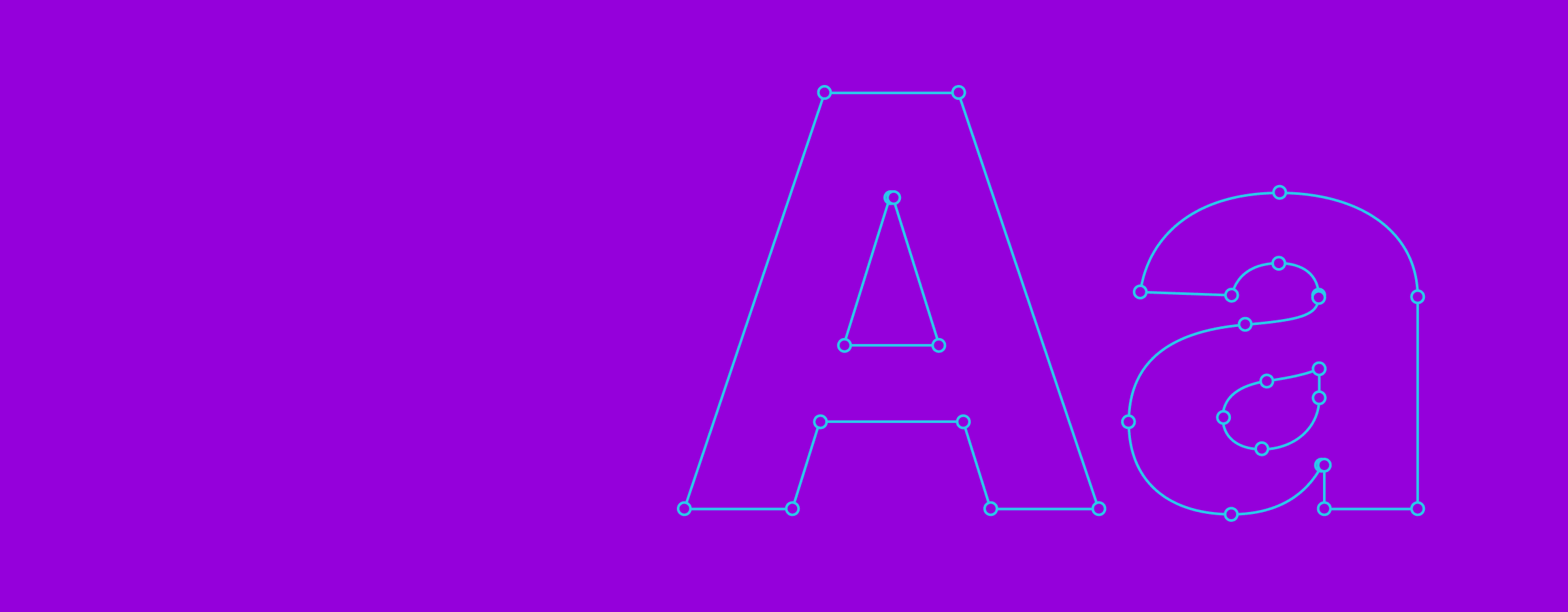
Crafting an eye-catching graphic design resume can feel like an endless endeavor. We’ve researched how to build a winning resume so you can stop wasting time and find your next job.
The sooner you can lock down your graphic design resume, the sooner you can dedicate your energy to applying and interviewing with potential suitors. We have a formula you can follow to expedite the process and create a polished resume that will impress hiring managers in no time.
We’ll walk through everything you should include in your resume to make it stand out and land a graphic design job. We’ll go over what hiring managers look for, resume formatting, and the sections you need to include.
What Do Hiring Managers Look For? .css-14lkgux{color:rgba(42,63,251,1);font-weight:500;-webkit-text-decoration:none;text-decoration:none;opacity:1;-webkit-transition:300ms;transition:300ms;}@media (hover:hover){.css-14lkgux:hover{opacity:0.7;}.css-14lkgux:active{opacity:1;}}
Hiring managers and recruiters are the gatekeepers of your dream job. Your resume is your chance to immediately show off your graphic design skills, relevant experience, and previous projects .
First impressions are everything. Your resume needs to first catch the attention of the hiring manager so you can move onto the interview stage. Then it needs to captivate your interviewer and explain why you’re the right candidate for the position.
Here are a few things to consider before organizing your resume:
Show Off Your Graphic Design Skills
Your resume needs to be visually appealing and well-designed, you’re a graphic designer and this is your specialty. It needs to be easily scannable so a hiring manager can quickly review it and realize the value you provide.
It starts with a clean and easy to read resume layout. Don’t overcrowd the page with too much information. Keep white space and columns throughout your resume.
You can also incorporate a professional-looking color scheme and a clean typography hierarchy. Just remember, keep it professional and don’t try to get too cute. You want to show your skills, but you don’t want to distract the reader and take the focus away from your accomplishments. For inspiration, take a look at our graphic design resumes .
Highlight Your Relevant Experience
While your resume’s overall design is incredibly important — especially for graphic designers — the real meat of your resume is your relevant experience. This is where you let previous projects, accomplishments, and accolades shine.
Your hard skills will be the star of your resume. For example, graphic designers should have experience with programs like the Adobe Creative Suite. You need to convey you’re comfortable with the tools needed for the job, and you should provide examples of successful design projects.
You can also customize your resume to each job you’re applying for. For instance, if you’re applying to a graphic design role that involves designing assets for the web, highlight your web design experience.
Here’s a good example:
- Designed call-to-action imagery for website landing pages, which yielded a 10% improvement in conversion rate
Catering your resume to the job description and being laser-focused on its details will give you an edge over the competition.
Link to Your Portfolio
Your resume is like the bread crumb that leads hiring managers to your design portfolio, which is key for graphic designers seeking work. Portfolios show off your experience and allow readers to see the skill level, type, range, and style of work you can produce.
Make your portfolio easily accessible to guide the reader to dig deeper into your previous work. You’re in good shape if you can wow a hiring manager with your resume and get them to review your design portfolio.
Now, let’s get into the actual formatting and content of your graphic design resume.
Graphic Designer Resume Format
There are a few different resume formats you can choose from: reverse chronological, functional, or combination. Experienced graphic designers should use a reverse chronological resume format because it calls attention to your real-world experience.
Reverse chronological order resumes start with your most recent experience and walk through your different job titles and professional responsibilities. They show your career progression and paint a picture of several years of professional growth.
There are also functional and combination resumes, but these are a better fit for those who are fresh out of college and have less real-world experience.
Functional resumes focus on your skill-set rather than your work history. This format summarizes your capabilities and skills instead of walking through your on-the-job experience.
Combination resumes are a mash-up of a reverse chronological and a functional resume. They highlight your skill-set but still draw attention to your work experience.
Applicants who have little experience, gaps in employment, or are making a career change can explore using a functional or combination resume. A reverse chronological resume will almost always be the right choice for you if you’re confident with your work history.
You should keep your resume to one page if you’re a recent graduate. Those who have many years of on-the-job experience can extend their resume to two pages if needed.
Now, let’s take a look at what sections you should include in your resume.
Sections of a Graphic Design Resume
There are five main sections you must include in your resume: contact information, summary, experience, skills, and education. Start with this essential information before deciding if you should add any secondary information.
1. Contact Information
Including basic contact and personal information is a must. This section is straightforward and should include the following items:
- Current or most recent job title
- City and state
- Phone number
- Portfolio link
Don’t go into too many details like your date of birth or nationality. Stick to the details above, since recruiters only use this section to get in touch with you.
2. Resume Summary
Recruiters spend only seven seconds looking at your resume. These are only a few precious seconds, and you need to capitalize on them immediately. Otherwise, your resume could fall to the bottom of the stack and stay there.
A resume summary is your first opportunity to grab the attention of the reader and leave them wanting more. A compelling resume summary uses two to four sentences to highlight your professional experience, accomplishments, and the value you can provide.
Consider writing something like this:
- Inventive graphic designer with 10 years of experience creating digital assets and print material for Fortune 500 companies. Trusted leader who has managed high-profile creative projects to meet client specifications. Highly proficient in Adobe Creative Suite and user experience design.
3. Work Experience
This is where you get into the specifics of your previous roles. Focus on the responsibilities you held and the successes you had in each position.
Remember to put yourself in the hirer’s shoes. What matters to them, and what experience can you convey that will leave them with no choice but to schedule an interview with you?
Here are the main things you should include in this section:
- Company name
- Dates of employment periods
- Around four achievements from each position
Your achievements should be notable call-outs that will impress the hiring manager. They explain your contributions to a project and what the results were.
You likely have worked on many different projects and played many parts throughout your career. Stick to the three to five most relevant highlights for each position, and tailor them to the job you’re applying for.
Here are what four achievements could look like on your resume:
- Conceptualized logos for businesses in the SaaS and retail industries
- Built a style guide to ensure branding consistency across all teams within the company
- Collaborated with the data science team to produce data-supported infographics that had more than 100,000 shares on social media accounts
- Managed the design and production of quarterly print brochures that were distributed to more than 5,000 potential clients
You can also take a look at some of these graphic design resume examples for ideas.
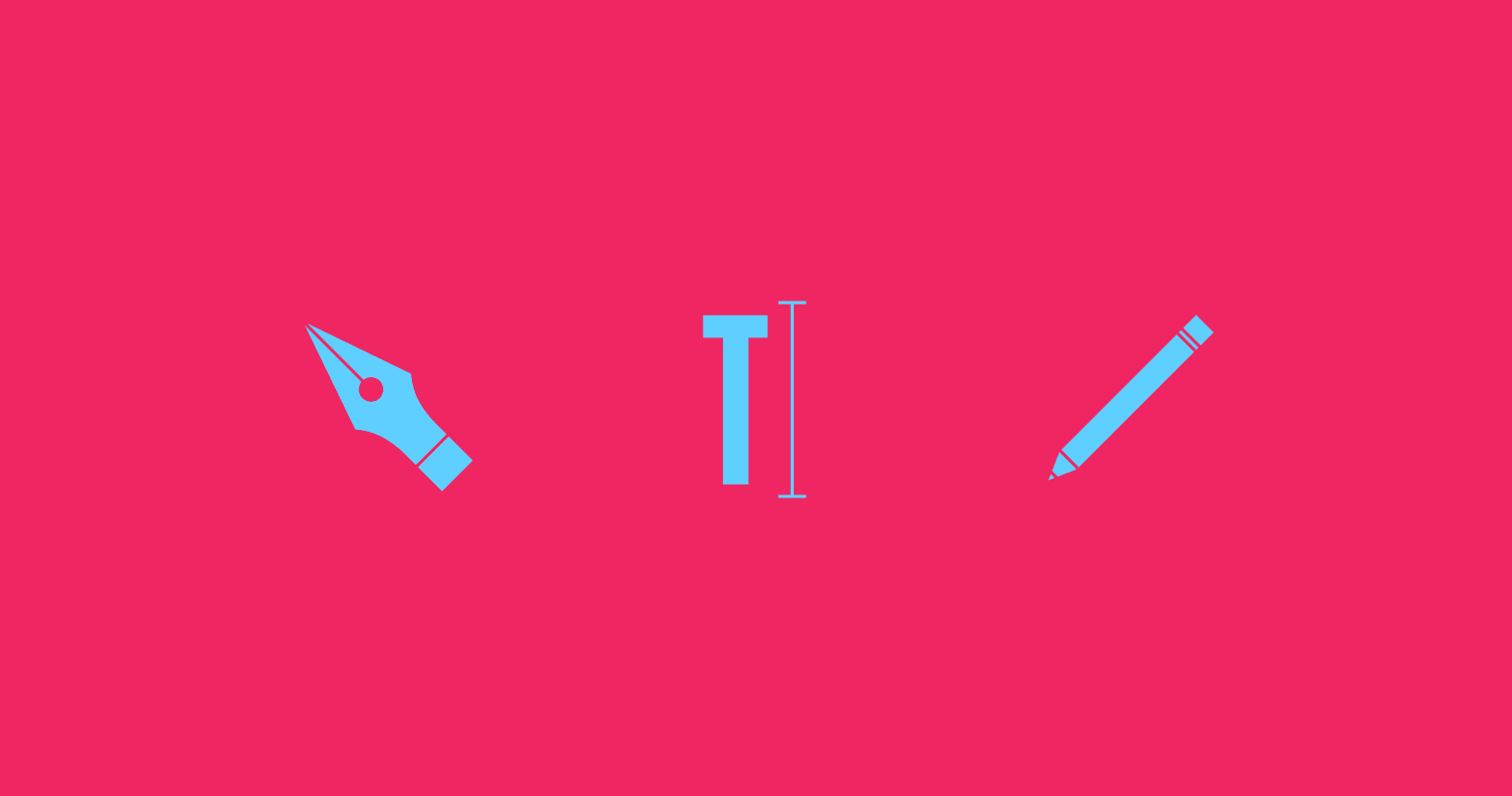
The skills section of your resume is where you primarily highlight the design tools and technical skills you’re comfortable using. You can highlight soft skills in this section, but leave these as your secondary focus.
Hard Skills
Graphic designers use a variety of creative design tools on the job each day. Here are some examples of software and technical skills you can incorporate into your graphic design resume:
- Adobe Photoshop
- Adobe Illustrator
- Adobe InDesign
- Infographic design
- Print design
- Brand identity
- UI or UX design
Soft Skills
Plugging soft skills into your resume isn’t a bad idea, but don’t go overboard. It’s much easier to back up hard skills with tangible proof.
Some great areas to highlight are being self-motivated, adaptable, and accountable. If possible, hiring managers also like to see when you took the initiative to step into a leadership role.
Soft skills can be easily placed in other sections of your resume. Slip them into your summary or work experience section rather than listing them in a bulleted format. Soft skills aren’t nearly as important as hard skills — especially for graphic designers.
5. Education
The other sections of your resume — like the summary, work experience, and skills sections — do most of the heavy lifting. While this section doesn’t need to take too much real estate, it should include the following details:
- Name(s) of educational institutions
- Degree(s) obtained
- Dates attended
You can also supplement this section with academic achievements or participation in organizations. However, if it’s a matter of choosing between these and impactful workplace experiences, opt for the latter.
6. Additional Sections
There are a few secondary pieces of information you can include if you feel like it would strengthen your resume. Only include these if they apply to the job and help show you’re a well-rounded applicant.
- Side projects
- Entrepreneurial endeavors
- Interests and hobbies
- Professional certifications
- Volunteer work
- Languages you speak or write
Now that you understand how to format your resume and how to decide what to include, here are a few pointers to help make your resume stand out from the rest.
Tips To Make Your Resume Stand Out
What will make your resume memorable to a hiring manager? Resumes that are data-supported and engaging will ensure you land an interview.
Support Your Experience With Data
Tie your experience and achievements to hard data whenever possible. This shows you understand that graphic design means much more than producing flashy graphics.
Here are a few ways you can support your experience with data:
- Produced creative assets for Instagram which received over 100,000 impressions
- Crafted masthead images for a website that draws 500,000 visitors per month
- Designed digital display advertisements that garnered a 10% engagement rate
It’s good practice to keep track of these metrics as you progress throughout your career. With a list of these data points, you’ll impress hiring managers with your results-driven mindset.
Don’t Be Boring
The job search can seem like a daunting task. You’re often competing with potentially hundreds of other job seekers who are in the same boat as you. There’s nothing worse than blending in and going unnoticed.
Give your resume some flair, and let your personality shine. An old-fashioned or stale resume won’t get you anywhere. Save yourself the hassle and design something beautiful, modern, and unique. Check out this resume format to give you an idea of what you can create.
Designing a Resume That Earns an Interview
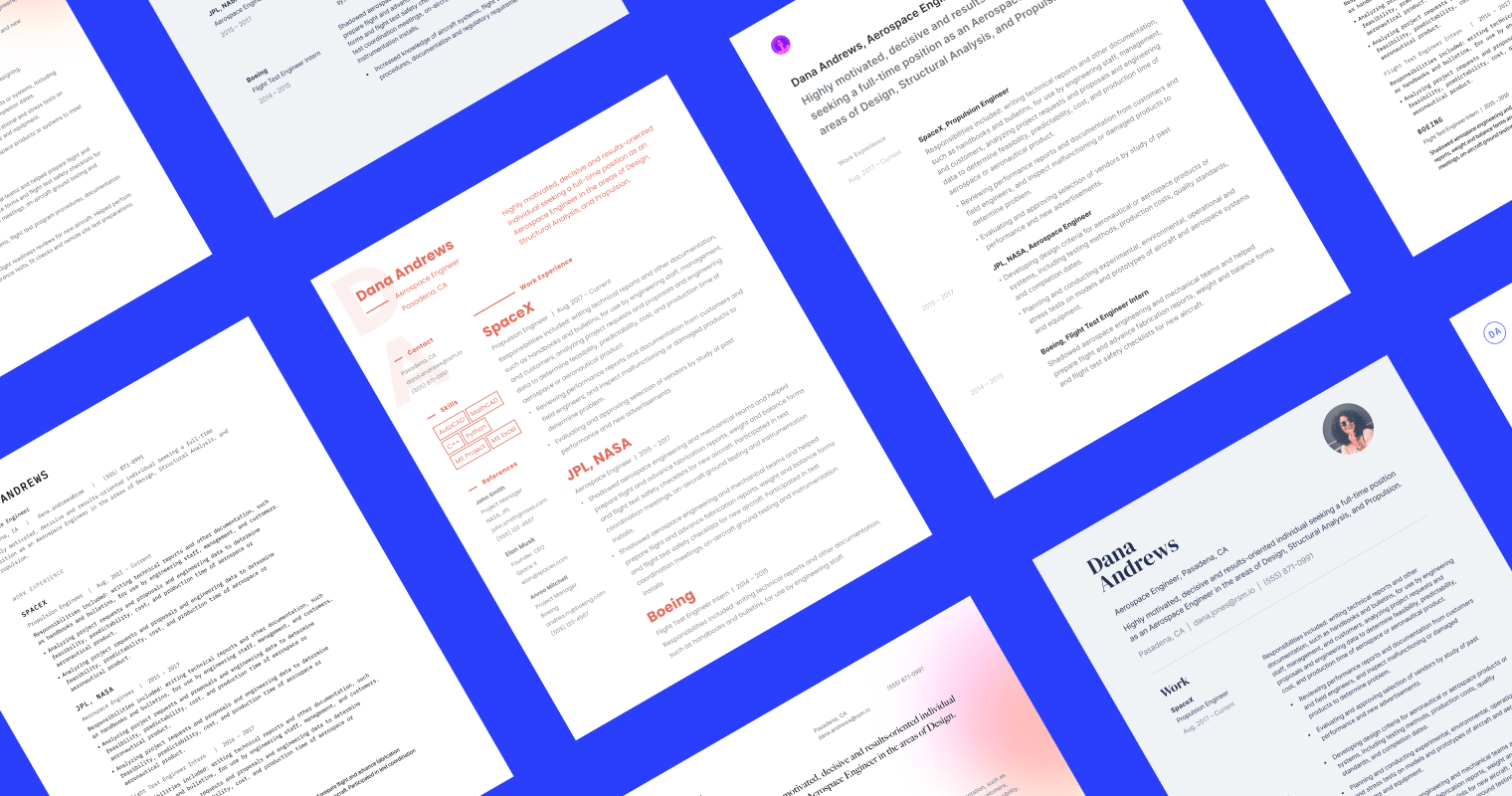
You have the graphic design skills and creative vision. The only thing left is a solid resume that shows off your skills. You'll need a modern and beautifully crafted resume if you want to shorten your job search and land your dream graphic design job.
Your resume is your first opportunity to show hiring managers your design abilities. You can use our resume builder and choose a hiring manager approved resume template to maximize your chances of receiving an offer.
.css-14eyzz{box-sizing:border-box;margin:0;min-width:0;color:inherit;-webkit-text-decoration:inherit;text-decoration:inherit;font-size:inherit;font-weight:inherit;} Remote Jobs

Make Your iOS Developer Resume a Seamless User Experience

How to Create a Software Engineer Resume Hiring Managers Will Love
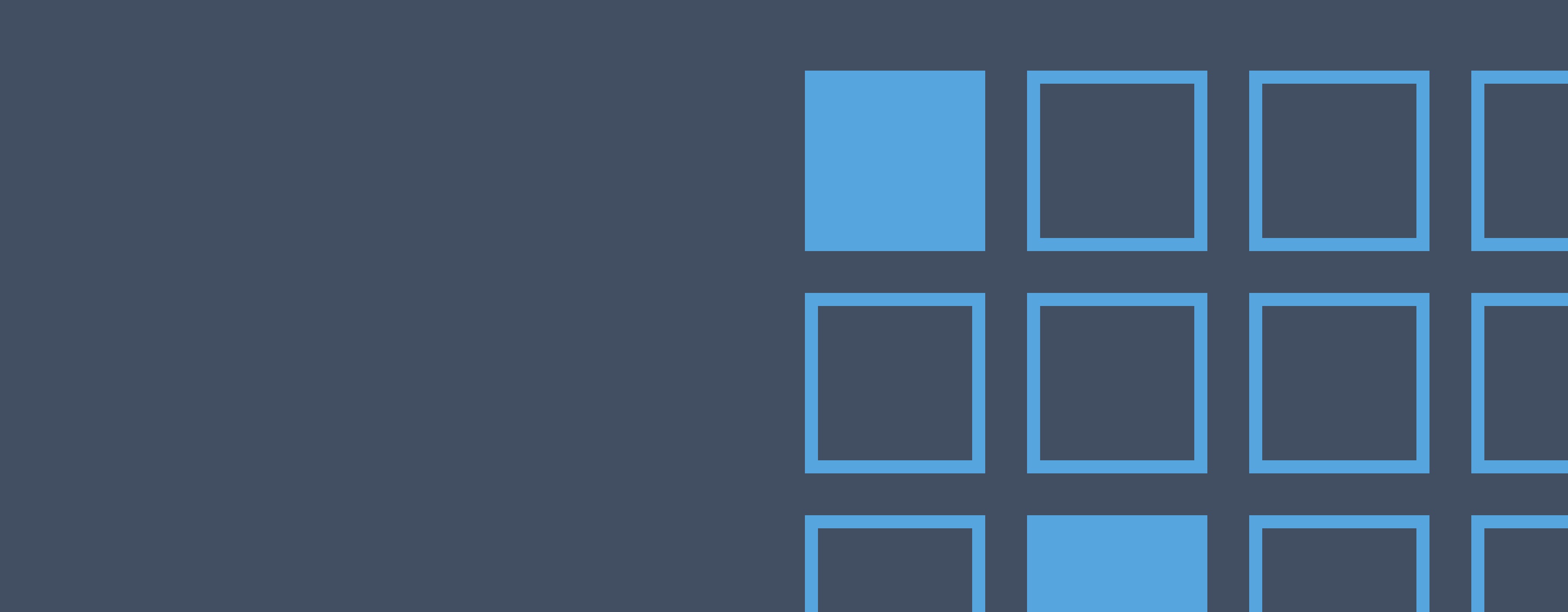
A 5-Step Guide for Writing a Product Manager Resume
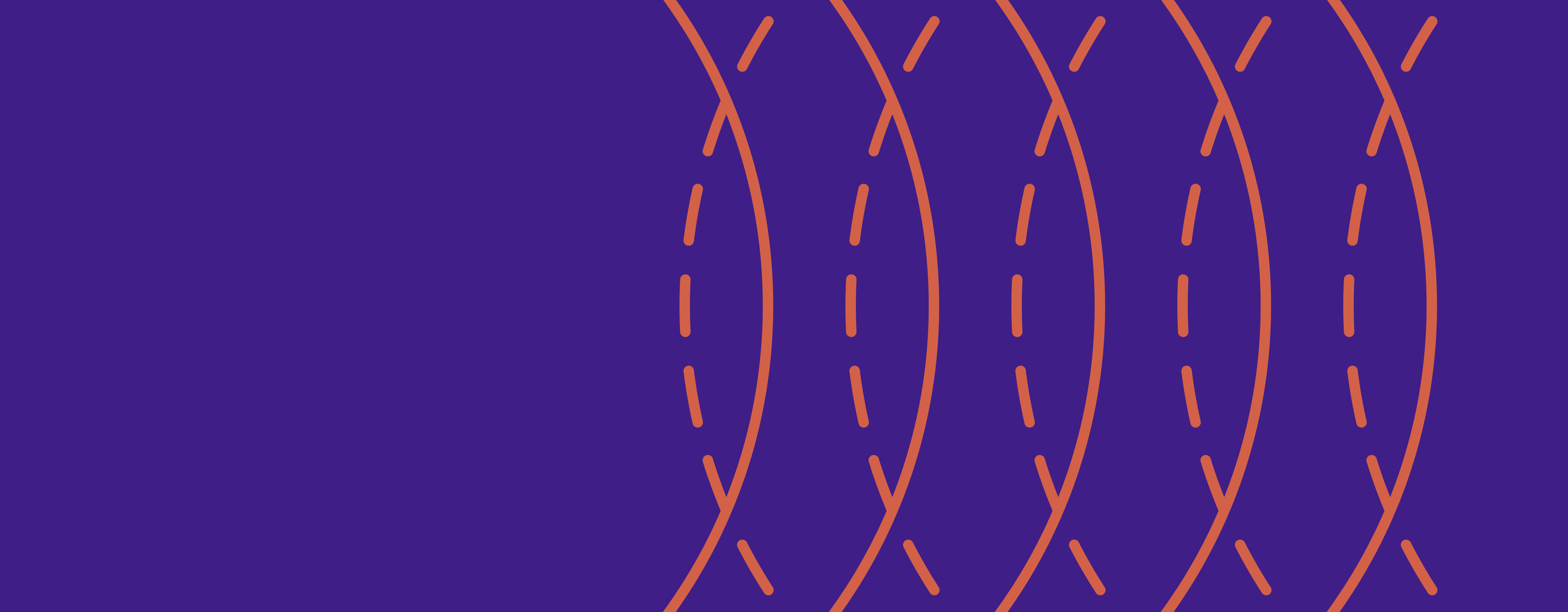
Software Developer Resume: Get Noticed by Hiring Managers
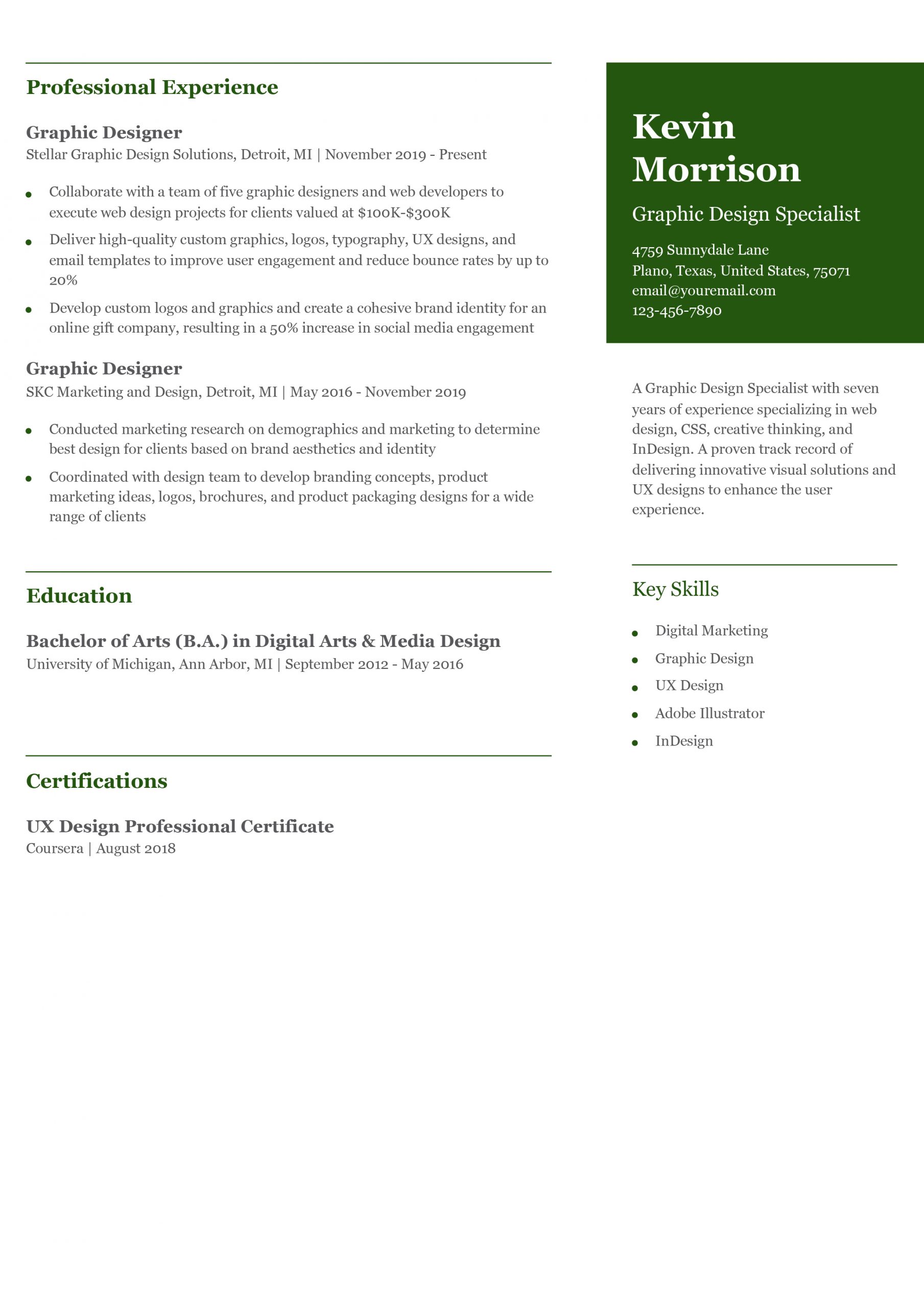
Graphic Design Resume Examples and Templates for 2024

- Resume Examples
- How To Write a Graphic Design Resume
- Resume Text Examples
How To Write a Graphic Designer Resume
Your top-notch portfolio is a testament to your skills and abilities. However, your resume is also critical in complementing your portfolio and showcasing your professional achievements. Ensure your resume highlights your unique strengths and talents to land your dream job . A strong accomplishment-driven resume helps prospective employers better understand you as a candidate and learn why you’re the right fit for the position. We’ll provide expert tips to help you translate your graphic design experience into a professional resume.
- Entry-Level
- Senior-Level
1. Summarize your graphic design qualifications in a dynamic profile
The professional profile is one of the most important sections to focus on as you build your resume. This is often the first thing the hiring manager sees when evaluating your application, so make a strong first impression. In your opening sentence, include your title, years of experience , and three to four specializations that align with the job description. In the following sentences, create a brief snapshot of your career to help hiring managers better understand your industry expertise.
Senior-Level Profile Example
A graphic design specialist with seven years of experience specializing in web design, CSS, creative thinking, and InDesign. A proven track record of delivering innovative visual solutions and user experience (UX) designs.
Entry-Level Profile Example
A creative graphic designer with entry-level experience specializing in web design, motion graphics, brand messaging, and illustration. Adept at developing engaging visual solutions to establish cohesive brand identities for clients.
2. Add a compelling section featuring your graphic design experience
Your professional experience section should primarily be used to establish context for your graphic design projects and achievements. For instance, if you provide graphic design solutions for digital marketing campaigns, consider incorporating monetary figures or metrics to establish a sense of scope for the hiring manager. Although the end result of your graphic design work will always be the primary factor in whether or not you receive an interview, providing additional information for prospective employers can help strengthen your application.
Senior-Level Professional Experience Example
Professional experience.
Senior Graphic Designer, Cadence Marketing Solutions Inc., Boston, MA October 2017 – present
- Manage and lead a team of over 15 designers to produce high-quality marketing materials for web development projects and rebranding initiatives valued at up to $500,000, including graphic design, photography, custom logos, and website design
- Collaborate with clients, senior executives, copywriters, and marketers to define strategic direction for designs based on market indicators and brand identity
- Identify visual solutions for an underperforming retail brand, develop digital marketing materials, and contribute to a 150% increase in sales revenue
Entry-Level Professional Experience Example
Junior Graphic Designer, Lorenna Designs, Seattle, WA December 2021 – present
- Design and develop engaging graphic elements for client websites, social media platforms, and product packaging, including custom logos and illustrations
- Collaborate with clients to develop engaging graphic design solutions based on market trends, brand identity, and target demographics
- Coordinate with two graphic designers to execute a rebranding initiative for a client account valued at $80,000, including creating custom graphics and web layouts
3. Outline your education and graphic design-related certifications
Once you’ve completed a bachelor’s degree in graphic design or digital arts, consider pursuing additional certifications to add to your resume. This is especially important if you’re interested in web development positions. In this instance, you might want to obtain a UX Design Professional certification to show prospective employers you’ve cultivated expertise in the technical side of graphic design.
- [Degree Name]
- [School Name], [City, State Abbreviation] [Dates Enrolled]
- Bachelor of Arts (B.A.) Graphic Design
- Temple University, Philadelphia, PA September 2012 – June 2016
Certifications
- [Certification Name], [Awarding Organization], [Completion Year]
- UX Design Professional Certificate, Coursera, 2018
- Adobe Certified Expert – Adobe InDesign, 2015
4. List key skills and proficiencies for graphic design
To ensure compliance with applicant tracking systems (ATS), incorporate skills and key terms that align with the job description. Companies use ATS to identify qualified candidates using software algorithms based on specific keywords. However, it’s also important to feature appropriate skill sets to show hiring managers you have the ideal qualifications for the role. As you build your resume, showcase your usage of these various skills in your bullet points and professional profile in addition to your skills section:
| Key Skills and Proficiencies | |
|---|---|
| Adobe Creative Suite | Adobe Illustrator |
| Adobe Photoshop | Brand marketing |
| Brand messaging | Client relations |
| Communication | Creative thinking |
| Digital marketing | Graphic design |
| InDesign | Marketing |
| Motion graphics | Print design |
| Project management | Typography |
| UX design | Visual design |
| Visual solutions | Web design |
5. Include your graphic design portfolio at the top of your resume
Although your resume content is important, your portfolio of work will always be the determining factor in whether or not the hiring manager brings you in for the interview. Provide a hyperlink to your website in your contact information section or professional profile. This will ensure prospective employers can easily access and review your portfolio.
How To Pick the Best Graphic Designer Resume Template
Unlike typical resumes, presentation is a critical element of graphic designer job applications. If the hiring manager sees a bland, poorly designed template, this could make for a negative first impression. You may want to create your own resume template, as this could serve as an extension of your portfolio. Whether you select a pre-made template or design your own, be sure to use a top-down approach to keep your document organized even while refining the aesthetics.
Graphic Designer Text-Only Resume Templates and Examples
Skyler Thompson (123) 456-7890 [email protected] www.skylerthompsondesigns.com 123 Windermere Rd., Seattle, WA 12345
A Creative Graphic Designer with entry-level experience specializing in web design, motion graphics, brand messaging, and illustration. Adept at developing engaging visual solutions to establish cohesive brand identities for clients.
- Graphic Design
- Adobe Creative Suite
- Motion Graphics
Junior Graphic Designer, Lorenna Designs, Seattle, WA December 2021 – Present
- Coordinate with two graphic designers to execute a rebranding initiative for a client account valued at $80K, including the creation of custom graphics and web layouts
Graphic Design Intern, SKC Marketing and Design, Seattle, WA May 2021 – December 2021
- Conducted marketing research on demographics and marketing to determine best design for clients based on brand aesthetics and identity
- Coordinated with design team to develop branding concepts, product marketing ideas, logos, brochures, and product packaging designs for a wide range of clients
Bachelor of Arts (B.A.) Graphic Design University of Washington, Seattle, WA September 2017 – May 2021
Kevin Morrison (123) 456-7890 [email protected] www.kevinmorrisondesigns.com 123 W Adams Ave, Detroit, MI 12345
A Graphic Design Specialist with seven years of experience specializing in web design, CSS, creative thinking, and InDesign. A proven track record of delivering innovative visual solutions and UX designs to enhance the user experience.
Graphic Designer, Stellar Graphic Design Solutions, Detroit, MI November 2019 – Present
- Collaborate with a team of five graphic designers and web developers to execute web design projects for clients valued at $100K-$300K
- Deliver high-quality custom graphics, logos, typography, UX designs, and email templates to improve user engagement and reduce bounce rates by up to 20%
- Develop custom logos and graphics and create a cohesive brand identity for an online gift company, resulting in a 50% increase in social media engagement
Graphic Designer, SKC Marketing and Design, Detroit, MI May 2016 – November 2019
- Digital Marketing
- Adobe Illustrator
Bachelor of Arts (B.A.) Digital Arts & Media Design University of Michigan, Ann Arbor, MI September 2012 – May 2016
Jasmine Brown (123) 456-7890 [email protected] www.jasminebrowndesigns.com 123 Bridge Street, Boston, MA 12345
A Senior Graphic Designer with 10+ years of experience specializing in brand messaging, digital marketing, project management, and UX design. A proven track record of defining high-impact visual solutions to drive brand awareness and sales growth. Adept at building and leading exceptional design teams to execute projects for enterprise clients.
Senior Graphic Designer, Cadence Marketing Solutions Inc., Boston, MA October 2017 – Present
- Manage and lead a team of 15+ designers to produce high-quality marketing materials for web development projects and rebranding initiatives valued at up to $500K, including graphic design, photography, custom logos, and website design
Graphic Designer, Aegis Graphic Design Inc., Boston, MA May 2013 – October 2017
- Managed graphic design advertising projects for client accounts valued at $500K-$1M, led graphic designers and marketing teams, and ensured compliance with client requirements
- Created design pitches and delivered presentations to enterprise clients to secure million-dollar contracts with national and international businesses
- Developed custom artwork and layouts for banners, posters, publications, websites, flyers, and print and digital signage
- Creative Thinking
- Project Management
- Stakeholder Management
- Adobe Certified Expert – Adobe InDesign, 2016
- Adobe Certified Expert – Adobe Photoshop, 2016
Bachelor of Arts (B.A.) Digital Arts & Media Design Boston College, Boston, MA September 2009 – May 2013
Frequently Asked Questions: Graphic Design Resume Examples and Advice
What are common action verbs for graphic design resumes -.
It’s easy to run short on action verbs to accurately convey your professional experience. However, using the same verbs repeatedly may cause your bullet points to appear redundant. Differentiating your usage of action verbs will help to improve the reading experience and keep your content fresh. We’ve compiled a list of action verbs you can use during the resume-building process:
| Action Verbs | |
|---|---|
| Analyzed | Built |
| Collaborated | Conducted |
| Consulted | Coordinated |
| Created | Delivered |
| Designed | Developed |
| Drove | Enhanced |
| Generated | Identified |
| Illustrated | Implemented |
| Led | Managed |
| Performed | Presented |
| Supported | |
How do you align your resume with a job description? -
According to the Bureau of Labor Statistics , jobs for graphic designers will grow by 3% from 2021 to 2031, which amounts to over 24,800 new openings each year. Many companies need skilled graphic designers to help them define engaging visual assets for their brands. Although the number of positions is expected to grow, you’ll still need to align your resume with the job description to differentiate yourself from the competition.
For example, if a company is seeking a graphic designer who excels in web development, highlight your knowledge of UX design principles on your resume. Say an organization is seeking a candidate with a strong background in social media marketing. You’d emphasize specific examples of you creating visual solutions and graphics for digital marketing campaigns. By tailoring your resume to the job description, you’ll significantly increase your chances of landing your next job interview.
What is the best graphic design resume format? -
Utilize a reverse chronological format for graphic design resumes in most instances. This places your most recent experience at the top of the document for the hiring manager to review. There are exceptions to this rule, however. For example, if you’re graduating from college and are currently working outside of the industry, showcase graphic design projects you worked on as a student at the top of your document instead. It’s also best to avoid using a functional resume format even if you lack industry experience, as skill-based resumes are largely outdated in modern hiring practices.
Craft your perfect resume in minutes
Get 2x more interviews with Resume Builder. Access Pro Plan features for a limited time!
If a prospective employer asks for a cover letter, carefully tailor it towards that specific organization. In the middle paragraphs, mention something about the company’s reputation or their type of work and why this draws you to apply for the position. Not only will this show hiring managers that you’ve done your research, but it will also send a clear message you’re genuinely interested in the position. For more information, you can view our graphic designer cover letter guide .

Frank Hackett
Certified Professional Resume Writer (CPRW)
Frank Hackett is a professional resume writer and career consultant with over eight years of experience. As the lead editor at a boutique career consulting firm, Frank developed an innovative approach to resume writing that empowers job seekers to tell their professional stories. His approach involves creating accomplishment-driven documents that balance keyword optimization with personal branding. Frank is a Certified Professional Resume Writer (CPRW) with the Professional Association of Resume Writers and Career Coaches (PAWRCC).
Check Out Related Examples
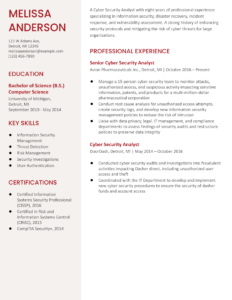
Artist Resume Examples and Templates
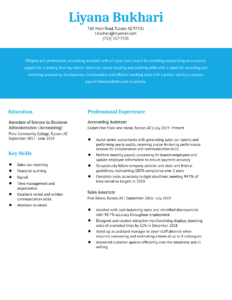
Illustrator Resume Examples and Templates
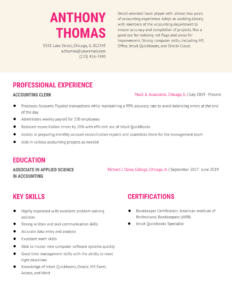
User Experience (UX) Designer Resume Examples and Templates

Build a Resume to Enhance Your Career
- How To Add a Resume to LinkedIn Learn More
- How To Build a Resume Learn More
- How To List Your Education on a Resume Learn More
Essential Guides for Your Job Search
- How to Write a Resume Learn More
- How to Write a Cover Letter Learn More
- Thank You Note Examples Learn More
- Resignation Letter Examples Learn More

WEBSITE ESSENTIALS
Graphic design resume examples and tips
- Suzanne Scacca
- Jan 17, 2023
- 11 min read

When you create a website or an online portfolio , it is a great way to demonstrate your visual design skills, many potential employers and clients want to know more about what makes you uniquely qualified to design for their brand. A graphic design resume provides this proof of experience and expertise, including your work experience, training, range of abilities and everything else that makes you.
Today, we’ll look at inspiring graphic design resume examples by professionals to help you gain inspiration. Plus, we'll provide tips on how to make a graphic design resume of your own and why these personal website examples are an important asset to have when a prospective employer or client comes calling.
Learn more about how to make a website with our extensive guide.
11 graphic design resume examples
Check out these graphic design resume examples from Wix users. Below, we'll examine what writing and design practices make recruiters and hiring managers stop and pay attention.
Wylona Bouwens
Kendall Brandt
Toni Bonini
Virginia Chan
Jennifer Espeseth
April McCain
Justin Miller
Elise Van Valkenburg
Saloni Joshi
Marcy Monko
01. Wylona Bouwens
A link on Wylona Bouwens ’s About page directs interested parties to this beautiful one-page resume.
What makes this graphic design resume stand out?
Bold and memorable logo
Clear content hierarchy by color and size
Ample white space

02. Kendall Brandt
Kendall Brandt ’s online portfolio showcases her unique personality and interests, allowing her resume below to get down to business.
Clearly divided content sections
Highlighted "Work Experience"
Succinct, well-formatted, easily-scannable employment descriptions
Efficient, non-crowded layout

03. Toni Bonini
The graphic design resume for Toni Bonini has its own dedicated landing page on her portfolio website.
Web-based format
Linked design portfolio
Energetic, exciting candy-colored branding
Well-labeled, easy-to-read content

04. Virginia Chan
Virginia Chan ’s CV lives on her website, alongside information about the designer as well as her portfolio of work.
Colorful border and clean dividing lines
Easy-to-follow, minimal design
Beautiful typography and subtle hints of color
Well-distributed, balanced content

05. Jennifer Espeseth
Jennifer Espeseth’s About page provides prospective employers and clients with a link to this attractive PDF resume.
Boldly colored and textured design
Easy to scan and read
A broad range of information (e.g. "Key Clients", "Additional Experience", as well as multiple modes of content)

06. April McCain
Although April McCain ’s resume isn’t directly built into her website (there’s a link to the PDF on the About page), it has the same unique flair as her web design does.
Style and personality
Three column layout
Icons in the "Software" and "Things I Enjoy" sections

07. Justin Miller
Justin Miller takes visitors from a dark-themed About page to this bright, colorful and personable PDF resume.
Non-standard size
Strategic use of color, line art and typography
Featured headshot

08. Elise Van Valkenburg
The first call-to-action that visitors encounter on the home page for Elise Van Valkenburg is the invitation to view her easy-to-read PDF resume.
No-frills design and layout
Well-done visual hierarchy and spacing
Efficient use of space
Neatly placed rows and columns

09. Saloni Joshi
Opting for a clean and simple design, Saloni Joshi has formed an impressive graphic design resume.
Two separate typefaces clearly differentiate headers and body text
Minimal color separates the sections in the vibrant design
Succinctly gathered skills and experiences

10. Hili Noy
Specializing in illustration, graphic design and motion graphics, Hili Noy ’s broad skill set is instantly apparent on her unique, eye-catching CV.
Spot-on layout
Generous amount of white space
Different font weights and subtle separation lines
Illustration and icons

11. Marcy Monko
Merging an unconventional approach with a high level of professionalism, illustrator and design Marcy Monko 's resume certainly stands out from the crowd.
Bright, playful colors
Hand-lettered logo
Cohesive branding with website

Why you need a graphic design resume
First impressions matter a good deal when employers and recruiters determining which resume to focus on next. In 2018, a study from Ladders analyzed how long recruiters spend looking at resumes and which details they focus on. The results proved that on average, it takes only 7.4 seconds to make up their mind about a potential applicant.
When a new job or gig opens up, you can compete with between dozens to hundreds of other graphic designers working today. To stand out amongst candidates whose experience might look similar to your own, you need a polished graphic designer resume.
Your resume provides a prospective employer or client with relevant details regarding your experience, including:
Areas of expertise
Achievements
When paired with an impressive portfolio of work, a professional resume will allow prospective clients to have a more well-rounded view of your personality, professional experience and capabilities. Ultimately, a good resume is a necessary asset for landing interviews and higher-quality job offers.
What to include in your graphic design resume
When recruiters and employers scan resumes for important details, they often look for this information first:
Name and location
Current title and employer
Previous job
Dates of employment
While your resume should include these fundamentals listed above, a graphic designer's CV is also an opportunity to stand out. To give potential employers deeper insights into what it's like to work with you, consider including some of these details as well:
By creating a cohesive visual style for your personal brand, prospective employers can effortlessly move between your resume, portfolio and website. Even if create your resume on a PDF outside of your website, keep the branding consistent with your logo, colors, typography and other marketing assets.

Try this Creative CV template
Contact info
This is a small yet crucial part of your resume that should, at the very least, consist of your phone number, email address and website (when relevant). Some people also choose to also add their home address, but this isn’t a must.
In today's job market you may want to include links to your social media accounts as well, since these are commonly looked at as professional assets that give offer a deeper dive into your creative and professional capabilities. Depending on the position, some recruiters will want to see an active LinkedIn profile, on top of your ability to manage an active Instagram, TikTok or Facebook account.

Your resume's "Summary" section is like an elevator pitch—summing up your experience as a graphic designer, your major achievements, as well as your mission going forward. As you can see in the graphic design resume example below, a paragraph of between two and three sentences is sufficient and a great way to introduce your work.

Past experience
A section on employment history will always provide the bulk of a graphic designer’s resume. It includes a reverse chronological list of your most relevant and recent employment or freelance work.
Each item in this section should include the following details:
Employer or client (if relevant)
Location (if relevant)
Start and end dates
One-paragraph description
You may also want to add a bulleted list of key achievements to each role, and when possible, quantifiable data to support these achievements.

Try this Business CV template
This section details all of your relevant educational experience—from formal training at a college or university, to short-term courses and certifications you’ve earned along the way.
Each item will include the following:
Academic institution or program
Start and end date
Degree or certificate awarded
If you find it valuable, you can also provide a description of the program and your personal academic achievements.

Recruiters and employers will carefully look for a well-rounded set of skills on a graphic designer’s resume. When building yours, include both hard skills and soft skills that prove you'll be the right person for the job, and don’t forget to include tools and software that you're proficient in.
Hard skills to list on a graphic designer resume include:
Adobe-certified professional
Typography specialist
Storyboard creation
Logo design
User interface design
Soft skills to list on a graphic designer resume include:
Communication
Organization
Problem solving
Time management

Try this UX designer template
Awards (optional)
If you’ve received recognition for your graphic design work, include a list of awards and press in this section, along with the organization who issued it and the date each was received.
Memberships (optional)
Let prospective employers know about professional memberships you participate in, conferences you’ve attended, and meetups you’ve organized. Even if you're a freelancer working on your own, you'll make a positive impression by highlighting teamwork, a desire to learn from others, and collaborative skills.
Languages (optional)
If you design for brands around the world, highlight your multilingual capabilities to give yourself a competitive edge and grab even more opportunities.
Interests (optional)
While your professional website will give prospective clients or employers a good idea of your character, you may want to devote leftover space on your resume to your interests.
How to create a graphic design resume in 10 steps
By now, you know that a graphic design resume is the key to landing high-quality work. When you go off and create your own, make sure to follow these 10 steps on how to write a resume and design an effective one.
Build your personal branding
Create 2-3 types of resume formats
Start with a graphic design resume template
Keep the design simple
Use legible typography
Tell a logical story
Make your content "skimmable"
Choose your words wisely
Check spelling and grammar
Tweak your resume for each application
01. Build your personal branding
A graphic designer without a clear visual style to show potential clients is like a web designer without a website of their own. Before you do anything else, focus on your branding by creating your own logo , and narrowing down your personal brand's colors, typography, visual style and tone of voice.
Visually communicating your design experience to hiring managers is a critical part of the hiring process, so it's also crucial to make sure your own website and portfolio reflect your style. If you're just beginning the process of creating a personal website , check out these personal website examples for inspiration.
02. Create 2-3 types of resume formats
You can get your resume into the hands of a prospective employer or client in three different ways:
Give them a hard, printed copy of it in person.
Share a PDF file with them online—via email, a job submission platform or on your portfolio website’s About page.
Point them to a dedicated resume website or landing page.
While you might not need a printed version of resume, every designer should have a digital version available. A PDF resume gives you something tangible to share and upload. If you apply to jobs over email or third-party platforms, you’ll find that many employers request a resume in this format.
One of the benefits of creating an online resume in addition to a PDF, is that it allows prospects to learn who you are (from your About page), see samples of your work (from the Portfolio page) and then dig deep into your professional background (from your Resume)—all in one place. Secondly, search engines can index and rank online resumes, which means that employers searching for candidates via Google can discover you that way.
03. Start with a graphic design resume template
If you want to spend more time on writing and branding and less time laying your content out, use a resume website template .
In addition to kick-starting the process, resume and CV website templates can provide you with inspiration. And as you can see from the graphic design resume examples above, you can lay out and style your CV in many different ways.
04. Keep the design simple
While a common practice is limiting a resume to one page, two-page resumes are becoming more common and acceptable for those with more professional experience. Depending on the length of your design career, you might feel limited in how much and which pieces of information you can share.
But whether it's one or two pages—you don’t have a lot of space to work with when it comes to creating resumes. So when designing your own, keep it simple. Use colors, lines, white space and borders to create a visually interesting layout. Also, keep in mind that the only images you should add to your resume are your logo or headshot.
05. Use legible typography
Although you can use fancy and experimental fonts in logo design and in some parts of your website, that type of typography should be avoided on a resume. Since font sizes on a CV should range between 12 and 20 points, your main focus should be on using highly readable fonts.
For the paragraph text, we recommend you use system fonts like:
Times New Roman
For headline fonts, you can get a little more creative. Still, it's a good idea to skip the handwritten and futuristic fonts, opting for typography from serif and sans serif families.
06. Tell a logical story
According to research by Nielsen Norman Group , people’s eyes follow four patterns when glancing at a page. In each of these patterns, their focus always starts at the top, so place the most important information on your graphic design resume's header, including:
Then, use what you know about recruiters to lay out the rest of your story. For example, you may find that employers look for "Employment" and "Education" sections first. Those should generally appear directly below the resume header content.
From there, fill in the remaining space with your most important and impressive details. Depending on how much experience you have, you might feel as though you need to fill more than a page. In the past, many professionals felt discouraged from doing so. This often meant leaving off relevant info or trying to cram all of it into a single page—neither of which is ideal.
However, recent data from Zety suggests that recruiters prefer resumes that are longer than a page. According to Zety’s research, the average resume length is 489 words. One page is about 380 words, so it appears that many resumes these days break that single-page mark.
What’s more, recruiters are 1.4 times as likely to choose an applicant that has a two-page resume for entry-level work and 2.9 times as likely for a more experienced position. 77% of employers also prefer to hire seasoned professionals that have a two-page resume.
07. Make your content "skimmable"
It takes about seven seconds for a recruiter or employer to decide if they like you as a candidate. To make a positive impression in that time span, make it easy for recruiters to get a bird’s-eye view of your personality and experience. If you do it right, they’ll go on to read the rest.
A clean and well-organized layout will help make your resume more "skimmable", as well the way you structure its content. This includes:
Writing no more than a paragraph of text for each point under the sections "Summary", "Employment" and "Education".
Creating a distinctive hierarchy where headers and sub-headers are bigger and bolder (and even more colorful) than the other text.
Using bullet points to list out points (like under "Key Achievements") rather than writing full paragraphs.
08. Choose your words wisely
According to a Cultivated Culture analysis, 51% of resumes include cliches, buzzwords and other poorly chosen words that can all-too-often frustrate recruiters. You want to avoid this by carefully choosing the words used in your resume.
For starters, leave out the words that are exhausted and overused on today's resumes, like these from CareerBuilder :
Extensive experience
Organizational
Responsible
In some cases, you should avoid using jargon as well. While words and phrases related to design systems, principles and processes might make sense to you and impress certain clients, they may confuse recruiters. Instead, use clear, concise and accurate copy, including action verbs to describe your day-to-day and capabilities.
09. Check spelling and grammar
Before you send out your resume or publish it on your website, proofread it. You can use a friend, colleague or an AI grammar tool to check for spelling and grammatical errors. It's also helpful to read your resume out loud, helping you spot awkward phrasing or run-on sentences.
10. Tweak your resume for each application
According to information from CareerBuilder , 54% of applicants don’t send a custom resume for each job or gig application. If you want to stand out from the pool of graphic designers sending the same resume to every job opening, then personalize yours.
You don’t need to worry about redesigning your resume each time you send it out. It's enough to update the following sections to ensure your pitch aligns more specifically with the job you're applying for:
Your resume "Summary"
The "Skills" section
Other sections like "Awards," "Memberships" or "Languages" that can differentiate you from others
Also, read through the job description carefully and make note of relevant keywords and skills the employer might look for. If you can update your resume's "Experience" or "Education" sections with some of those terms, do it.
Related Posts
8 best graphic design websites for impactful inspiration
17 best portfolio layouts for creative professionals
15 illustration portfolios that are brimming with talent
Was this article helpful?
Home / Resume Examples / Graphic Designer Resume Sample
Graphic Designer Resume Sample and Tips from HR Pros
If you are a graphics designer looking to explore new career opportunities, you will definitely need a strong skillset in your niche. On top of that, you will also need a strong application, which, among other things, includes a resume and cover letter.
Below, we will look into how to craft an effective resume and analyze a graphic designer resume example. If you are also looking for tips on how to improve your graphic designer cover letter, check out our Graphic Designer Cover Letter Sample + Guide .
However, before we get into our resume writing guide, let’s have a quick look at what the job of a graphic designer entails.
Graphic designer job description
So, what does a graphic designer do?
The job of a graphic designer covers the entire process of visualizing and creating a variety of graphic materials: illustrations, logos, layouts, and more. Graphic designers are responsible for the visual aspects of websites, books, magazines, marketing materials, product packages, and more.
Some of the key responsibilities of a graphic designer include:
- Developing the concepts for visuals based on established requirements
- Creating illustrations and images either by hand or via professional software
- Testing how the graphics perform across different media
On average, a graphic designer in the United States makes around $57,118 annually, according to Salary.com . The salary range for graphic designers is estimated to be from $45,248 to $72,715. Salaries depend on a variety of factors: education, certification, experience, additional skills, and more.
How to write your resume as a graphic designer
Now, let’s get into the resume writing process. This is where you will start asking yourself: “How do I write about myself as a graphic designer?” Let’s take a look at the graphic designer resume example below.

The resume sample above is written in the so-called functional format that emphasizes professional skills over experience. This format has been chosen because the person is looking for a career change and doesn’t have enough experience in the new field yet.
In a chronological resume format, you will need to list your work experience in reverse chronological order — starting with the latest position. These types of resumes are centered around professional experience and are suitable for experienced professionals with several years of design work.
In a skill-based format (also known as functional), a resume is centered around the skills and expertise that you possess. In these types of resumes, you would spend more time highlighting what you can do and backing it up with certification— rather than focusing on work experience.
Skill-based resumes are suitable for new professionals who may not yet have much work experience — but do possess the skills needed to do a good job. They are also good choices for professions that require a set of specific hard skills in industries like IT, science, medicine, etc.
As we’ve mentioned, the resume above uses a functional format. This means that it is more focused on skills and expertise.
A hybrid resume format is a combination of both formats above and uses all of the above elements.
The three formats above are the most popular ways of organizing your resume and are well recognizable by HR managers. You can learn about them in Top Resume Formats: Tips and Examples of 3 Common Formats .
As you can see, there are several key sections in our resume example above. These are:
Resume header
Professional summary, professional skills.
- Professional Experience
Certifications
- And Education
Let’s take a look at each of the sections above in a bit more detail and see what information should be included in each one.
The header may be the simplest section of your resume. However, even a section this small offers opportunities to present yourself in the best light. Here’s what you can include in your resume header:
- Full name and professional credentials
- The country and city where you are currently located: this can help your employer estimate commute time and whether relocation is needed. Do not include your full address.
- The way you want to be contacted: phone, email, etc.
- A link to your portfolio — this will give your potential employer a chance to quickly get acquainted with your work.
- A link to professional social media —including a link to your LinkedIn profile or other professional media is also a useful extra.
This is where you explain to the hiring manager who you are as a professional. Explain your most relevant experience and expertise, your most valued skills, and other qualities that make you a great candidate for the job you are applying for.
As evident in the sample above, the applicant starts by mentioning their extensive experience in the industry, key skills, and personal qualities needed for the job.
This is one of the key sections of your resume. Keep it brief, to the point, and as specific as you possibly can. Mention any relevant certification that you possess, the tools and software you use, technical competencies, industries in which you have experience, and more. This is a good place to use a bulleted list so that this section of your resume stands out to your potential employer.
Professional experience
This section of your resume probably needs no explanation. Here, you will need to list your professional experience in reverse chronological order — starting with the most recent position.
When listing your experience, mention the position you held and the company you worked for.
Dedicate a special section of your resume to professional certification — especially if you have a lot to be proud of. Include all relevant certifications in your industry and other fields that may be beneficial in your line of work.
As you can see from the above sample, the applicant mentions both design certification (Adobe Certified Associate) and digital marketing and advertising certification (AdWords).
This is another section that probably requires little explanation. Here, mention your highest obtained degree and the educational institution where you conducted your studies.
Extra tips for writing your resume
Here are a few quick tips for making your graphic designer resume, UX designer resume, etc. more effective:
- Keep your resume brief. It’s best if it’s about one or two pages long. If you have a lot of work experience, your resume can be longer. However, it may also be a good idea to only select the most recent and relevant work experience for your resume.
- Keep in mind that some companies use resume reading software to shortlist the application they will go over personally. These programs are known as Applicant Tracking Systems (ATS) — and large companies that receive a lot of applications often use them. To make your resume ATS-friendly, you will need to understand how Applicant Tracking Systems work. Here’s how: Applicant Tracking Systems are designed to screen resumes based on the specific requirements outlined by hiring managers for this position. If no matches are found, the resume may be rejected and never make it to the hiring manager’s desk. To make sure your resume is not rejected by an ATS, carefully go through the job description/ad that you are applying for and try to use the same keywords and phrases in your resume.
- Use a clear format. Hiring managers are typically very busy people — especially if you are applying for a job in a big company. They will genuinely appreciate it if you make their task easier and use a clear and easily readable format for your resume. This can also be a way to showcase your organizational skills to your potential employer. Select a clean readable font, eliminate any unnecessary blank space, use bullet points to highlight key information, etc.
Learn more about how to write a resume .
Summing things up
So, here’s the key take-away. An ideal graphic designer resume should be clean, clearly formatted, ATS-friendly, and show the recruiter that you are the best person for the job. Keep to a clear structure that includes a professional introduction, work experience, and certification. Make sure to use other sections of the resume for your benefit as well. So, add links to your portfolio or professional social media to the header of your resume.
To complete your application, you will also need an effective cover letter. Learn more about writing a cover letter in our Graphic Designer Cover Letter Sample + Guide .
Graphic Designer cover letter
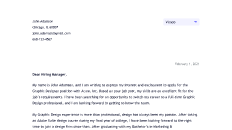
Privacy preference center
We care about your privacy
When you visit our website, we will use cookies to make sure you enjoy your stay. We respect your privacy and we’ll never share your resumes and cover letters with recruiters or job sites. On the other hand, we’re using several third party tools to help us run our website with all its functionality.
But what exactly are cookies? Cookies are small bits of information which get stored on your computer. This information usually isn’t enough to directly identify you, but it allows us to deliver a page tailored to your particular needs and preferences.
Because we really care about your right to privacy, we give you a lot of control over which cookies we use in your sessions. Click on the different category headings on the left to find out more, and change our default settings.
However, remember that blocking some types of cookies may impact your experience of our website. Finally, note that we’ll need to use a cookie to remember your cookie preferences.
Without these cookies our website wouldn’t function and they cannot be switched off. We need them to provide services that you’ve asked for.
Want an example? We use these cookies when you sign in to Kickresume. We also use them to remember things you’ve already done, like text you’ve entered into a registration form so it’ll be there when you go back to the page in the same session.
Thanks to these cookies, we can count visits and traffic sources to our pages. This allows us to measure and improve the performance of our website and provide you with content you’ll find interesting.
Performance cookies let us see which pages are the most and least popular, and how you and other visitors move around the site.
All information these cookies collect is aggregated (it’s a statistic) and therefore completely anonymous. If you don’t let us use these cookies, you’ll leave us in the dark a bit, as we won’t be able to give you the content you may like.
We use these cookies to uniquely identify your browser and internet device. Thanks to them, we and our partners can build a profile of your interests, and target you with discounts to our service and specialized content.
On the other hand, these cookies allow some companies target you with advertising on other sites. This is to provide you with advertising that you might find interesting, rather than with a series of irrelevant ads you don’t care about.
Graphic Designer Resume Sample
Create a well-structured Graphic Designer resume using this ultimate sample. This resume helped a real job seeker land a job at K-Brite radio. The job applicant allowed us to share their resume with you, so that you can make a copy of it at no charge or edit it directly using our proven resume maker.

Related resume guides and samples
How to create an effective database administrator resume
How to build a compelling game designer resume?
How to write a compelling information security analyst resume
How to build a professional IT support officer resume?
How to create a captivating network engineer resume?
How to Compile a 'Bug-Free' Programmer Resume? Here's a 7-Step Guide (+Example)
Graphic Designer Resume Sample (Full Text Version)
Steve dominguez, work experience.
Services in the areas of:
• Video Production
• Digital Marketing
• Website Development
• Social Media Strategy
• Photography & Editing
• Managed and lead a 4-person team in the production of marketing projects, promotional materials (video, photography, graphic design), website design, copywriting and audio/visual needs.
• Developed artwork and layout for print and digital signage, banners, posters, publications and flyers.
• Led in the video production process (Pre-production, storytelling, lighting, set-design, audio, filming, editing, color-correction, exporting).
• Serves as a creative guide for all key projects and events.
• Oversees the organization’s social media brand strategies.
• Consults and trains staff on effective use of technology, SaaS and technical equipment.
Adobe CC Skills
Interpersonal skills, certifications, strengths finder themes, online design portfolio.
www.kickresume.com/cv/steve/
Graphic Designer
A graphic designer is a creative professional who uses computer software to create visual concepts and to clearly communicate captivating, stimulating, and informative ideas. Good graphic designers certainly master Adobe Suite that includes such programs as Illustrator, Photoshop, InDesign, or Animate. However, any extra knowledge makes a difference, and so it is a great advantage for any graphic designer to enrich their skills by learning HTML/Web Design, UI & UX. Thanks to such theoretical knowledge and practical experience, graphic designers effectively turn their rough sketches into brand marks, advertisements, cover images, brochures, magazines, and other outcomes. According to U.S. Bureau of Labor statistics, there are approximately 23,900 openings for graphic designers projected each year in the U.S.

Licensed by the U.S. Federal Communications Commission to broadcast in the HD format, KBRITE is a Southern Californian oldest and largest Christian radio station with its offices in Costa Mesa. The station has been broadcasting a religious music format for more than 35 years, and it's been seeking to educate and motivate their listeners.
Edit this sample using our resume builder.
Let your resume write itself — with ai..

Similar job positions
Events Coordinator / Planner Art Director Digital Marketing Network Engineer Product Designer Photographer Interior Designer Content Manager Public Relations (PR) Marketing Assistant Advertising Manager Database Administrator
Related IT resume samples

Related art / design cover letter samples

Let your resume do the work.
Join 5,000,000 job seekers worldwide and get hired faster with your best resume yet.

Protect your data
This site uses cookies and related technologies for site operation, and analytics as described in our Privacy Policy . You may choose to consent to our use of these technologies, reject non-essential technologies, or further manage your preferences.
- Resume and Cover Letter
- How to Make a Resume:...
How to Make a Resume: Beginner's Writing Guide with Examples
30 min read · Updated on May 22, 2024

Your dream job is one resume away!
Your resume is arguably the most important financial document you'll ever own. And before you think, “Yeah – right” let's consider for a moment. Without a resume, you don't get the job, so you can't pay bills, support a family, go to the big game, have that weekend trip, or plan for retirement. Your resume is the doorway to your future, so let's make sure it's perfect.
Part of making it perfect is remembering that it's a targeted career marketing document – not a chronicle of your life. So, how do you write a resume? In this beginner's writing guide, we'll show you how to make a resume and provide examples of what each section should look like.
Grab a cup of coffee and strap in, because you're about to learn everything you need to know about how to make a new resume!
Table of contents:
The purpose of a resume
Avoid rejection by the ATS
What is your career target?
Build your personal brand, what should your resume look like, how to make a resume – the layout.
How long does it take to put together a resume?
A major resume no-no: typos
How to make your resume more professional
Theory in practice – resume examples
The most basic purpose of a resume is to sell your skills , achievements , and qualifications to prospective employers. This one document can financially make or break you. Let's take a quick look at what being unemployed costs you per day (assuming a five-day workweek):
If you make $40,000 per year, you lose about $155 every day that you're out of work
If you make $50,000 per year, you lose about $190 every day that you're out of work
If you make $75,000 per year, you lose about $288 every day that you're out of work
If you make $100,000 per year, you lose about $385 every day that you're out of work
Clearly, finding out how to make a resume for a job is critical so that you can properly sell your skills, qualifications, experiences, and achievements to prospective employers.
The job market is tough and highly competitive; you have to stand out in a sea of qualified candidates by creating a compelling narrative that tells a story of value, keeping in mind that your resume is supposed to do a few things for you:
Introduce you to a new company
Underscore how your experiences and education are relevant
Showcase how your skills and competencies will benefit the new company's team
Win interviews
Avoid rejection by the ATS
What do you know about applicant tracking systems? Job seeking can be compared to throwing your resume into a black hole. You can go through 100 listings on any job search website and complete the online application with zero results.
Ever had that happen? It's okay, it happens to everyone at some point or another!
The problem is that you're probably not putting the correct keywords into your resume. When you hit “Submit” on an online application, it isn't magically emailed to the hiring manager.
Oh, no!
It goes through a computer system that scans your resume for specific keywords that can be found in the job description posted by the company. And, just so you know, approximately 90% of companies use ATS scans , including everything from mom-and-pop shops to Fortune 500 companies.
The companies use these programs because they just don't have time for a human to go through all the resumes they receive. Depending on the job opening, a company can get between 250 and 500 applicants . Can you imagine being the person who has to sift through all those resumes?
Here is where the ATS steps in. It's designed to weed through candidates to narrow the applicant pool, so that the human hiring manager has a more reasonable resume load to go through. It ranks the remaining candidates in order based on how much of a match they are for the position that's open.
Being overlooked by the ATS is one of the number one reasons job seekers get ghosted by companies.
Once your resume makes it through the ATS and gets into the hands of a hiring manager, don't think they're going to sit down and read each one. Who has that kind of time? You should expect that the first round of resume sorting will consist of them flipping through the stack to pick the ones that stand out within about 6 seconds of glancing at them.
PRO TIP: Put your resume on a table, stand up, and look at it from a little distance. Is it eye-catching? Can you tell the position you're seeking just by glancing at it? Set a timer if you have to, but no more than 10 seconds.
Speaking of eye-catching, don't make the same mistake as a lot of your rival job seekers by being too generic with your resume. It's easy to fall into the trap of thinking that being non-specific will open doors to more opportunities. The problem is that the hiring manager won't be able to tell exactly where you'll fit within their organization.
The first step in winning an interview is being sure that your resume actually makes it into the hands of a human being at the company you apply to. Start by defining what you want to do.
So the first, and most important, step in crafting the perfect resume is to narrow down your target career path. The more specific you are with this first step, the more response you'll receive from hiring managers because they'll be able to tell exactly how you fit within their organization. There are four areas to focus on as you begin to chart your career path:
Industry: Do you want to work in private sector, nonprofit, government, or public roles?
Geography: This one is more in-depth than choosing rural vs urban. It also includes whether you want to work in a dynamic or static environment.
Company size: You may not think it, but having an idea about whether you want to work in a small company or one with thousands of employees is important.
Role: Saving the best for last, you have to know what position you want.
On the surface, it may seem like these things are only important for the job search aspect of landing a new position, but you have to know what voice to write your resume in, too. Part of that is knowing your audience. When you understand your audience, you can build a personal brand that resonates with what they're looking for in a new staff member.
Now that you've gotten your target career path nailed down, the next step is to brand you. Think of yourself as a product and your resume is the packaging. Companies spend a lot of time on their branding and packaging - you have to do the same thing.
The best place to start is with a career assessment . Taking one of these tests can help you to identify your strengths, what sets you apart from others, and key themes of your professional identity. Just like Nike and Coca-Cola have timeless taglines and catchphrases that succinctly define what they have to offer to consumers, your personal brand has to tell a concise, yet compelling, story. This is where your resume comes in.
Your resume isn't just a piece of paper you give to a hiring manager or upload to a website that says, “I'm interested in this job.” Your resume is a personal marketing tool. You shape that tool with words that describe your experiences and achievements, to impress and grab the attention of the hiring manager.
Unlike Nike's “Just Do It” phrase, your personal brand isn't something you build and forget. It is fluid and should be revisited and refined as you gain new skills, experiences, and achievements. Weave the elements of your brand into every section of your resume.
There is a common misconception that entry-level resumes look different than executive resumes. The reality is that the only difference is how much content is available to write about.
Obviously, someone who has little to no experience will have a short resume – generally one page.
When you start to get up to 10 years of experience, then you've earned the second page, so go ahead and use it.
It's not incremental though
Just because you have 20 years of experience doesn't mean you can have a three-page resume. As you work through how to make a resume, remember that a three-page resume should be avoided, unless you have a lot of career extras like publications, research, patents, publications, or public speaking engagements to talk about.
Other than the number of pages, your resume should use the same format and layout no matter if you're applying to a job as someone fresh out of college or seeking to be the CEO of a company.
Chronological resume
The reverse-chronological is the most popular, traditional, and well-known resume format. Its focus is placed on achievements from your career history and is defined by listing your work history starting with your current or most recent job and working backward 10-15 years.
Employers like this type of resume because it tells them what, when, and where you worked. It's best to use this if your work history is steady and shows growth and development. If you're looking to make a career change, have had frequent job changes, or if you're seeking your first job, this may not be the best format to use.
Pro Tip: You could also get lost in the ATS if your resume is over-designed . Many resume writers will tell you that you need to stand out in the sea of sameness by adding some personality to your resume through design. While that's true, you need to avoid heavily formatted resumes which are often rejected by computer scanners as being illegible.
Functional resume
This resume type focuses more on skills and experiences rather than on your work history. It's more of a “what you know and how you apply that knowledge” than a simple list of where you got the knowledge. It plays down gaps in work history and makes frequent job changes less noticeable. If it isn't done properly, though, it can be confusing for the hiring manager to read and understand. There's also a bit of a stigma behind it, because employers know that job seekers use this style to downplay job-hopping. So, the first thing they do when they get a functional resume is check employment dates. If you can avoid using this style, it's best to do so.
Combination resume
There is another resume format that focuses on skills first and then experience last. It's the combination resume, which is sometimes called a hybrid resume. This is the most complex resume type and the best resume for mid-career professionals who are transitioning into another career or for people who have special skills and a strong track record of accomplishments. These types of resumes do take a long time to read and some hiring managers won't take the time unless they're looking to fill a hard-to-fill position.
Curriculum Vitae
Curriculum Vitae (CV) is Latin and means “course of life.” It's a little different from a resume, but some positions require a CV over a resume. The first thing you would notice is that a CV is significantly longer than a resume. A resume is a self-branding document meant to portray your experience and achievements in a concise and easy-to-read format. A CV goes much further into the depth of your education and accomplishments (think publications, awards, and honors) and even has a section for you to include "Areas of Interest."
The best way to describe a CV is that it's a career biography. The biggest significant difference is that a CV is arranged chronologically in a way that gives a complete overview of your full working career. It also doesn't change based on the career or position for which you're applying.
Layout
To make things easier for the hiring manager to digest the content of your resume, it should be laid out in a specific way to ensure that the right information is in the right place.
Hiring managers don't READ resumes. They skim through until they find something that piques their interest and then they stop to read
Contact information
Title
Professional summary , core competencies, experience , education and credentials , awards, certificates, and volunteer work .
Since the reverse-chronological resume is the one that the majority of people will use to apply for jobs, and because it's the format that hiring managers want to see, we'll focus this article on showing you how to make a resume using that style.
Current contact information
Location | Phone | Email | LinkedIn | Portfolio (if applicable)
You can be creative and use bold font in your contact information and even put a border under it to separate it from the body of your resume.
- Name: Be sure to list your name the same across all professional documents (e.g., resume, cover letter, thank you note, LinkedIn profile). Don't get hung up with whether to use your legal name (i.e. the name on your birth certificate or driver's license). Write your name in the manner you want people to address you. Also, if you use any abbreviated credentials after your name (e.g. Jane Smith, MD), remember to include them on all professional documents. You can also include any shortened versions of your name in quotations (e.g. Christopher "Chris" Smith). Just make sure to list it the same way everywhere you put your name.
- Address: It is no longer customary to include your full address on your resume. There have been instances of discrimination against job seekers based on their address. As far as your address is concerned, all you need is the City, State, and Zip Code. A lot of people leave off the Zip Code; however, hiring managers can query the ATS for all resumes within a radius of a Zip Code. If you exclude the Zip Code or put something like, "Greater New York Metro Area," your resume won't be included in the query.
- Phone and email: Put the telephone number and email address where you can easily be reached. Also, be sure that your email address is professional. Using something like [email protected] just won't cut it. The best idea is to use some form of your name. If you're paranoid about having your name in your email address, then you can use some form of the type of position you seek, like [email protected].
- LinkedIn URL: You don't have to spell out the entire URL on the contact line. You can put the words “LinkedIn URL” and hyperlink those words. Before you include your LinkedIn URL, be sure that your LinkedIn profile is optimized for the career you want - because you can bet if they have access to it, the hiring manager will look at it.
- Portfolio: If you're applying for a position like Graphic Designer or Software Designer, you may have a portfolio of work that you want to make available to someone reviewing your application for employment. Include a hyperlink to the portfolio in your contact information.
- Headshot / photo: There is no reason to include a headshot on your resume . Actually, it's seen as taboo and could be the thing that gets your resume rejected, because the hiring manager might assume you think you can get the job based on your looks. However, there are some exceptions, like if you're applying to be a model or actor.
Do you want a hiring manager to be able to tell immediately what type of candidate you are? Put a title at the top of your resume. Center the text on the line, put it in bold font, and put a blank space above and below. The white space and the small amount of words will help it to jump off the page and immediately be noticed. It will also be the first step in helping you stand out in the sea of sameness.
Also, be sure the title on your resume mirrors the title on the job description that you're applying to, but add a bit of panache to it so that it's not too boring. For example, instead of writing “Financial Services Associate,” write “Client-Centric Financial Services Associate Dedicated to Customer Engagement and Revenue Growth.” Just remember to keep it on one line.
The very next thing on the page should always be your Professional Summary. But how do you write a summary for a resume?
It's a three to five-sentence statement about you. Where you've been in your career, where you're going, and how you'll use your experience to get there.
While the professional summary is sometimes referred to as the resume objective , you must remember that the days of writing a resume objective are dead . Never, ever include an objective on your resume. They are a waste of space and don't relay any information that markets you as the best candidate for an open position.
Let's take a look at an example of each:
Sales Representative seeking a challenging position that will use my skills and provide opportunities for growth in a dynamic and rewarding company.
As you can see, the objective is very inward-facing and only talks about what you want out of your career. It provides no value to the hiring manager and eliminates any possibility for them to be able to tell what you bring to the table for them.
Professional Summary:
Ambitious sales professional offering 10+ years' experience in customer retention and aggressive revenue growth. Conquers goals and quotas through a keen awareness of the human buying motive that allows for quickly overcoming objections. Used historical data and consumer trends to reach new customers and grow territory by 24%. Innate ability to work independently or as a member of a cross-functional team.
The best use of resume space is to write a summary of your career. The effectiveness of this summary comes from the fusing of three things:
Relevant keywords – customer retention, revenue growth, and quotas
Hard and soft skills – overcoming objections and working independently
An achievement – 24% territory growth
With this professional summary, the hiring manager will be able to tell in an instant what you have to offer their team.
Even though the skills section of your resume is small, it packs a powerful punch! The skills you list in this section highlight your key abilities and show potential employers what you bring to the table.
It should contain approximately 12 ATS-friendly keywords and phrases that align with the keywords in the job description. Meaning, this is a fluid section that will need to be tailored to every job that you apply to. Technically speaking, your entire resume should be customized to align with each job description. That's one thing that will help you get past the ATS.
Be sure to include a good mix of hard and soft skills because prospective employers not only want to know that you can perform the tasks related to your job (hard skills), but they also want to gain a clear understanding of how you'll fit within the culture of the company (soft skills).
Tips for building your Core Competencies section:
Include skills that are relevant to the job that you're applying to
Avoid creating a laundry list of everything you know how to do – be selective so that the section is more impactful
Group similar competencies together using categories – technical skills, soft skills, and languages
Prioritize your top skills based on their relevance to the job you want
Update frequently
Be consistent with the formatting
Here is a sample Core Competencies list that contains both hard and soft skills:
Core Competencies
Project Management | Data Analysis | Cross-Functional Collaboration | Digital Marketing Strategy | Python Programming | Customer Relationship Management (CRM) | Negotiation | Team Leadership | Business Development | Financial Modeling | Articulate Communication
This section is meant to show how your career history lends itself to the skills you have that make you the perfect candidate for a given job. There are some general rules of thumb on how to make a resume with a great professional experience section:
Don't go further back than 10 to 15 years
Use no more than 3 to 5 bullets per work listing
Incorporate at least 5 measurable achievements per 10 years of experience (the more the better)
Use stacking for companies where you held more than one role
10-15 Years
The 10-15 years of experience is the most relevant – you can list more than that, but avoid using bullet points for roles over 10 years old. Begin by listing your most recent position first and work your way backward to your oldest position, within that 10-15-year range. If you have 30 years of experience, you can use achievements or skills you learned during that time as talking points during the interview. Listing those older experiences on your resume will only dilute the content.
As you write out your bullet points, keep two words in mind: “so what?” The hiring manager is going to be thinking it, you might as well be thinking it, too. Every time you write something on your resume, think, “So what? Why am I writing this? What value will it bring to my new employer? Will this be THE THING that lands me an interview?"
Achievements
Remove “Responsible for…” from your resume-writing vocabulary. That's because it's crucial that you talk about what you achieved, instead of just what your responsibilities were. Let's face it, there are a lot of things that people are “responsible for” that never get done. So, be sure to talk about things you actually accomplished, as that will be the proof the hiring manager needs to take the next step and call you for an interview.
1. Use numbers whenever possible
The best way to call attention to your career accomplishments is to use numbers. Numbers add credibility to your claims and provide a clear picture of what you bring to the table.
Don't write this:
- Conducted cold calls to expand client base
Write this instead:
- Increased sales by 15% by making approximately 20 cold calls per day to expand the client base
The latter makes an unmistakable assertion that you had a positive impact, not only in your role but on the company as a whole. You can take it a step further and talk about things like problem-solving skills and how you addressed challenges to lead to team success. These types of soft skills are highly valued by employers and could be the thing that lands you an interview.
PRO TIP: Use the CAR method for building achievement statements into your resume.
2. Use action words to convey accomplishment
A lot of people make the mistake of copying bullet points from the job descriptions of the roles they've held. This practice makes you sound detached from achievements and focuses more on responsibilities. Using passive language is too generic and doesn't allow a hiring manager to see what you'll be able to accomplish in the new role.
It's better to use action language to show that you're an achiever rather than a doer. Here are some examples of action words you can use on your resume:
Worked with others: Advised, Aided, Assisted, Chaired, Coached, Collaborated with, Consulted with, Helped, Instructed, Interacted with, Mentored, Motivated, Supported
Communicated: Addressed, Advertised, Answered, Briefed, Corresponded with, Debated, Explained, Facilitated, Informed, Interpreted, Interviewed, Persuaded, Responded to
Analyzed data: Assessed, Appraised, Audited, Calculated, Computed, Estimated, Evaluated, Forecast, Inspected, Measured, Researched, Surveyed, Tested
Operated equipment: Installed, Maintained, Programmed, Ran, Serviced, Used
Worked with money or contracts: Administered, Appropriated, Authorized, Balanced, Controlled, Directed, Enforced, Financed, Funded, Governed, Invested, Monitored, Oversaw, Purchased
Organized something: Arranged, Assembled, Catalogued, Compiled, Coordinated, Itemized, Routed, Scheduled, Stocked, Tracked
Created: Composed, Customized, Designed, Directed, Established, Founded, Illustrated, Originated, Shaped
Researched: Analyzed, Collected, Criticized, Detected, Diagnosed, Evaluated, Tested
How to make your professional experience section: The formula
There's a formula for writing your professional experience section in a way that focuses on achievements. You'll start by asking yourself these questions about every job you've had:
What was the name of the company?
What was the title of your role?
What dates were you employed? (*Hint: use the MM/YYYY format for your dates)
What did you do every day? (*Example: Leveraged management skills to direct operations of 5 separate but concurrent projects by delegating tasks to staff based on employee acumen and monitoring / controlling budgets)
What is one thing you did at the company that you're really proud of?
What is another thing you're really proud of?
What is one more thing you did that you're really proud of?
When you put all of that together, it should look like this:
Company Name | MM/YYYY to Present
Position Title
Balanced competing priorities on multiple and concurrent projects and program management initiatives using data-driven strategies in Agile environments. Managed key accounts, onboarded new accounts, and oversaw organizational process adoption for nursing facilities, emergency departments, and pharmacies.
Developed $2M Provider Incentive Program that increased community provider partnerships
Saved $800K by using Six Sigma skills to implement DMAIC approach
Coached and mentored 2 direct reports, creating an open environment of communication that facilitated future-facing decision-making
Many people will create separate sections for education history and certifications. That's not necessary. You can include all of it in one section. You can also include extras like relevant coursework , projects, and achievements. These extras can be truly beneficial for your application if you have little to no work experience.
There are some general rules of thumb for the education section:
Spell out acronyms (BS, MS, PhD) and school abbreviations
It is no longer customary to include graduation dates unless you're still in school or graduated within the last year
Never include high school, unless you're still in high school - listing high school doesn't say “ I finished high school, ” it says, “ I didn't go to college .”
List your degree first and then your school, unless you've obtained multiple degrees at the same institution.
Here's what a regular education section looks like:
EDUCATION AND CREDENTIALS
Master of Business Administration (MBA) | ABC University
Bachelor of Business Administration (BBA) | XYZ University
Six Sigma Black Belt | Council for Six Sigma Certification
If you don't have a lot of experience and need to include some relevant coursework or major projects to inject relevant keywords into your resume, then this is what that would look like:
Relevant coursework: Marketing, Operations Management, Accounting, Corporate Finance
Capstone project: Let a team of 4 to execute a market analysis project to expand the Brooms and Handles company into new regions. Used market and consumer analysis data to identify gaps and achieve a 15% projected revenue increase and a 20% increase in customer satisfaction within the pilot program.
You can include educational information about a degree program even if it's still in progress. Here's what that would look like:
Expected completion: 05/2024
Capstone project: Let a team of 4 to execute a market analysis project to expand the Brooms and Handles company into new regions. Used market and consumer analysis data to identify gaps and achieve a 15% projected revenue increase and a 20% increase in customer satisfaction within the pilot program.
It is important to list what you do outside of work and school. It helps to demonstrate that you're a well-rounded person.
Were you the president of a fraternity or sorority?
Did you get involved with showing new students around campus?
Have you headed a sales team that produced top awards?
Were you an employee of the month?
Do you speak multiple languages?
Did you volunteer for an organization?
Did you perform some major research that ended up being published?
All of these extras allow prospective employers a sneak peek into your life outside of work. They can also go a long way to breaking the ice during an interview, especially if something you do outside work is important or interesting to the hiring manager.
Keep in mind to list only those volunteer positions, projects, or affiliations that are related to your career goals.
How long does it take to make a resume?
If you're going to use the resume wizard that MS Word has, you can slap your information together in a day or two. It will get to employers. The bad thing is that it probably won't get a whole lot of attention.
The "just right resume" can take weeks, because of how much background work goes into it. You'll write it, rewrite it, and write it again, and may even have multiple versions. Ultimately, the exact amount of time that goes into putting your resume together depends on your level of experience, how complex your history is, and the specificity of the job you're applying to.
Entry-level resumes take the least amount of time, simply because there's less information to include
Mid-level resumes take a few days because of the amount of detail in your work history
Executive resumes, or those for specialized positions, can take weeks - especially if you have to do some digging to come up with accomplishments from your previous positions
Updating an existing resume that's well-maintained can be done in just a few hours
While the time spent can seem like a lot, if you're truly marketing yourself for that “just right” position, do you want your resume to say “This was thrown together in a couple of hours using a template” OR do you want it to say “I know this document is important and a significant amount of time was spent on it to make it perfect?”
The first and foremost thing that will get your resume tossed in the garbage can are typos. The number of resumes with errors that are turned in every day to employers across the globe is so astounding that it bears discussing.
You must proofread your resume!
The major problem with typos and grammatical boo-boos is that your eyes will read what you intended to type. So, after you've read through your resume a few times and think it's perfect, get a friend to read it. Make sure the friend is one of those brutally honest types. It's better to get it back marked all over with bright red ink so you can fix it before you send it out, than to send it out and then realize there's a mistake in it.
How to make your resume seem more professional
Lazy words: Do you see words like "etc" or “other duties as required” on your resume? Delete them immediately. If you take shortcuts in the language of your resume, hiring managers will wonder if you'll be taking shortcuts at work.
Cookie cutter resumes: Your resume has to stand out. Because of that, you should avoid throwing something together that you find a sample of online. Make it yours, make it represent you. Many people rely on the resume wizard that comes loaded with MS Word and, while that is a good tool to use to help you remember the sections to include, it shouldn't be the end-all-and-be-all of your resume design.
Specificity: You've had three jobs in the last 10 years and you've listed every detail of everything you've done during your tenure at those jobs. That makes you a Jack (or Jackie) of all trades, but a master of nothing. You have to be specific to the job for which you're applying. What value do you bring to that employer for that job? What achievements can you highlight?
Tailoring: Considering the rampant use of ATS by companies big and small, you have to take the time to customize your resume so that it gets past those scanners. Remember to use relevant keywords from the job descriptions throughout your resume.
PRO TIP: You can check to see how to make your resume better! Have it checked against an ATS and get a free, personalized, and professional resume review .
Theory in practice – 10 resume examples
It's one thing to have someone tell you how to make a resume, it's another thing to see an example – proof that all of this information can come together in a practical way that makes sense.
1. Software Engineer resume example
Click here for an example of a Software Engineer resume.
2. Data Scientist resume example
Click here for an example of a Data Scientist resume.
3. Cybersecurity resume example
Click here for an example of a cybersecurity resume.
4. Digital Marketing Manager resume example
Click here for an example of a Digital Marketing Manager resume.
5. Nurse Practitioner resume example
Click here for an example of a Nurse Practitioner resume.
6. Finance Director resume example
Click here for an example of a Finance Director resume.
7. Attorney resume example
Click here for an example of a Attorney resume.
8. Administrative Office Assistant resume example
Click here for an example of an Administrative Office Assistant resume.
9. Information Technology Expert resume example
Click here for an example of an Information Technology Expert resume.
10. Chief Executive Officer resume example
Click here for an example of a CEO resume.
Now you know how to make a resume for your next job!
It may seem like it takes a lot of work to make a good resume, but if you've followed along this far there are a few things that should be ingrained in you that will help you write a professional resume:
Know what you want to do – be specific
Make your resume with the right format
Use a standard layout, whether you are writing your first resume or 50th
Use action words to make your resume stand out
Quantify your achievements to prove that you have what it takes to succeed in a new role
Tailor your new resume to each job
Double and triple-check for errors, typos, and grammar mistakes
If you're still unsure how to make a perfect resume, TopResume has you covered. Our team of professional resume writers has the know-how and experience to write a resume for you that will win interviews.
Recommended reading:
Resume Tricks That Don't Work
What Does Your Resume Really Say About You?
Bad Resume Advice You Should Completely Ignore
Related Articles:
Do Hiring Managers Actually Read Cover Letters?
How to Create a Resume With No Education
Why You Lose When You Lie on Your Resume: Learning From Mina Chang
See how your resume stacks up.
Career Advice Newsletter
Our experts gather the best career & resume tips weekly. Delivered weekly, always free.
Thanks! Career advice is on its way.
Share this article:
Let's stay in touch.
Subscribe today to get job tips and career advice that will come in handy.
Your information is secure. Please read our privacy policy for more information.
Create designs that inspire
Trending searches, productivity, social media, generate stunning ai-powered visuals.
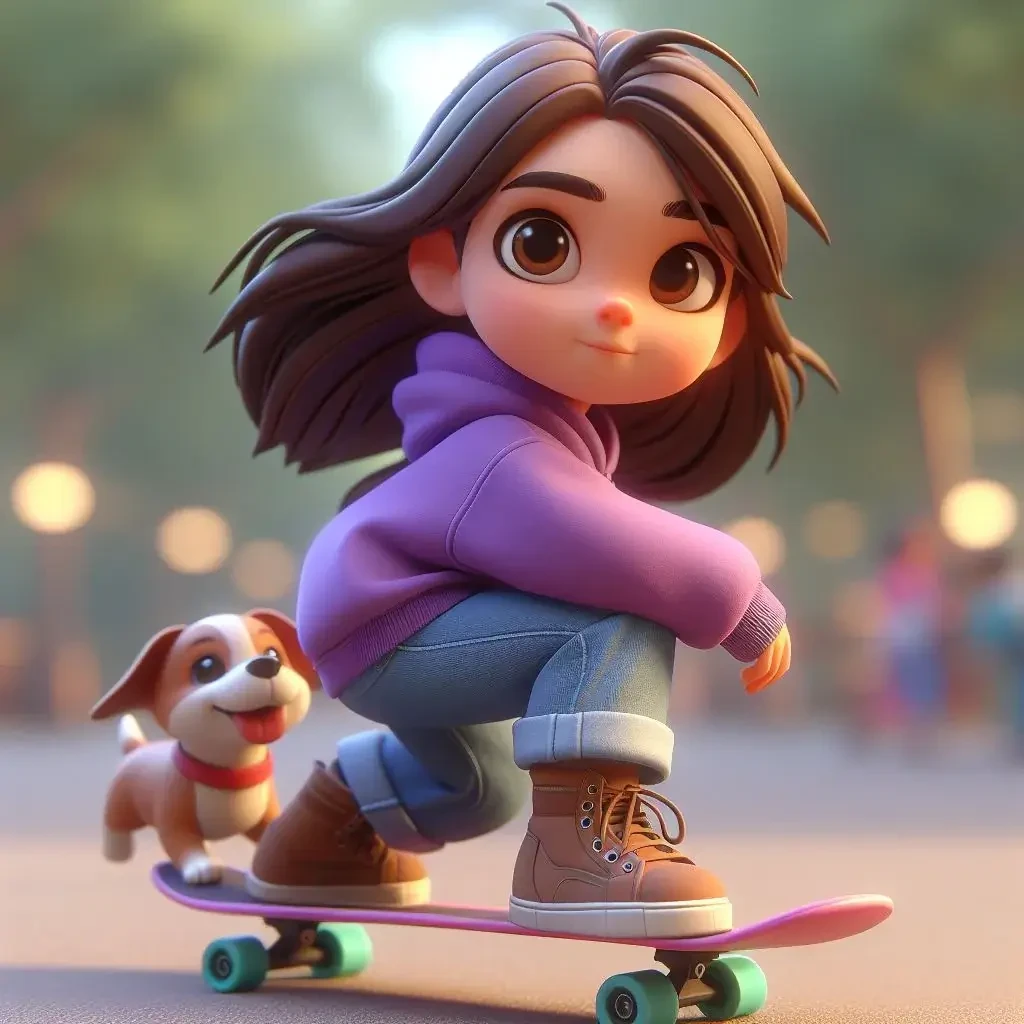
A girl rides a skateboard while walking her dog. The girl is wearing a purple sweatshirt, baggy jeans and boots. She has expressive, round brown eyes and a look of determination. The background is an out of focus park and the girl is in a 3d illustrated animation style.
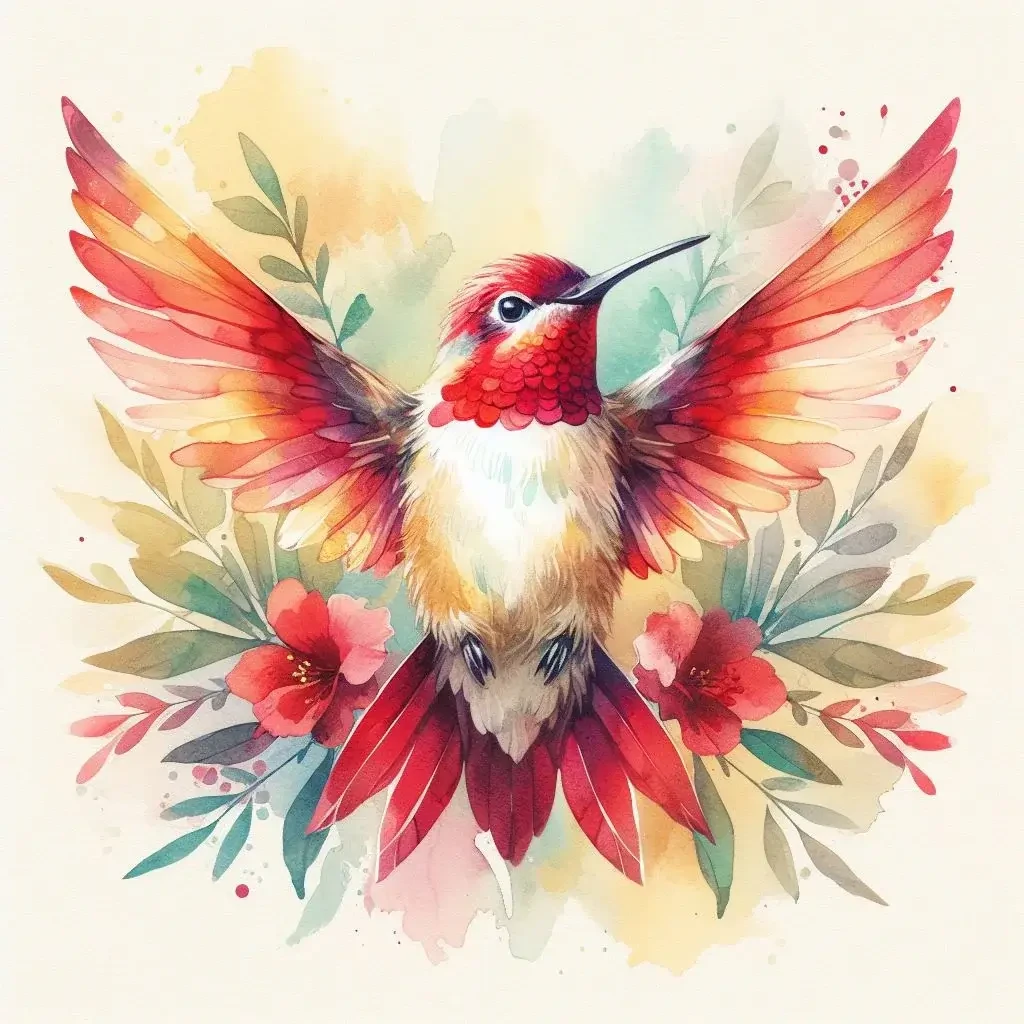
A watercolor hummingbird, centered, in red and yellow with a soft cream, watercolor background.

A banana with sunglasses surfing a blue wave.
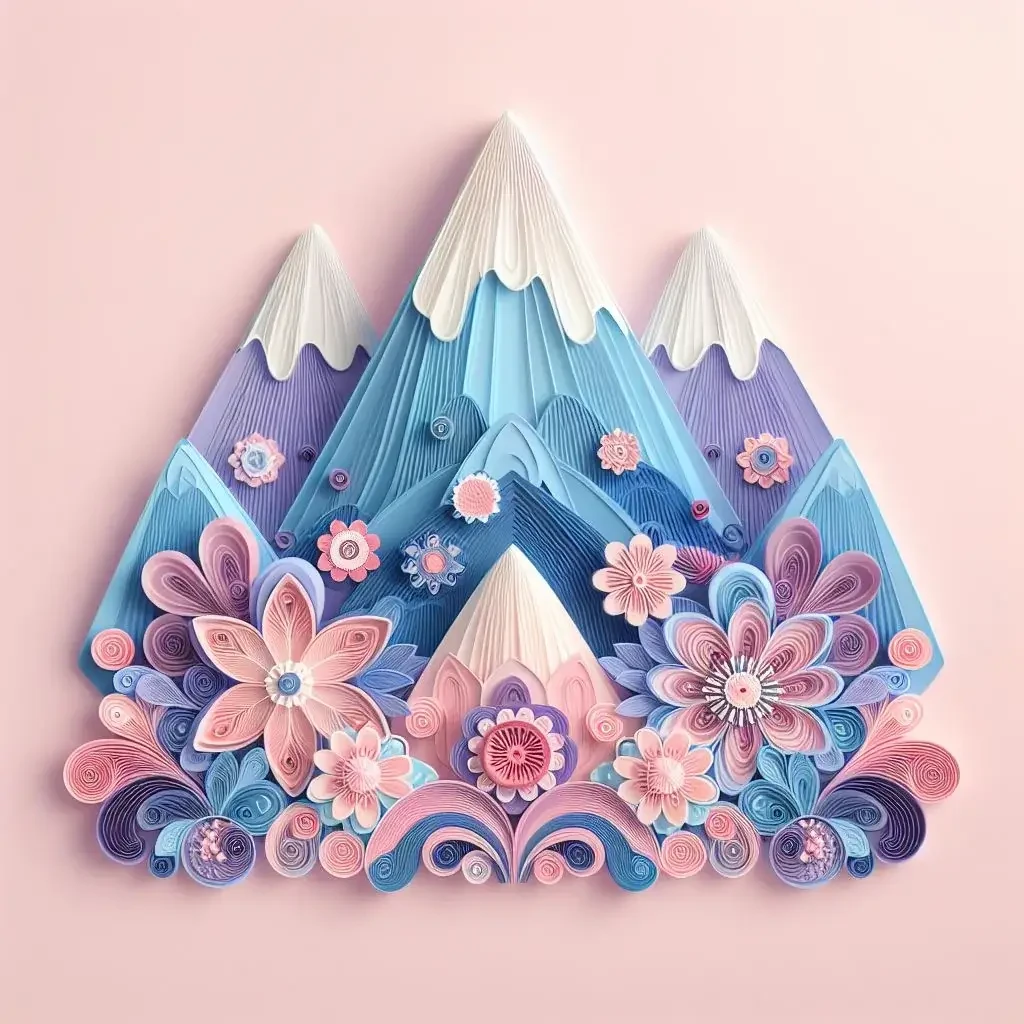
Front-facing view of a mountain with floral decorative elements, papercraft quilling style, in pastel pink, blue and purple colors.

An abstract background of melting liquid with a metallic sheen, dark purple and gold colors with reflective studio light.
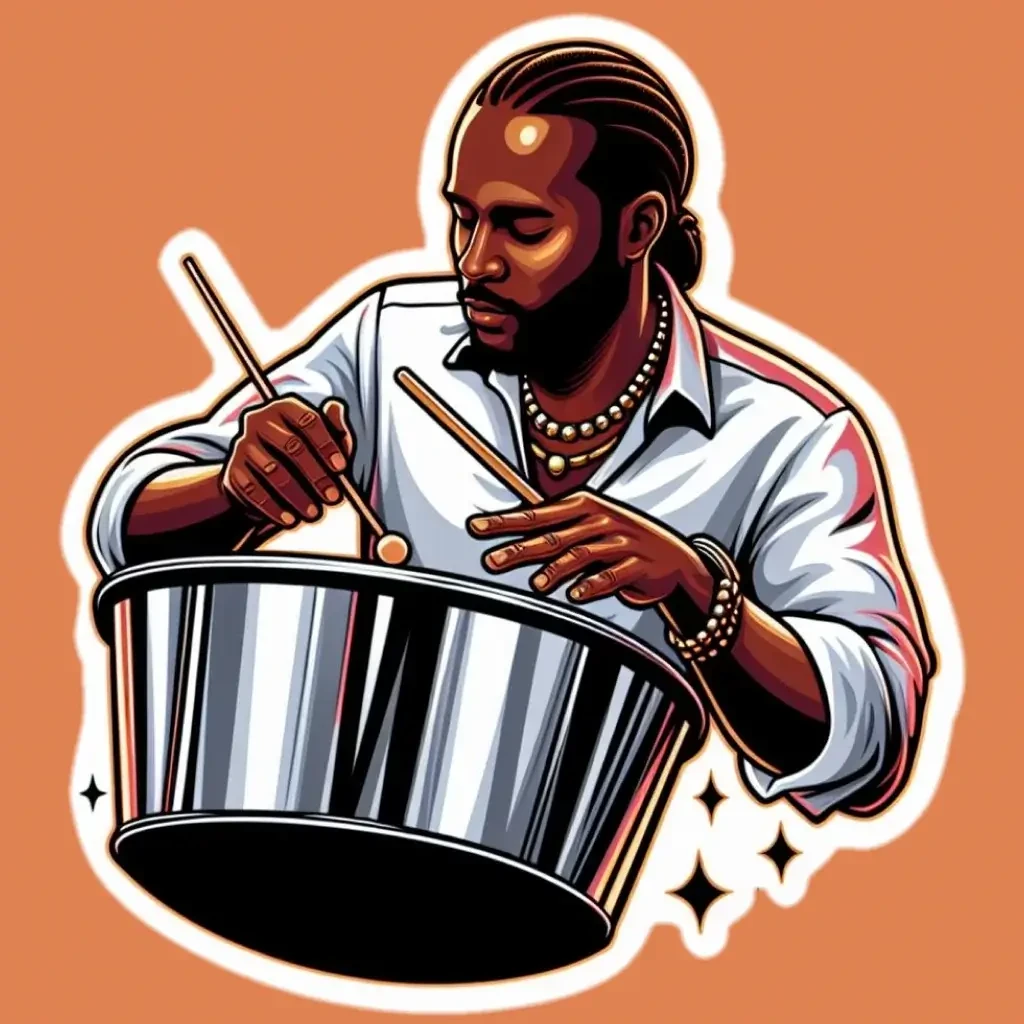
Illustration of a man playing a decorated steel pan drum.
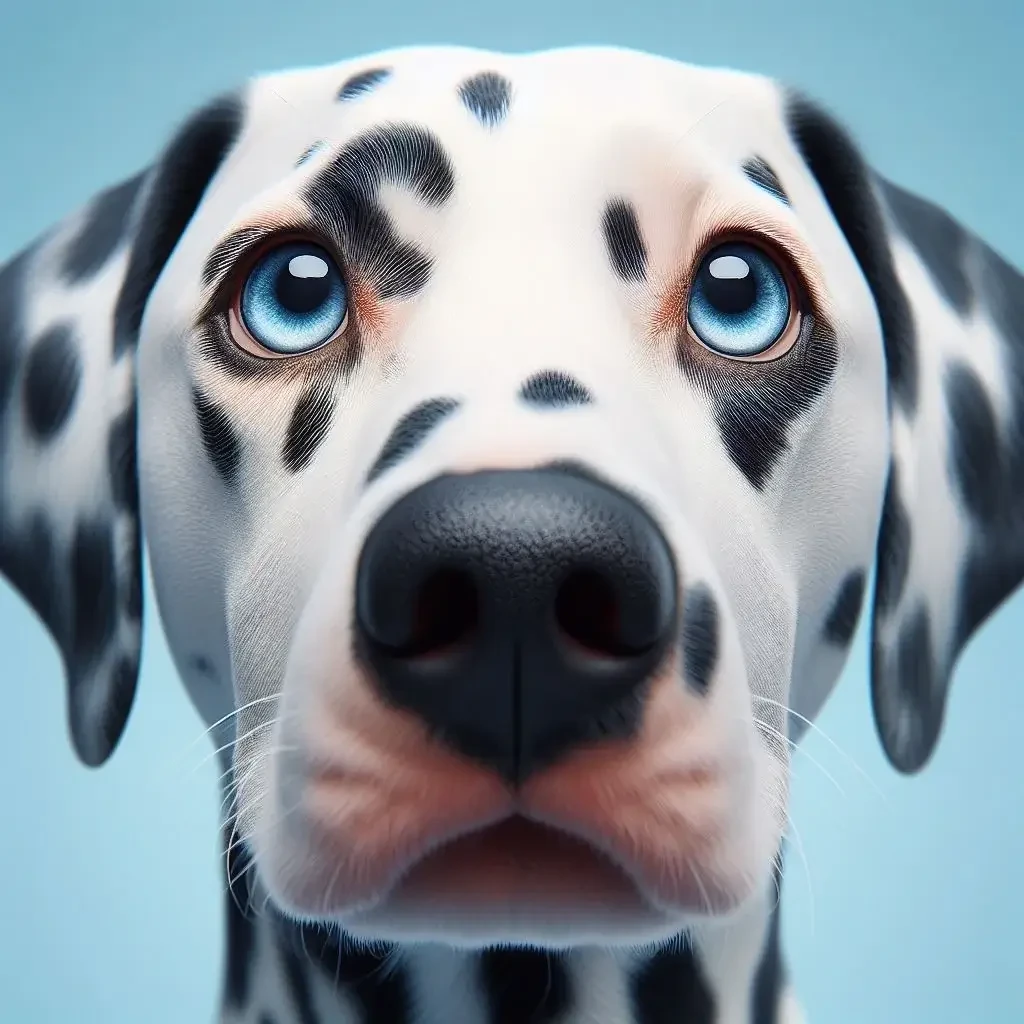
A macro, detailed portrait of the face of a Dalmatian dog staring straight ahead with bright blue eyes on a solid pastel blue, out of focus background. The portrait is realistic with studio lighting.
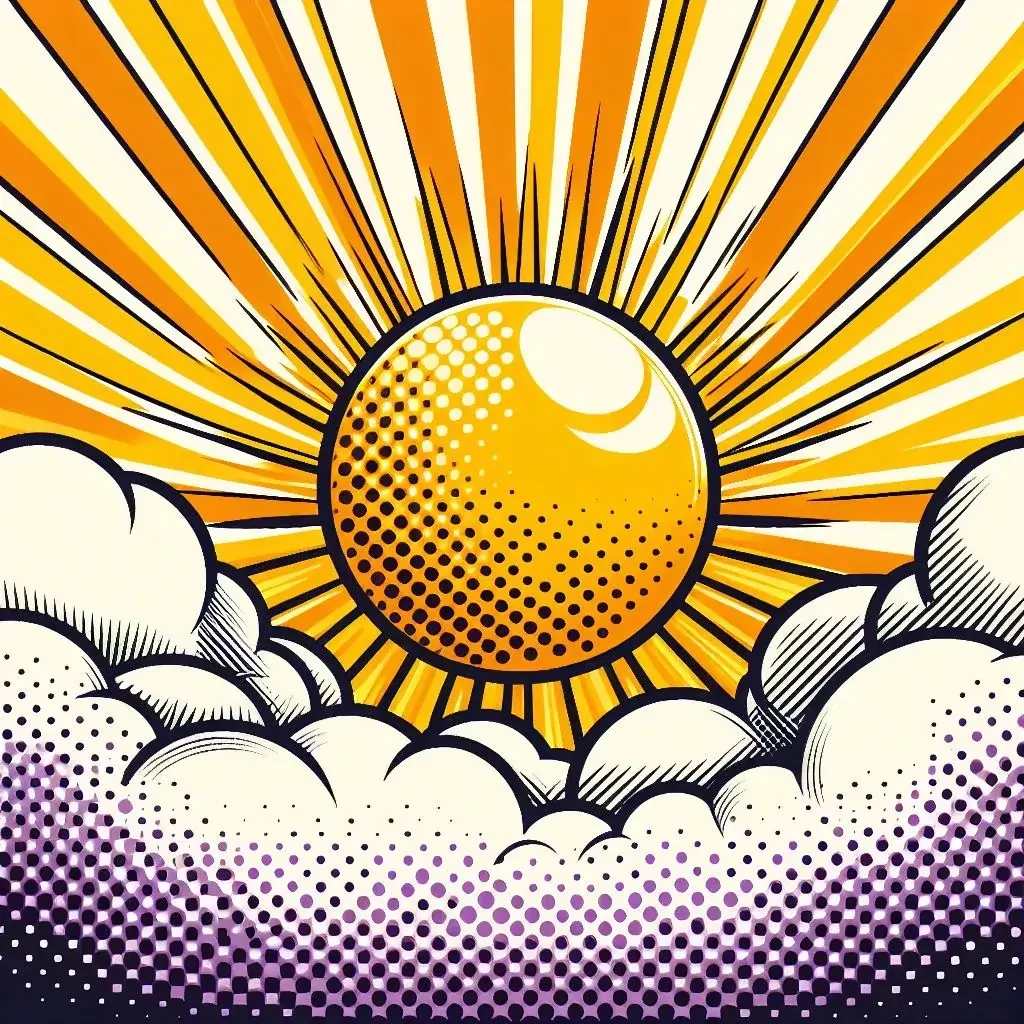
A yellow sun with orange rays rises over white and purple clouds in a pop art style. There should be a halftone effect and screen printing aesthetic. The orange rays radiate outward and fill the background.

A group of assorted donuts in a pink bakery box.
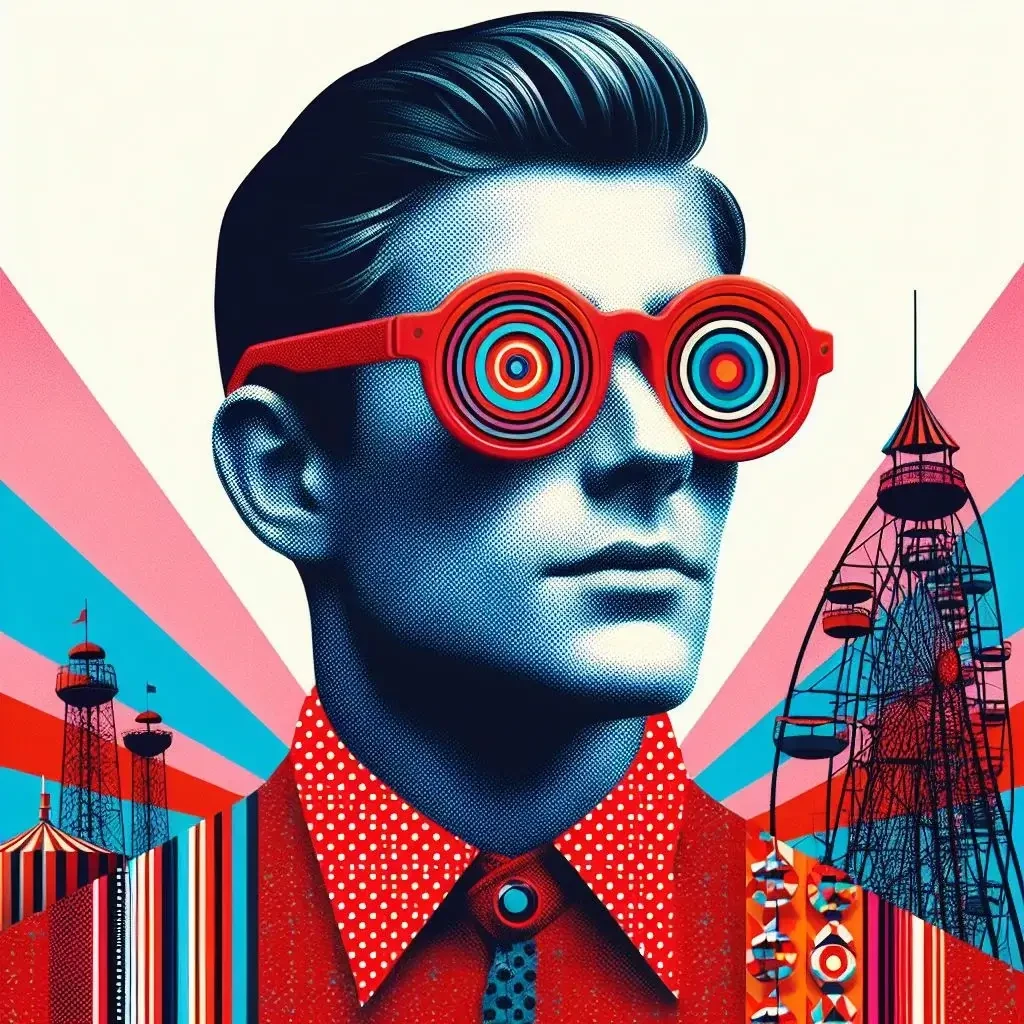
A portrait of a man in a digital collage style. The man is wearing thick red glasses with circular patterns in blue and orange on the inside of the frames. The man is in a red polka dot shirt with a background of thick, brightly colored lines in pink, blue, and red. Collaged into the background is a ferris wheel and a circus tent.

A profile view of a caterpillar crawling on a moss-covered rock with the lush, green forest in the background, macro view, detail, close-up.
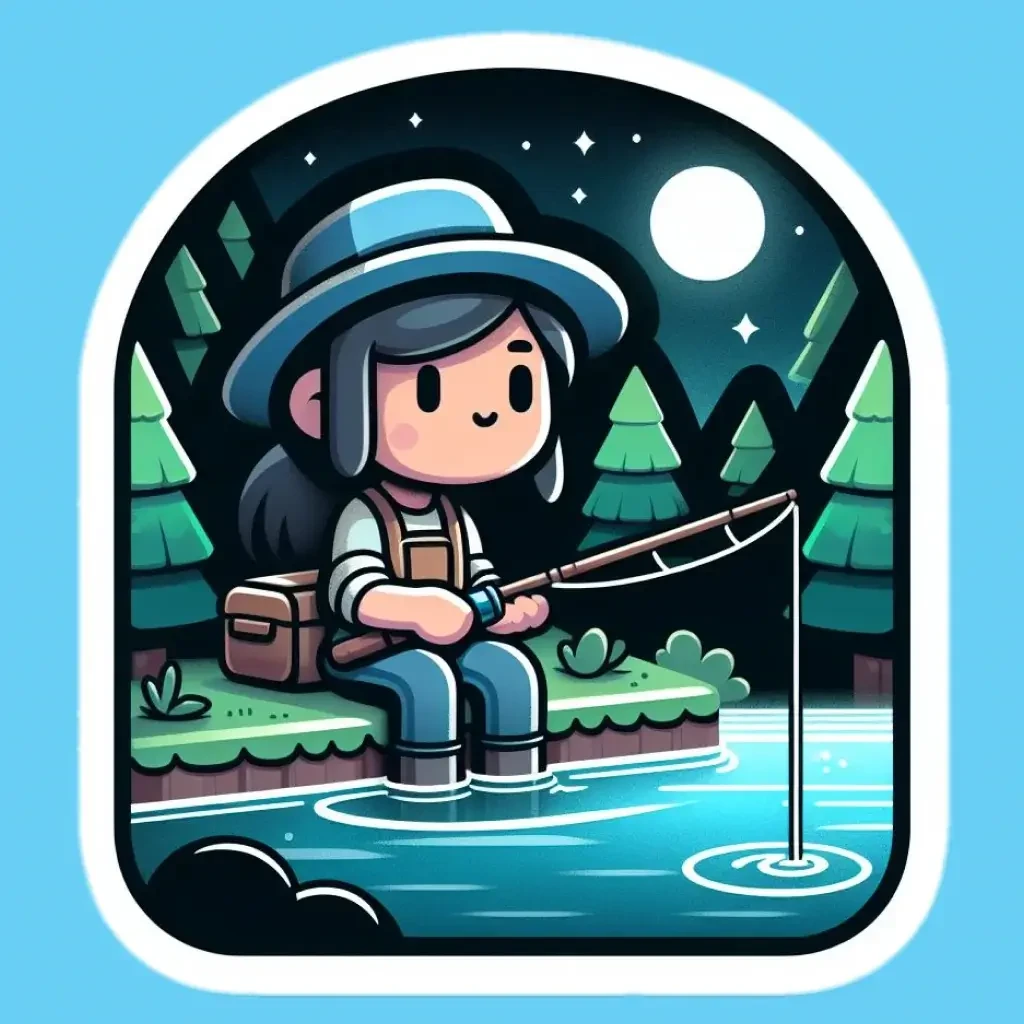
Cartoon style woman with a blue hat, fishing on a river near a forest.
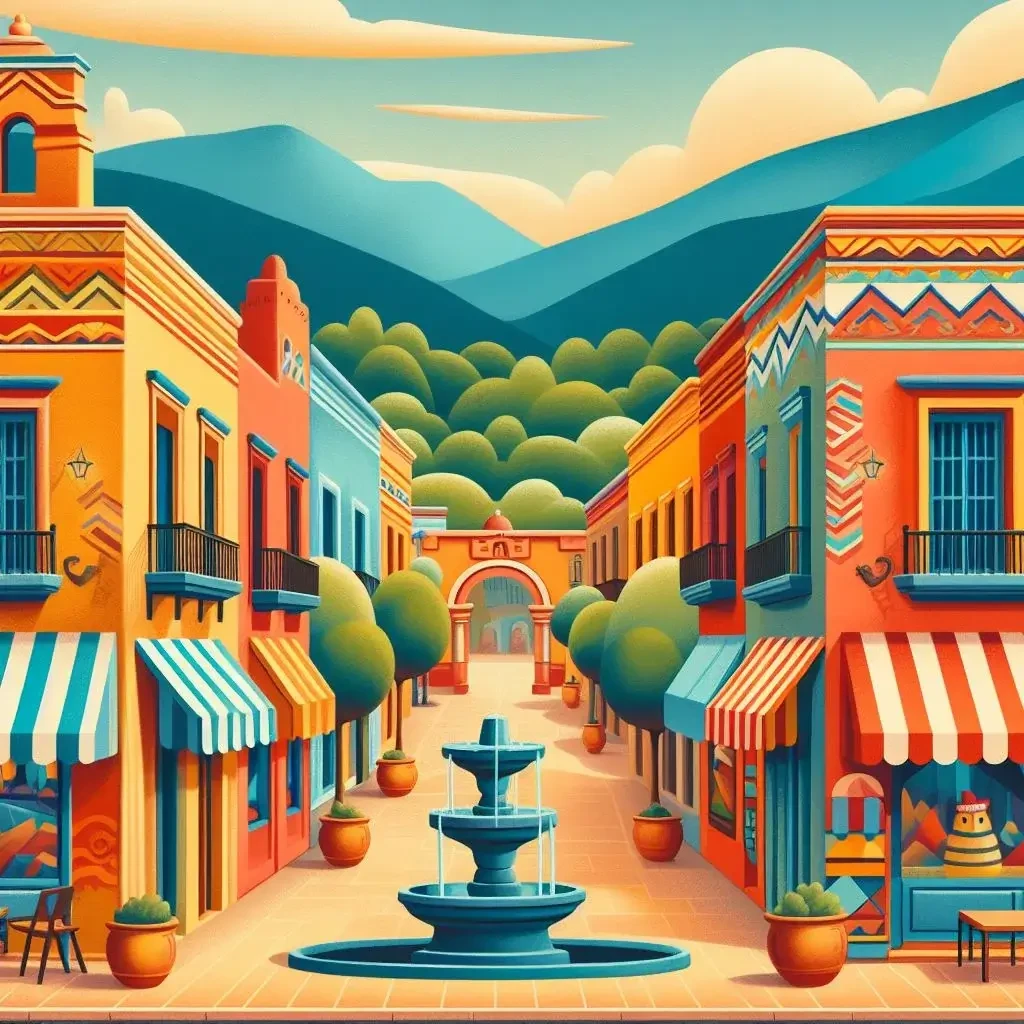
A colorful street scene in the style of Mexican mural art. The street has adobe-colored shops on both sides with striped awnings. There is a fountain in the center and trees and mountains in the distance.
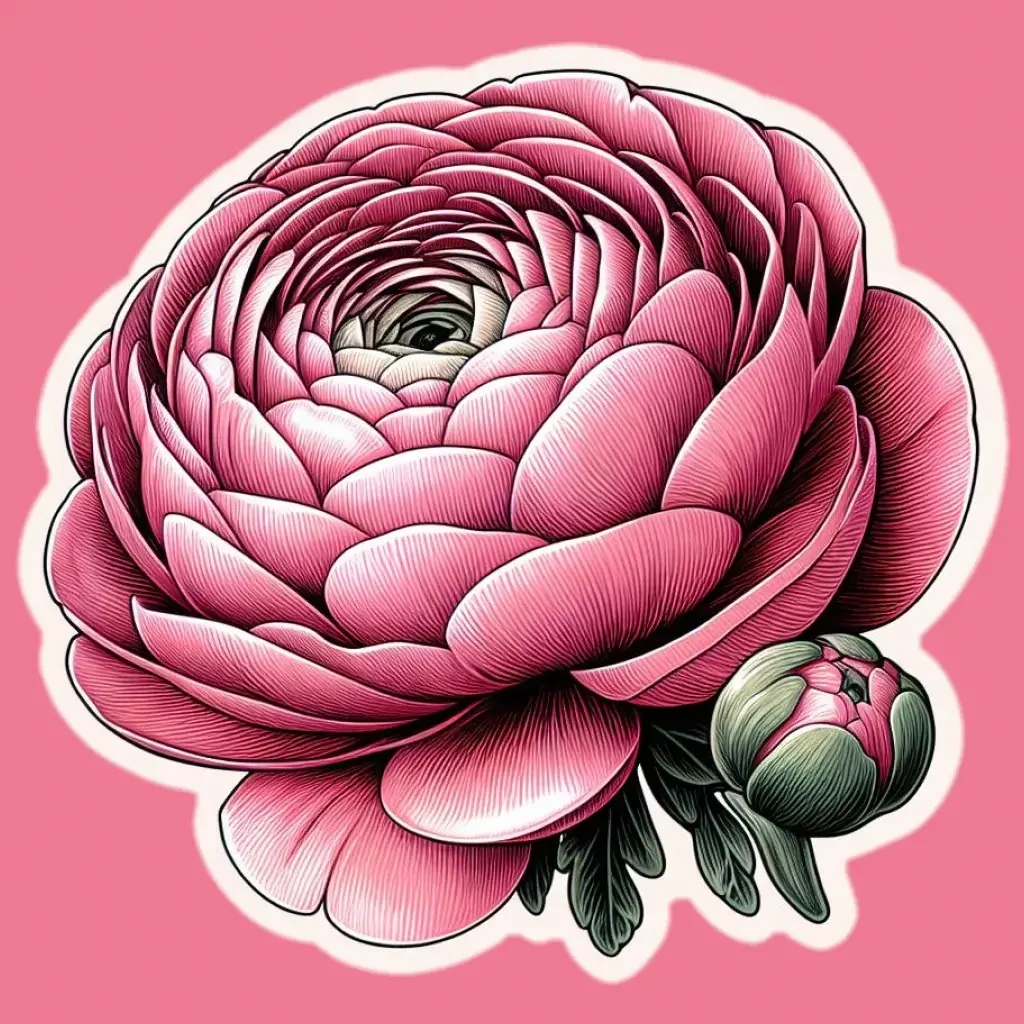
A single pink ranunculus in the style of a vintage botanical drawing.

A unicorn stands on a wooden pier looking out over clouds below, with a starry night sky above.
Create and edit in an instant with Microsoft Designer
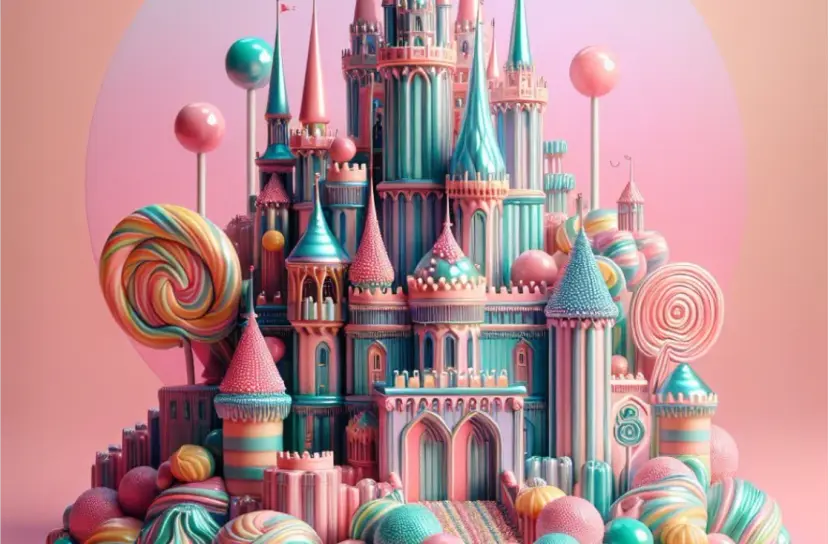
Image generator
Generate any image you can imagine with just a text description.

Background remover
Remove the background from your image in one click.
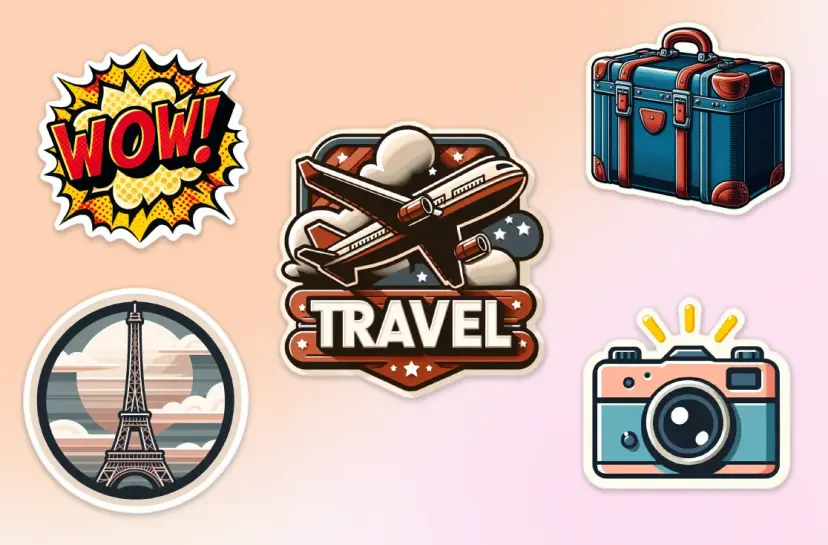
Sticker creator
Describe the sticker you want, and our AI will generate it for you.
Browse thousands of customizable templates
Fresh picks.

Celebrate an occasion
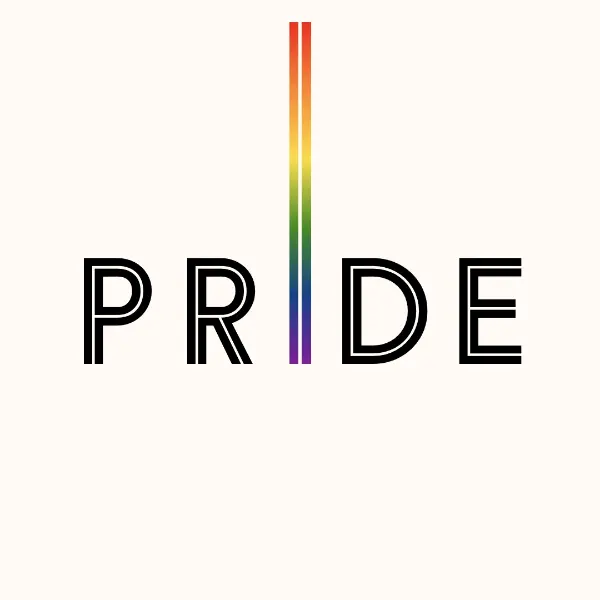
Food and drink

How it works

1. Start with the perfect template

2. Customize it with help from AI
See the templates for:

3. Share your creation with the world
Back to Blog
![how to write a resume graphic design How To Become a Graphic Designer [2023 Career Guide]](https://www.springboard.com/blog/wp-content/uploads/2023/02/how-to-become-a-graphic-designer-2023-career-guide.jpeg)
How To Become a Graphic Designer [2024 Career Guide]
Written by: Sakshi Gupta
Free UX Design Course
Dive into UX design with our free starter course. Transform your creative ideas into user-friendly solutions.
Enroll for Free
Ready to launch your career?
Graphic designers play a key role in determining the success of any business, no matter the industry, and perhaps that’s why it’s consistently listed as one of the best careers for creative and artist types.
But given that it’s such a popular career choice, there’s a lot of competition too. And that isn’t expected to change soon—in the next decade, the number of openings is only expected to grow by 3%, according to the US Bureau of Labor Statistics.
So if you’re interested in a career in graphic design, you may be wondering: how do I stand out from the competition?
That’s why we’ve created this guide. Below, we’ll tell you everything you need to know about becoming a graphic designer. We’ll also tell you about successful graphic designers and their journeys.
Is It Easy To Become a Graphic Designer?
It’s easy to find learning materials on graphic design and areas such as visual communication, print design, and motion graphics online. But if you are to break into this creative industry, you’ll need a solid understanding of art and design, as well as how to employ that in a professional environment.
What Does a Graphic Designer Do?
A graphic designer produces designs that inform, entertain, and capture the attention of consumers.
Here are a few specific tasks that graphic designers might be given:
- Conceptualize and create visual assets for a digital marketing campaign
- Design the logo for a new company
- Create the icons for a website
- Design the cover for a book
- Produce images and visual assets to go along with the text in a presentation
How To Become a Graphic Designer

Graphic design is a field that requires both a strong theoretical foundation in design, as well as a practical understanding of the tools of the trade. In this section, we’ll take a look at the graphic design skills you’ll need and how to use these skills to impress potential employers.
Complete a Course
Learn the basics, make time for learning, training, and education, learn the essential tools, hone the requisite skills, build a strong portfolio with volunteer, freelance, and sample projects, build your network and get involved with the community, consider a graphic design internship, consider a niche based on your interests, build your resume and start applying for roles.
If you are confident that design is something you want to pursue, or if you want to know more about design before a decision, an online course can be a great starting point. An Introduction to Design course can be really useful if you’re a beginner, while a UI/UX design bootcamp is a great way to specialize if you already have basic design skills.
If you want to be a graphic designer, you’ll need to start by gaining a basic understanding of the field. Digital design might seem like a straightforward term, but it’s important that prospective graphic designers understand what that actually means.
Start by learning about the basics of design theory . This will give you the foundational theory that you’ll apply in all your work. Then, you can wrap your head around the professional aspects better by understanding digital design and the different types of design, such as visual design, interaction design, and brochure design.
If you’ve decided that you want to pursue a career in graphic design, then you have a few choices when it comes to getting an education.
Formal Education / University Degree
The most common way to learn graphic design is by getting a college degree. This is a safe bet and will give you a broad overview of a whole slew of subjects within the design.
That said, a college education is a big investment, in terms of both time and money. So you should be absolutely certain that you want to work in graphic design if you’re going to take this path.
Bootcamp/Course
If getting a college degree isn’t feasible, there are various courses and bootcamps in graphic design that you can take. The advantage of doing a bootcamp is that they’re much quicker than getting a degree and you can focus on the specific area of design that you’re interested in. Another upside is that most bootcamps offer career services and some even give you a job guarantee.
Self-Taught Route
Here are a few resources that you can use to learn graphic design on your own:
- Online Courses: There are various graphic design courses and certifications that teach you design thinking and practical graphic design skills.
- YouTube Videos: Channels like Yes, I’m A Designer and The Futur offer invaluable insights into the graphic design industry, and the best part is that most of their content is freely available.

- Blogs: Here’s a list of graphic design blogs that you can follow to keep up with the latest in the industry and find pieces to inspire your own work.
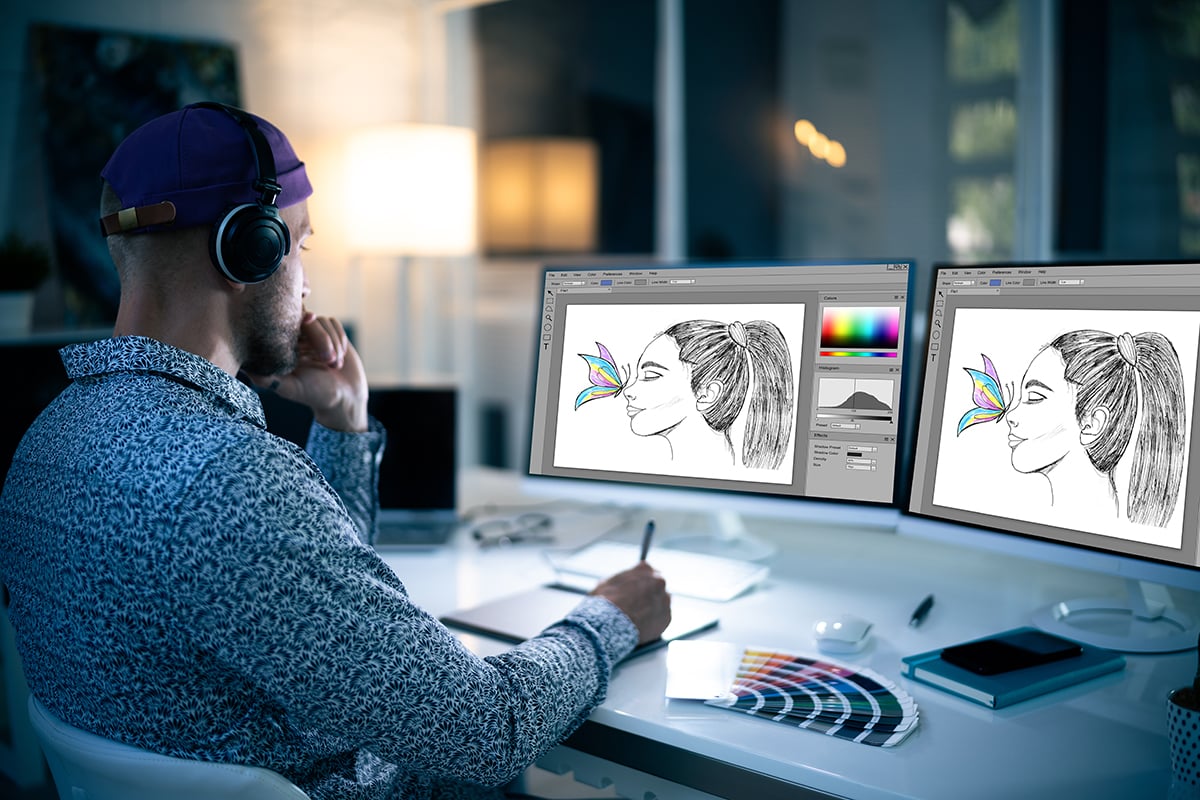
Most graphic design job descriptions ask for proficiency in at least one specific design tool. You can’t master them all, so you should learn a design software based on your areas of interest. Here are some of the most popular design tools out there:
Adobe Photoshop
Not just a verb, Photoshop is one of the most commonly used tools by graphic designers. If you’re not sure exactly which discipline within graphic design you want to focus on, then this is a great place to start, as it’s expected that virtually all graphic designers know how to use it.
Adobe InDesign
Adobe InDesign is used to produce all kinds of layouts. If you’ve ever seen a layout that combines text and images as you do in magazines, brochures, newspapers, and books, there’s a good chance it was produced using InDesign.
Adobe Illustrator
Adobe Illustrator is a software for designers who like to create art themselves. If you’re somebody who likes to draw and wants to see those drawings turned into digital art, then Illustrator is the software for you. It is used to produce vector graphics that can easily be scaled up or down based on screen size.
CorelDRAW is a software that’s used to create and manipulate vector graphics. CorelDRAW treats its vector graphics as packages where each element of the graphic is a separate object. So you can manipulate these objects individually within a vector graphic and make adjustments, such as changing the color balance, adding borders, and so on.
Interface design is a branch of graphic design that focuses on designing interactive applications such as mobile screens. Figma is a tool that’s used specifically for interface design purposes. An added advantage of the tool is that it supports collaboration and makes it easy to create and edit designs as a team.
Affinity Designer
Affinity Designer is another vector graphics editing software. The software is supported on both macOS and Microsoft Windows. It allows you to import files from tools like Adobe Photoshop and Adobe Illustrator, and turn them into vector formats.
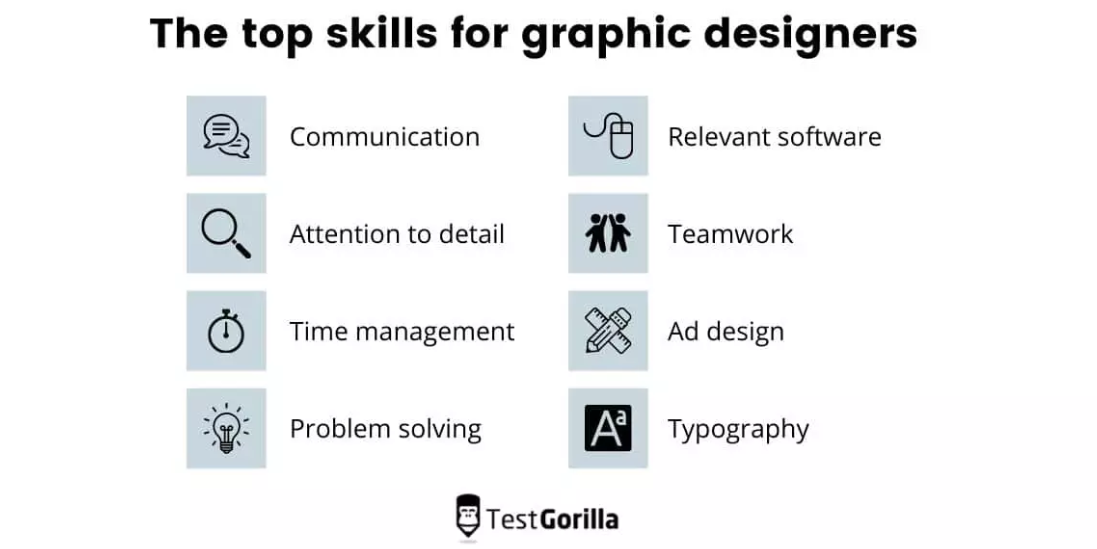
Now that you’re aware of the basics of the graphic design field and are familiar with the tools of the trade, it’s time to pick up skills that you’ll need.
Technical Skills
Here are some of the technical skills that you should have under your belt so that you can become proficient as a graphic designer:
- Specialize in Adobe Photoshop, Illustrator, and/or InDesign
- Learn how to code in HTML so you understand how webpages are structured and designed
- Study digital typography so you know how text can contribute to a design experience
- Understand the basics of user experience design so that you know how graphic design can contribute to a holistic user experience
- Print is still relevant today, so familiarize yourself with the basics of print design and producing physical layouts
Soft Skills
Graphic design will also test your ability to think outside the box and work with people from various other departments. Here are some of the soft skills you should inculcate over time.
- Creativity
- Communication skills
- Time management
- Problem-solving
Graphic design is one of those fields where your portfolio is arguably more important than your resume. Little else matters if you can demonstrate that you can make good work.
The easiest way to start off building a professional portfolio is by creating sample projects. You can conceive of a website, magazine, or product, and then create graphic assets for it.
Then, you can start work as a freelance graphic designer. Assuming such a role will give you the freedom to work for clients who are doing the kind of work that you’re interested in without being thrust into a hectic work environment.
Finally, you can also volunteer at organizations that are looking for pro bono support. This can be a way to contribute to a cause that you believe in and work on projects that you can add to your online portfolio.
Get To Know Other Design Students
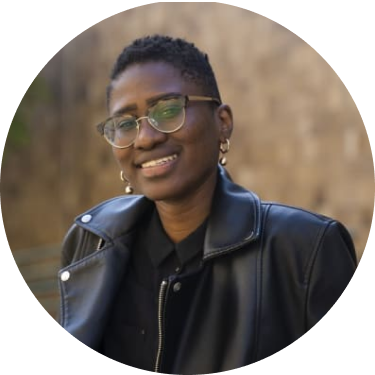
Arin Soukoule
Design Experience Analyst at Accenture Interactive

Asel Yaşacan
Product Designer at Capital One

Jane French
Founder at Ella Verbs
Landing a job as a graphic designer is way easier when you know the right people. Here are a few ways you can go about making key connections in the industry:
LinkedIn makes it simple to look for recruiters looking for graphic designers. Nurture your profile on a daily basis and build rapport by liking posts, leaving comments, and then getting to know others in the industry.
Online Communities
There are various online graphic design communities and job boards that can help you meet others in the industry. Remember that every community has its own rules and best practices. Make sure that you understand how each of them works before throwing yourself into the community.
Conferences and In-Person Meet-Ups
Most sizable cities and towns usually have graphic design meetups or annual conferences that serve as a community for designers. You might even consider traveling to these since they can be a good investment if you’re looking to meet experts in the field and quickly make new connections.
A lot of companies tend to offer internships as part of their graphic design program. You should keep an eye out for these internships and apply to them when they surface. Internships are a great way to dip your toes into a professional setting and give you the opportunity to land a job as an entry-level designer.
Graphic designers are a lot like doctors in the sense that eventually they have to choose a specialization. The niche that you choose is completely up to you. For example, you can choose to transition to being a motion designer if you enjoy animation, or work in identity design if you’re interested in branding. The important thing is that you take some time to reflect on what you enjoy doing and spend time building skills in that area.
When it comes to entry-level positions, recruiters are usually looking for candidates who have a strong portfolio that shows that they’re passionate about a creative career. You can find open roles on websites like LinkedIn and ZipRecruiter, but also make sure to tap your network to see if you can be referred to an open role.
Requirements To Become a Graphic Designer: A Quick Overview
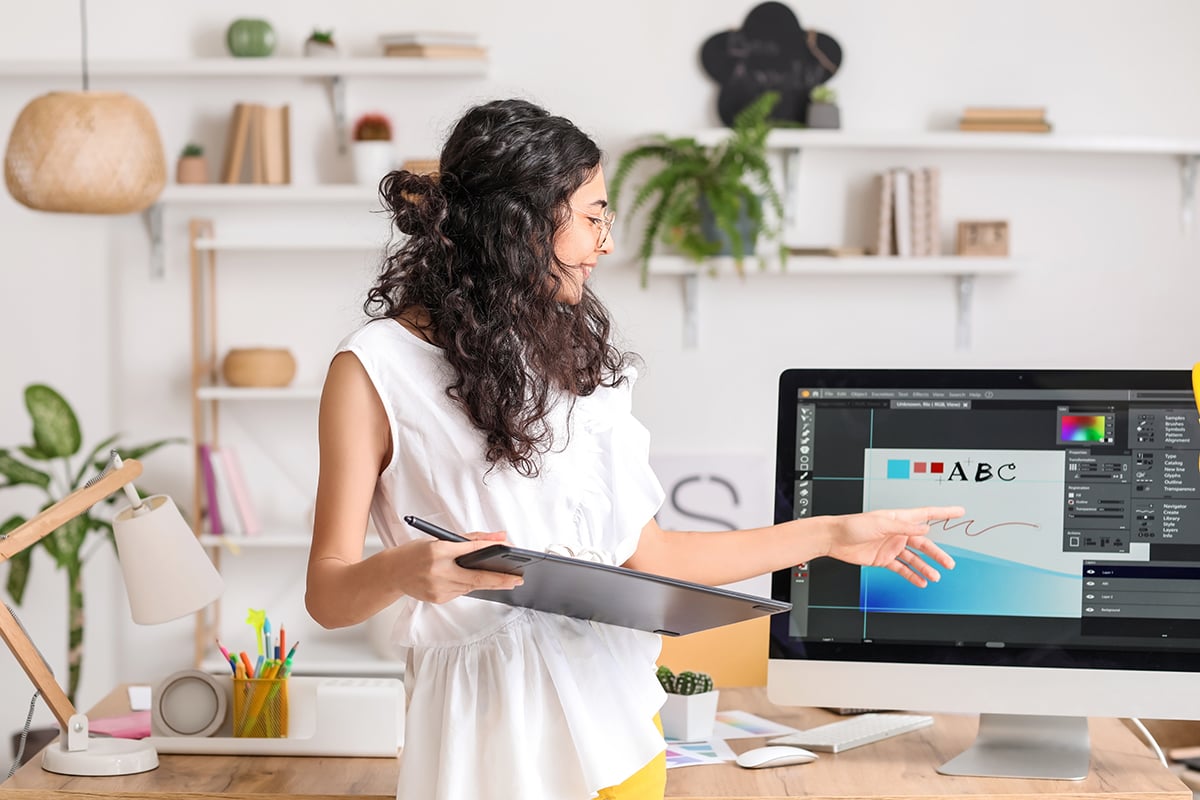
Here’s a summary of the bases you’ll need to cover to go from graphic design novice to landing a job in the field.
Foundational Knowledge
This covers the very basics of graphic design. You’ll go about gaining an understanding of what the field is all about and the principles that graphic designers use to produce aesthetic designs. You might also try your hand at some basic design to cement your understanding of the new concepts that you’re learning.
Education and Qualifications
While you can pursue a degree in graphic design, don’t forget that you also have the option of completing a bootcamp to fast-track your learning in the field. Companies are open to hiring candidates on the basis of the bootcamps they’ve completed if they have a portfolio of work to accompany that.
Skills and Tools
The mix of tools that you use will depend on your area of expertise and what your company prescribes. While the tools may differ, the specific skills that you use—such as typography, image manipulation, user experience, and user interface design —remain universal.
Other Prerequisites
Remember that communication skills are key if you want to succeed as a graphic designer. You should know how to convey messages to an audience in an engaging, informative manner. Along with that, you should also be able to collaborate with teammates and communicate well with developers, project managers, and branding specialists.
Career Transitioning to Graphic Design: Where To Start

If you’re looking to make a career change into graphic design, here are a few different ways that you can do that:
Related Career Transition
Professions branding specialist and illustrator are both related to graphic design. That makes it easy to transition into the field because you already have some skills that are required. The main thing that you need to do is focus on filling any gaps in your skillset and see if you can make a lateral move within your company into a graphic design role.
Unrelated Career Transition
It’s tougher to break into graphic design if you’re coming from a completely unrelated field. In that case, you should start by focusing on building foundation skills and a portfolio of personal projects. Only once you have a wide-ranging portfolio should you start applying for internships or entry-level positions in graphic design.
Freelancing
The advantage of the freelance route is that you don’t need to impress a recruiter or manager to land a job. You can simply apply to freelance positions using your graphic design resume and portfolio. But you should know that being a freelancer basically implies running a business, and you’re responsible for finding clients, managing projects, and tracking expenses.
Becoming a Graphic Designer: Real-Life Examples To Learn From

Here are a couple of graphic designers whose journey can serve as inspiration for your own.
Example 1: Abi Connick

Abi Connick broke into the graphic design industry without a degree in the field. She now has a thriving career as a graphic designer and a YouTube channel with over 160,000 subscribers where she helps budding designers find their feet. You can follow her channel for tutorials on basic design principles, packaging design, and using different graphic design tools.
Example 2: Jack Bibb
Jack Bibb’s story is a great example of how much an internship can accelerate your learning process. He started his internship in a content marketing team but ended up picking up key skills in graphic design. His journey goes to show that having a growth mindset and learning in a professional environment can take you a long way as a graphic designer.
How Much Can You Earn as a Graphic Designer?
Now let’s take a look at how much you can expect to make as a graphic designer at different stages in your career.
Junior Graphic Designer
The average salary for junior graphic designers in the US is $48,237 .
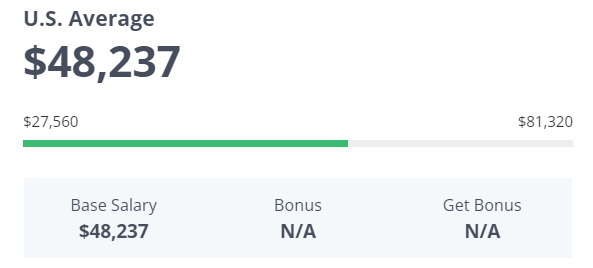
Mid-Level Graphic Designer
Graphic designers in the middle of their careers have a median salary of $66,201 .

Senior Graphic Designer
Senior graphic designers make a median salary of $81,202 .
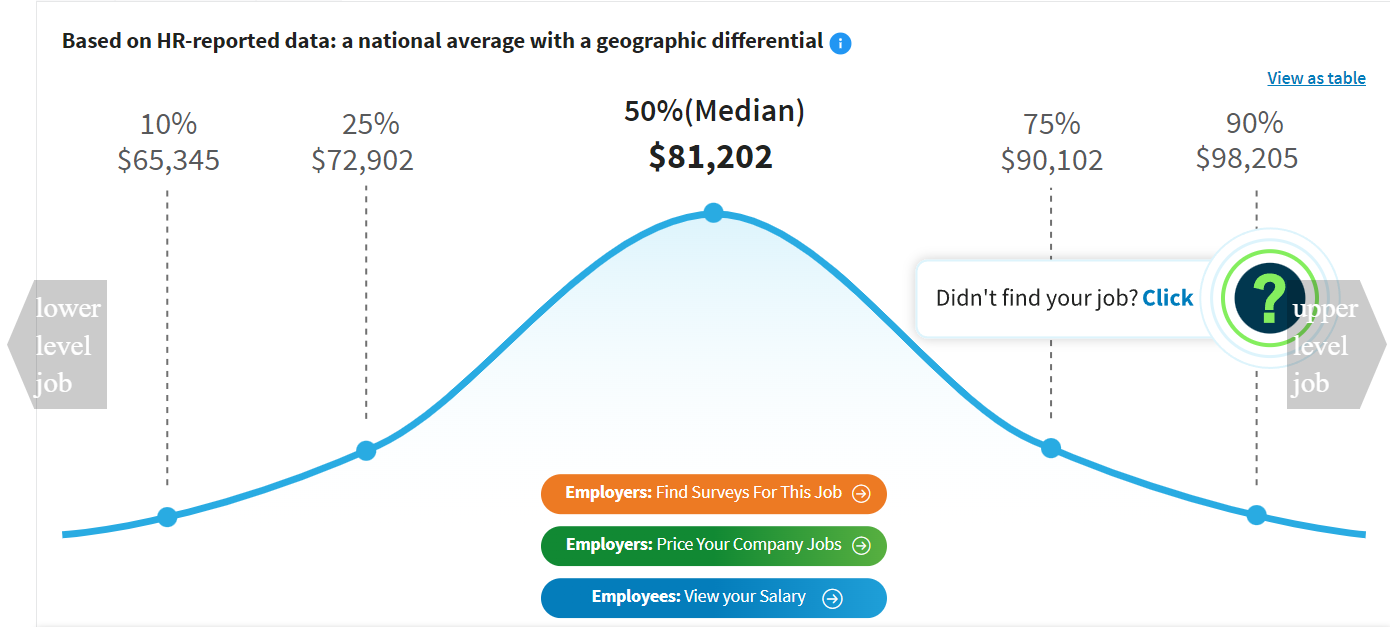
Freelance Graphic Designer
Freelance graphic designers make $58,437 per year on average.
How To Become a Graphic Designer FAQs
We’ve got the answers to your most frequently asked questions:
Are Graphic Designers in Demand?
Yes. The Bureau of Labor Statistics projects that between 2021 and 2031, almost 7000 new graphic design jobs will be added.
Is Graphic Design the Right Career Choice for Me?
Graphic design can be the right career choice for you if you have an interest in studying design principles, and also have the ability to work with industry-standard design tools. It’s also important to inculcate soft skills like creativity, collaboration, and problem-solving.
Is Graphic Design a High-Paying Job?
Graphic design can be a high-paying job. The average salary in the field ranges from $55,000 to $85,000 , but you can make significantly more in higher-paying roles in the industry .
Can I Become a Graphic Designer Without a Degree?
Yes, you can become a graphic designer without a degree. Companies now accept candidates who have completed bootcamps or are self-taught. In either case, it’s important that you build up a portfolio of projects that showcase your skills.
Can I Learn Graphic Design on My Own?
Yes. The Internet is full of free or paid courses that you can complete to pick up requisite skills in the field.
How Long Does It Take To Become a Graphic Designer?
The amount of time it takes will depend on your mode of learning and your own abilities. Many bootcamps will take you from novice to job-ready in about six months. You should give yourself at least that much time if you’re self-learning graphic design. A college degree in graphic design takes four years but will give you skills in a wide range of subjects and tools in the field.
Since you’re here… Not sure where you’ll find the time to learn UX and UI skills? We’re here to help. Our fully flexible UI/UX Design Bootcamp takes just 12-15 hours a week over 6 months and is proven to increase student salaries by $25,033 on average per annum. We’ve helped over 10,000 students make the switch without quitting their day jobs – shouldn’t you be next? Jump in today with our free design fundamentals course .
Related Articles

10 Best UX Research Courses to Grow Your Skillset

Is UX Design Hard To Learn? A Guide to Getting Started

Best UX Certification Programs to Level Up in 2024
Elevate your skills and broaden your horizons..
Data Analytics Bootcamp
Data Science Bootcamp
Data Engineering Bootcamp
Machine Learning Engineering and AI Bootcamp
Introduction to Data Analytics
Data Science Prep
Cybersecurity Bootcamp
Software Engineering Bootcamp
Software Engineering Bootcamp for Beginners
Software Engineering Prep
UI/UX Design Bootcamp
UX Design Bootcamp
Introduction to Design
Take our quiz
All courses
How it works
Job guarantee
Student outcomes
Student stories
Payment options
Scholarships
Universities
Hire our graduates
Compare bootcamps
Free courses
Learn data science
Learn coding
Learn cybersecurity
Learn data analytics
Become a mentor
Join our team
Press inquiries: [email protected]
How to Write a Resume for Today’s Job Market
To get more job interviews, you must create a resume that is optimized for applicant tracking systems (ATS). Learn how in this step-by-step guide.
Customers Interviewed by:
Learning how to write a resume is a crucial skill for job seekers—it’s how you market yourself to potential employers.
A well-crafted resume summarizes your professional experience, skills, and achievements. It should grab the hiring manager’s attention and show them them why:
- You’re the perfect match for the job.
- The skills you have will make the company money.
- You’re qualified to solve the company’s problems.
- You’ll be worth your salary.
- Your accomplishments can be measured and verified.
But in today’s job market, it’s not enough to write an effective resume. You must also tailor each one to the job you’re applying for. Why? Because most companies today use applicant tracking systems, or ATS, to sort and filter the large volume of resumes they receive.
If you’re resume doesn’t contain the specific keywords hiring managers are searching for, it won’t be found—even if you’re qualified for the job!
In this guide, you’ll learn how to write a resume that stands out in today’s job market. We’ll show you how to present yourself as the ideal candidate, highlight the skills that will benefit potential employers, and ensure your resume is compatible with ATS.

How to write a resume that gets interviews
Here’s a quick overview of the basic steps for writing a professional resume. Follow these steps to make your resume clear, concise, and appealing.
Gather all relevant data about your work experience, skills, achievements, and education.
Select a format that’s right for you, whether it’s chronological, functional, or hybrid., clearly list your name, phone number, email, and key social media profiles., create a compelling headline that includes the job title you’re applying for., write a brief statement that summarizes your key achievements and value you offer., list the skills you have that align closely with the job requirements., detail your past job roles, responsibilities, and accomplishments., include your educational degrees, certifications, and relevant training., showcase any relevant honors, awards, and volunteer work., tailor your resume by focusing on the experiences and skills that are most relevant to the job..
Before you start working on your resume, remember that your resume is not your biography. You’re not telling the story of your life. Instead, your resume should be a targeted document meant to showcase the skills and experiences that match the job you want .
This means that if something is not relevant to your targeted job, leave it out . With this in mind, let’s start building your resume!
1. Gather your essential information before you start
Before diving into the actual resume writing, it’s crucial to collect all the necessary information you’ll need. This preparatory step ensures that the resume writing process is smooth and that you don’t miss any important details.
- Significant achievements : List standout accomplishments from previous roles that demonstrate your contributions and successes.
- Skills : Compile a list of your soft, hard, and technical skills that align with those required by the job you’re targeting.
- Employment history : Provide detailed information about past employers, including their names, your dates of employment, locations, job titles, and a clear description of your duties.
- Education : Document your academic qualifications like college degrees, certifications, or licenses that prove your expertise in relevant fields.
- Volunteer work : Include any voluntary engagements where you developed skills pertinent to the job you are seeking.
- Awards and honors : Mention any notable recognitions you’ve received that underscore your exceptional talents and commitment.
When you gather your information, include everything you can think of. You can cut information that’s not relevant to a specific job later.
2. Choose a resume format that’s right for you
A resume format is the way you organize, or lay out, your information. There is no one-size fits all resume format. Instead, there are three different types of formats to choose from – chronological, functional, and hybrid. Which format you choose depends on your particular situation.
The chronological resume format
This is the most traditional resume format, especially for job seekers with lots of relevant experience.
The chronological resume format lists your work history in reverse chronological order , with your most recent jobs listed first. Your skills and education should come after your work history in this format.
- Have a strong work history showing steady career growth without significant employment gaps.
- Are staying in the same field and want to highlight your experience and advancements within that field.
- Want to highlight career progression and professional achievements over time.
The functional resume format
This resume format focuses on your skills rather than your work history. It helps you downplay your lack of experience in a particular field.
In this format, your skills and education should be emphasized over your work history.
- Are changing careers and want to emphasize transferable skills over past job titles.
- Have gaps in employment and want to focus on skills rather than work experience.
- Are new to the workforce and want to highlight skills, coursework, and internships.
NOTE : Generally speaking, we don’t recommend the functional resume format . Recruiters want to see some kind of work history. Instead of the functional format, try the next resume format—the hybrid.
The hybrid resume format
A hybrid resume is a combination of the chronological resume and the functional resume. It showcases both your work history and your skills.
In this format, your skills comes before your work history. But your work history is still the heart of your resume, just like in the chronological format.
- Have lots of skills that are relevant to the job you are targeting.
- Are climbing the career ladder within the same field.
- Are changing roles within the same industry and want to highlight your relevant skills.
We like the hybrid resume because it offers the best of both worlds, combining the strengths of the chronological and the functional resume formats.

3. Put your contact information at the top of your resume
This section might appear simple, but it’s important. If hiring managers can’t contact you, you won’t get an interview.
- Phone number
- Location (City, State, Zip Code)
- Email Address
- LinkedIn profile URL
It’s surprising how often job seekers forget a crucial piece of contact information. Double-check to make sure it’s as easy as possible for recruiters to contact you for a job interview.
Here’s an example:

Contact information do’s and don’ts
- Include your full name, including your middle initial.
- Include a link to your professional website or online portfolio.
- Create a strong LinkedIn profile and be sure to include the URL on your resume.
- Don’t write your full address; only your city, state, and zip code.
- Don’t include a work phone number; only your personal number.
- Don’t add a photo of yourself . This can lead to bias or discrimination.
4. Create a compelling resume headline
Your resume headline comes right after your contact information. At the very least, your headline should clearly identify the title of the job you’re applying for.
Is putting the job title in the headline necessary? Yes! “Think of your resume as a maze,” says resume expert Laura DeCarlo . “It has to have a visible entrance or no one would ever get started.” Without a headline, “the prospective employer won’t know for which position you are applying.”
Your headline can also include years of experience and key qualifications. Here’s an example:

Resume headline do’s and don’ts
- Tailor your headline to each job you apply for.
- Keep your headline under ten words to make sure it packs a punch.
- Position yourself as an expert in your field.
- Don’t use clichés such as “hard worker” or “team player.” Be specific.
- Don’t be too salesy. Focus on giving a snapshot of your skills and experience.
- Don’t make your headline too long. Cut to the chase.
5. Write your resume summary
A resume summary is a brief paragraph that provides an overview of your qualifications for the role you’re applying for. Most expert resume writers today highly recommend using a summary.
“One of the most common mistakes I see in resumes is the absence of a targeted introductory paragraph at the beginning of the resume,” says career coach Suzanne Berger . “Keep in mind that recruiters or hiring managers only spend 10 to 20 seconds reviewing your resume, so it is important to make an impact from the start.”
As you can see from the following example, your summary goes right under your resume headline:

Your resume summary should include a concise overview of your key qualifications, professional achievements, and skills that are relevant to the job you are applying for.
Here’s a formula you can use to write your summary, followed by an example:
[Your Professional Title] with [Years of Experience] years of experience. Proven track record in [Top Achievement 1] and [Top Achievement 2] . Skilled in [Skill 1] , [Skill 2] , and [Skill 3] . Known for [Unique Value or Strength] .
Marketing Manager with 8 years of experience . Proven track record in increasing online engagement by 40% and boosting lead generation by 30% . Skilled in content creation, data analysis, and strategic planning . Known for exceptional organizational skills and the ability to manage and inspire teams to exceed corporate objectives .
Resume summary do’s and don’ts
- Use numbers to show that you are able to produce tangible outcomes.
- Incorporate keywords from the job description whenever possible.
- Write your resume summary last because you’ll then have a fuller picture of your experiences and skills.
- Don’t just list your job duties; instead focus on your accomplishments.
- Don’t use personal pronouns (I, me, or my).
- Don’t make your summary too long; keep it to no more than 3-4 sentences.
6. Create your skills section
When we talk about keywords, we are mostly talking about skills .
There are two main types of skills— hard and soft . Hard skills are specific abilities you learn through education or training, like using certain software or speaking a foreign language. Soft skills are more about how you work and interact with others, such as teamwork, communication , and flexibility.

You should place your skills section under your resume summary. List your skill set using bullet points, either in columns or in a bullet-point format. Try to include 10 to 20 key skills in this section.

IMPORTANT! The way the same skill is worded in a job description can vary from company to company. This is why it’s crucial to tailor each resume to the job you’re applying to.
For example, here are three different ways of listing essentially the same skill:
- Customer Service
- Client Relations
- Customer Support
If the job description lists “customer support” and you have “customer service” on your resume, the hiring manager might not find your resume when searching through the ATS database — even though you do have that skill.
To make sure you’re using the right keyword skills, run your resume through Jobscan’s resume scanner . It compares your resume to the job description and tells you which skills to use.
You’ll also receive a resume score which tells you how closely your resume matches the job description. The higher your score the more likely you are to get an interview. Here’s an example of the report you’ll receive from the resume scanner:

The skills in red are missing from the resume. Add them to increase the resume score. You can read more about Jobscan’s resume scanner and how to try it for free here .
7. Create a compelling work history section
Now it’s time to get to the heart of your resume – the work experience section. This is the section employers will spend the most time looking at when they consider your resume.
Why is this section so critical? Because it’s where you provide the proof to support what you said about yourself in your resume headline, summary, and skills section.
Each job should include the following information and be listed in reverse-chronological order (latest job first).
- Company name and location – Include the full name of the company you worked for followed by the city and state of its location.
- Job title – Be as specific as possible to ensure that employers know exactly what your role was within the company.
- Start and end dates – Include the month and year for each position. If you only list the year, it may appear as though you are omitting information.
- Achievements and responsibilities – These can be listed using bullet points. Include hard numbers and metrics wherever possible.
One of the biggest mistakes people make when writing a resume is only listing their job responsibilities. These are tasks that you’re expected to perform as part of your job.
Listing your job responsibilities gives a potential employer an idea of what you did day-to-day. But it doesn’t reveal how well you did it.
This is why it’s important to highlight your specific accomplishments. For example, if you increased sales, reduced costs, or implemented new processes or technologies, be sure to mention these accomplishments.
Here’s an example of a work experience section with measurable achievements :

To write strong bullet points for your work experience section, use Jobscan’s AI-powered bullet point generator. It creates bullet points based on the skills in the job description, highlighting your relevant qualifications. Try it for free here .
Work experience do’s and don’ts
- Use numbers to quantify your achievements whenever possible.
- Use action verbs to describe how you did something.
- Use the mm/yyyy format for resume dates .
- Don’t list more than 10 years of work experience unless it’s highly relevant.
- Don’t use the passive phrase “responsible for.” Instead, use active voice.
- Don’t list every single task you worked on; include only the most relevant.
8. Create your education and certification section
Your education section should appear after your work experience. If you’re applying to a job that requires extensive education (like medicine, law, or academia), you’ll need to be more detailed. But most job seekers can get away with providing only the following information on their resume:
- Name of the degree/certification: Write the full name of the degree or certification. Use commonly accepted abbreviations (e.g., B.A. in English, MBA, PMP).
- Institution name: Include the name of the university or institution that awarded the degree or certification.
- Location (optional): List the city and state if the location is relevant to the job or if the institution is well-known.
- Graduation date: Mention the month and year of graduation. For certifications, you can also include an expiration date if applicable.
Here’s an example of an education section on a resume:

Education section do’s and don’ts
- Bold your degree so that it stands out.
- List your education in reverse-chronological order.
- Include any relevant coursework, skills training, licenses, and certifications .
- Don’t mention your high school if you have a college degree.
- Don’t disclose your GPA unless you graduated recently and had a very impressive academic career (3.5 GPA plus).
- Don’t list an advanced degree if the job doesn’t require it.
9. Showcase honors, awards, and volunteer work
The key to this section is to only include honors and awards that are relevant to the job you’re applying to.
This can get a little tricky because if you do have honors or awards that are highly relevant, consider including them in your summary section. Otherwise, hiring managers might miss them if you only list them at the bottom of your resume.
If you have any volunteer experience , it’s generally a good idea to add it to your resume.
According to a LinkedIn survey , 20% of employers say they have hired a candidate because of their volunteer experience. The survey also showed that job seekers who volunteer are 27% more likely to be hired than non-volunteers!
- The name of the organization.
- The dates of your service.
- A brief description of your duties and responsibilities.
Here’s an example of what this section of your resume can look like:

10. How can you tailor your resume to a specific job position?
Tailoring your resume to each specific job is not just recommended; it’s imperative . This is because most companies today use ATS computer software to manage and filter the enormous amount of resumes they receive.
When you submit your resume, it goes into an ATS database . Hiring managers search the ATS database for suitable resumes by typing keywords, or skills, into the ATS search bar. If your resume contains these keywords it will be found. If it doesn’t contain the right keywords, your resume will remain in the ATS database, unseen.

To tailor your resume, you must first read the job description. This is where you’ll find the keywords to add to your resume. Make sure you add those keywords exactly as they are written in the job description .
Unfortunately, tailoring each resume to the job description takes time and effort. The best way to speed up this process is to use an online tool like Jobscan’s resume scanner .
Just paste in your resume and the job description and click scan. You’ll receive a match report telling you how closely your resume matches the job ad. The report also tells you exactly which keywords to add to your resume to optimize it for the ATS. Try the scanner for free below:
Effective resume formatting tips
Properly formatting your resume makes it easy for hiring managers to find what they’re looking for. At the same time, good formatting helps the ATS understand your resume.
Remember, if the ATS can’t read your resume you won’t get the job!
Choose a professional, easy-to-read font like Arial, Calibri, or Times New Roman in size 10 to 12 for text and 14 to 16 for headings.
Clearly distinguish section headings with a larger font size, bold text, or underlining to guide the reader’s eye effectively through your resume., set your margins to at least 0.7 inches all around, ensuring that your resume looks balanced and does not appear overcrowded., avoid complex graphics, tables, headers, and footers, which can confuse ats software., break up blocks of text. a paragraph should never be longer than 5 lines., use standard headings like “work experience,” “education,” and “skills.” these are immediately recognizable to both hiring managers and ats., use the same style of bullets, text alignment, and line spacing throughout your document., align your text to the left. right-aligned or justified text can create irregular spacing between words, making your resume harder to read., save your resume file as a pdf to preserve your formatting across different platforms., proofread carefully one grammatical error can ruin your chances of getting a job., how to write a resume for students with no experience.
Creating a good resume without any work experience might seem tough, but you can still make a strong impression on employers by highlighting your skills and activities. Here’s how:
- Focus on your education : Put your education section at the top. Include details like your degree, major, relevant coursework, academic honors, and GPA if it’s above average.
- Include extracurricular activities : List any activities outside of class, like clubs, sports, or student government. Mention any leadership roles or responsibilities you’ve had.
- Add volunteer work and internships : Don’t forget to include volunteer positions, internships, or community service. These experiences show your willingness to work and learn.
- Highlight projects and academic achievements : Talk about any major projects or research you’ve done, especially if they relate to the job you want. Describe what you did and what you achieved.
- Skills section : Make a list of your skills, including technical skills (like computer software) and soft skills (like teamwork and communication).
- Professional summary : Start with a short summary that explains your career goals and your best qualities. Make it clear why you’d be a great fit for the job.
Here’s a sample of a resume for students with no experience:

How to match your cover letter to your resume
Matching your cover letter with your resume helps create a polished and cohesive application. Here’s how:
- Consistent formatting : Use the same font, header, and layout from your resume for your cover letter. This helps create a professional and unified appearance.
- Use similar language : Pick out key skills and phrases from your resume and include them in your cover letter. This reinforces your qualifications and aligns your application with the job requirements.
- Expand on key points : Choose one or two major achievements listed on your resume and elaborate on them in your cover letter. Explain how these experiences have equipped you for the job.
- Keep the tone the same : If your resume is formal, your cover letter should be too. If it’s more casual, your cover letter can be less formal as well.
- Address the job’s needs : Demonstrate how your experiences make you a good fit for the job. Show that you understand what the job involves and explain why you’re the right candidate.
- End with a call to action : Conclude by expressing your enthusiasm for the role and suggesting they look at your resume for more details. Ask them to contact you for an interview.
When you’re done writing your cover letter, run it through Jobscan’s cover letter checker . This tool will tell you how to improve your cover letter.
Hate writing cover letters? Use Jobscan’s cover letter builder . This tool uses AI technology to generate an ATS-friendly cover letter with just one click.
10 standout resume examples to inspire you
These samples showcase a variety of styles and formats suited for different industries and career stages, giving you ideas on how to write a resume.
1. Sales manager resume example

2. Accountant resume example

3. Recruiter resume example

4. Bookkeeper resume sample

5. Digital marketing resume example

6. Teacher resume example

7. Customer service resume example

8. Office assistant resume example

9. Operations manager resume example

10. Technical writer resume example

Key takeaways
- Optimize for ATS : Today’s resumes must be tailored to pass through Applicant Tracking Systems (ATS) by including specific keywords related to the job you’re applying for. This ensures your resume is seen by hiring managers.
- Tailored Resumes : Each resume should be customized to the job description, emphasizing relevant experiences and skills. This enhances your chances of standing out in a competitive job market.
- Resume Formats : Choose between chronological, functional, or hybrid formats based on your career history and the job requirements. Chronological is suitable for those with a strong, relevant job history; functional is best for career changers or those with gaps in employment; hybrid combines the strengths of both.
- Essential Elements : A resume should include a clear headline, a compelling summary, a detailed work history, relevant skills, and educational credentials. Each section should be crafted to showcase your qualifications and fit for the role.
- Skills and Keywords : Highlight both hard and soft skills that are directly relevant to the job. Using precise keywords from the job description in your resume ensures compatibility with ATS and increases the likelihood of your resume being selected.
- Quantifiable Achievements : Where possible, use metrics to quantify your accomplishments. This provides concrete evidence of your capabilities and impact in previous roles.
- Additional Sections : Including volunteer work, awards, and certifications can differentiate your resume. Ensure these are relevant to the job to keep the resume focused and impactful.
- Resume Building Tools : Utilize tools like resume builders and scanners (e.g., Jobscan) to construct a resume that matches job descriptions and optimizes for ATS, saving time and improving effectiveness.
- Format and Proofread : Proper formatting and thorough proofreading are essential to maintain professionalism. Ensure the resume is easy to read and free from errors, which can detract from your credibility.
Beginners can use the chronological format if they have some work experience, even if it’s part-time jobs, internships, or volunteer work. However, if a beginner has little to no work experience, a functional format might be better. Include essential resume sections like contact information, a summary, education, and any relevant work experience or skills. Tailor your resume to the job by incorporating keywords from the job description. If you lack work experience, emphasize volunteer work, internships, and extracurricular activities that demonstrate your skills and commitment. Always proofread for errors before submitting your resume.
To make your resume stand out to recruiters, start by tailoring it specifically for each job application, incorporating keywords from the job description to align closely with the requirements. Highlight your achievements by quantifying them with specific numbers and outcomes, such as “increased sales by 20%” or “reduced processing time by 30%,” to demonstrate measurable success. Begin with a compelling professional summary that succinctly outlines your key qualifications and what you bring to the role, clearly establishing why you are the ideal candidate. Ensure your resume has a clean and professional layout, with logical sections and easy-to-read fonts, to facilitate quick review and make a strong first impression.
1) Gather information 2) Choose a format 3) Write contact information 4) Craft a headline and summary 5) Detail your experience and education 6) Highlight skills 7) Add additional sections 8) Tailor for the job 9) Proofread and edit 10) Finalize and save
To create a resume with no work experience , start with a functional format that emphasizes your skills and education. Begin with a strong summary statement that highlights your career goals and key skills. Place your education section prominently, including any relevant coursework or projects. List both hard and soft skills applicable to the job, and include any internships, volunteer work, or extracurricular activities that demonstrate your abilities and work ethic. Mention any significant projects or achievements, especially those relevant to your desired job. Also, include any professional affiliations that show your interest in the industry. Ensure the resume is well-organized and clearly formatted to highlight your qualifications effectively.
Use Jobscan’s resume builder , which is specifically designed to help you craft an AI resume that is both appealing to hiring managers and optimized for Applicant Tracking Systems (ATS). This tool provides templates and real-time content suggestions, helping you tailor your resume effectively for each job application. You can also use ChatGPT to write a resume for free . Just be sure to edit and personalize the results you get.
1) Log into your Google account, go to Google Docs, and either start a new document or use the template gallery. Jobscan also offers free Google Docs resume templates . 2) Select a resume template that fits the job you’re applying for from the template gallery. 3) Replace the template’s placeholder text with your personal information, including contact details, educational background, work experience, and skills. 4) Tailor the content to the job by adding relevant keywords from the job description and adjusting the format—like fonts and spacing—for clarity and appeal. 5) Double-check your resume for any errors and consider having someone else review it too. 6) Once satisfied, download your resume as a PDF or DOCX file , or share it directly via email or a shareable link.
1) Start the program and select “New” from the file menu to access templates. 2) Type “resume” in the template search bar to see available resume designs. 3) Choose a template that suits your needs, then replace the placeholder text with your personal details, including work experience, education, and skills. 4) Adjust the content to match the job description, using relevant keywords and highlighting your qualifications. 5) Modify font size, style, and colors to ensure the resume is clean and professional. 6) Check for any errors, and consider having someone else review it. 7) Save your resume as a PDF to maintain formatting and make sharing easy. 8) Print for physical submissions or save digitally for online applications.
In 2024, resumes should be designed for clarity and ATS compatibility . Start with a professional layout that includes plenty of white space and a logical structure. The top should have your contact information—just your name, phone number, email, and LinkedIn URL , omitting a full address for privacy. Follow this with a concise professional summary, then list your work experience, skills, and education. The format should ensure easy readability for both human recruiters and Applicant Tracking Systems, emphasizing a clean design without complex graphics or tables that could confuse the ATS software.
Choosing the right resume format depends on your career background: Chronological: Lists your work history in reverse chronological order, ideal for those with a solid work history. Functional: Focuses on skills rather than work history, suitable for career changers or those with gaps in employment. Combination: Mixes elements of both chronological and functional formats, highlighting skills followed by work history in reverse order. Good for those with significant skills and experiences.
The number of jobs you should include on your resume depends on your experience level and relevance to the role. Typically, if you’re early in your career with less than 10 years of experience, aim for 2-3 recent and relevant positions. For mid-career professionals, around 3-4 positions spanning the last 10-15 years is common. Experienced professionals may include the most pertinent roles from their extensive history, focusing on the past 10-15 years. Ensure each listed job directly relates to the position you’re applying for, prioritizing relevancy over quantity to present a focused and impactful resume.
A resume should typically be one to two pages long, with rare exceptions for highly experienced individuals or those in certain industries. Aim to keep it concise and focused on highlighting your most relevant qualifications and experiences for the position you’re applying for.
AI and machine learning have revolutionized resume screening by automating the process. Applicant Tracking Systems (ATS) use these technologies to quickly analyze resumes, searching for relevant keywords and qualifications. This saves recruiters time and ensures a more efficient screening process, helping them identify top candidates more effectively.
When writing a resume summary with no experience, focus on your education, relevant skills, and career goals. Highlight any coursework, projects, or extracurricular activities that demonstrate skills applicable to the job. Emphasize your enthusiasm, work ethic, and eagerness to learn. Keep it concise and impactful, showcasing how your background aligns with the position and company’s needs.
Crafting a simple resume involves starting with your contact information, followed by a brief summary statement. List your work experience, education, and relevant skills, ensuring consistency in formatting. Consider including optional sections like volunteer experience or honors/awards. Proofread carefully and tailor your resume to each job application.

Robert Henderson, CPRW, is a career advice writer and a resume expert at Jobscan.
Related Articles

June 18, 2024

June 17, 2024

June 12, 2024

June 11, 2024

June 4, 2024

Join 2 million job seekers who get bi-weekly job search tips
Get insider knowledge and ready-to-use job-seeking tips and hacks delivered to your inbox.
- Online Degrees
- Find your New Career
- Join for Free
How to Make a Resume: 2024 Resume Writing Guide
Learn how to identify important resume keywords, format your resume, and write each section in this comprehensive guide.
![how to write a resume graphic design [Featured image] Job seeker sitting on a sofa chair with her laptop open in front of her reviews a copy of her printed resume in hand.](https://d3njjcbhbojbot.cloudfront.net/api/utilities/v1/imageproxy/https://images.ctfassets.net/wp1lcwdav1p1/24xlcN5BpR63w0OwDG4ESI/52a6c4ff9a0758c2bfb9e82c1f43d3f7/GettyImages-1269109020.jpg?w=1500&h=680&q=60&fit=fill&f=faces&fm=jpg&fl=progressive&auto=format%2Ccompress&dpr=1&w=1000)
Your resume is a document that encompasses your entire professional journey, showing where you currently are in your career, how you got there, and where you hope to go next. Since it’s meant to be a concise brief—often condensed to just one page—that can feel like a lot of storytelling for a small space.
To make a resume that fully demonstrates your experiences and goals, it’s important to be strategic with the language, format, and sections you include. In general, there are three broad steps to making your resume:
Identifying keywords and important skills
Choosing a format
Writing each section
In this resume guide, we’ll offer tips and resources to ease you through the process.
Free resume templates
If you’re starting with a blank page, use these free customizable templates for a chronological resume or functional resume to make your resume in a Google Doc. Simply log into your Google account and select the ‘Make a copy’ prompt.
How to write a resume
The key to making an effective resume is keeping your audience in mind. First, consider who the people (and technologies) are that will be reading your resume.
When you’re applying for jobs online, often your first audience member will be an applicant tracking system (ATS) , which is a screening program that uses an algorithm to “read” incoming resumes and sort qualified candidates. After the ATS deems you qualified for a role, a human recruiter—your second audience member—will review your application materials and decide whether to invite you to interview.
Now that we’ve established your likely audience, let’s take a closer look at how to determine the information the ATS and human recruiters may be looking for and how they will best receive that information.
1. Identify keywords and important skills.
You can find a lot of information about a role directly from the job description. Within the listed responsibilities and qualifications, you can get a strong sense of the language and experience that a successful candidate will have on their resume.
As you read a job description, highlight the action words, keywords, and specific workplace and technical skills mentioned. It’s likely that the ATS is programmed to look for the same or similar language as that which appears in the job description, so this analysis can help shape the way you approach writing your resume.
Here are some resources that may help as you research your desired job:
Choosing action words and keywords
84 Powerful Action Words to Enhance Your Resume
Resume Keywords: How to Find the Right Words to Beat the ATS
Identifying key job skills
What Are Job Skills and Why Do They Matter?
What Skills Should I Include on my Resume?
Transferable Skills: How to Use Them to Land Your Next Job
What Are Technical Skills?
Hard Skills vs. Soft Skills: What’s the Difference?
7 High-Income Skills Worth Learning
Industry-specific job skills
13 Key Marketing Skills to Boost Your Resume
15 Essential Skills for Cybersecurity Analysts
7 In-Demand Data Analyst Skills to Get Hired
7 In-Demand IT Skills to Boost Your Resume
9 Essential Skills for UX Designers
11 Key Project Management Skills
2. Select a resume format.
When it comes to formatting, there are three common types of resumes—chronological, functional, and combination—along with several more specialized options. With your audience in mind, choose the format that best demonstrates how your experience aligns with your desired role’s job description.
If you’re applying for jobs online, ATS software is generally programmed to interpret chronological resumes. The software may still identify important keywords in alternative formats, but potentially less accurately.
If you’re unsure of the resume format you should choose, a chronological resume with standard 1-inch margins, black text, and a common font like Times New Roman or Arial is typically a safe choice.
For more on resume formats, check out these additional articles:
Types of resumes
Types of Resumes: Choosing the Right Format for Your Needs
Chronological Resume Guide: Template and Tips
Functional Resume Guide: Template and Tips
What Is a CV?
CV vs. Resume: What’s the Difference?
3. Write your resume sections.
Guided by your keyword list and format, you’re ready to start filling out your resume sections. You’ll typically want to include sections for your header, work experience, education, and skills, but there are optional sections you can add to amplify the story you want to tell.
Take a look through the below resources for more specific information about shaping each section:
Resume sections
How to Use Resume Sections to Shape Your Professional Story
How to Write a Resume Objective [+ Templates]
How to Write a Resume Summary [+ Examples]
How to Show Promotions on Your Resume: Guide + Examples
How to List Education on a Resume
When Should You Include Your GPA on Your Resume?
How to List Certifications on Your Resume: Guide + Examples
How to Feature and Format Key Skills on Your Resume
Resume checklist
At this point, you are almost ready to submit your resume. Before you do, let’s do one final check. Ask yourself:
Did I write my resume with my audience in mind?
Did I strategically select action words and keywords?
Have I clearly demonstrated my relevant skills and experience?
Are my margins set to 1-inch on all sides?
Is my font easy to read?
Did I include all of the key resume sections?
Did I edit for proper spelling and grammar?
If you can answer “yes” to all of these questions, save your resume as a PDF file with a title that includes your name and “resume.” Check that the file saved correctly, then prepare to submit your resume!
For any lingering questions, check out these additional tips and specific resume guides:
Additional tips and resources
How to Get Your First Job: A Guide
Job Search Guide: Resources for Your Next Career Move
16 Resume Tips to Help You Apply with Confidence
10 Ways to Enhance Your Resume
How to Add Your Resume to LinkedIn
Specific resume guides
How to Make a Resume for Your First Job (+ Template)
How to Write a Resume with No Experience: 5 Tips
How to Write a Standout Resume When You’re a Stay-at-Home Parent
7 Real UX Designer Resumes and a Template
Add a new credential to your resume with a Professional Certificate from industry leaders like Google, Meta, and IBM on Coursera. Learn key skills to prepare for entry-level roles in digital marketing, web development, data analytics, and more. Sign up for a free 7-day trial and start learning today.
Frequently asked questions (FAQ)
How many pages should a resume be .
Most people aim to fit their resume on one page. However, it’s becoming increasingly common for people with 10 to 15 years of experience to extend their resume to two pages. For professionals with more than 15 years of experience, a three-page resume may be acceptable.
Learn more: How Many Pages Should a Resume Be? Guide + Tips
How far back should your resume go?
Typically, the amount of time you include on your resume depends on your relevant job experience. You should include the experience you have that is relevant to the role you’re applying for. However, if you have 10 or more years of work experience, you may be able to shed some of those earlier experiences from your resume so that you can better highlight your advanced skill set.
Learn more: How Far Back Should Your Resume Go?
Should you list references on a resume?
It’s generally not recommended to list your references directly on your resume . Instead, use that space to highlight what makes you a great candidate. As you progress through the hiring process, the hiring manager or recruiter will request your references when they’re ready to contact them.
Learn more: How to List Resume References: Guide and Sample
Keep reading
Coursera staff.
Editorial Team
Coursera’s editorial team is comprised of highly experienced professional editors, writers, and fact...
This content has been made available for informational purposes only. Learners are advised to conduct additional research to ensure that courses and other credentials pursued meet their personal, professional, and financial goals.

IMAGES
VIDEO
COMMENTS
2. Include Links to Examples of Your Work. While it's best to keep your resume simple, there are still ways to showcase your creativity. Enter: the portfolio or personal website. "Graphic designers should always include a link to a website or portfolio [on their resumes]," McDougall says.
Graphic designer resume objective. Speaking of an objective/summary, perhaps you're wondering whether you need one in your graphic designer resume. First, let's explain the difference between the two. A summary is a two-to-three-sentence statement that summarizes your skills, work experience, and any specializations. It's best used when ...
A resume summary is a 2-4 sentence summary of your professional experiences and achievements. Graphic Designer Resume Summary Example. Graphic designer with a strong background in marketing design. 5+ years of experience in creating infographics, Facebook ad creatives, banners ads, and more.
How to Write a Graphic Designer Resume - Step by Step. Writing a resume to apply for a graphic designer role is easy if you keep a few things in mind. Let's dive in — these steps are relevant across a range of design role, including graphic design, creative leadership and web design roles. 1.
Here are steps you can use to write your graphic design resume: 1. Choose a format and layout. As a graphic designer, choosing a format and layout is an important step toward engaging potential employers with your skills. When you choose a format, it has two effects. First, it lets you write about the information you want to include in your resume.
Graphic Designers usually list 16.8 skills on their resumes. The most common skills for Graphic Designers are graphic design, logo creation, social media design, branding, and image editing. Resumes for Graphic Designers are, on average, 1.9 pages long. Creating a resume with our builder is incredibly simple.
Here are the 5 steps for writing a job-winning Graphic Designer resume: 1 Start with a proven resume template from ResyBuild.io. 2 Use ResyMatch.io to find the right keywords and optimize your resume for each role you apply to. 3 Open your resume with a Highlight Reel to immediately grab your target employer's attention.
Senior Graphic Design Specialist Experion - New York, NY | 20XX - Present. Lead in the design, development, and implementation of the graphic, layout, and production communication materials while helping clients cut their costs by an average of 12%. Delegate tasks to the 7 members of the design team and provide counsel on all aspects of the ...
The median annual salary for graphic designers in the United States was $50,710 in May 2021, according to the Bureau of Labor Statistics. That means half earned less and half earned more. Of course, many graphic designers work on an hourly rate instead. The average pay per hour for this job is currently set at $24.38.
A graphic designer resume examples better than most. How to ace your graphic designer job description on a resume. How to write a graphic design resume that gets the interview. Why picking the right few graphic design achievements is the #1 key to get hired. Save hours of work and get a job-winning resume like this.
Follow these steps for an easy approach to resume building. 1. Read the job description and research the company. For any job you apply for, it is wise to tailor your resume to each job and its specific requirements. Read the entire job description so you understand the employer's ideal candidate. Keep a note of specific skills and ...
A designer resume must clearly showcase your creative skills and design proficiency. It's essential to highlight your strongest projects and the impact they've had. Ensure your technical competencies, including mastery of design software, are prominent. Your experience should be presented in a way that reflects your unique design perspective ...
To craft a standout Graphic Designer resume, follow these steps: Write a compelling Graphic Designer summary or profile. Describe your design experience and achievements. Add your education. List your relevant graphic design skills. Mention awards, activities, and interests. Include a link to your digital portfolio.
How to write a graphic design resume. Here are some steps you can follow when writing a graphic design resume: 1. Read the job description. Before preparing your graphic design resume, it's important to read the job description for the position to which you're applying so you can understand the employer's ideal candidate.
For example: Graphic Design Lead, Creative Director, Art Director, etc. It is supposed to be the second largest text in your graphic designer resume and should be of the font size 14-16 points. Take a glimpse of the graphic designer example given below to get greater clarity on how to write the profile title.
A graphic designer creates artwork for publications such as magazines, labels, advertisements and signage, among others. Creativity, time management and accuracy are also part of a key skill set for graphic designers. In this article, we explain how to write a professional resume for graphic design jobs, including two graphic designer resume ...
There are five main sections you must include in your resume: contact information, summary, experience, skills, and education. Start with this essential information before deciding if you should add any secondary information. 1. Contact Information. Including basic contact and personal information is a must.
1. Start with your contact information. The first section to create in an entry-level graphic design resume is one that presents your contact information. This can give hiring managers multiple ways to contact you, which can be helpful if they want to schedule an interview or ask for more information about your experience.
Build Your Resume. Resume Builder offers free, HR-approved resume templates to help you create a professional resume in minutes. Start Building. 1. Summarize your graphic design qualifications in a dynamic profile. The professional profile is one of the most important sections to focus on as you build your resume.
And as you can see from the graphic design resume examples above, you can lay out and style your CV in many different ways. 04. Keep the design simple. While a common practice is limiting a resume to one page, two-page resumes are becoming more common and acceptable for those with more professional experience.
Graphic designer. 619-719-9111. [email protected] Profile summary A design graduate with a knack for illustration, typography, branding, interface design and industry-standard design tools. Seeking a role as a graphic designer to utilise my design knowledge and help the company create engaging design assets. Skills.
On average, a graphic designer in the United States makes around $57,118 annually, according to Salary.com. The salary range for graphic designers is estimated to be from $45,248 to $72,715. Salaries depend on a variety of factors: education, certification, experience, additional skills, and more. $50,905. $57,118.
Create a well-structured Graphic Designer resume using this ultimate sample. This resume helped a real job seeker land a job at K-Brite radio. The job applicant allowed us to share their resume with you, so that you can make a copy of it at no charge or edit it directly using our proven resume maker. Rewrite Sample with AI.
Read on for TopResume's advice on how to write the resume that turbo charges your career! Protect your data. This site uses cookies and related technologies for site operation, ... Portfolio: If you're applying for a position like Graphic Designer or Software Designer, you may have a portfolio of work that you want to make available to someone ...
Here's how to write your first resume: Choose an appropriate design. You want your resume to be easy to read and well-organized. Include your contact info in the header. Make sure to use an email address that sounds professional, like "[your name]@gmail.com." Write a resume objective.
Use our free tools and customizable templates to craft presentations, videos, graphics, social media designs, and much more—no design expertise required.
Blogs: Here's a list of graphic design blogs that you can follow to keep up with the latest in the industry and find pieces to inspire your own work. Learn the Essential Tools. Most graphic design job descriptions ask for proficiency in at least one specific design tool. You can't master them all, so you should learn a design software based on your areas of interest.
Before you start working on your resume, remember that your resume is not your biography. You're not telling the story of your life. Instead, your resume should be a targeted document meant to showcase the skills and experiences that match the job you want.. This means that if something is not relevant to your targeted job, leave it out.With this in mind, let's start building your resume!
3. Write your resume sections. Guided by your keyword list and format, you're ready to start filling out your resume sections. You'll typically want to include sections for your header, work experience, education, and skills, but there are optional sections you can add to amplify the story you want to tell.
Tips for writing a senior graphic designer cover letter Now, let's look at some tips to help you write an effective senior graphic designer cover letter. Keep it concise Aim to keep your cover letter concise, ideally not exceeding one page. Focus on being direct and to the point, steering clear of unnecessary technical jargon and lengthy ...